Cessna 182 G-DATG
Learning to share
Learning to share
Cessna 182 introduction Sep 10
I have been asked if I might be interested in joining an aircraft syndicate based at Oxford. They have a rather spiffing Cessna 182 and need another member.
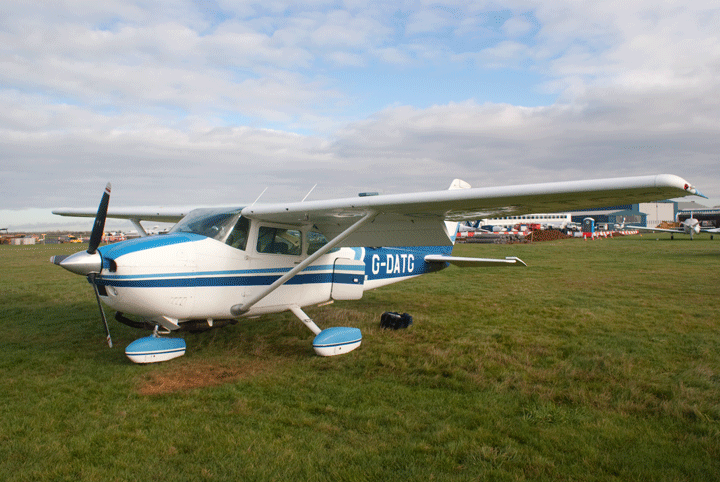
The accepted maths seems to be, that if you fly:
- Less than 50hrs per year: rent an aircraft by the hour
- Between 50hrs and 150hrs per year: join a syndicate
- Over 150hrs per year: buy an aircraft
The advantages of joining a syndicate are that it is available when you need it (hopefully), in a known state of repair with regards to avionics, coupled with the shared fixed costs of hangarage and maintenance.
The only double-edged sword is that you, and only you, are now responsible for when you actually go and fly.
The flying school safety net is gone and a subtle re-assessment of personal minima is in order. Time to grow up.
It's easy to say "oh, whoop-de-do, I can go and fly anywhere in any old weather now", but actually some caution is required. I would be the first to admit that occasionally I need to learn a lesson myself, as opposed to being told.....
At first glance it looks expensive in £ per hour, but I have very carefully crunched the numbers and the keys are:
- you only pay for flying hours (wheel off to wheels on)
- it flies at 125Kts
Fly more than 3 hrs per month and you're saving money. Plus my Accountant tells me I can put the costs through the company, which makes it more Tax-efficient if I fly to a client (which I do).
As the insurance has not yet come through I can't left-seat it, but we'll go out and try some general handling near Banbury from the right seat.
A Cessna 182 is, basically, a 172 that has been extended in every direction by about 20%. So it has 20% more wing, a 20% wider fuselage (so you're not rubbing elbows with your co-pilot) and 20% more load-carrying, as it has a proper wobbly prop and a 230hp engine which means 4 adults, full fuel and a bladder-stretching 8hrs endurance with the long-range tanks (if you fly it really slowly). This one was built by Reims in France in 1976 and has been well looked after, it is obvious.

It sports a huge after-market exhaust silencer that looks like something out of Carlos Fandango's dodgy auto-shop in downtown Los Angeles - I almost expect blue running lights under the fuselage and bunny-hopping hydraulics bouncing us to the Hold point....
But this object does have a purpose: when we start the engine it is quiet - so quiet we barely need headphones. Wow: this is lovely. A 230hp engine means plenty of grunt, we have cowl flaps and a rudder trim (wheeee....) as well to play with - this is a proper aircraft.
After an extensive pre-flight (this, like all aircraft, has its foibles) we taxy out, watching for the localised CBs that are passing the airfield. We should be able to avoid them without too much trouble.
Take-off is quick, we climb rapidly to 3,000ft on a pseudo-Morton departure and I take over. It's very laterally stable and docile, and requires a fair bit of force to get it to do anything quickly. The big issue is that the noise level is identical at 130Kts and 80Kts, so it's very easy to gain or lose speed without noticing. The trim wheel is a big help here, but I feel a bit ham-fisted for the first few minutes (quite apart from anything else it's quite hard to read the instruments from the right seat) until we settle down. It's also extremely difficult to tell which yoke force is the aircraft and which is the pilot trying to limit what I am doing. I need to fly it without anyone else on the controls to really understand it.
We try some turns (lift the opposite wing to take a look first), then do some stalls. It's very hard work to make it actually stall, and even clean the warner doesn't shriek until we reach the bottom of the speedo. With 20° flap it's utterly docile as well, but this time the speedo is virtually on the stop. This aircraft can fly very slowly indeed and I will enjoy experimenting with flying approaches on the back of the drag curve. I think I could even get it in to Brimpton......
We head for home and get a straight-in approach to test the ILS which our pilot flies with easy familiarity at 100Kts. I suspect I shall be doing it slightly slower.....
As we taxy in I'm thinking "it's very nice, very smooth and very well equipped. I think I'll enjoy flying this".
C182 Checkout 28 Sep 10
The other members have kindly allowed me to join, the insurance has come through, and it's time to learn how to fly a C182 from the left seat, so Pete and I will do some circuits.
On the theory that this is just a big C172, I know we'll really need not to let the approach speed run away with us, or it'll float for England.
After spending 10 minutes trying to get the ladder out of the baggage compartment (there must be a knack to this...) we open the full 4-page check list and work through it (I think I can squish it down to a page without missing anything). The only really strange thing about this aircraft is that it has no rotating beacon, so it's anyone's guess which lights are supposed to be on. It's approaching sunset anyway, so we'll just turn everything on.
Start it up (first Go, yessss...) and taxy out. It's got long wings, and I really don't want to hit anything before we even go flying....
Power-checks, line-up and Go.
Whoa there, Tex! Glad I've flown the Cherokee Six; it goes in to Scalded Cat mode and we're off at 60Kts. None of this PA-28 float-in-ground-effect while the engine catches up: we're away and climbing, trimmed at 80Kts and 1,000ft by the crosswind turn. Nice....
First impressions are that the aileron self-centering forces are massive, and that it's really slow to turn.
Plus the elevator forces are large, so lots of trimming is required.
As expected, the first Downwind leg I'm all fingers and thumbs and have trouble getting it in the right place on the approach, but, amazingly, pull off a creditable landing.
Off we go again and this time it's a bit more under control and predictable.
I'm turning a bit earlier and getting used to the world disappearing behind the wing root in the turns.
The approach is better, I feel happier, and the landings are OK: I bounce it once, a foot or so, but on the whole we're down and solid.
We try a post-500ft climbout noise/engine-wear reduction procedure to 23½/23½ and that works well, too, so I'm more comfortable now.
By the 4th circuit Night, and some haze, is upon us and at one point we lose all the runway lights, but hey... this is great practise. I like flying at night anyway.
Most of this familiarisation is finding where the runway needs to be for the right circuit spacing (2/3 up the strut), what power settings work in the circuit and how to find everything in the dark. Actually it's all pretty logical and we don't have too many problems.
We try the 40° "Barn Door" full-flap extension and the nose goes right down. This needs lots of power to keep the descent rate within reasonable limits but we float down the approach at 65Kts and land really terribly short. A couple of those, one more with normal flap and we roll in happy. And I've revalidated my Night Rating in to the bargain.
Taxying in in the dark is another challenge to add to what we have already accomplished tonight, but we manage with no scratches, and amazingly my torch batteries are good, so putting it to bed is easy.
Notes for next time: take the yellow bag out before you take the ladder out, and cancel that rudder trim bias for circuits that is causing us to fly out of balance the whole time.
And now I've got my own key...
This afternoon we'll try to complete the familiarisation and get a sign-off on the aircraft. We agree we'll fly out for some general handling, some climb and descent power settings, then some circuits at Wellesbourne and a glide approach.
Having bashed the PoH and thought through some of the issues we were having last time I feel more in control as we cancel the rudder trim bias, fill up with fuel (70-odd Gallons!), take off (ah, that's better: give it a bootful of right rudder) and turn North West for Wellesbourne.
The ailerons seem lighter now, but I think it's because I'm not trying to turn in too fast: this aircraft loves rolling into and out of a Rate 1 turn and appreciates being eased in to things. This makes it a very stable Instrument platform, as we shall see.
By the time we're established in the cruise at 3,500ft we're almost on top of Wellesbourne... wow, this aircraft covers some ground. Turn away towards the West and get some cruise climb and descent power/prop settings established while we're away from the ground. That completed, we head for Wellesbourne and join downwind in to their circuit for 28RH. We do a couple of nice approaches with the speed nailed properly, a couple of OK-ish landings (I need to roll the power off a bit earlier) and some more controlled climbouts, followed by a "barn door" approach that goes very nicely and we land very short indeed. The final circuit we decide on a glide approach from downwind, but there's too much traffic so we stay at 1,000ft until we are on Final and when I reckon we can make it we chop it and glide....
As normal, it looks at first as though we will overrun, then it looks normal for a while, then it looks panicky. The fence between the road and the runway is very close indeed, but we cross it without having to resort to a burst of power, and touch down just before the threshold, on the run-up zone. Quite nicely judged (or more likely just lucky!); we roll in and stop for a cup of aviators tea.
And to complete...
We climb out from Wellesbourne (if the donkey quits we'll go....... here over to the right, as there are lots of trees and a ridge in front of us), reach cruise height and decide on an ILS Straight in for 19.
We tune and check the Honiley beacon for 051° and soon the VOR comes in (ooh, this is a steady IMC platform), we contact Oxford and tune the ILS which comes in and we set a 500ft/min descent, then tweak to catch the glideslope. Downwind checks, then flaps, slow to 75Kts and change to Tower at 4d; I am all eyes-down, Pete is Safety Pilot looking out, and we remain nailed to the VOR all the way down. I get Pete to call 100ft above and the Decision Altitude of 760ft QNH, and it all seems very stable and do-able. I look up at 760 and there is the runway really close, little lights-a-shining, 2 red and 2 white PAPIs. Mentally swap to VFR mode (the theory is that you shouldn't have to move the controls at all) and this time I try to fly it all the way down the runway at 3ft; and it settles gently. Getting better...
So we've accomplished most things I am likely to meet, and Pete is happy. I can now fly whenever I want to. And I need to go away on business next week. Yessssss......
Shoreham 1st solo C182 6 Oct 10
I need to go to Shoreham on business and to stay away overnight. I also don't know what time I am going to get back on the second day, but this is now not a problem because a) I have a key, and b) no one else in the group needs the aircraft for days and days to come, so if it's not back tomorrow night it's not an issue. This, it must be said, dramatically reduces one's stress levels.
We have been, apparently, experiencing an issue with the left two knobs on the transponder giving incorrect and varying values, so today we are "Negative Transponder". The aircraft is booked in to have a new Mode S transponder fitted, costing £3,000. Long faces all round....
The rain clears overnight and I taxy over to the apron to load up server, UPS (this gets firmly strapped in), boxes of routers, cables and overnight bag before departure. I am helped by a very nice lady in a posh van, who I normally see ferrying posh people out to jets. What service!
First solo flight: better not bend it.
Once clear of the Brize Zone I can set a course for CPT, switch on the autopilot and relax.
I tell Farnborough we are negative transponder today and they are happy enough, but ask me to report my height regularly. I am asked to increase height at one point for spacing from an outgoing red and white Boeing 737 from Lasham, which climbs up a little too close for comfort, then banks away.
Then it's down to 2,400ft to nip under the corner of the London TMA and start a gentle descent towards Shoreham for a crosswind join for 20LH. Drop in to the empty circuit (where is everyone?) at 1,000ft, turn Final with 20° flaps, cruise down the approach, flare and roll the power off, and we settle very gently indeed on to the runway exactly where I had hoped. Lovely.
And only 34 minutes of (chargeable) flight time. This aircraft is fast.
Whilst on the ground at Shoreham I meet an extremely kind avionics engineer who manages to fix (and test!) the transponder for nothing, and even fixes the malfunctioning turn 'n slip light, so we now have a clean bill of health and have saved the group £3,000 in the process. Cool.
The following evening I take off once more for home, back on the MID VOR then CPT. Farnborough can see my transponder code and height OK, so we're home and dry there.
Beyond CPT we cruise descend, report visual and slow down for a downwind join for 19, roll on to the crosswind leg then are asked to orbit on Final for a landing jet. This leaves us high on Final as Night arrives, and we do almost a glide approach to a neat, controlled touchdown, one third of the way down the runway and right on the centreline (for once).
Roll in, fill out the Tech Log and put the cover on. 39 minutes.
Oh, I am really starting to enjoy this.
IR(R) refresher 27 Oct 10
My IR(R) is 2 years 1 month old next week, so I need a biennial / renewal / check-flight (delete as appropriate). It's time to demonstrate to myself I really can do this "flying through clouds" stuff. I feel confident enough flying the C182 VFR now.
We need to go to Shoreham to drop off some stuff and get an iPad connected to a WLAN, so I borrow Willie as a willing Safety Pilot to look outside the cockpit as it's not real IMC out there whilst I use foggles, and also if I bugger things up I'd like an experienced second pair of hands available.
We start out under the bluest of skies: we will fly simulated IMC (with foggles) from Oxford outbound 161° until we hit the 175° inbound VOR radial for CPT, then follow that all the way to CPT, then go outbound 160° to GWC (Goodwood), then 090° to Shoreham where we'll do the non-precision NDB procedure for runway 02.
Start-up, check the Navaids, get caught for ages at the Hold Point before departure, then finally, at 500ft go "IMC" with the foggles.....
And it all goes well: outbound ADF tracking works OK, inbound and outbound VOR tracking works well, and halfway down at FL45 we go in to cloud anyway so it's no-foggles real IMC, and a Traffic service from Farnborough.
It's interesting how you can so easily slip back in to the IMC head-down scan mode, where slight alterations in height, speed or VOR trigger immediate reactions. If you have to think about any of these reactions, it's too late: your conscious mind has to be running at the strategic level: the next radio frequency, transponder squawks, read-backs, the next beacon, checking the IDs. You're too busy to be thinking about the actual flying.
Inbound to Shoreham we opt to aim North of the airfield so we cross the beacon straight in to the Procedure. I've never flown this one before, so it's gratifying to be able to read the plate and follow the numbers out and down. Slow the plane up to 90Kts and trim it stable, get a reasonably good cut on the ADF, call beacon outbound and start the descent. At 5.5d we turn and call Base Turn Complete, at which point we are aware we have been blown too far East by the wind, so turn a good chunk West, continue the descent to the MDA at 600ft over the sea and look up.
OK, so we're not quite in the right place, but I can see the runway easily and with a few minor corrections we are on Final. I reckon the theory is that if you're a long way off you simply orbit once below the cloudbase for positioning.
Better not muck up the landing with the owner on board! Nope, we land a bit slow, with the stall warner sounding, but it's fine and we roll out for parking.
I was rusty but that's OK: the next approach will go a lot better, I know that.
Shoreham don't charge us for the procedure which is either intentional, in which case I shall do the approach every time I come in here, or a mistake, in which case: tough!
After dropping off the equipment we head homewards: there is forecast to be a cold front coming in from the North later this afternoon and we'd rather be on the ground by the time it soaks us.
Climb out NW and seek the 270° radial inbound for GWC. At top of climb I get the slight Leans and it goes a bit pear-shaped: by the time I've got it really sorted out we're a few degrees off-track, so we bring that back in and track successfully to Goodwood. This is actually a lot easier without an Instructor on board.
At GWC we try an experiment: we head 320° outbound seeking the 360° radial inbound to CPT, and pop the autopilot on. This works really well and we start refining the settings, playing with that and the GPS until we know to the nearest 50 yards where we are. The 360° radial comes in a little too fast; I blow through it and weave around the sky playing catch-up. Shows the need for anticipation at 125Kts....
Once on course for CPT the DME counts down, we get a neat cut overhead, the VOR displaying "error" as we pass through the Cone of Silence, then the DME starts rising again as we head for Oxford.
I think that's enough IMC for one day: there is an enormous storm over Oxford: the precursor of the cold front due in. We flip off the autopilot and turn while descending to fly over South East Oxford. Following the ring road we go briefly IMC as we pass through the edge of the storm, then back out into bright sunshine for a downwind join for 19. We are told to expect a backtrack (why?) so land short-ish and backtrack towards a very nasty-looking black cloud with an aircraft on very short final heading for us. Nipping around the corner we escape the Active and end up taxying right around the airfield to the grass parking.
We put the cover on the aircraft and as we head for the car the black cloud envelops us and we get absolutely soaked. Contingency? We would have gone back South, dropped in to Popham and waited for the storm to pass - I didn't fancy flying through it and there wasn't enough under-Airway height to outclimb it.
So, the next job is a bit of a formal IMC refresher, then a Skills Check.
Following a reasonably successful non-precision procedure at Shoreham I feel a little more confident about the IMC revalidation, so we'll try a test procedure with Wayne the Instructor.
Today is windy: approaching, if not already on, the crosswind limit for runway 19. So the winds aloft will be 30kts or more, which will make life interesting.......
On the last flight it emerges that we landed at Oxford with less than 5 Gallons of fuel remaining in the tanks, so I am determined to be better at fuel calculations. At 16 gallons per hour, 5 gallons equates to less than 20 minutes flying time. So I dip the tanks very carefully and we have a total of 26 gallons combined in the tanks. At 16 gallons per hour that's just over 90 minutes flying. We'll be out for an hour, so strictly that's below our 45 minutes IFR reserve. OK this time, but for a real IFR flight more fuel would be required.
We plan a pseudo-19 procedure over the Westcott (WCO) beacon and take off. We'll do this first flight without foggles, so depart via a Botley departure (OX 161° radial outbound until you hit the 360° outbound from Compton (CPT)).
And of course, inevitably, it all goes badly wrong almost immediately: I have forgotten to tune and ID CPT so we don't know when we have actually reached Botley, and I haven't a clue how long it's going to take us to get to Westcott from there, so cannot supply the necessary estimate for the beacon.
We turn left towards WCO looking for the 040° radial inbound. This works OK and we set the QNH on the altimeter to 20mb below the prevailing QNH so we are 600ft above what we think we're flying at.
As we approach WCO using the GPS for a pseudo-DME we get a reasonable cut and turn outbound for the teardrop entry.
And it all goes downhill from here: the wind catches us more than our calculations have allowed for and by the time we have turned back towards the 337° inbound radial we are hugely further East than we should be. It's really hard to recover from a position error of that magnitude in the relatively short time you have for the inbound leg, but we try with a 45° cut and almost manage it, arriving untidily over the beacon.
But we get a good cut and turn in to the hold. Even with triple-WCA correction we're still blown East and it's really hard to get back to the right radial inbound before we get the cut again over the beacon.
We turn outbound on to the 001° radial, call beacon outbound and start the descent plus downwind checks, which works fine except that I use 2200ft instead of 1800ft for the Base Turn (well, at least I erred on the safe side!). Call Base Turn complete and hold the 194° radial inbound, re-check the radio ID and descend.
We've flown the procedure thus far at 90Kts but now we slow to 75kts and drop the flaps to get in to the landing configuration. As we descend and are distracted by the slowing and flaps the wind changes and we drift off track. I have also not reset the compass following the base turn and it's out so we start oscillating left and right as with increasing desperation I try to hold height and heading. The GPS tracks look increasingly amateur as we approach the beacon. We'll do a Missed Approach this time, so head for the beacon then climb outbound 168° back to the Hold.
At this point we track outbound 240 for a visual recovery to Oxford. They have closed taxiway Alpha due to subsidence so we will need to turn on to runway 11/29, which is about 350m in from the threshold. This would normally require a backtrack, but we have barn doors instead, so 40° flap and back to 65Kts for a short-field landing.
We have a serious crosswind, on the limits for this aircraft, so big crab and hold the into-wind wing down. As the stall Warner shrieks, a final big haul and we drop gently on and slow before the intersection for a backtrack-free taxy to the pumps for a serious Avgas fix.
That was absolutely knackering. Clearly, it needs some work....
After a debrief and some badly needed time on Terra Firma, we reconvene for a second round.
This time, we'll do the 100° circle to land procedure, with Foggles.
Take off, switch to Foggles and the distraction really puts me off: we end up at WCO the wrong side of the beacon and the whole procedure goes to pot. I know I'm making a mess of it.....
In reality, this procedure is to get close enough to the field to set up a low-level circuit, so positioning is less critical, but height is hugely important, so I concentrate on not busting the heights on the procedure, and eventually we struggle through to the missed approach. Although it wasn't great, looking out at Westcott we are over the field, quite close enough to make a circuit. But not very good.....
During the procedure I get the leans several times, which is good. I heard recently of an IMC training course where they go home every time the student gets the leans. Well, that's no good at all! But I know now just to trust the instruments, trust the instruments.....
Having explored what I know is my weak spot i.e. ADF tracking, we explore some other areas, starting with partial-panel flight. Cover up the AH and DI (the suction-powered instruments) and fly straight and level. Easy with the turn 'n slip once we've set the rudder trim to get the ball in the middle.
Next we do timed turns, with the VOR set up as a reference plate. Turn the OBS to your heading and it tells you where to turn (the compass is always backwards). At 3° per second the calculation is easy. Start the stopwatch, turn in, stop the stopwatch, turn out. And after a couple of cock-ups, it does work OK.
And finally: partial-panel recovery from unusual attitudes. Close eyes and let Wayne put the aircraft in a weird place, then we recover. It's actually not that hard, but a good tip is to roll the wings over-level to Rate 1 in the opposite direction on the Turn 'n slip, then immediately level it. If speed slowing, then more power and yoke forward; if speed increasing then yoke back and throttle off.
We recover VFR to a Left base join for 19 and the wind is now reportedly 250 15G20; outside the crosswind limits for the aircraft. We will take extreme care and go around if necessary. Actually, with Wayne aboard this is good practise. Descend, and we are blown about on the approach but with crab and wing-down we do an even shorter landing and don't even need to brake to exit on to 11/29 this time. We record an approach groundspeed of 38Kts. I now feel happier about going in to places like Brimpton, with short runways.
The ADF tracking definitely needs more work, but re-playing the winds aloft later on RANT I really did pick an appalling day to try this: we were battling against 40Kts across our track, so maybe I shouldn't feel quite so downhearted. Dialling the winds down to a more normal 20Kts the whole process becomes considerably less frenetic, which makes me feel better.
This is a process I will revisit, but will fly VMC-only for a while.
Brimpton 6 Nov 10
Brimpton is a 520m grass strip just outside Newbury. I’ve been there by road and have co-piloted Stephen’s C175 in, but I have never flown in myself. Armed with recent short field experience I am confident we can get the C182 in (and even more importantly, out). John is coming with me.
The previous pilot (not me!) has left the fuel on, and the aircraft is parked on a slope, so all the fuel has drained to the lower tank. This could make for interesting flying, and there isn’t quite enough fuel for me to be happy with, so we’ll fill up the other tank first.

Taxyway Alpha is still closed, so we’ll start with a backtrack and take off on 01. We’ll do it short field, so 20° flaps and rotate at 60Kts. This goes very well, which increases my confidence that we’ll get out of Brimpton.
We climb out and head South; John flies us to Compton and then we peel off left. Before we know it, at 125Kts we are almost overhead them and need to descend to fit in with their 800ft circuit. I'll do a low approach and go around first as I'm not low enough, slow enough or confident enough at this point to attempt a landing. I'm also much too close, so we power out and do a nice long circuit, far to the East to give ourselves lot of time to get it absolutely spot-on. Approach speed and landing placement is critical, we can very easily roll off the end of this 520m muddy grass runway. The C182 has a reputation as a short and rugged field aircraft, we're about to find out if it's true. The backout plan is that if we are not down and rolling by the time we pass the hangars it's full-shit and go around time.
There is very little wind, so crosswind won't be an issue, but it does look very short from here. I get the aircraft down to 60Kts with all the barn doors out and come in low and slow. I'm aiming for the numbers, not the normal 1/3rd of the way down the runway. I'm not having any of this floating lark, I want the wing to actually stop flying over the numbers.
It all goes well until the perimeter hedge where I back off the power just a bit too much and we have no flare cushion left as we are so slow. The stall warner sounds and we descend a little too fast for comfort. I don't want to feed in power as we'll use up more runway, but we're very close to the ground now and we touch down heavily just shy of the numbers and on a bit of a hump, which makes us bounce once (we're not meant to be landing right here, and I can see why). The wheels touch again, and we're down and solid (my first thought is "Prop Strike" but despite deep compression of the nose oleo later inspection shows no damage, just grass in the nosewheel spat). I don't need to brake (probably wouldn't have much effect on the wet grass anyway) and we're only doing 30Kts by the time we pass the hangars.
No need for a go around: we even take the intermediate exit to the taxyway. That wasn't great though, a decidedly undercooked landing and too heavy to be happy with. More STOL work required: I need to stop panicking about running out of runway and if I am going to land on the numbers it needs to be a bit gentler i.e. faster. Another 5Kts and that would have been perfect. Let's just say we explored the bottom end of the aircraft's speed range quite comprehensively.....
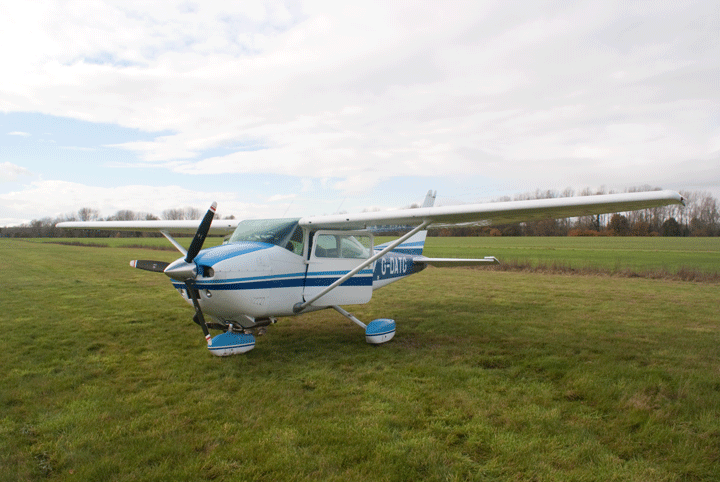
After a coffee, a wait for a shower to pass through and an inspection of the undercarriage, we fire up again. Get the aircraft right against the hedge, 20° flaps then full chat and release the brakes. We head off like a scalded cat. Keep back pressure on the yoke to ease the pressure on the nosewheel but at 57Kts she is not coming up, so positive back pressure at 60Kts and still she is floundering, although we are at least off the ground and climbing.
Once at 1,000ft we review: it turns out we had 10° flaps, not 20°. The detents and labels are slightly out of alignment but that's not the point: I really should have double-checked. It was OK, but took more runway than it needed to.
Trundle home Northwards, join Right Base for 01 and do a decent landing this time, at least!
Fairoaks 13 Nov 10
The great thing about having unfettered access to an aircraft is the ability to be able to fly at very short notice: if you wake up, it's sunny and you're in the mood, you know you can just Go. It's not unlike having your first car; a major liberating moment I remember well.
It's also nice to have an obliging series of friends and relatives who like coming flying and are not too bothered where. And a friendly accountant who ensures the minimum cost, of course...
Wake up Saturday morning and the word "Fairoaks" pops in to my head. A quick Skype IM to John (who is not awake yet) confirms I will have a mate to go with.
My oldest friend Simon, who lives in SW London, needs taking out at some point: this is the closest airfield to him so I'd like to experience going there before I do take him out. It's also inside (not under) the London Control Zone, so we will need to tread with caution. Good experience for both of us.
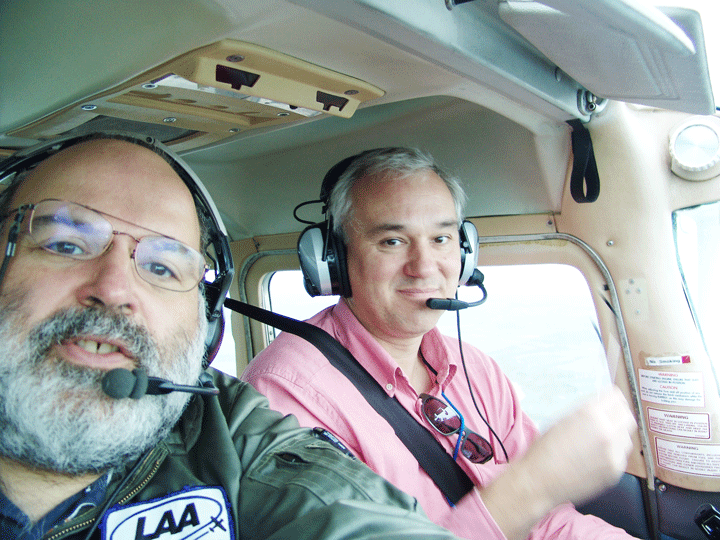 We'll do the trip using NDB tracking, which is good practise for my IMC. I've concluded I need more time to get entirely comfortable in the C182 before re-trying the full IMC Procedure: just flying the plane is taking up too much of my (very limited) mental energy at present. Also re-running the procedure in RANT and Flight Sim with big winds in varying directions helps.
We'll do the trip using NDB tracking, which is good practise for my IMC. I've concluded I need more time to get entirely comfortable in the C182 before re-trying the full IMC Procedure: just flying the plane is taking up too much of my (very limited) mental energy at present. Also re-running the procedure in RANT and Flight Sim with big winds in varying directions helps.
I'm getting better at the pre-flight and Aircraft cover stowing now: John has a similar cover for his Tecnam and his experience is a big help. Together we cut the stow/unstow time in half by careful folding.
Off to the pumps to top off the tanks and have a really good look at the nosewheel and spat. All the plastic spat cracks that are there were there before last week, and have been either riveted or drilled to prevent crack propagation, so we clear all the accumulated earth out of the spat and all looks good.
Fire up, check the NDB and head out. Taxyway Alpha and its associated subsidence has still not been fixed so we wait for a Rutan Vari Eze (a rare beastie!) to taxy on to the apron, then we can go.
Take off, left turn to avoid the Brize Zone and lock on to the 145° outbound radial. As always, when not under stress, this is easy. Just pull the tail.... We settle at 2,400ft on the radial with John driving and a 5° wind correction. Swap to Farnborough and they're very helpful.
At 130Kts Reading comes up very quickly: switch to WOD or Woodley near Reading and track inbound (Push the head). We'll pass to the right but it's good practise anyway.
Once past we need to have our wits about us: we will be deliberately violating the London Control Zone and have been briefed by Fairoaks as to how to do it: skirt round the TMA until you are SW of the airfield, descend to 1400ft QNH and call them. Once in radio contact, go on in. But we have arrived a little early: that 130Kts gets us there before we've had a chance to say goodbye to Farnborough, so we orbit and finally get a word in edgeways to change frequencies en route. Normally one would join Overhead but when we call them up they are happy for us to join Downwind. The wind is 5Kts straight down runway 24.
Turn Base leg, then Final, call Final and let's see if we can do a real greaser this time, to make up for last weekend. Carry just a touch of power in to the flare, then roll it very gently off, and with a tiny squeak from the stall warner we kiss the tarmac. Oooh, nice, and even on the centreline.... Hold the nosewheel off as long as possible and gently release it, light braking and we trundle down to the end of the runway. Exit right, navigate the complex taxyways and park up by the big hangar where it says "Do Not Park". Hmmmmm.....
After a rather good BLT baguette we fire up once more, taxy out rather too close to some very expensive aircraft and take off. Turning left, we exit the London Zone and call up Farnborough, who give us a Transit overhead Farnborough: Ooh, that's worth a picture.
Ease right to avoid Blackbushe, then John flies us home again. As we're still under the London TMA we need to be very careful with our altitude. At one point Farnborough asks us to report our level, which we do: 2,450ft on 995mb. Just to be on the safe side, we descend 100ft. Don't want to be busting the Zone.
At 130Kts we are back at Oxford very quickly indeed: John lines us up for a downwind join for 19. There's a business jet landing, so we extend downwind then swing in behind him, giving him plenty of room to backtrack, but the Tower has other thoughts and makes us go round from Final. We comply, get an early turn then trundle down the approach. Barn doors out, but I land a little late and we just miss the intersection, so a 10ft backtrack and we're off.
What a lovely day out.
Lydd 2 Jan 11
The Christmas break is a time for reflection.
In a recent copy of Flying magazine (it's simply the best: none of the UK magazines even come close) the editor muses how different actually pushing the levers and pedals to move the aircraft and feeling the aircraft respond, is to being a passenger. Being flown is nothing at all like actually flying.
Once you know how it feels to actually fly you never feel the same even about being flown in an airliner.
I have recently been teaching my eldest daughter to drive and the same rules operate: she can be driving down a road she has been driven down hundreds of times in the past, but now she is driving it and she says it looks and feels completely different. Yes, it does.
Finally, a one-day window between snow and work opens on 2nd January, when the sun might even shine.
This is all a bit uncertain: we may well suffer from either an inability to get the aircraft started (it has sat unused for a month and was at one point covered in snow for a week), or an inability to taxy it out of its own wheelmarks. We shall see, and if all goes well Nessie and I will go to Lydd for lunch.
Amazingly, it starts first go (more than can be said for my BMW this morning - that needed jump leads!) and with a fair bit of oomph, but no more than we often need on grass, we are moving.
Off to the pumps to fill up with Avgas and to check that the tyres are pumped up OK (hard to tell on the grass), and following a little fight with the various pumps we are ready to go.
Winds are 5° off straight down 01 at 5Kts so we'll have a smooth take off.
I like flying in the winter: less turbulence and fewer people flying. It's quiet up here as we climb and turn en route; once set up for Compton we turn the auto-pilot on and cruise South, turning at CPT for GWC (Goodwood), avoiding the no-fly zone at Oakhanger on the way.
It's surprisingly sunny and we both wish we had brought our sunglasses.
At Goodwood we turn East for Seaford and follow the beautiful white cliffs East, which are more interesting than the cliffs further East. As we descend to 1,500ft to get a closer look we realise we are being shadowed by a DR Robin who is also sightseeing.
Contacting Lydd we cruise over the Romney, Hythe and Dymchurch railway and join overhead at 1,500ft, descending as instructed to join downwind.
Having not flown for 6 weeks I expect my first landing will be somehow inaccurate, and indeed I approach too high, and whilst we make a lovely smooth controlled landing we also use about 1000m of runway and miss the normal turn-off. Who do we think we are, an airliner?
I tend to do this if I haven't been flying for a while: after a landing or two I get my eye in, but I can understand currency requirements and the need to practise regularly.
We park up on the huge tarmac apron and head for the Biggles (!) restaurant for some lunch. We've done 1.2hrs Oxford to Lydd.
The hot air dryer in the loo only works intermittently, and neither myself nor a French pilot I meet can work out exactly where to put our hands to activate it. Eventually he shrugs his shoulders and declares it "female"..... I love the Gallic sense of humour.

|
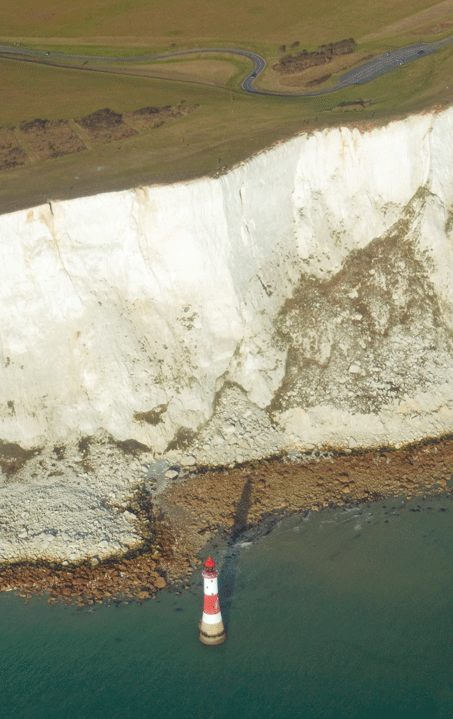
|
|---|---|
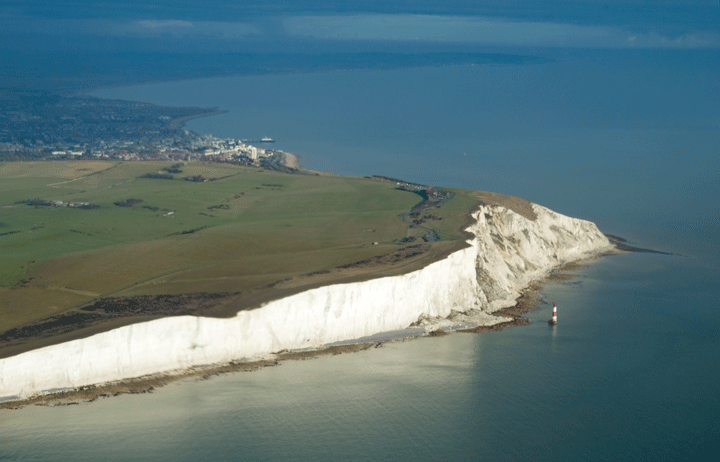
|

|
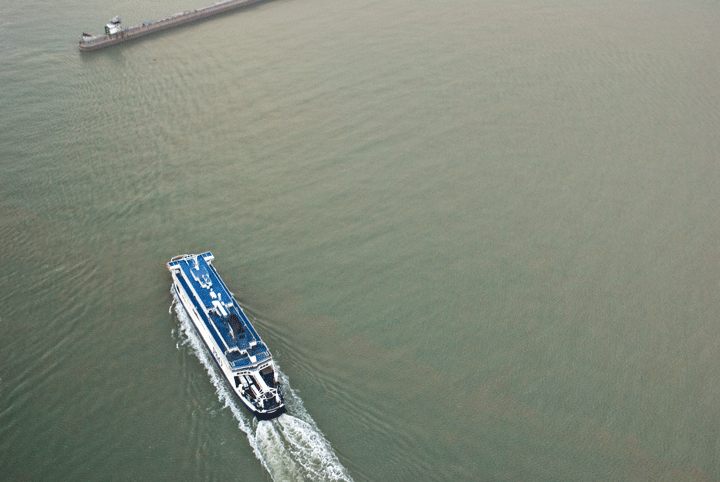
|
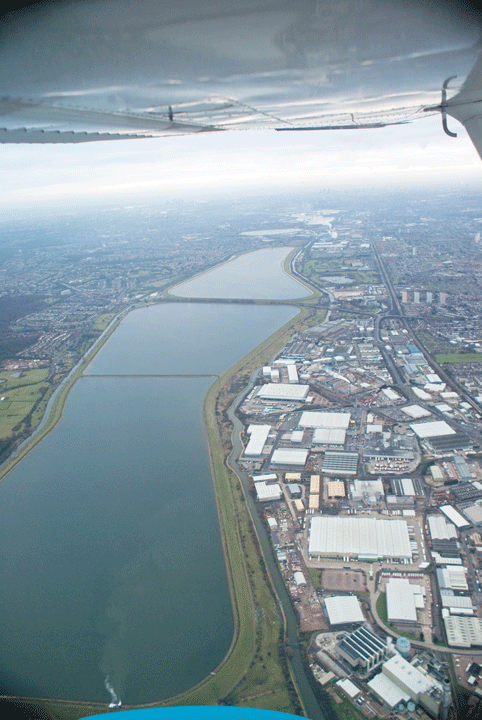
|
Lunch is good, and once our stomachs are refuelled we depart for Dover for a look at the proper "white cliffs". I've never been here before and over Dover harbour it's interesting to watch the ferries and see the old hovercraft terminal, now abandoned... what a waste of a perfectly good British invention the hovercraft was.
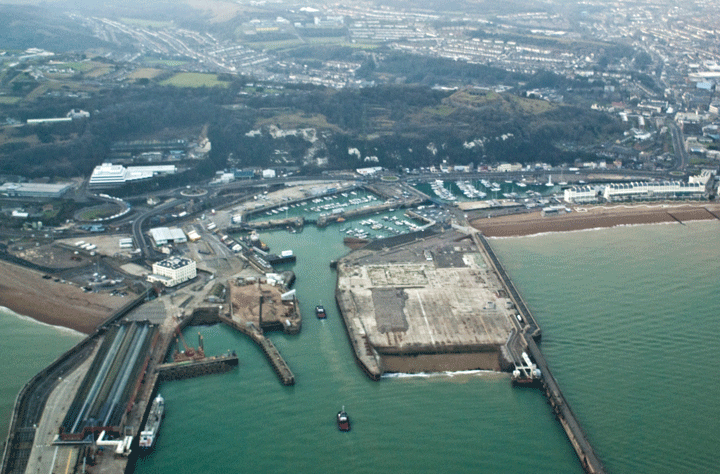
|

|
|---|
Dover's white cliffs are dirty and small - the Hastings cliffs are more interesting, definitely, so we turn North East and head home.
Our track is straight to the Lambourn VOR: North London Information passes us to Farnborough North for a trek under the London TMA. We skirt Stapleford's ATZ and cut the corner of the turn towards Bovingdon at 2400ft too avoid any local traffic. Farnborough advises us helpfully of close traffic and we pass Westward over Bovingdon and then the Chilterns, which at this height appear an insignificant range of hills. From the ground they are bigger!
Once past them and aware of some conflicting traffic we switch back to Oxford who advises us of a motorglider coming our way. It turns out to be one of the Abingdon UAS Grob Vigilants, who seems to be out very late in the day and a long way from home, with all his lights on. We pass close enough to wave and descend for a right base join for 01. Again I'm a bit high on the approach, but more positive action earlier gets us on the PAPIs and we arrive smoothly. Tower lets us backtrack for a short taxy home and we park up, very satisfied, as the light fades. 1.2 hrs home again.
We've been a long way and it's been painless. The Scillies next?
Turweston 17 Jan 11
I've never flown to Turweston: they're one of those pesky airfields that are just not quite far enough away to be worth a flight, normally. However, today we have business there: Pete's Mooney has been resprayed and is awaiting collection. He needs ferrying up there and going by car would be soooo uncool. So we'll nip up. Lucy will come along for the trip as she is not at college today.
It's been raining hard all morning but as lunch approaches the rain eases off and the sun looks like it might come out. We unwrap one very wet aircraft, dip the tanks (not much in there...), taxy to the pumps and fill up (I even manage to make the pump work first time and get a receipt), then we take off on 01 Northbound. It's really smooth today: there is very little wind and no thermals, and the visibility is excellent: we can see as far as Coventry to the North, and Gloucester to the West.
It's not worth going above 2,500ft as we skirt to the West and then the North of Brackley and descend for a straight-in/left (a bit) base join. I'm quite glad I've done the Popham offset approach before as we float down towards the massively displaced threshold of 09. And for once we do an absolute greaser: none of us can tell the exact landing moment but there is a rumbling below us as the wheels wind up. Normally I can only do these when no one else is watching....
Backtrack and taxy in (we'll avoid the very wet taxyway), shut down and push back to the edge of the grass. The sun is shining and all is Good with the world.
 Pete has his plane back and it looks fabulous: like new. Unfortunately they have flattened the battery so a 24V battery is produced and they jump-start it: I've never seen that done before. Then Lucy finds some of Pete's kit he has left in the Cessna so I have to go and find him in the resprayers' office and there, being resprayed, is the PA-28-140 Golf Juliet I have done so much flying on. That's going to look really good resprayed.
Pete has his plane back and it looks fabulous: like new. Unfortunately they have flattened the battery so a 24V battery is produced and they jump-start it: I've never seen that done before. Then Lucy finds some of Pete's kit he has left in the Cessna so I have to go and find him in the resprayers' office and there, being resprayed, is the PA-28-140 Golf Juliet I have done so much flying on. That's going to look really good resprayed.
We'll try a proper short field take-off here and see what happens. It's best to experiment with a nice long piece of tarmac for my next visit to Brimpton (or another little strip I have in mind...). They've swapped runways so we will backtrack 27 and take off. Flaps 20°: we will rotate firmly at 57Kts IAS and see what happens.
It does need a confident pull on the yoke at 57Kts but then it goes up like a helicopter. Hold and trim at 65Kts and the rate of climb is alarming. Clearing a 50ft obstacle? Pah!
I've been teaching Lucy to drive and she has got the hang of being in control as opposed to being a passenger, so we will experiment with effects of controls. We work on rudder, aileron then elevator and she is very good once she has got over her fear of breaking it by moving the controls (I can remember that!).
We fly around in the brilliant afternoon sunshine for nearly an hour - it feels like my first Trial lesson, but from the Instructor's perspective. She loves it.
We rejoin crosswind for 01 and cruise over Kidlington, we're high on the approach but by the time we're at the threshold we're in the right place, and with little or no wind we can do another greaser by careful manipulation of that flare cushion.
"Mmmm, nice....", as the Jazz DJ on The Fast Show would have said.
Local with Monty 22 Jan 11
A friend has asked me to take up their 12 year old son to see how he likes flying, so we take a look at the weather, and it's one of those sort-of-IMC days that would preclude any flying school activity, but might be, in practice, quite flyable, with an ATIS of "broken at 1,000ft, 8Km viz in haze". We'll give it a go, and if it really is awful we'll come down again.
We start up (got enough fuel today) and take off on 01. It turns out that it is slightly hazy but the clouds are more like scattered at 1,500ft, diffuse and only 1,000ft or so thick. Above 2,500ft it is clear and sunny.

We depart to the South at 1,500ft and orbit over Radley school (where my passenger starts in September), then over to Abingdon where his sisters are playing lacrosse, for some aerial shots. As Abingdon UAS are flying today we swap to their frequency and tell them our intentions, and that we will stay East of their circuit. They are amazed that we think of doing so, and even more that we know their frequency. Forward planning rules! (it's 122.10, by the way)
We depart to the South and swap back to Oxford Approach, then climb through a hole in to the sunny bit at 3,500ft for some general handling.
He's pretty good (lots of video games?), can hold a height and before long he's flying us around the cloud banks with a big grin on his face: he is just tall enough to reach the pedals. A future pilot?
After a while we decide to go home, so head North East to pass North of Abingdon, drop back through a hole in to the gloom below, pass over the house between Abingdon and the Brize zone, round the corner of the zone and overhead Oxford. Orbit once to give spacing for an arriving PA-31 then line up for a Right Base join for 01 and descend. We have a strong wind straight down the runway so we float for a bit, then drop in smoothly on the stall warner, brake and backtrack for a quick trip to the parking area.
It's cold as we put the cover on, but maybe I've awakened an interest there - it would be nice to think so.
Multi Crew Co-Operation Jan 11
We need to visit High Wycombe to check out whether we have the correct vented fuel caps on the plane and to look at a dodgy ADF readout. This is a good excuse for a jolly, and 3 out of 4 members of the Syndicate are up for it. All of these people are qualified and experienced pilots: one is an ex-BA Captain, so this is a good chance to learn things.
After two weather-aborted sessions we find a sunny but breezy day in February. The winds are 24015G20 so right on the official crosswind limit of the C182, and a strong wind warning will be in effect by the time we return. I'm not flying, so it will be interesting to experience crew co-ordination.
Much is made in commercial aviation of MCC, or Multi-crew Co-Operation, which is basically a set of systems to ensure safe operation when multiple pilots are in the cockpit. History has shown that deferential co-pilots and locker-room behaviour cause accidents, so the FAA have come up with the concept of the "Sanitised cockpit" where banter is banned and each command decision is deliberately open to scrutiny by all parties. This has made aviation safer and has application even in small aircraft.
We start out by carefully apportioning the cover removal, walk-around and pre-flight check lists to ensure nothing falls through the cracks. Having multiple pilots with experience of this aircraft speeds things up but throws up a number of interesting issues: some corrosion is evident on the outboard elevator hinge points and my concern as an engineer is whether that is weakening a vital joint.
We also look carefully at the flap lever: this has physical detents and flap degree markings, which do not in any way match. Some are using the markings, some the detents.
A unified checklist has also eluded us, so we discuss the merits of various versions, some of which are riddled with duplications. I have a simplified version but even that is incomplete and my copy carries assorted hand-inked alterations.
The back is very comfortable: there's a lot of legroom and a surprising amount of headroom. I imagine it would be a little more cramped with two, but me and my flight bag would be happy here for a long period.
Steve is to co-pilot John, and they go very carefully through the "full of duplicates" version of the checklist using challenge/response. This works well, albeit slowly, and we have a chance to discuss various checks.
At the entrance to runway 19 we are behind a Cessna Citation which takes off, and we are cleared in immediately behind it. I am thinking "wake separation", although in practice with the breezy conditions any vortices will be long gone. But in calmer conditions I think I might be more cautious.
John takes off and doesn't do my noise abatement trick at 500ft, which is different but not necessarily wrong, and we turn East to climb and track North of Benson. It's a little hazy and we settle at about 2,400ft for the short leg to Wycombe, me cursing the fact that I forgot to bring my camera.
As Thame passes below we change to Wycombe and descend to 1,400ft for a right base for runway 24. The wind is at 230° so we will have very little crosswind but should stop quickly. John prevaricates between 20° and 40° flap, but settles eventually on 40° for a short-field and brings us in very tidily on the stall-warner. Since Brimpton I've been a bit wary of flaring so deep in to the stall warner but he hauls away with gusto and we settle very gently on to the tarmac for a short run, then backtrack for a fuel cap inspection, lunch and a fill-up of the fuel tanks.
On the return journey I will be Non-Handling Pilot, which will be interesting and raises the theoretical possibility that, should John become incapacitated, I might have to attempt a right-seat landing. Now I am sure this is not hugely difficult, but I have never done it and it is one more thing to add to my (long) "excuses to go flying" list. Some people struggle with motivation to go flying: once they have their license they get bored and drift away, but I have never had that at all - I can always think of an excuse to go up, even if it is a flimsy one!
So I'm reading checklists and John is flying: once we have finished our run-up checks we call ready for departure and are offered an immediate departure if we can expedite. Well, we can most definitely, so we roll down 10° of flap as we accelerate on to the runway, check they are down equally as we roll and take-off in to the bright sunshine. At 1,500ft we roll right and head back for Oxford, climbing to 2,500ft.
It's interesting having 3 pairs of aviators' eyes roaming around: between us we do spot a lot of other traffic. I also have to manage the radio, which is fun because I have to push the PTT whilst not interfering with John's control movements. Now I understand why Instructors do that "lean down and squeeze the PTT from the top" manoeuvre that I always thought was a bit of a pose.
We check the Oxford ATIS, but John doesn't want to declare our landing intentions to Oxford until he can see the chimney. This leaves us very late to announce our intentions and causes problems: I would have announced much further back at say 12d and worked from there, but interesting to see it done differently.
We join Left Base for 19 following some radio confusion (on their part, not mine) about whether we were flying VMC or VFR. I do know the difference in some detail but extended rants on the radio to that effect are not good airmanship, so we continue our approach.
John gets very low on Left Base: I normally turn Final at 1,000ft to give me height to recover from any possible "Coffin Corner" turning stall and more chance of a glide approach if the donkey quits, but we're below 500ft and John is remarking on the 3 red PAPIs. Anyway, it's within my theoretical approach cone so despite some talk from him about going around and the speed bleeding off a little too much for my comfort he motors it in.
At this point we are in to Oxford's Strong Wind warning and they are giving 24017G22 so this could be interesting. John has to really work at the approach and it is rough, but a great deal of yoke work later we're in ground effect and down very softly on the centreline. Bravo!
But what would have happened had he suddenly said "you have control"? I need to do some right-seat landings, and Steve agrees, so that's a little trip we will make.
Rotary Jan 11
I do get the odd helicopter ride and this one invlves lunch in a very good restaurant in Sonning and a scud run back home.
You dont get to see RAF Benson and central Abingdon from this angle very often...
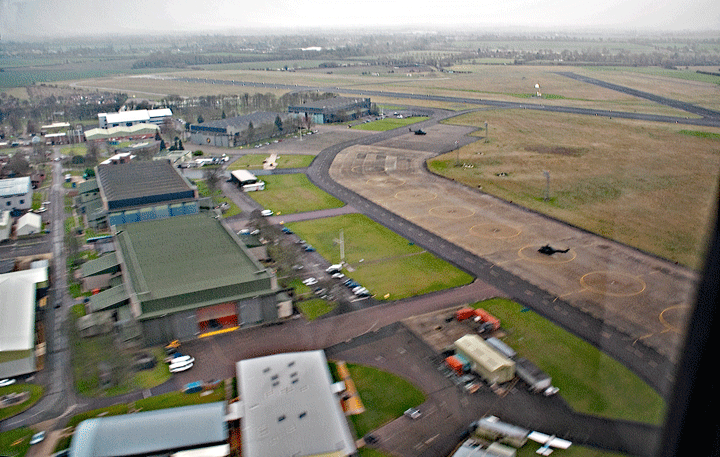
|

|
|---|---|
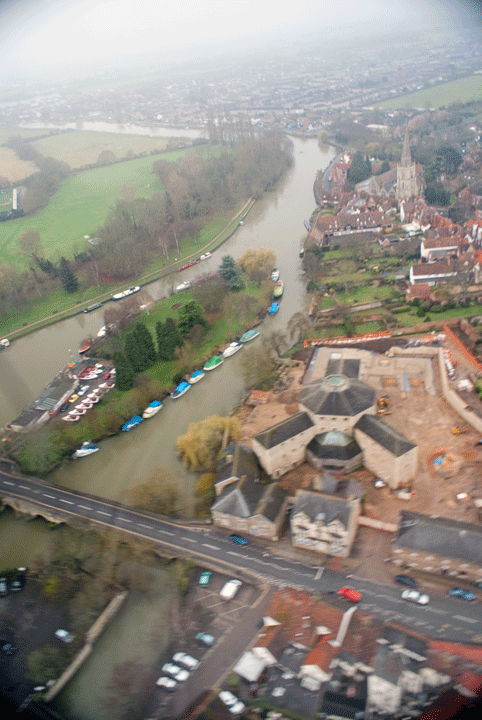
|
|
White Waltham 27 Feb 11
It's at this time of year you sometimes wake up in the morning and realise that the sun is out, the birds are singing, and there's a whole sky just waiting to be flown in.
The forecast says it will rain before lunch, spreading from the West but this morning will be lovely, so better get going!
White Waltham is the home of the West London Aero Club, and is terribly famous as being where all those 1930s aviators learned to fly on Tiger Moths: you've seen them in films like "Out of Africa" and "The English Patient". Apparently it's very bumpy indeed: far too bumpy to be allowed to fly to. Well, we'll see.
By 9.00am Sunday morning I'm at the aircraft, taking off the cover. There's even some fuel in the plane, so off we go in to the beautiful blue morning, heading South East.
Change to Benson, who are normally quiescent at the weekends, but whose ATZ is Active this morning, so we will climb over the whole kit and kaboodle and change to Farnborough East so they know where we are and what we are doing. Technically we are about to infringe the London TMA as, like Fairoaks, parts of the White Waltham circuit are close to/in the TMA. By the time we are over Henley at 130Kts I can see White Waltham a little too closely, so orbit whilst changing from Farnborough and descend for a downwind RH join for 29. This all feels a bit rushed, so we may have to have another go.
 But no, despite radio calls being mainly blind (there is a service, but it's a bit sporadic) we end up in the approach cone for 29 and flare at 60Kts over the little white concrete numbers embedded in the grass. Expecting a rough ride I am pleasantly surprised by a bounce-free arrival and a smooth runway. It's not bumpy at all!
But no, despite radio calls being mainly blind (there is a service, but it's a bit sporadic) we end up in the approach cone for 29 and flare at 60Kts over the little white concrete numbers embedded in the grass. Expecting a rough ride I am pleasantly surprised by a bounce-free arrival and a smooth runway. It's not bumpy at all!
Vacate right, and taxy the mile or so across the grass to the other aircraft (no taxyways here), putting up a rabbit as we go. I think I do understand actually: there are ridges and a prop strike is a possibility here. Maybe I was a little too harsh.
There is no indication of where we are meant to park or even taxy, so it takes a while to find the parking slots where we park at random and shut down. It's very muddy, which makes the aircraft slew about in the ruts. Interesting...
There is an old adage that nothing is too stupid to do. Well, here's something you don't want to do twice.....
After a cup of coffee I fire up the aircraft and taxy out to where I am pretty sure you're meant to do power checks, then on to where I think 29 starts. Hearing no "Final" calls, we call "lining up" and roll.
At this point, due to the mud, I think I might do a short field take off, and hit the flaps down. Brain says "2 stages, 20°"; finger says "3 stages, 40°" [but see Fly By Night later on: it looks like this was actually an aircraft issue on rough ground...]
So at 60Kts it doesn't feel like it wants to fly: we leave the ground but it drifts back down in to ground effect and feels awful. Shit, what's going on?
We've got plenty of runway left but there are hedges out there eventually. Quick scan: mags both, throttle full, prop fully forward, fuel both, carb heat in, flaps.... ah.
Flick up 1 stage, and as the motors grind upwards the normal rocket-like climb rate is restored and the mushiness goes away. Phew!
The sweats only set in after a couple of minutes once the stress of ensuring a climb out under the TMA has abated and we're with Farnborough and on a squawk. That was not something I wish to repeat. Stupid Stupid Stupid.
Back over the Chilterns we climb over the Benson MATZ stub and we're at the base of the clouds as the front rolls in. As we descend for a left base for 19 the clouds follow us down. D129 (Weston on the Green) is Active: they must be dropping through the clouds.
Continuing my theme of short field work, we do a full flap landing and aim for one of the squares half way down the runway. Whilst we don't actually get the wheels on it I reckon we were damned close. All this experimentation with the mushier end of the envelope is helping, though: we do another greaser.
Whilst putting the cover on the rain rolls in: glad I have my anorak with me.
And finally I have more P1 ("Pilot In Command", don't you know...) hours than P2 (under instruction). Ooh, that does feel grown up.
Just got to stop doing the stupid stuff now.
Gloucester and Swansea 7 Mar 11
I am to visit a potential client in Cheltenham, and it's such a beautiful sunny but cold day I just can't face fighting the sluggards on the A40.
So I will go to Gloucester Airport and take a taxi into Cheltenham from there.
And that's the joy: any feeble excuse, a quick e-mail to the others and turn up with the key, book out and FLY.
There is sufficient fuel in the tanks for what I have planned, so no need to top up. Just fire up and head out from 01 with a left turn out, and by 9.30am I am in the air heading for Gloucester.
It's surprisingly hazy at 3,000ft but at 23½/23½ we're doing 130Kts and over Gloucester in 12 minutes, descending for a Downwind join for 09LH.
A controlled descent has us flaring 1/3rd of the way down the runway, but I leave the power on a tad too long and we land fast for my first bounce in the C182, just a little one then we're down and rolling, exiting for A1 and the apron.
Flight time: 18 mins. Better than an hour at 40mph on the A40 behind some drooling idiot.
Whilst waiting for a taxi outside the terminal I watch some passengers climbing in to a KLM/Manx Air Dornier. An Oxford Aviation Seneca lands on 09, disappears behind the Dornier.... and fails to re-appear.
Moving round a bit I can see the Seneca now stopped half way down the runway with a collapsed nose-gear leg and mangled props. Off go the Fire people, and the Manx Air passengers exit the aircraft: Gloucester is Closed.
At that point my taxi arrives and I'm away to do some work.....
2½ hours later I'm back at the Terminal, work completed. As I step out of the taxi the Manx Air Dornier and passengers, plus the runway-blocking Seneca are still there! Although Gloucester is now open for little aeroplanes like me, the runways in use are not long enough for the Dornier. Oops.
I'm getting hungry and Swansea beckons (well, now I've got the aircraft...), so pay the landing fee and wander out to the aircraft, avoiding the Security checks (well, I am holding those well known weapons of mass destruction: a pad of paper and a pen).
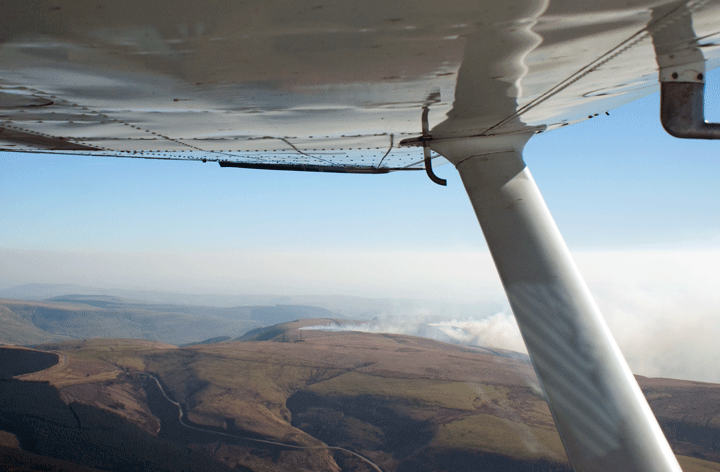
|
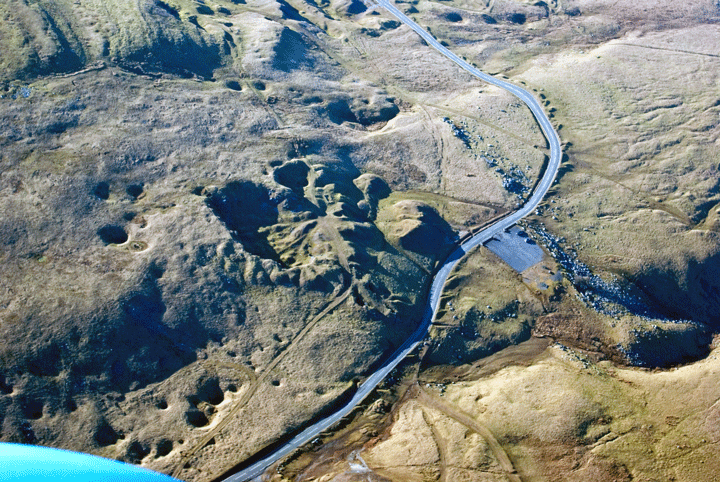
|
|---|---|
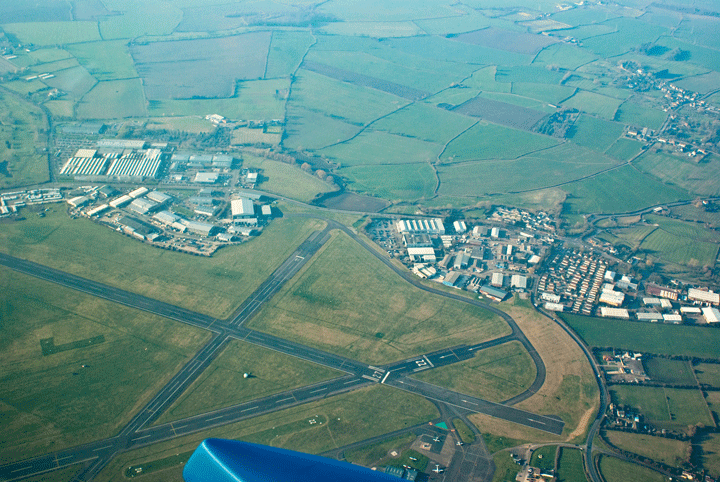
|
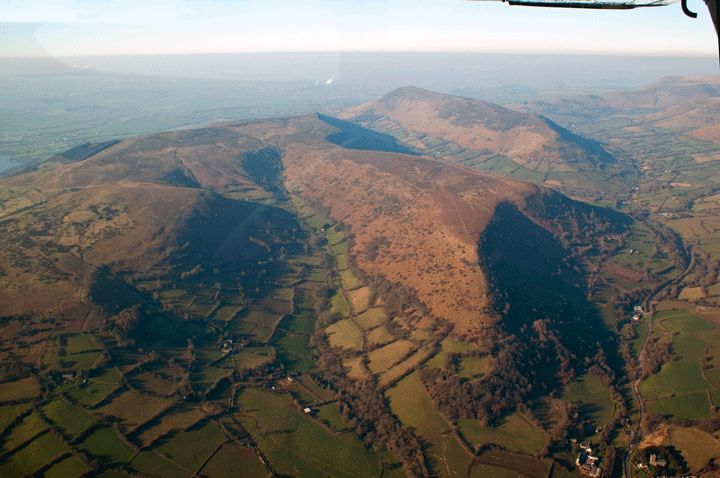
|
The port tyre looks a little deflated: not flat, just a bit soft. I can't find anyone with a pump, so this is one that can wait: the C182 next door has a flatter looking tyre and he is flying it. But we'll keep an eye on it.
As we fire up, the wounded Seneca (the main gear had collapsed as well) is towed past, all twisted props and scraped belly. I reckon that will never fly again (which is true: a few months later I see it stripped in the boneyard at Oxford).
Off to Swansea via the BCN beacon for some VOR practice. At 3,000ft it's surprisingly bumpy for there being no wind: it turns out there is an inversion layer and I'm trundling through it.
Beyond Brecon there are huge heath fires burning, leaving a vast pall of smoke through which we eventually fly, the air smelling slightly of grass smoke, before the coast appears again and we line up for the approach to runway 22.
This duly appears out of the haze and we slide down for a frankly less than perfect landing. My landings are awful today: this time we still have too much speed on and the flare goes on too long: we are drifting towards the edge of the runway by the time we touch and although it's safe I'm not happy.
Roll in for a BLT and some serious e-mail (got to look like I'm in the office!).
Having power-checked prior to entering runway 22 the aircraft starts not tracking straight. Huh? I've left the parking brake partly on. Don't want that on for take-off! The trick turns out to be to push the handbrake lever down, not rely on the spring to release it. Add to operating method notes...
Taking off from runway 22 again and curving round for a Northbound departure we head for the North (more interesting) side of the Brecon Beacons before heading East. The weather here is better and at 3,500ft it's very smooth and calm. We get everything settled, trimmed, leaned and on track before doing the photography thing: these hills are photogenic.
30 minutes later we are back over Ross On Wye where we change back to Gloucester and request a transit through their ATZ: as we pass through we can see a transiting Dauphin below us a little too close for comfort. Exiting East we are over the hills in a couple of minutes and back in to the haze. Swing out past Little Rissington, then back on track and switch to Oxford for an ATIS update and descend for a crosswind join RH for 01. At the last moment, turning Final, a Gulfstream appears and I am asked to go round and take an early turn. As we swing round he looks very impressive, cruising in from Botley. Round again for another go (good practice this), then in and really concentrate on a decent landing. And this time we manage it, really nice and smooth.
Halfway down the taxy home, the aircraft is veering off to the left a bit. I look carefully and the parking brake is still slightly on: it must not have gone right down at Swansea. Have to watch that one: it must be pushed all the way down positively.
Nice lunch in Wales, good piece of business and safely home by 4.00pm: that's the way to use a sunny day.
Wellesbourne 7 Apr 11
The weather is set to be wonderful all over the weekend, so we have a Grown-Up trip planned. In preparation for this, as I haven't flown for a few weeks, I'll nip out to Wellesbourne for some circuits.
The aircraft has been moved and our parking space is now behind one of the hangars right at the corner of the airfield; a perfect place as we no longer have to fight in the mud, but as the Tower cannot see us we need to ask for start-up permission, which the Tower duly gives, and I taxy gingerly out, minding the hangar doors.
Off towards Wellesbourne, and the GPS is refusing to play today, so a quick VOR crosscut gives an accurate indication of Wellesbourne's direction and distance and I settle in to the circuit. As normal, the first approach feels rushed and I'm not quite in control. Flare too late, and a slight bounce indicates that I am indeed going too fast. Oodles of boodle and we're off and up again. Subsequent approaches feel more controlled and I'm getting the flare speed more in the right band so initial ground contact is less severe.
Running out of time, so one last barn door job and taxy in for a ham sandwich and orange juice.
It's easy to forget how quick this aircraft is, so by the time I have departed 36, turned South, climbed to the 2,800ft cloudbase and changed radio we're well past Banbury and Farmoor is glinting in the middle distance.
A quick change back to Oxford Approach, a swerve around D129 to avoid the parachutists and we're Right Base for 01, so slide down the approach and do a creditable landing before filling up at the pumps for our Big Trip.
Putting the aircraft away is interesting: first time pushing a C182 in to a parking space before with the towbar (could do with Beta mode on the prop!). It turns out to be very easy and before long TG is covered up once more.
Compton Abbas and Yeovil 15 Apr 11
Compton Abbas is planned tomorrow, and as this is a relatively short field it is important to ensure I can get in, and out again. I need to fill the plane up anyway.
Ops kindly send the bowser round, and I get the full bizjet experience. The bowser doesn't like going on the grass, but on the tarmac is fine. I could quite get used to this luxury....
Fire up, taxy out, hold for a bizjet. Power-checks, then on to 19 for a short-field take-off.
Now that I know the right flap settings and speeds I should not be surprised but at 56Kts, without any control input from me, the aircraft leaps in to the air like a scalded cat and we go up like a lift. We're at 700ft before the end of the runway.
Whizz round the circuit and do a reasonable non-short-field landing. I'm trying a bit more of a heave through the flare and a bit of aft trim on final to help, and it is certainly softening the landings. The C182 does require quite a heave during the flare to arrest the vertical descent, and the extra added trim helps there.
 So we'll try a short-field job: barn doors out, pin it at 60Kts for the flare, and dial in that back trim. Ah, now that's better. The wheels didn't even squeal: just a rumble as they touch.
So we'll try a short-field job: barn doors out, pin it at 60Kts for the flare, and dial in that back trim. Ah, now that's better. The wheels didn't even squeal: just a rumble as they touch.
Taxy in, shut down, cover up. Getting a bit slicker at the pre- and post-flight bits now.
I like Compton Abbas: it's basically a restaurant with outside entertainment area for children of all ages, where the entertainment flies in and pays for itself. It has a nice child safe outside area and people do aerobatics for fun in the circuit. Today I am taking poor John, the owner of the plane, for lunch. He has various medical issues currently precluding him from flying P1 so I'll take off and he can radio or fly as he wishes.
We switch straight from Oxford to Boscombe Down who give us a MATZ transit at 2,500ft through their overhead, and whilst we bimble through a Tornado screams past us and in to the circuit, swinging its wings out as it does so. It's not every day you can say you've seen a Tornado below you.
Boscombe release us to Compton Abbas who are on a 08 left hand circuit, so we'll join downwind. Due to a mix up between QNH and QFE I end up 400ft too low and end up having to climb in an orbit to reach circuit height to avoid a PA28 also in the circuit. Experience the ground rush of the ground coming up towards us as we slide down the approach, then flare and bounce, bounce, bounce on the grassy bumps before settling down and vacating for lunch.
AgustaWestland build helicopters at Yeovil, and the airfield is theoretically open to visiting GA aircraft. In fact, the very friendly voice on the phone suggest they'd like to have more GA, but they do shut at 4.30pm as it's Friday and we might have to work around their resident helicopter traffic.
OK, we'll give it a try, as this is where Patric lives and our mission is to pick him up and bring him back to Oxford. He has brought a chainsaw with him, which might be fun getting through Security at AgustaWestland's main gate.... if he tells them.
So he doesn't. It's in a suitcase.
Taking off from Compton Abbas runway 24 I do a short-field to avoid most of the bumps and we get the full "hand of God" effect as the land drops away beneath us.
No turns necessary: Yeovil is straight ahead of us so we simply continue on the same heading and switch to Westland who tell us to continue the approach.
As we pass Sherborne we can see Yeovil airfield and we simply continue our straight-in approach; I've got lots of time to fine-tune my angle.
They have a helicopter working the main runway and their plan is to get him to vacate just as we hit short final, then as we taxy off he can re-join the runway. But they don't communicate this plan to us, we just keep on getting slower and slower and lower and lower and suddenly they clear us to land and we land...bounce... bounce and we're down. Bloody grass runways.
This week I will be mainly bouncing on landing...
We taxy over to the tower, shut down and climb the huge metal gantry to the top of the factory where the 1960's vintage tower pod is situated with an amazing view of the runway. We are warmly welcomed by the ATCOs, who couldn't be friendlier.
The helicopter is a heavily-modified Lynx with larger blades and different engines: like many military machines the smooth lines of the prototype have disappeared under assorted boxes, blisters and pods scattered about the airframe. It is flying sideways along the runway at about 70 feet pursued by a 4x4 with a long pole on its roof. When they reach the runway end they both reverse course. Watching them is like watching a slow-motion tennis game.
This is some serious flying: piloting a helicopter is hard enough without doing it sideways or even backwards as they then proceed to do. Apparently it's some kind of weapons system calibration.

They will soon run out of fuel, so we head back to the aircraft to leave while they are refuelling. I can recommend Westland / Yeovil; they are very friendly, but they aren't open to GA at the weekends at all and the opening hours follow factory hours, so "all out by 5.00pm" is not designed to attract large numbers of leisure pilots. A £10 landing fee, whilst refreshing, is not going to balance the books either. And then there's that security gate....
With Patric and his carefully-camouflaged chainsaw aboard, we fire up and taxy out to the runway, turn right and backtrack, power-check and do another short-fielder to minimise the "will it / won't it fly" bounces.
A right turn past Montacute House then keeping South of Yeovilton Zone due to the currently unclear nature of their CTZ (the NOTAMs show the LARS as defunct, and they won't answer the radio), we then turn North for Lyneham and contact their zone.
John flies us North and then North East before we swap to Brize. Having informed Brize of our intentions (so they don't think our precipitous descent is an engine failure) we drop down North of Wantage and strafe the house so they know we are on our way home. Wheeeeeee!!!!
We then pop back up, whip round the corner of the zone and join Oxford downwind for 19.
And at last I get a greaser: pulling back just that bit more in the flare, with the extra back-trim on final reduces the vertical speed to nearly zero at the critical moment. Nice.
Henstridge 17 Apr 2011
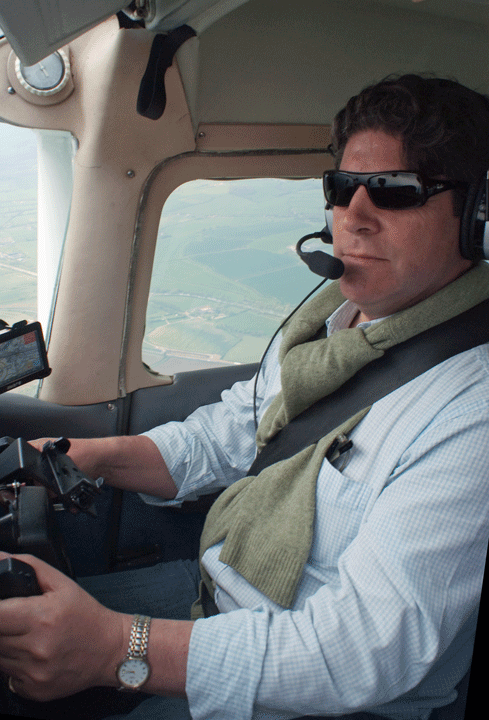 We've had a busy weekend chopping down trees and are all a bit stiff and worn out. It's time to take Patric and his chainsaw back to Dorset. Yeovil is closed, it being Sunday, so we will go to Henstridge instead.
We've had a busy weekend chopping down trees and are all a bit stiff and worn out. It's time to take Patric and his chainsaw back to Dorset. Yeovil is closed, it being Sunday, so we will go to Henstridge instead.
We will take Ollie, who has also been helping us, and Alice. So a full plane takes off from Oxford and we head South for Didcot to avoid the little planes flying around Abingdon today, before turning South East.
There is little visible horizon and when I get Patric to fly the plane it's interesting: he really struggles to keep both the direction and height stable.
He can keep one right but then the other slips out: we end up gyrating across the sky as he tries to keep the octopus tentacles in the string bag.
Eventually we all start feeling nauseous, so I take control and bang the autopilot on: the Pilot-induced oscillations die away and we cruise onwards before turning South for Henstridge.
Passing South of Keevil's ATZ we see some gliders (strobes to ON), then a few minutes later we see a Warrior quite close on a route that I reckon will take him in to the Salisbury Plain Danger Zone in a couple of minutes. Not our problem, though, and we soon change to Henstridge and join Crosswind for a left hand circuit for runway 25.
It's not a short runway so we don't go for the barn doors, but land fast and longer than I intende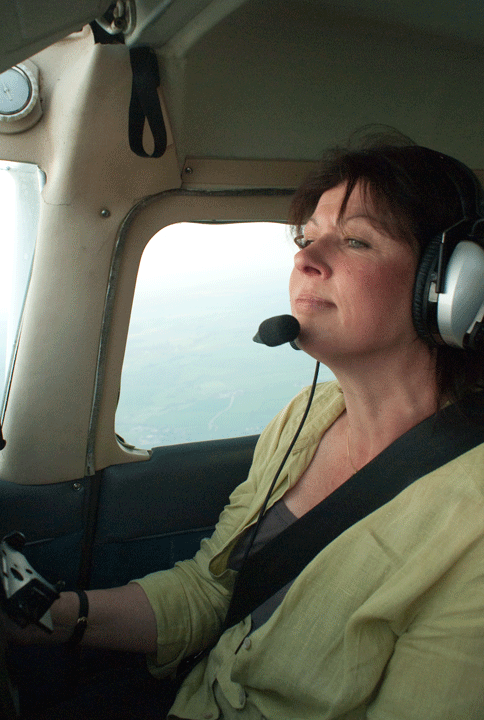 d. As we turn at the end of the runway the Tower asks us our intentions, which seems a little superfluous, so we reply "backtrack 25, turn in, park, have a cup of tea and a wee, and pay our landing fee!".
d. As we turn at the end of the runway the Tower asks us our intentions, which seems a little superfluous, so we reply "backtrack 25, turn in, park, have a cup of tea and a wee, and pay our landing fee!".
Well, what else can I say?
Pauline and her daughters Maddie and Hannah have been without their father Patric all weekend so the least I can do is take them out for a spin.
This time we'll short-field it, so 20° flap and full chat gives us a short take off we then convert in to the requested noise abatement early left-turn.
Climbing out we head South and pass over several small villages. The girls love the view. I get Pauline to pole us around at 1,000ft and the villages roll by beneath us. Dorset is very pretty.
The Garmin GPS is playing up: despite connecting it to the external aerial and doing an auto-configure on start-up (which usually cures it) it's refusing to recognise the existence of any satellites.
The Aware box is working, however, and we know where Henstridge is, so after a while we pootle back and do a barn-door approach, putting the wheels gently on the numbers and turning off by the first exit. That's better.

Patric has been successfuly dropped so we can go home now. Short field take-off, early left turn then continue round for a Northerly heading. The GPS is still playing up, so we try taking the batteries out, which eventually restores normal service.
Up past Lyneham we track well North of the Keevil gliders then switch to Brize Zone, who have gone home, so we switch to Oxford and tell them we are off to Boarstal to take some pictures.
Ollie flies us back to Didcot, then North overhead South East Oxford and Wheatley before dropping down to take some pictures of Ollie's house and climbing back up past the Beckley mast for a right base join for 01.
All this practise has improved my landings: we arrive smoothly and in the right place. I'm more confident about getting the C182 in to Kingsmuir and other short fields reasonably reliably.
The aircraft has been smelling a little of fuel and there has been have been blue streaks under the left wing.
We have diagnosed a fuel leak from the left wing, and the left fuel bladder is to be replaced, but following a visit to Wycombe we decide it can wait for a month or so.
We just won't smoke too close to the aircraft for a while......
Local 22 Apr 11
Once upon a time when I was a little boy I had a best friend called Les, who one day without warning disappeared from school and went to live in Malta, and I never saw him again.... until he contacted me through Friends Reunited and we met up in Ashbourne (see the short-field trip earlier).
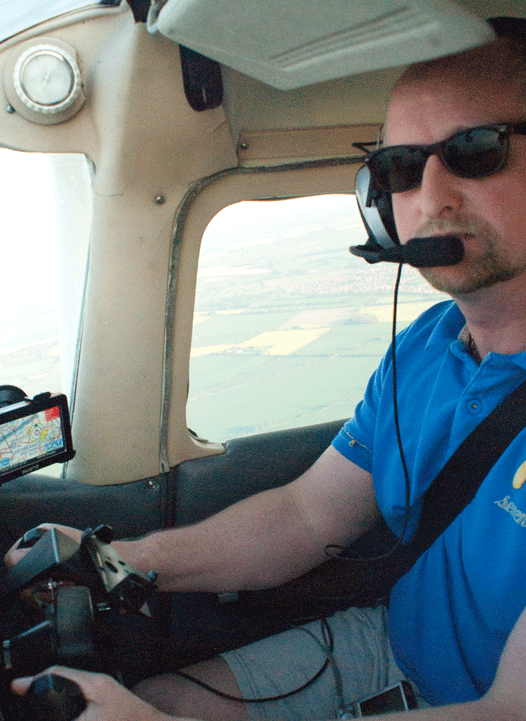
This time he has come down to Oxford in his black Porsche convertible and we're going out.
So we turn up at Oxford - two mid-life crisis men, one grey, the other bald in a Porsche going flying. How sad are we?
It's a beautiful evening for flying and it's Good Friday: the earlier haze has cleared, so we uncover the plane, start up and take off.
We head South over Oxford, then follow the river down to Abingdon. A quick call to Abingdon UAS elicits the knowledge that they are flying, are using runway 18 with a right hand circuit and would prefer us to remain outside their zone, so we agree to remain clear and transit at 2,000ft (thus remaining 1,000ft above their circuit) for Les's old home of Appleton where we descend and orbit for photos.
Then it's descend to as low as we dare and buzz one of our local clients at 120Kts (they know we're coming) then zoom-climb back to 2,000ft for Les to fly us over to Didcot.
It's very smooth, being evening, and the horizon is clear. Les flies us neatly to Didcot then turns us North for Oxford. Once over Horspath we need to run right for Wheatley.
Les tentatively turns us 5°. No, we need more like 90°, so I take it, crank her over and we pull a little G as we turn...... This is not an aerobatic aircraft but it can make your stomach go when you want. Actually, despite the high control forces the roll rate is pretty good.
Once he has seen Wheatley we head North to inspect a possible strip at Shabbington, and on turning back to Oakley... what's that below us but John's Tecnam P92 positioning for an Overhead Join for Oakley?
Oooh, air-to-air photography time......
 Swing it round, and get Les to take some shots as John lands. We keep a very close eye out: there may be other aircraft here, so we remain carefully above circuit height. What a coincidence.
Swing it round, and get Les to take some shots as John lands. We keep a very close eye out: there may be other aircraft here, so we remain carefully above circuit height. What a coincidence.
I can't find Oakley's radio frequency, so we trundle off back to Oxford, which has disappeared in the haze, and although the ADF points unerringly at the field we do need to be North to do the approach.
We join left base for 19, do a nice stable approach and drop it on smoothly. Lovely...
This extra back-trim on short final and a really long, sustained heave the last 4 feet is definitely working.
Kemble 14 May 11
Ann has asked me if I would take her flying. She did 40 hours in the 1970's but didn't complete her licence, so is thinking of taking it up again.
Wake to a gleaming blue sky, but the forecast is for high winds and, later, thunderstorms, so we'll go out for a short trip as early in the day as possible and hopefully get home before we get wet.
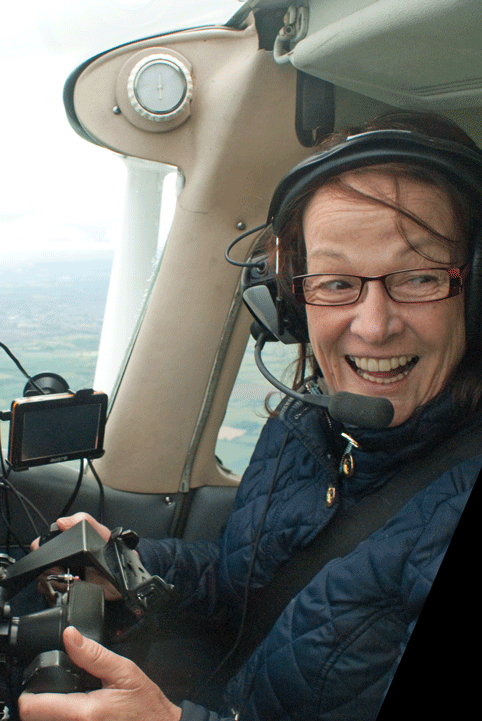 By the time I have picked up Ann clouds are beginning to appear, but they stabilise at "scattered", although the wind is now beginning to pick up. The forecast is that the wind will be strong and gusty, but straight down runway 29.
By the time I have picked up Ann clouds are beginning to appear, but they stabilise at "scattered", although the wind is now beginning to pick up. The forecast is that the wind will be strong and gusty, but straight down runway 29.
The aircraft seems to be parked in the windiest spot in Oxfordshire: the cover tries very hard to go flying all by itself, but as the ATIS gives 29015G20 which is outside our crosswind limits for 01 we'll ask for a 29 take-off. That is no problem, and we power check on the taxiway.
I'll do a short field take-off, so deploy 2 (not 3: treble-check that...) stages of flap and off we go.
With the headwind we're off within 150m and going up like a rocket: ooh, that was easy. Turn North West, ease the flap in stages once we have a positive rate of climb and head for a spare piece of air.
It soon becomes apparent that Ann is more relaxed and the weather hugely better than expected: very clear, with a 3,500ft cloudbase. And, of course once clear of the ground effect, very smooth. Ann doesn't want to fly yet, so we'll sight-see. The air is so clear that far away to the South East we can see London on the skyline.
We fly South through the ATZ, then over central Oxford, Sandford and Abingdon before inspecting Ann's house and taking some pictures. We bimble about over Grove and Wantage then head back for Oxford, at which point Ann decides she will try her hand at the controls.
And she is very good: after a few minutes (and some seat adjustments) she is quite comfortable tooling about the sky, and asks whether we can go somewhere.
Well, the forecast thunderstorms haven't appeared and the weather looks stable, so we decide to go to Kemble, which means passing back through Oxford's ATZ and heading West for Kemble.
Ann flies us round the North of the Brize Zone and then South towards Kemble, which is visible from a long way away. She then neatly descends us for a crosswind join for 26 left hand and I take over as we pass the take-off numbers. By this time she is asking a lot more questions than your average passenger: it is fairly obvious she is no beginner. Her smile is getting wider and wider.
I am determined to get a decent landing at Kemble for once, despite the gusty wind, so good speed control on the approach, good positioning, counter the big gusts on Final rolling over the hangars towards us, and plop it on neatly a third of the way up the runway. Ah, at last!
Get the coolest taxy instructions in the world: "park outside the restaurant", park up and switch off. Ann's smile is now extending outside the cockpit, it is so large.
It's really nice to be able to inspire someone to go flying, and I think I've managed it today.
This time we manage to get a midpoint start on the runway and are away before we know it. No one is flying today: too windy, apparently....
Right turn, pass control over to Ann, talk to Brize who aren't interested, pass overhead the Nortleach roundabout and turn right, head back towards Oxford really quickly with the following wind, swap to Oxford and Ann descends us neatly to 1,500ft over the take off numbers so we can join crosswind for 01. The ATIS is giving 290 at 11 Kts, so that's within crosswind limits - we'll give 01 a try and if that fails we'll go around and request 29.
It's bumpy down the approach and we get rotor off the trees but once we're over the runway it eases off and we drop on to the centreline easily. Keep the upwind wing down with aileron to stop any nasties as we roll out, and we're home.
More fighting with the wayward cover and we're all done. Ann and I head for PFT to book a trial lesson for her. She's hooked.....
Note: Ann eventually went on to gain her PPL and IR(R) and buy my share in the C182 when I moved away from Oxford
By the time we land I have a headache from all the concentration.
Pete's Mooney is a lovely plane, although the cockpit is very constrained for a fat bastard like me.
I don't think flying Airways is worth the huge effort Pete has spent in getting qualified to fly in them, but I can see the advantage of being able to fly through and above the clouds when flying in Europe. EASA, the European aviation regulators, are planning to provide some sort of en route PPL/IR in the future and actually that may the way forward.
Wycombe 20 May 11
TG needs flying back from Wycombe (where it has been having a new fuel tank fitted due to to a small fuel leak), to Oxford, so now is a good chance for some IMC practise. John drives me over, I do a full and comprehensive A-check, then taxy out and take off.
Climb out North West to avoid the Benson Zone, then settle down for some experimentation: I will fly all Holds/approaches at 90Kts (more time), so need to bring the prop up and experiment with power settings for level flight and 500ft/min descents.
I find level flight is 17-18ins, 500'/min descent is about 13ins.
Then I practise tracking in to and away from the NDB at WCO. Making extra sure that no other traffic is around, and ensuring the compass is reset after every turn, the needle does exactly what it should do: more confidence-boosting stuff. I actually get a dead cut in the end.
That done, I track North West a bit and seeing what I think is Banbury South of me call 12 miles for a straight-in approach for 19. What I don't realise is that this is not Banbury: I'm way over to the East and the Localiser is stuck way out to the right. A situation pretty easily resolved by simply flying West until the Localiser twitches. But from there on my experiments bear fruit: I can gain the Localiser and the glideslope from beneath and hold it pretty well all the way down: pre-landing checks including Ice at 4d and call 100 above and MDA, and we're damned close.
A nice, smooth landing, a fuel-up and that was a very satisfying afternoon's work.
Kingsmuir Fife Kingsmuir 21-22 May 11
We have been promising Nessa's Uncle Tim that we would visit, with Mother-in-law, by plane, for the weekend. So we have finally agreed on a date: the weather looks OK, but windy, and the forecast winds match the runway headings we are planning to use, so we should be OK.
We're going to do in one hop: I think 2¼ hrs shouldn't be too long for any of us.
I’ve never flown North of Ashbourne before, so this is a Big Adventure: even bigger than Morlaix.
I was under the impression we needed a flight plan as we are crossing an FIR boundary but no, it turns out we don't, so that is one less thing to do.
Saturday morning, bright and early, we pack Nessa and Brigid in to the plane, take off and head North East. We change to East Midlands, then Doncaster, who vector us around their zone to avoid a Citation, then we pass over to Durham Tees Valley as the military guys are all asleep, it being a Saturday.
Durham Tees Valley pass us over to Newcastle, who want to vector us East over the city centre. However, what I think are the Tyne bridges turn out to be too far East: oops...
Then he vectors us North and allows us Northbound out over an increasingly unpopulated landscape as we change to Scottish Info.
Travelling up the country we get a whirlwind tour of regional accents, ending with a broad Scottish burr, which is lovely but the transponder is playing up again: the 3rd digit is mis-reading. Bugger.
As we pass Berwick On Tweed the wind starts to increase: we get rotor off the hills and start getting seriously bumped about. This gets steadily worse until I am starting to bump my head on the ceiling.... Mother-in-Law is unimpressed.
However, once we've coasted out over the Firth of Forth it calms down again, and after coasting in over Anstruther we start to look for Kingsmuir. As normal, my main concern is the length of the runway: 620m sounds a lot but unless the approach is over fields the touchdown point needs to be just right.
Soon we realise we are right over it, so call blind on Safetycom and descend deadside for a left hand circuit for 24 (well, might as well make it up as we go along...).
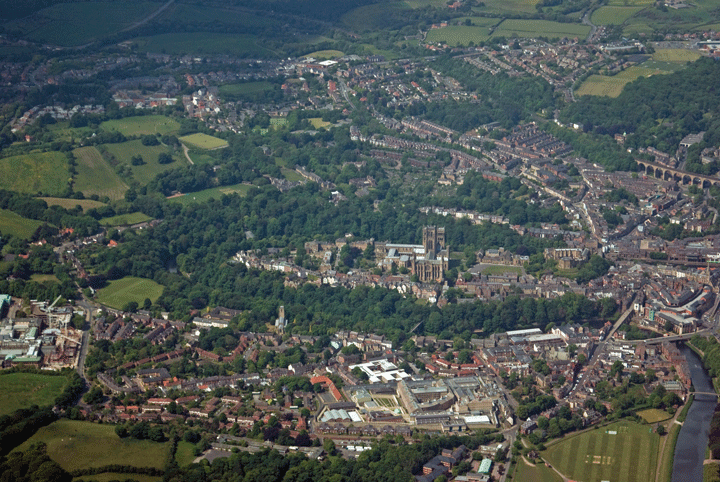
|
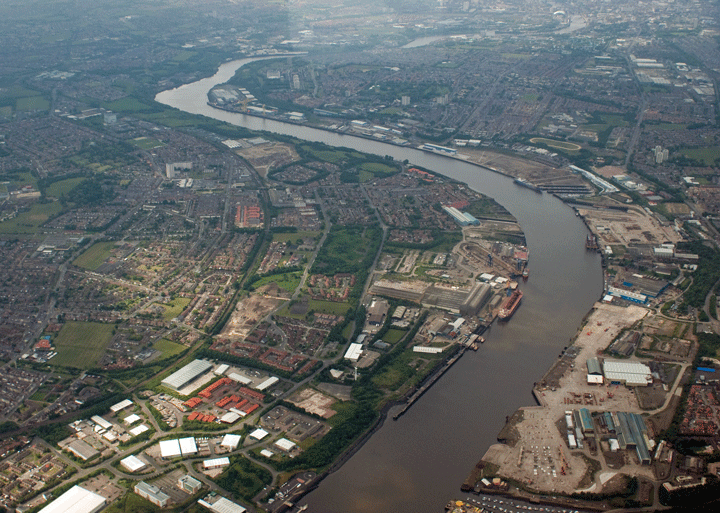
|
|---|---|
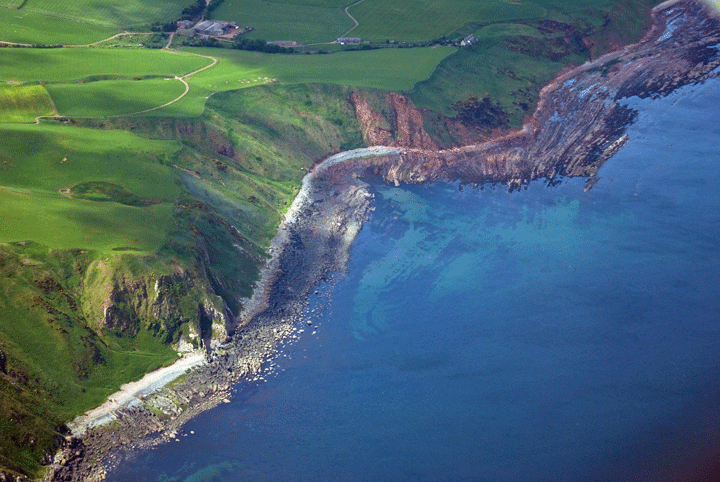
|

|
Turning Final, we do a low pass over the field (the approach turns out to be over open fields, so I can aim for the very start of the runway) then pull up and do a full circuit before settling into the approach groove, the windsock telling me the wind is right down the runway.
In front of the threshold is a track and two cones as an aiming point, so barn door flaps, nail that speed on 65Kts, flare over the cones at 60Kts and settle gently with the stall warner just squawking.
We stop in about 150m (and I was worried about running out of runway...), backtrack and park up where the AFE book's diagram says "Aircraft parking". The friendly farmer owner comes over and asks us to park outside the clubhouse instead, so I disgorge my passengers, turn the aircraft round and taxy over.
Booking-in consists of a tin on the ground marked “C” containing a booking-in book and an Honesty tin. The going rate seems to be £5, so I leave £10 as we are parking overnight.
The following morning we return to the strip to take Tim and Christine out for a flight and to get some fuel from Fife. It has rained overnight and the wind is smooth and once again straight down the runway.
Unwrap the plane, start up and take off. We dodge most of the showers as we head South for Elie and Earlsferry for some photos of the villages and their house, then contact Leuchars to request a photo sortie over St Andrews. They say they are busy, which is a shame, but never mind: we will visit the Forth bridges next.
This is something I have always wanted to do: I have been over the amazing minimalist Forth road bridge several times and that big, chunky, massively-engineered bridge is always next door: a massive contrast.
So we call up Edinburgh Approach and ask for a Zone Transit for a VFR photo session. They're happy for us to do it, assign us a squawk and off we go.
The bridges are everything I expect them to be from the air, and we even catch a train going across. Not something I shall forget in a hurry.
We head North and do some low level photography over various houses before heading for Fife.
Fife is PPR because they have noise abatement issues to the North East of the airfield. There is a housing estate built ridiculously close to the runway and you must not fly over so, like Popham, you have to fly an offset approach, which with this wind will be interesting.

|

|
|---|---|

|

|
Spot the airfield, join downwind in to an empty left hand circuit for 24 and carefully gauge the approach as we drop down over an industrial estate and then a golf course. Barn doors out and it's actually pretty smooth as we turn and drop over the threshold for a smooth and very short arrival. Turn to backtrack, and fail to turn sharply enough so have to put the right wheel on the grass. For some reason the rudder is fighting me and the elevator keeps flopping up and down. Hope I haven't broken anything?
Taxy in to the pumps and shut down. They will come out and fill us up. As I open the door a howling wind bangs it shut again. Bloody hell, it's windy. I didn't realise. That's why the controls were flapping about. Gee.....
The very kind radio-cum-petrol-cum-money lady is obviously impressed by our bravado in flying to Kingsmuir from Oxford in such inclement weather, and won't shut up!
After a wallet-lightening trip to the pumps we start up again and head back for the runway. A short take off in the huge headwind and we are headed back for Kingsmuir.
Tim takes the controls briefly but is worried we are climbing too much, so I take us back to Kingsmuir for another low over the grass approach to the cones and smooth landing. I do like this strip...
After lunch we return to Kingsmuir to fly home.
The wind is now rapidly creeping round to the West and strengthening: we get blown about just loading the aircraft. The poor C182 is shaking like crazy just sitting on the ground.
Fire up, warm up, power check in-place, taxy to the threshold then flaps set for short-field.
Deep breath, brakes off, into-wind aileron hard down and Go.
The roll is short and choppy. At 55Kts I raise the nose a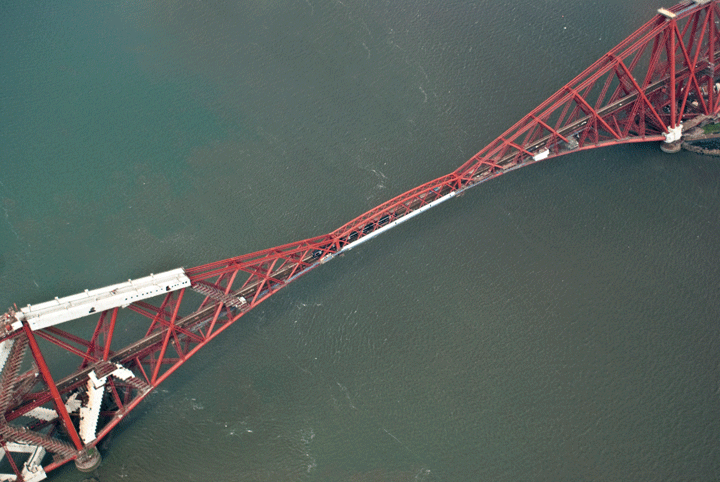 nd we go up almost vertically. As we clear the tops of the trees we are blown sideways. Twisting the ailerons almost from stop to stop in the chop we are safe as we are above anything: we just need to keep it shiny-side up and climbing. But I have never experienced such turbulence before.....
nd we go up almost vertically. As we clear the tops of the trees we are blown sideways. Twisting the ailerons almost from stop to stop in the chop we are safe as we are above anything: we just need to keep it shiny-side up and climbing. But I have never experienced such turbulence before.....
Eventually we reach the coast and it smooths out. Contact Scottish Info and in a somewhat breathless voice request a Basic Service for the journey South. We will climb to FL35 then FL40 when we turn at SAB. It's very bumpy still, but Granny is in the back and a little more relaxed, so we cruise South with an unforecast tail wind giving us a ground speed of 165Kts. Wheeeeee!
Scottish pass us to Newcastle who pass us to Durham who pass us to Doncaster. We cruise at the cloudbase of FL40, then descend to 3,500ft to maintain VFR. There is absolutely no one else out, so we have ATC's attention all to ourselves.
We switch to a bored-sounding East Midlands and finally overhead Daventry we swap back to Oxford, who are giving 240V26020G30.
This is the worst possible scenario for Oxford: right across both runways and out of limits.
We choose a Right Base for 29 because the wind is marginally less across that one, and float down the approach in to the sun, which doesn't help. We're OK until the very last moment in the flare, when I straighten up to stop the wheels from screeching. We touch tidily, then a gust picks up the port wing: it feels like we are about to cartwheel......
Reflex action: max right rudder, left aileron hard down to the stop, and she just drops back on to the wheels. With that much headwind we stop well before the intersection with 19. A bit shaken, it must be said.
More wing down, less flap, more speed in future. Must stop worrying about running out of runway!
Taxy gingerly in via 19, with aileron fully down in to wind, drop the passengers off at the pumps, fill it up with fuel as the others are taking it back to Scotland tomorrow (in the end they cancel, unsurprisingly) and park it up.
Oxford to Kingsmuir 2hrs 14mins. Kingsmuir to Oxford 2hrs 16 mins.
A truly envelope-stretching experience, if a little scary.
But this is one of those difficult-to-call flights: had I been on my own I wouldn't have been too bothered, but the passengers were worried and a bit shaken up by the landing.
The issue was that the wind was not forecast to do what it did, the wind in Scotland was strengthening and turning (so we needed to get out or batten down for two days - that night trees were uprooted in Fife...), but the wind at Oxford was outside the official aircraft crosswind limits, whichever way you looked at it.
Official aircraft crosswind limits are not absolute limits: with practice you can exceed them and need to ascertain your own personal minima, but it was obviously bad Airmanship to a) scare the pax, and b) exceed to such a margin the aircraft, and my own, crosswind limits.
We did some things right: we arrived after 4.00pm when the wind does get weaker; we used the least crosswindy runway (but discussions with other, more experienced pilots have confirmed what I suspected: a much faster approach (say 80-85Kts) and probably no flap on 19 would have carved through the crosswind more and OK if I used up 1,000m to land I would still have loads of spare runway), and we did actually get the aircraft down safely and undamaged.
But what I should have done was to land at Enstone for a cup of tea (the wind would have been straight down that runway), then gone back to Oxford later that evening (Enstone shuts at Sunset, Oxford not until 10.30pm).
Kemble 26 Jun 11
George will be 16 next week and wants to be a fighter pilot.
Well, that's a great goal, but how do you know you enjoy flying enough to actually become a fighter jock? I have learned down the years that the idea of being a pilot is very different to the reality of being P1 and everything it stands for, so I think it's time we went out to see if he throws up or hates it.
We drive down to Oxford early Sunday morning, the weather pretty overcast but forecast to clear within the next hour or two. However, as we drive up the Oxford bypass the ATIS is giving "overcast, 400ft". We may have to hang around for a bit.....
We book out and pre-flight the aircraft, and George asks a lot of sensible questions, so maybe he is serious after all.
By the time we have finished pre-flight and ensured the aircraft is all functional the clouds are rapidly burning off and by the time we have fuelled it's CAVOK.
We will go to Kemble for a coffee and see how it goes from there, so fire up and roll down to 29 for power-checks. The radio (COM1) is playing-up, hissing and crackling, so we swap to COM2 which seems to work better. We'll take a closer look later.
We take off and because it's been cool this morning there are few thermals yet and it's very smooth climbing out over Oxford. We'll stay low so we can take a look at George's house and sneak around the corner of the Brize Zone by Cumnor.
I'm so busy concentrating on explaining things to George that as we pass over the A420 Cumnor bypass where it becomes single carriageway and a 50mph limit at the top of the hill I realise we are very close to the edge of the Brize Zone; possibly even infringing the Zone..... I immediately turn left and head away from the boundary, but I reckon it was close.
(The GPS tracks later show it was indeed very close indeed; possibly inside by a few feet....).
We head down towards George's house and do a circuit over it (just one, I don't want to stay around the Abingdon Grob Vigilants any longer than I have to) then head for Wantage to show George how to fly the plane.
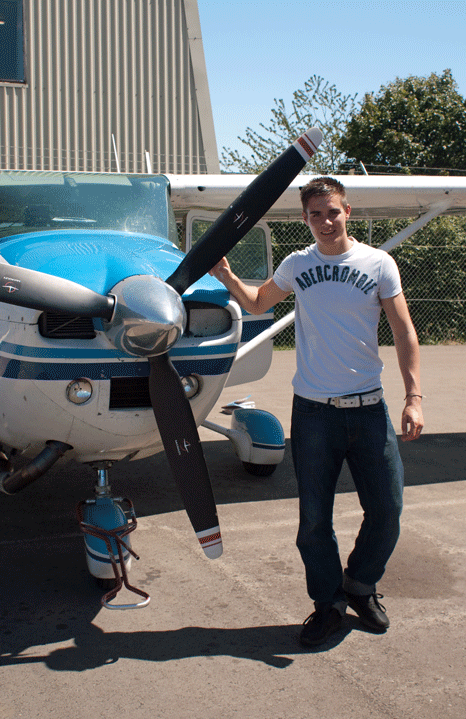 He's pretty good: like most 15 year olds he picks things up quickly and soon he is turning and climbing and diving. The point of the exercise is for him to fly lots so I get him to fly us past South Cerney and on to Kemble where we descend for a crosswind join in to the circuit.
He's pretty good: like most 15 year olds he picks things up quickly and soon he is turning and climbing and diving. The point of the exercise is for him to fly lots so I get him to fly us past South Cerney and on to Kemble where we descend for a crosswind join in to the circuit.
On Final there is another aircraft on the runway so we go around, get an early turn, avoid the villages and come gently in for what will hopefully be a decent landing at Kemble. I'm bored with overshooting here so we'll put down barn door flaps and nail the speed at 65Kts, flare over the threshold and land smoothly in what we later measure as 460 yards; good enough to get us in to Brimpton. This "pull like buggery in the flare, regardless of how the pressure builds up" gets some pretty good results.
Exit at the midpoint: "TG, you may exit at....where you are now". These C182s can pull up pretty quickly. Taxy to the restaurant and hop out for a Coke on the hot terrace...mmmmm.
I ask George what he thinks: "it's sooooo cool", he says, and demands more flying. OK, he can fly me over to the Severn Bridge and then we'll potter homeward round the North side of the Brize Zone.
I love departing West from Kemble: you are so close to Stroud and the Severn, by the time you are climbing out you can see all the way in to Wales.
We dodge the gliders at Aston Down and Nympsfield, and head South West for the Severn, swap to Bristol and they give us a squawk and tell us to let them know when we're done. The bridges are pretty impressive, I'm always amazed more people don't go to see them from the air. Fresh from my orbits over the Forth Bridge, I'm getting a little blasé about these sights.....
George then flies us back North East, we avoid Nympsfield's ATZ and drop down over Winson for a look at the strip we may pick Granny up from (looks nice and long: reckon I can get in there easily), then climb back up and round the Zone towards Charlbury. George flies us while I navigate and radio us back to Oxford, requesting (as it is unbelievably quiet today) a right base join for 19, which we get.
So cruise down the glide path, nail it on 75Kts, fight a few thermals coming down, float over the threshold and squeeze out the last few feet for a smooth arrival on the centreline and a gentle roll down the remainder of 19, a gentle taxy in with the door open and a push back with a very grateful George.
He knows what he wants from life now. Oh dear, what have I done?
Compton Abbas 1 Jul 11
Another week, another enthusiast. This time it's Michael, who is building our terrace. He's done some paramotoring, but is keen to see what it is like to actually control the plane, so we'll go and have tea at Compton Abbas.
Nessa is with us, so we can't be too aerobatic, but we'll teach him the rudiments of aviation, at least.
It's Friday, so the skies are quiet, and a lovely warm day with no wind and scattered, fluffy clouds. Visibility is excellent and the aircraft is free. I need no further encouragement...
Michael asks a lot of questions and wants to know what everything is for and what all the instruments do, so I explain them and we take off on 01, head South on a radial for Compton (CPT) and turn over Abingdon for Lyneham. Having trimmed it out at 3,000ft we teach Michael what the various controls do and he picks it up pretty quickly. Before long I can tell him where to steer and he will steer it. We try some turns and he is very gentle, so we do a few steep turns to rid him of the notion that this is a motor car, and he gets the point (Nessa doesn't...).
We proceed onwards towards the soon-to-be-discontinued Lyneham Zone and Michael flies us, with increasing confidence, past the zone then South for Compton Abbas. As we pass Shaftesbury we descend and turn in to the circuit, making calls as we go, for a downwind join for 27, which is always fun because there are trees on the approach. And as we turn Final a PA-28 appears above us: he has not been making radio calls and is also descending on Final. A collision is inevitable unless we turn away, so we quickly orbit for spacing and descend once more to the runway. Compton Abbas's runway is dish-shaped and bumpy, especially at this end, and it's hard to get low and slow enough not to have the ground falling away from you as you flare; however we touch gently and after a couple of small bounces (keep your nerve) we settle and roll out for tea.
We'll go back via the Boscombe Down MATZ as it is boring going home the same way you came out, and we'll start by having some fun. The drop off after runway 27 is very steep, even more so if you are low; so we do a short take-off to minimise the bounces and then keep the nose down and stay at about 50ft as we shoot off the drop. "Whoaaaaaa...." from the right hand seat means it has had the desired effect. Tee hee.....
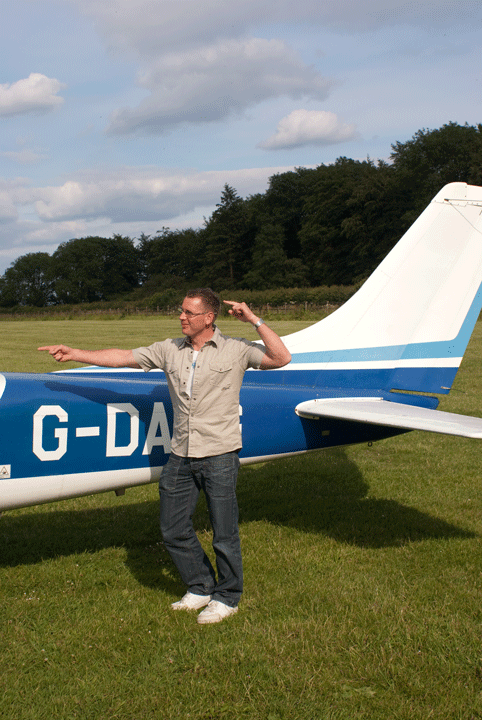 We climb out and head East, circling the odd grand house in that area. Very nice, some of them. Then we climb and head for Boscombe, but by now it is 5.05pm and the silence from Boscombe is deafening....... No need for a MATZ transit, then!
We climb out and head East, circling the odd grand house in that area. Very nice, some of them. Then we climb and head for Boscombe, but by now it is 5.05pm and the silence from Boscombe is deafening....... No need for a MATZ transit, then!
Several other people call but get no response, so we cruise through, avoiding their ATZ in case things are moving down there, but the RAF have gone home for the weekend it seems, and Michael swings us North for Compton as the sun dips and the light becomes golden: it's a beautiful evening.
Before long we are over Compton and as we switch back to Oxford we ask for a transit through the overhead to take a look at Blenheim Palace in the evening light. Passing through at 3,000ft we turn back over Fawler and descend for an extended right base join for 01: ooh, never done this one before.
But it's not hard, just unfamiliar, and before long we are flaring for a smooth arrival on the centreline (getting better at this), keep the yoke back to ease the pressure on the nosewheel and roll out for a gentle taxy back in.
He's keen to come out again and wants to have lessons: I should be getting commission from PFT......
Dunkeswell and Shobdon 10 Jul 11
A week later we take Mike and his friend Ian out. What started planning quietly as a repeat of last week (but with Ian flying) rapidly turns in to more of a marathon - well, who wants to do the same thing twice? The phrase "mission creep" comes to mind...
The weather forecast is for sunny spells and heavy showers. We will try to dodge the showers but if it rains it will wash the aircraft, which is looking a bit insect-splattered at present.
Fill up with fuel (manage to persuade Pump 1 not to cut out after the first tank...) then take off slightly over MAUW (Kidlington has a long runway, and we will burn off a load getting to Dunkeswell) from 19 and head for Abingdon, turn South of the airfield and head South West at 2,500ft.
Lyneham are inactive, so we will pass through their airspace avoiding their ATZ whilst monitoring their Zone frequency. The flip-flop switch on COM1 is playing up: I keep ending up back on the same frequency I started with. Weird.
Ian struggles to keep the aircraft straight and level, like most first-timers. Octopus and string bag applies. Actually, the aircraft is flying right wing low with 4 up and there is no visible horizon today, so I can't blame him too much...
South of Lyneham the Bristol Zone comes up very quickly at 125Kts, we change to them, scoot round the corner of the Zone and head West for the Bristol Channel. I've not been here before and it's interesting to see the hills down here mirroring the Cotswolds North of the M4.
Bristol warns us of an Airbus descending to our right and soon one appears from out of the clouds descending for the Localiser at Bristol - now there's an airport I must fly in to....
Once over the hump at Cheddar the landscape flattens out and drops in to the Bristol Channel - as we coast out we swap to Cardiff Radar and head out in to the Channel for Minehead.
At Minehead the coast starts getting interesting: the cliffs rise sheer out of the water and head for Dartmoor. It's amazing how many houses are nestled in to the cliffs on this remote coastline. I've wanted to visit this at low level for a long time and it has been worth the wait: it is spectacular.
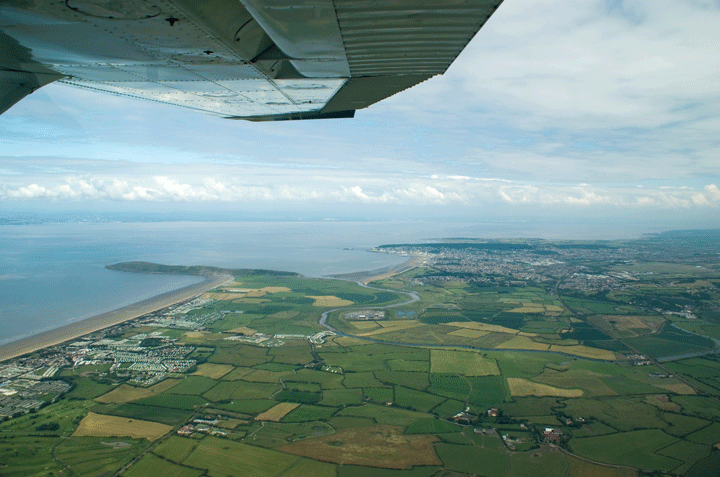
|

|
|---|---|
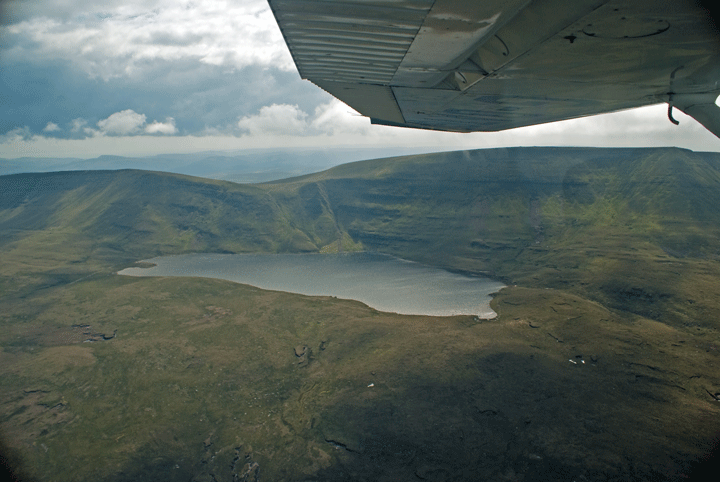
|

|
The last corner before Ilfracombe has a lighthouse blasted into the rock that looks as though stepping out of the front door will drop you down the cliff 300ft in to the sea. Wow.
Turning South we climb up the Ilfracombe valley and switch to Dunkeswell. The last time I came in here was virtually IMC with a cloudbase of 500ft or so. Today is much more pleasant and we skirt around the gliders for a Downwind join for 22 (labelled 23) and a nice gentle arrival for a decent carvery lunch. Nessa is determined to write a pilot's restaurant guide, which I think is a damned good idea.
Pete and I have flown around the Brecon beacons but I have never really explored them by myself. So today we will go visit.
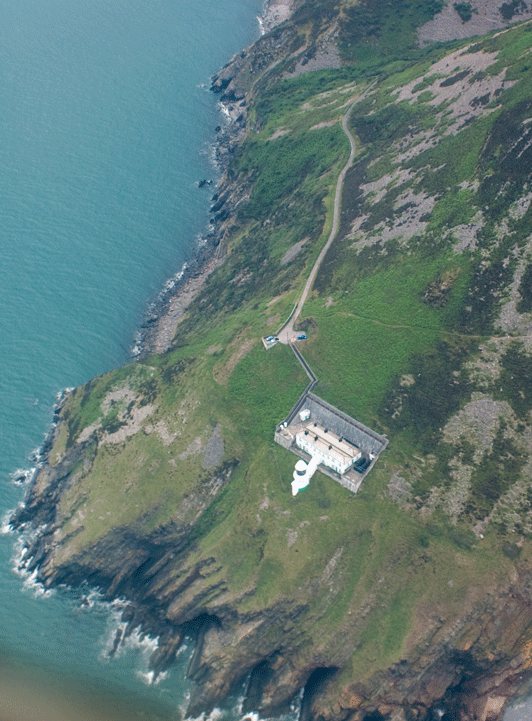
We take off from Dunkeswell, avoid the gliders on climb out and gently turn right to head North once more. Coasting out at Minehead we head North West for Port Talbot and turn inland to avoid 3 Hunters doing a show over Swansea airfield. The weather is better over here and I hope to get some dappled sunlight over the Brecon Beacons.
We head North in to the hills and soon discover a section North of where I have been before which is spectacular: swooping around below the summits we keep finding new and more interesting valleys and meadows. We spend a while flying around here before suddenly Cardiff are asking for our attention.
Now I get to say "Cardiff Radar, Pass Your Message...".
I've always wanted to say that, and it is admissable under these particular circumstances. It just seems weird to be saying it as opposed to responding to it.
As we are dropping off their radar they are worried about us and request our intentions. I say the first thing that comes in to my mind (fatal, this...): "we'll just mooch around the Brecon beacons for a while......" but Cardiff are happy. Eventually we decide we have done enough dambuster runs and climb out, sign off with Cardiff and head North East for Shobdon, who suddenly announce they are PPR now! Oops.
But they let us in as they are quiet and we glide in for an uneventful landing and a cup of tea.
It is pouring with rain as the forecast showers come through and Ian and I make it to the plane but Nessa and Michael are stranded, so we taxy over to the pumps and pick them up from there instead.
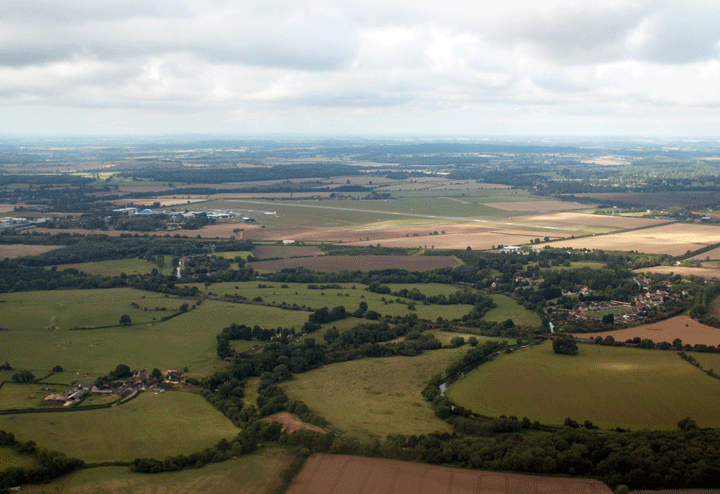
The Tower has gone home so we power-check and pop out on to the runway, backtrack and depart from the rain-soaked with plenty of standing water runway. Minding the noise abatement on the climb out we turn back towards Oxford, avoid the huge shower to our North and head for home on the autopilot, breaking off only once for a circle over Malvern as the weather improves.
There is Silverstone helicopter traffic as we approach Oxford and join Right Base for 19.
There is a bit of a crosswind and annoyingly just as we finish the flare and the mains are about to touch we get a bit of a gust and bounce slightly for a squeaky, jerky arrival. Not perfection, which is very annoying as I have done good landings today apart from this one. Bugger.
250 hours is a good time to reflect a little: I have flown more in the last 9 months than in the last 2 years, and am becoming very familiar with G-DATG; more than with any other aircraft.
We have had a few "interesting" events, and that is part of the gentle stretching of one's personal envelope you should always do.
I need to aim for fewer of those, and also I do need to get my IMC revalidated before they ban any new ones under EASA rules.
Willie needs to do his in September and I think I may ride on his shirt-tails.
I am pretty confident in IMC but ADF Holds I really struggle with.
Bembridge and Shoreham 5-6 Aug 11
Bembridge has been closed following a legal dispute between Britten-Norman (makers of the famous "Landrover of the skies" Islander) who refurbish Islanders there, and the landowner, who I think probably wants more rent from them. They've stopped flying from there and have re-opened Gosport (Lee on Solent) and Sandown instead.
However, the local gliding fraternity who use the South grass runway have re-opened the airfield recently for GA. The restaurant and tower are sadly closed but you can fly in.
So, following a PPR e-mail to the gliding club I am off on a cloudy Friday to do finish off my client's hidey hole just off the end of the runway: he has a few issues (actually it turns out he has a lot of issues, all of which I end up resolving).
I'm on my own today, and Willie has left the cover in the aircraft, so everything is very relaxed - I even lazily get the bowser to "fill 'er up" while I pre-flight: start up and roll. There is so little wind and traffic that although the ATIS gives 19 the Tower offer, and I accept, 01 which saves a bit of taxying.
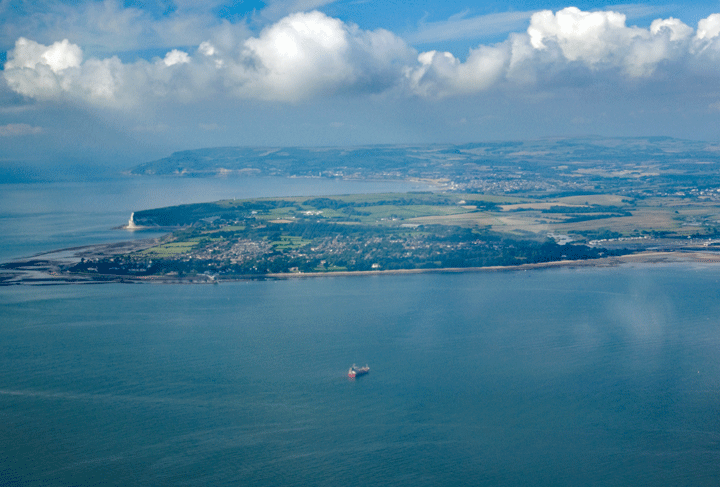
Take off and turn out right, avoid gliding in D129, cruise climb to 2,500ft and start going through clouds. Well, this I can do OK, and we end up at 2,800ft VFR on top with gaps. At Compton we swap to Farnborough and cruise South: it's quiet today and I concentrate on flying the VOR and taking some pictures. On autopilot the workload drops and it becomes very relaxing: to think I am blasting along at 130Kts or 145mph without a care in the world....
At one point a Cirrus comes barreling past in the opposite direction a mile or so away: it's sobering to think that I only saw him as he flew past. Any aircraft on a direct collision course, however unlikely that is, you are going to struggle to spot in reality. And closing speeds can be very high with both of you doing 150Kts or so.....
Over Havant I leave Farnborough and swap to making blind calls for Bembridge as instructed: swing to the East and descend for a right base approach for 30 over the sea. I quite like this approach now that I know it, but it does involve a slightly hairy barn door approach low over the caravan park to get down on to the runway, something I have struggled with before. Normally the caravan park is empty, but of course being summer it is heaving. So I descend what feels like very low over the tents and vans before flaring on the displaced threshold and stopping neatly in under 300m - not bad for my first landing in a month...
Backtrack, park up and hop out. I'm late so have to miss leaving my landing fee in an envelope (pay by cheque later). There are quite a number of planes there, but the cafe is closed. Seems a shame, really....
Following a very successful IT visit to Howe Copse I walk back in the afternoon sun to the field, hop over the fence next to the nice security guard and fire up.
I will say this for TG: it always starts first time. I do the classic thing I always do on hot starts: forget to turn the fuel on. I now know that the moment it starts running rough I need to turn the fuel on, but I do need to alter my checklist.
Taxy out (no ATC delays here...), power-check, backtrack and do a short-field take-off to the West, curving round North and climbing out over the Solent for Shoreham.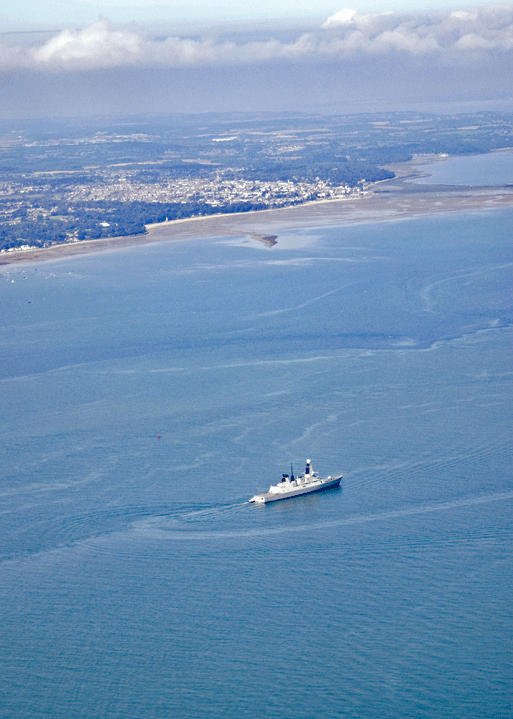
It has turned in to a beautiful cloudless day and within 10 minutes I am talking to Shoreham who advise of a 20 crosswind approach, so descend to 1,000ft over the take-off numbers (mind the climbing PA28 below me), swing around downwind and head for the hills.
This approach is weird, as you have to descend very low over the hills as you turn Final in order to get the correct glideslope on Final: otherwise you're straining to lose height. But I skim the tops of the hills and the A27 before settling (with a tiny bounce) and rolling out.
My client awaits and I am whisked off to Angmering.
Back at Shoreham at exactly 6.45pm (they close at 7.00pm), I fire up and call for taxy. I am one of the last 2 aircraft on the field (the other is a biplane) and I have the choice of runways as there is no wind, so opt for the closer 25 grass.
Bounce...bounce...bounce..... and rotate at 55Kts, climbout North West and change to Farnborough, who are extremely quiet. No one seems to be flying at present, which in a way is great, but on a nice summer evening like this the place should be awash with leisure flyers......
We route via Goodwood which adds 4 minutes to the journey as opposed to the normal route via Midhurst (with complex London TMA airspace close), and I climb to 4,000ft to go over Odiham's MATZ (not that it's active).
It's smooth up here and I think of people stuck on the M25 for 4 hrs (big crash today...) as we cruise homewards. It's very satisfying to be able to do this, especially for work-related reasons. And nice to be trimmed out, cruising, leaned, heading in the right direction with 2 GPSes and a VOR confirming that fact. All is right with the world.
Overhead Greenham Common Farnborough tell me of crossing traffic, but I never see them, and overhead Compton swap to Oxford Approach.
Normally I cruise descend over Abingdon but an Airmed flight is coming in as well for a right base for 01 and he's only a few miles further out than me (and faster), so let's try something different....
Stay at 4,000ft until just South of Oxford, then ease off and descend rapidly. As the speed passes through 155Kts over Port Meadow we can progressively ease off the throttle, then as we achieve 1,500ft, the wind singing in the rigging, back right off, trim back and slow right up to 100Kts (max flap speed), flick out the flaps and slow to 80Kts just as we start to turn Final. Nicely judged and incredibly quick, cruise stably down Final and flare for a nice gentle arrival on 01. Roll out with the Airmed on Final behind, clear the Active and he lands right behind us. Taxy in and pack up: as I'm on my own there's no great hurry. Nice and relaxed.
Perranporth 2-4 Sep 11
Our friends have invited us down to Cornwall for the weekend, so we are going down on Friday and have a hire car booked. We will go down via Brecon and the North coast, back via Plymouth (or at least, that's the plan....)
Leaving Oxford three-up with baggage and full tanks takes a lot runway: those bags are heavy! It's sunny as we take a right turn out and depart Westward via Charlbury and climb to our planned altitude of 3,000ft. Alice flies us very smoothly until we reach the Wye valley where the clouds have built up sufficiently that we are flying through them and they are bumpy, so we climb to FL40 and flip the autopilot on. Soon we are entirely VMC on-top; I can see a tiny patch of blue way away over the Bristol channel so we are technically legal, but it's stretching it....
I am experimenting with using the autopilot in modes other than the straight HDG "follow the DI bug" mode, and today we are using the NAV mode which slaves it to the VOR. After a false start I get it to track to the BCN beacon inbound, and then outbound SW and I'm concentrating so hard on testing it I forget we are at a height and course that will pass us through a segment of Cardiff's Controlled airspace. We are talking to Cardiff anyway, and they simply clear us through but it means I have to fly very accurately for a few miles.
Over Porthcawl the cloud abruptly ends (why is the weather always so awful over S Wales?) and we slip across the Bristol Channel towards Ilfracombe. We can see cloud inland but over the coast it's bright blue sky and we fly down the North coast towards Newquay.
Cardiff passes us to Newquay and we opt to fly out to sea a bit rather than fly through their overhead, turn inland and descend towards the offset approach for runway 25 which, in a way that ensures total landing concentration, ends on the clifftop. No overruns, please?
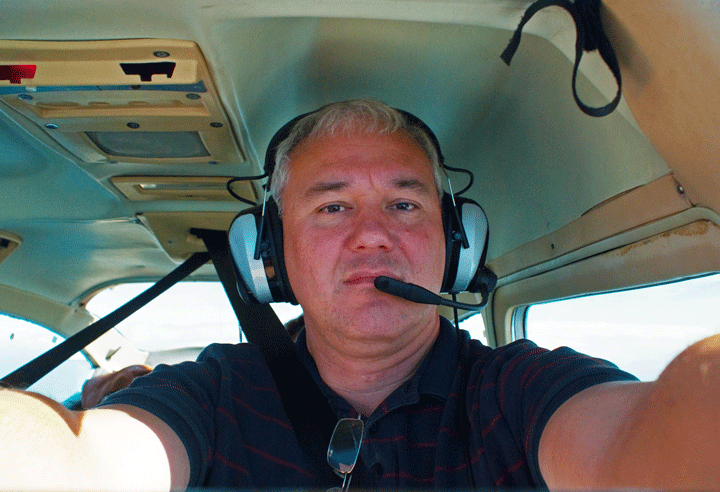
|

|
|---|---|
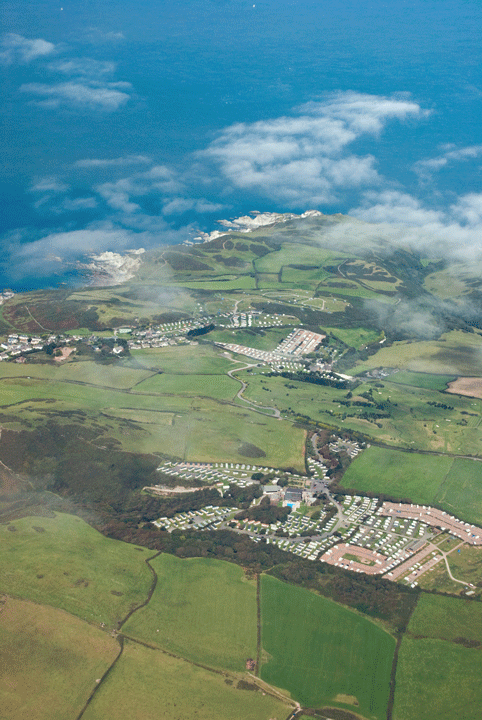
|
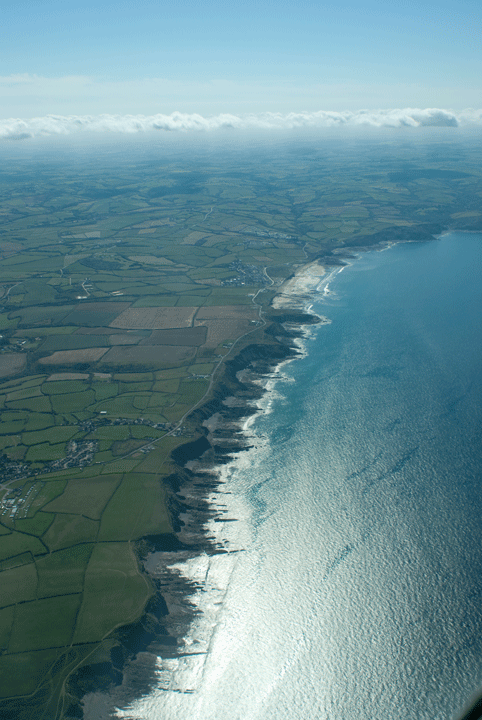
|
We're heavy, so by the time I have full flap in and we're stable, anything other than a descent requires a lot of throttle. I've recently realised I haven't really got full-flap missed approaches down pat, so must do some. But now is not the time (Cato...).
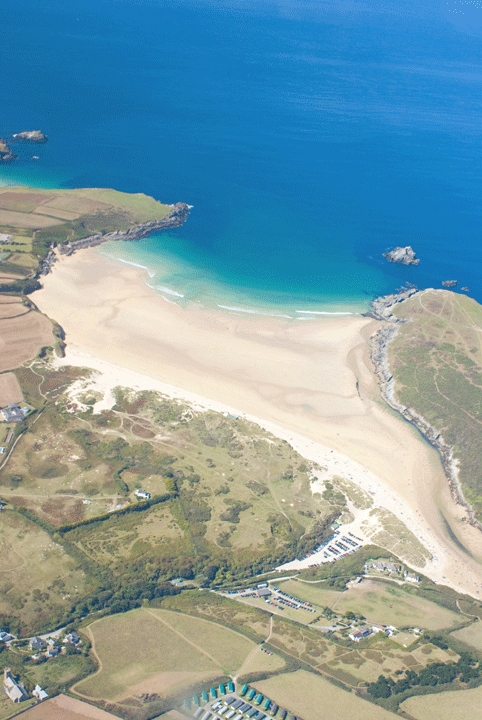 In the event I put the mains neatly in the numbers and we're stopped by the intersection, so turn left and on to the grass for parking. Drive the hire car to the plane and unpack: how civilised is that?
In the event I put the mains neatly in the numbers and we're stopped by the intersection, so turn left and on to the grass for parking. Drive the hire car to the plane and unpack: how civilised is that?
After a wonderful weekend the weather forecast for Sunday afternoon turns ugly: big winds and a nasty front coming through. Reading the weather runes very carefully I reckon so long as we are out by 3.45pm we will be ahead of the front, but as we leave our friends it starts absolutely bucketing down: the front has arrived, and it's early.
We drive up to the airfield and the rain is slicing across the field: 300ft cloudbase, 21017G32 winds and a very wet and forlorn looking TG alone on the grass. I think the girls are going home by train...
But 5 minutes in the tower changes my mood completely: it's going to blow through in an hour so we can take off after it, fly over it and land at Oxford before it arrives (hopefully).
By the time we have nipped in to Perranporth, filled up the hire car with fuel, loaded up the plane and put some more fuel in (runway behind, fuel in the bowser, these are a few of those useless things.....) and returned the car keys to the tower, incredibly the sky is clearing. He was right, all we have to do now is fly over the rain if we can.
Contingency plan: if it's awful we turn round and come back to Perranporth.

Fire up, backtrack 23, turn round, roll. With less luggage we take off early and turn out over the sea at 1,000ft, turn towards Newquay, sign off with Perranporth and climb to see if we can get on top of the front.
At FL50 on the autopilot (so we're not going to suddenly upset) I reckon we are above most of it and as we catch the front up we can see the rain below us. It's getting murky up here but it's smooth, so we get a Deconfliction service from Exeter, then Cardiff, then Bristol.
We can see the ground behind us and a brightening area in front, then we pop out in to bright sunshine South East of Bristol. From there it's a smooth ride back to Oxford via Lyneham, join downwind for 19 and a smooth landing and rollout in light wind. The rain will come through later.
I've been experimenting with landing on the stall warner (although with crosswinds I do land at a higher speed for greater control authority); the stall warner is of course a) a stall warner, and b) it's not an all-or-nothing game. It starts to whistle gently long before it blares, and experience has shown that careful modulation of that whistling is quite a good flare guide for smooth-as-possible landings.
Now I seem to have stopped the little bounces (too high speed, too high vertical speed in the last foot; the Cessnas are intolerant of being dumped the last foot, unlike the oh-so forgiving PA28s with their oleo suspensions) I can usually adjust the vertical speed in that last foot to get a single small squeak from the tyres, then hold the yoke back to let the nosewheel land as gently as possible. It's very satisfying, playing the landing game.
One thing I don't realise until partway through the return journey is that I have managed to crack the screen on our Aware GPS box by leaving it in the bottom of my flight bag over the weekend. This progressively disables the Aware during the return flight and after landing I have to take it off for repair.
Amazingly, Aware are just down the road in Wantage, extra amazingly they suggest I bring it in the following day, and fabulously amazingly they agree to replace the screen on the spot, update the firmware and only charge me £50.
Now there's Service. A wholehearted recommendation for Aware.
Wellesbourne 24 Sep 11
Pilots have always flown from the left seat. Why, I don't know exactly, but it has something to do with Americans inventing the aircraft and sitting on the same side as they would in a car (the "wrong" side, of course, from a British perspective...).
However, for a project we have in mind we need to put a (non-pilot) cameraman in the left seat, and for that to happen I need to be happy to fly (and, most importantly, to land) from the right seat. Also it's useful knowledge for if your pilot ever becomes incapacitated, so worth a try.
So Today, Steve and I will both do some circuits from the right hand seat. We'll go to Wellesbourne, as they are friendly and do a good cup of tea; also, if we make a mess of things it's less visible than at Oxford!
I like flying with Steve: he's a retired airline pilot and brings a lot of big aeroplane cockpit systems management and CRM experience to flying a small plane. He's also flown more ILSes than I've had hot dinners, so for IMC work he's your man.
We'll fly up with him in the left seat as non-handling pilot and I'll fly P1 from the right seat, then swap coming back again.
Most of the controls are to hand and there's an altimeter on this side, but a few instruments over there are hard to read, especially the ASI and the turn n'slip indicator. It's also quite awkward starting the engine and doing the parking brake and the primer (but not impossible), so we delegate those to the left-seat pilot, but do all else from the right seat. I feel like an Instructor!
We taxy out and turn on to the runway. It feels very strange taking off: the view is different and the aircraft even sounds different. I find it hard to track the centreline accurately but rotate OK and we climb out, Steve calling speeds. We head North towards Wellesbourne, pausing on the way for some general handling (feels OK to me) and Steve's porage oats test (don't ask!) before descending into the circuit at Wellesbourne. I've got used to the "right hand yoke, left hand throttle" now, but don't have the deftness that comes with experience.
The first approach feels wrong: positioning the plane in the circuit is hard and my hands don't quite do what I tell them. We drift around the approach cone but make a reasonable, if long, landing. Touch 'n Go, take off again and it starts to come together as we start the second circuit. I'm used to the positioning and the controls and this time, apart from a complete lack of trimming, it feels more controlled and less cackhanded. We climb out again and agree that the 3rd one will be to a full stop for a cup of tea. Round we go, drop down the increasingly turbulent approach and land, a bit of a thump and not on the centreline but it's good enough; I think we've laid that one to rest.
Taxy in, stop for a cuppa, and pay for 2 more touch 'n go's for Steve.
Steve's now flying from the right hand seat and he "gets it" quicker than I do, as befits a man with a huge amount more experience. He does two well-controlled touch 'n Go's, then flies us South back to Banbury, at which point we ident and pick up the Localiser for me to do a "visual" ILS back in to 19. I am absolutely determined not to cheat and look up, so with Steve as safety pilot and doing the radio, we slow to 100Kts, pop in 10° of flap and stabilise the aircraft at 100Kts and 2200ft on the Localiser, looking for the glideslope to appear at around 11d. It starts to come in from above and I concentrate on "flying the dot".
The secret with the ILS is to become the dot and get it to stay in the corner of the room on the floor at the foot of the wall. I've become a bit "Zen" about this lately, and the line in Star Wars where Luke gets to "use the force" when approaching the Death Star torpedo release point (you either understand that or you don't, I'm not going to explain it...) begins to take on real meaning. And I repeat the mantra "don't look up". I even get a "good Localiser tracking" from the right seat, which from him is true praise.
I've not got the descent rate quite right, and we spend most of the approach slightly abve the glideslope, but I gently adjust and we sink down on to the glideslope as the DME winds down. If you are going to err, only err above the glideslope because there is no ground above the glideslope to crash in to!
I ask Steve to call when we reach 100 above (860ft) and Decision Height (760ft) and look up..... to see little twinkly runway lights precisely where I want them. Nice to see it does work, and 760ft is gratifyingly close to the runway. If you can't see it at this point, it's foggy on the ground and you're not going to see it even if you do keep going.
Steve takes over, does a nicely controlled right seat landing and we roll in past the Spitfire in the hangar next door. It's not every day you see that.
Steve has an interesting taxy technique - because he's used to flying large things that absolutely require adherence to the white line in the centre of the taxyway to prevent expensive airframe/hangar interactions he always sticks to the white lines, even when you can safely cut the corners a bit.
IR(R) refresher 26 Sep 11
Pete & I have briefed to fly the Oxford 100 and 19 Holds and procedures over the WCO beacon.
Taking off in to an empty late-afternoon sky it strikes me how little prior prep we need to perform: book the aircraft on the website a couple of days before, check weather, NOTAMs and weather, book out at Ops and simply Go to our own timetable.
We climb out and aim for the 085° radial for WCO. My NDB tracking is still a little rusty despite numerous FS X and RANT sessions but it settles down after a few minutes and we get a pretty good cut over the beacon before turning in for the 100° procedure. As there is little wind this actually doesn't go badly and despite not always descending at the right pace (mainly a matter of unfamiliarity with the transponder's clock function, and a bit of "first time I've done this for a while" overload) we do end up over the beacon at 1,000ft on the right radial ready for the missed approach.
I'm a little bit behind the procedure here but we soon catch up and teardrop back to the beacon at 3,500ft for a 19° Hold. We've prepped wind offset (3x WC outbound) and outbound track length (vary by 1.5Kts per Knot of head/tailwind) in big red letters on the plate and when we turn back inbound we're not far off, so we do a second one which goes even better before declaring beacon outbound and descending.
We have flown the Hold at 120Kts; now we slow down to 100Kts, pop 10° of flaps, perform the pre-landing checks, stabilise (and most importantly trim) before the 6.5d outbound comes up at which point we do the Base turn, declare Base turn complete and run down the NDB descent at a constant speed. It all goes swimmingly until the last 1.5 miles at which point I lose the NDB track and we miss the runway by ½ a mile or so. Bugger!
Missed approach performed, we climb back up for another go and this goes a lot better. I get pretty much a dead cut over the beacon and we climb out back towards Oxford, where it's night time (how time does fly when you're enjoying yourself).
We join visual left base for 19 and the lights are very pretty. I haven't done a night landing for ages, but it's not hard and we do a very smooth arrival on 19. It's also very nice to be parked on a lit apron where putting everything away does not require a torch!
Things to improve next time:
- Better descents down the procedure. I tend to be high.
- Smaller corrections as we approach the beacon
- Keep reading the plate and verbalise the next step at each point
- Clip the plate to the yoke
- Wear glasses for the whole procedure (then I can read everything!)
- Watch for abeam position in Hold. Start clock then if after roll-out
- Rate ½ turns for small corrections
We are getting there: much of the rust has flaked off now.
Coal Aston 2 Oct 11
It's a record-breakingly warm Sunday afternoon at the beginning of October. Sunday roast is going down nicely on the terrace, and we're snoozing our way towards the end of the weekend.
But Lucy's boyfriend George needs to go back to Sheffield tonight, so a quick change of plan reveals that the closest airfield (Sheffield City) is.......what, closed? How stupid are these people?
It would make a great GA base but no: let's waste 1.2Kms of 10 year-old immaculate concrete runway because EasyFlyRyanBabyAir doesn't want to come in to Sheffield this year. Short-sighted Madness.
The closest field turns out to be Coal Aston near Dronfield, one railway halt South of Sheffield, but will they answer the phone?

At 4.15, right on the very latest time we can still get up there before sunset when they close, and whilst we are all saying "it looks like you're on the train" they finally answer and agree for us to drop in.
But apparently they will need us to orbit while they "clear the cattle" (whatever that means). What?
Five minutes later we are in the car, and in the air by 5.30, which is cutting it fine. A right turn out allows George to see Blenheim Palace and we head North, listening to a very concerned Europa pilot with engine trouble diverting in Oxford. Down below I can see the fire engines getting a workout up the taxyway....
The fallback plan if the weather gets too bad is simply to come home again: Doncaster is expensive and he can always go up on the Monday morning early.
I have noticed an increasing phenomenon in the last few months: if a controller or pilot simply wishes to acknowledge a transmission, rather than speak a formal reply they tend to click the transmit button twice. Now I was brought up properly vis a vis radio and I don't do this, but I have noticed even quite "official" radio units doing it. Not a problem, but an interesting 2011 development in R/T technique.
45 minutes later, as the light fades and the weather deteriorates (a front is coming through) we descend towards the requisite field, which is on the top of a hill and full of enormous cows (don't want to hit any of them on approach!). We orbit several times as requested and eventually a tractor appears to herd them over to one side.
Sunset is in 10 minutes and it's already getting hard to see. There's a big stand of trees under the approach to 29 and a hedge, so this will be interesting. The runway is 750m so we aren't going to run out, but there's a 10Kt crosswind as well just to add to the fun, and the runway slopes down then up again, so we'll be landing on a descending surface, which will make an accurate flare impossible.
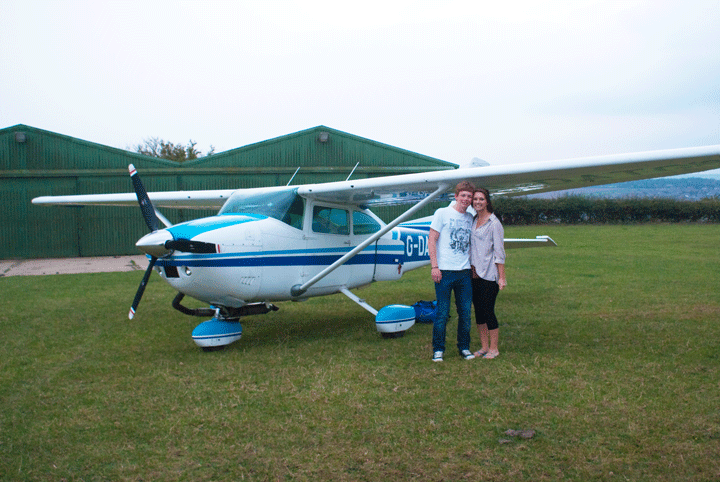 Over the trees, lots of downdraught, clear the trees, almost chop the power, watch the hedge coming up but we're over it by 40ft or so and descending in to the bowl. Big heave as the stall warner blares; keep heaving and we touch once.... then settle and roll out on the rough grass as the cows much contendedly 50 yards away. Amazing.
Over the trees, lots of downdraught, clear the trees, almost chop the power, watch the hedge coming up but we're over it by 40ft or so and descending in to the bowl. Big heave as the stall warner blares; keep heaving and we touch once.... then settle and roll out on the rough grass as the cows much contendedly 50 yards away. Amazing.
It's been raining, so flaps away to get the weight on the wheels, then brake. We're just in the right place and taxy over to the hangar where the enormously-friendly farmer greets us. It looks like we are the furthest-away aircraft ever to visit. And the aircraft has cow pats all over one of the undercarriage sponsons. Lovely.....
It's exactly sunset as we fire up, taxying over the enormously rough grass. Keep the speed low and the yoke back as this is real prop-strike territory: White Waltham, eat your heart out.
At the end turn, power check in place, drop the flaps and roll. After some "fun" at White Waltham a while back I am very careful about not selecting more than 2 stages of flap, but it is looking like on rough ground the flap selector vibrates down slightly in to drag flap setting, which is very dodgy indeed. As we rotate at 60Kts it is reluctant to fly: Ah hah, I know what this is and yes, it's dropped just in to drag flap territory. Come back up an inch and the "hand of God" reappears to lift us out. I'm going to have to watch that on rough ground. White Waltham was good experience after all.
Climb out South East and head for home, climbing to 3,000ft and switching back to East Midlands, who are chatty and offer us a Zone Transit, which I am tempted to accept, but this would prevent me from doing my planned DTY VOR Tracking, so we'll go around instead. They are joshing with the airliner captains as they descend in to the procedure and are obviously bored. As the light fades so do the thermals and the ride becomes very smooth indeed; visibility is excellent tonight and the East Midlands conurbation twinkles as it unfolds beneath us.
It's a good time to practise VOR tracking back to Daventry so turn the GPS round and navigate by VOR, which works beautifully all the way to, and from the beacon at which point we ditch East Midlands and swap back to Oxford Approach. We'll come in "visual" for 19 and shoot the ILS, which after a momentary initial confusion about being above or below the line goes OK.
I am careful not to look out of the window but at the ILS; flying the dot down to 900ft at which point we go visual and there is the runway. Managing to forget to put the landing light on we descend between the lights and do a lovely smooth arrival on the invisible tarmac nowhere near the centre-line before flicking it on (doh!), re-establishing the centre-line and taxying in. Ooh, a Night ILS: there's a first.
The cover is dirty so we'll take it away, wash it and re-waterproof it, and the cow pats need washing away, so 10 minutes with water and some tissues and the aircraft is clean once more.
Sandown 15 Oct 11
We're well in to October now, but the weather has remained fine and surprisingly warm. It's forecast to be horrible over the next few days, so we'll make the best of the nice weather and take our deadshot friend Joel and his Mother Ann down to Sandown for tea and a trip around the Isle of Wight.
 We'll do a little flight planning, so it's out with the map and the green spiral-bound AFE VFR airfield directory. I can remember looking at the map and the book when I was learning, and thinking "I'll never have the confidence to go and actually land at all of these places". Nowadays I just see opportunities, and the book is looking dog-eared (as is the map....).
We'll do a little flight planning, so it's out with the map and the green spiral-bound AFE VFR airfield directory. I can remember looking at the map and the book when I was learning, and thinking "I'll never have the confidence to go and actually land at all of these places". Nowadays I just see opportunities, and the book is looking dog-eared (as is the map....).
We walk out past Oxford Aviation who are having an open day: lots of teenage Air Cadets (ah, the memories!) hanging around the aircraft wanting to be commercial pilots. That was me at 17.....
They look jealously at us as we head for some real aviation: their aviation opportunities at present are restricted to an occasional 30 minute flip in a motor-glider and around that is way too much non-aviation faffing, like expeditions and First Aid courses. No wonder most of them will give up learning to fly before they even get going, and go off to be web designers or media consultants. Just what Britain needs: more media consultants... Come on, RAF, give them weekly flying slots and let them work towards PPLs; that would kick start the aviation industry.
We ask the bowser to fill up the tanks, which leaves us just over MAUW and within CG limits. By the time we take-off we will be at MAUW and we'll be 96lbs below that on landing at Sandown.
We take off in to a sunny, slightly hazy afternoon and climb out Southbound, slip between Abingdon and the Brize Zone and down to Joel's house for a circuit before climbing out and teaching him how to fly it.
He's good, and not afraid of making it do what he wants, which is good. He can fly us down South (and swat wasps in the cockpit) while I radio and navigate. Farnborough Radar is frantic and it's hard to get a word in edgeways but once we get a squawk they are very helpful and spot conflicting traffic almost as soon as we do. With 4 pairs of eyes we get most of them. At 3,500ft we are above virtually all of them, the Odiham MATZ and the layer of haze that stops most dramatically at 3,400ft.
Once overhead Hayling Island we get rid of Farnborough and track towards Sandown, passing overhead the now-quieter Bembridge at 3,000ft before descending into the downwind for 05.
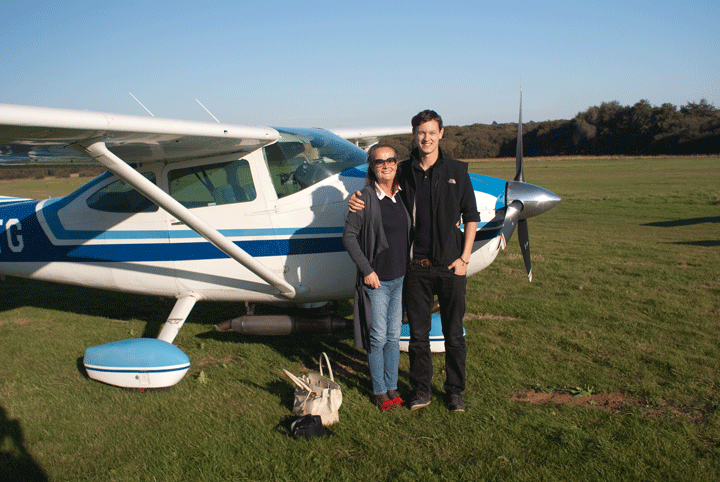 Pre-landing checks, then Turn Base and we're very high, so 2 stages of flap and idle power gets us back on a sensible descent path before the 3rd stage slows us sufficiently to give us a fighting chance at stopping before the taxyway. Get the vertical speed slightly high at the last moment, a very small bounce and we're down and rolling. Flaps go up, brakes go on and we exit neatly for a marshalled park-up. Sandown is really busy today - mainly with microlites but a twin is parked up as well. We appear to be the heaviest single in today, and from the furthest afield.
Pre-landing checks, then Turn Base and we're very high, so 2 stages of flap and idle power gets us back on a sensible descent path before the 3rd stage slows us sufficiently to give us a fighting chance at stopping before the taxyway. Get the vertical speed slightly high at the last moment, a very small bounce and we're down and rolling. Flaps go up, brakes go on and we exit neatly for a marshalled park-up. Sandown is really busy today - mainly with microlites but a twin is parked up as well. We appear to be the heaviest single in today, and from the furthest afield.
I like the Isle of Wight: it just feels that little bit different from mainstream Britain. A tad more relaxed and less frenetic. But a reminder that NIMBYs and Planning idiocies are never far away is on the wall: Sandown was nearly Brown-fielded out of existence a few years back. Only a Court Injunction stopped the idiocy and now Sandown is buzzing....
£12.50 lighter and a cup of tea heavier we fire up and taxy out over the rough grass (they have moles here) before lining-up for departure.
 I'm not going for the full 20° take-off flap detent as we know that on grass it has a tendency to vibrate down further, so we'll use 20° as per the markings on the dashboard, which is a bit further up.
I'm not going for the full 20° take-off flap detent as we know that on grass it has a tendency to vibrate down further, so we'll use 20° as per the markings on the dashboard, which is a bit further up.
We call "rolling" and accelerate down the runway. As we pass 40Kts we start bouncing, which is so annoying as the aircraft can't quite fly at that speed so we get the stall warner chirping. At 55Kts a firm rotate has us airborne and we climb steadily out to 800ft before turning South, cleaning up and passing control over to Ann who will fly us around the Isle of Wight in the evening sun.
The Isle of Wight looks beautiful as we pass over Ventnor then over the South West corner of the island, heading for The Needles, where we turn over The Needles and head for Cowes, where Ann has a flat. Heading North East we pass Portsmouth and head North around the Solent Zone to pick up our track: 350° inbound CPT.
 It's hazy and much quieter at 5.30pm, strobes go ON and Farnborough are more easily accessible now.
It's hazy and much quieter at 5.30pm, strobes go ON and Farnborough are more easily accessible now.
Ann gently pilots us towards CPT at which point we swap from Farnborough to Oxford, get the now-repaired ATIS and cruise-descend from Didcot.
Ann's manoeuvring is causing Joel to feel a little unwell, so I'll take it and join Downwind for 19, taking care not to stray too far North as D129 is Active tonight, turn Base then Final and ease it down on to the seemingly huge (after Sandown) runway before taxying in.
As we put the plane to bed the sun sinks as a great yellow ball. The RAF Cadets have long gone home to dream about real flying without all of the surrounding faff.....
Manchester 19 Oct 11
Anyone visiting the North West will have heard of the infamous Manchester low-level route.
Because there are 2 large commercial airports (Manchester and Liverpool) in close proximity there is a huge chunk of Class A airspace over virtually the entire area between the Pennines to the East and way out in to the Irish Sea to the West.
Legend has it that VFR zone transits through this zone are unobtainable: you either swing wide out in the Irish sea or go over the Pennines. However, in between the airports they do allow a narrow corridor of low-level VFR traffic.
And when they say low-level, they mean low-level.
Maximum altitude within the corridor is 1250ft QNH which means, as the land is not at sea level, around 1100ft of clearance.
Given the standing AIP instruction to remain 1,000ft clear of anything man-made makes accurate height-keeping a necessity.
I know people who refuse to fly this zone because there is no conflict avoidance service available and everyone but everyone is flying at exactly the same height. Today should, however, be OK as the weather is dodgy and it's a weekday.
Lucy needs to go to Manchester for a look at the University's Fashion department and the traffic reports say this is a 4 hour drive in each direction (but around 1 hr by plane).
Oxford is under clear, cold, blue October skies but a weather front is due to come through mid-morning South east from Manchester, so we will aim to fly through it (light showers and rain are forecast) and land in decent weather the other side. We can go over it if necessary.
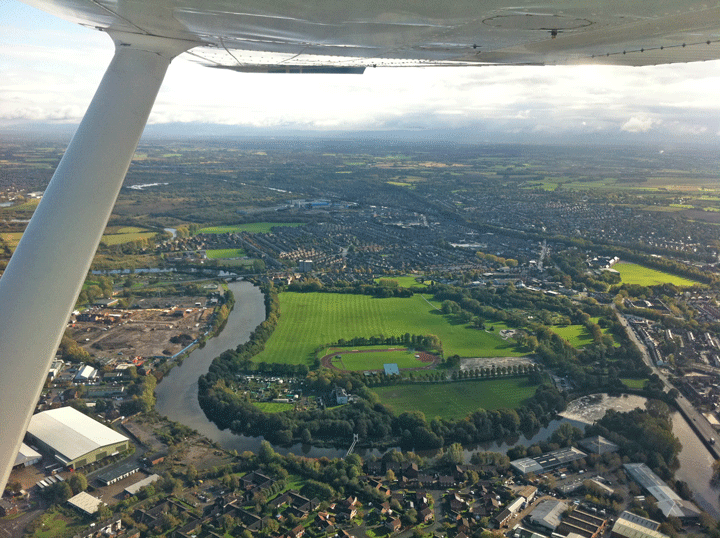
|
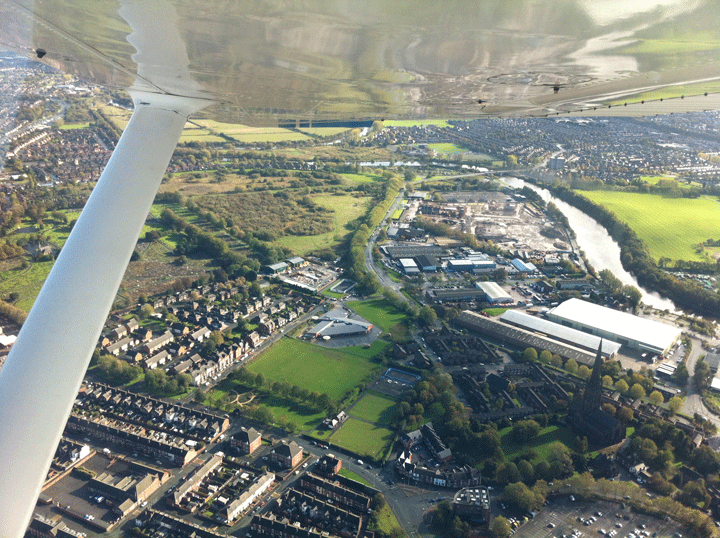
|
|---|---|
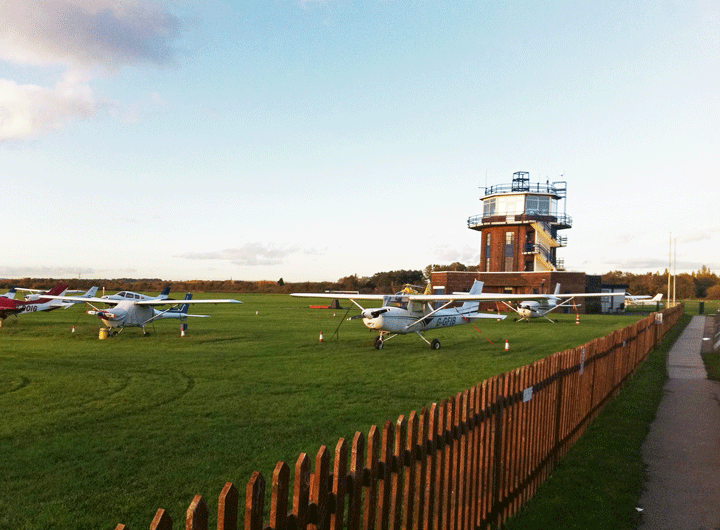
|
We are being driven mad by the close location of the main radio mast to our parking spot, making it all but impossible to hear the Tower over the bleed through from the ATIS (now restored) when requesting start or taxy, so having eventually received start permission I simply taxy forward until we are clear of the interference zone but still invisible to the Tower, then call for taxy. Very naughty, but I can't hear them otherwise!
We are short of fuel but don't want to go MAUW as Barton is relatively short and wet grass, so we'll fill up with around 150L of fuel. However, there appears to be some discrepancy between what the pump is saying and what we have actually put in as the pump says 150L but the receipt says 95L, which is enough but there's not a huge margin. I don't like these "incident pits": mental note to dip the tanks at Manchester and fill up again if necessary.
We take off and climb out NW towards Birmingham, swap to Birmingham Approach for a Basic service, mainly so they know what that squawk running along the edge of their zone is, and drone along on the autopilot at 3,000ft.
Just East of Wolverhampton we swap to Shawbury and ease round the edge of Ternhill MATZ at 3,000ft.
The front is here and we soon fly in to it. It's too high to fly over and anyway we can see through it, so whilst it is a little bumpy and viz is restricted for a while, it is mainly as forecast. Eventually we pop out in to brighter weather - there's sunshine ahead.
Shawbury remind us of the approaching Airway (thanks, Shawbury) and we descend.... and descend.... for ages it seems until we are below normal circuit height, which gives us little room to glide clear and feels awful.
Over Oulton Park race circuit we squawk 7366, which signifies to Manchester Approach that you are listening to them. In the end I have a little chat with them as they are quiet, just to confirm the QNH and they are very friendly and give us a Basic service, so all the rumours are untrue.
To be fair to ATC I've never heard a really unfriendly one (to me anyway), and they do have a lot of conflicting requirements to deal with: the non-radio microlights, us VFR boys and the airliners who pay their bills.
I've heard them tongue lashing others who have made heinous errors, but learning to fly at Oxford in an ATC-heavy environment has, over the years, paid massive dividends with radio.
Today we are possibly the only person in the low-level route as it has been raining hard, so I am not too concerned, but we keep a good look out anyway. Above us (quite surprisingly close) EasyJet Airbuses climb and descend - I can see why this corridor is so restricted.
The ground we are flying over rapidly becomes more built-up and we approach the Manchester Ship canal, our turning point for Barton. Approaching Barton we ask for runway in use which turns out to be 27R with a RH circuit. We can do that: no problem.
Joining downwind we report downwind, do checks and turn base, drop the flaps and turn final. We did the downwind and Base legs a bit tight so we are very high, but a glide approach and deployment of the barn doors gets us back in the cone. Some downdraught over the trees, so a bit of power, then roll it off over the threshold and pull... pull... being wet grass it flatters our arrival so we only hear the wheels spinning up.
We even get a "nicely done, Tango Golf" from the tower.
Wet grass retards, so we need no brakes (not that they would work!), we just exit left and taxy slowly along the muddy, rutted taxyway to the apron for parking. The grass is very wet indeed: they have had a lot of rain today.
It turns out we are the first arrival of the day, and it's 12.00 already. They are quiet. They will shut at sunset tonight, so we need to be back by 5.30pm.
The bus journey in to Manchester is long and slow - we vow to take a taxi on the return journey.
Via some terrible traffic (surprisingly not ameliorated by those wonderful trams they have so expensively installed through the middle of Manchester. Don't get me started on trams....) our taxi manages to deposit us at the front gate at 5.30pm, so first order is out with the ladder and dip the tanks. We have enough to get us back with a 40 minute reserve, and the wind will be behind us, so we won't fill up.
This is less of a reserve than I would prefer, as my designated alternates in the event of Oxford's main runway being closed would be the cross runway 29 (has lights), Enstone (no lights) or Brize Norton (lights, ILS, fire service, arrester hooks, radar, 2 mile runway, coffee machine....) but if the wind changes and we have to divert we might get short. So we'll be careful.
Barton have only had 4 aircraft in and out all day, including us. At £16.80 per plane that doesn't pay anyone's salary......
We start up, taxy, power-check at A3 and proceed once more on to the mud pie that is 27R as they are turning off the office lights. We'll be last out....
There are power pylons in the distance: I want to be *well* above them. 20° flap by the numbers (and no more...); we'll monitor during the run. Brakes off and we soon hit 55Kts, firm rotate and we're climbing rapidly. EFATO contingency is...... over there in that field until we hit 700ft, at which point it becomes a 180° back to the airfield somewhere.
At 1,000ft with positive rate of climb we clean up and head off to the Low Level route once more. Now I'm used to it it doesn't appear quite so dangerous, and is in fact quite enjoyable, like an extended downwind leg.
At Oulton Park we exit the corridor, squawk 7000 and climb. I'm concerned about fuel so we'll cruise climb to 3,000ft and cruise at 23/23 and 115Kts rather than my normal 23½/23½ and 125Kts. I'm also going to try an experiment: the left tank was dry at Barton, so we'll switch to that and see if it runs dry. After 20 minutes I know it's cross-feeding from the right tank; there can't be that much fuel in there. Interesting....
Birmingham Radar are incredibly busy feeding airliners in to the NDB DME approach for runway 33. Can you believe that in 2011 the approach procedure for a large commercial airport actually includes a beacon invented in the 1930s? How primitive are we?
The elephant in the CAA's room is that in practice everyone, from commercial airliners down to microlites, navigates using GPS and has done for 10 years. So why not scrap all the nonsensical VOR and DME procedures and implement GPS procedures? In the USA FAA-verified GPS procedures are in place for virtually all airfields down to tiny private grass strips. We do live in the dark ages....
Eventually we manage to get a word in edgeways and get a Basic Service from Birmingham, but as we have a 40Kt tailwind within 20 minutes we are ready to swap to Oxford, so do so and start our descent.
Now I have recently switched to having the GPS set to "track-up" which is actually easier to use, but you do risk losing situational awareness, which is exactly what happens as I gently veer off-track to the right towards what I think is the runway 19 approach path but which turns out to be the runway 29 approach path. As the picture looks wrong I do a mental Etch-a-Sketch shake and... ah, OK.
So now we're right base for 19, so descend, do the pre-landing checks and turn final, drop down the approach and do a nice, smooth landing.
Someone has parked in our space, so a chat with the tower confirms we are OK for parking on the apron next to the Spitfire school that lives at Oxford. A little too expensive for my budget, but maybe one day......
2011 reflections
We have flown independently of any educating or managing agency for 12 months now, what have we learned?
- Flying what is effectively your own aircraft is a whole different ball game to flying under the auspices of a flying club. There is no one to hold your hand, so you are entirely responsible for your own, and your passengers', safety. As Frederick Forsyth once put it: "ain't nobody here but me....".
Whilst it means you are, in practice, more likely to fly on a given day, the degree of planning to reach the "Go/No Go" decision has to be more rigorous. So I have regularly-reviewed personal minima in terms of crosswinds, cloudbase and rain; both for myself and for passenger flights at start, midpoint and end of flight.
- Just because it's doable for you as a pilot doesn't necessarily mean it's comfortable for your passengers
- On the whole, unless they are potential pilots, passengers prefer the "airliner" experience. So straight and level, autopilot on, as high as possible and preferably above the clouds where it's smoother, all doors shut, lots of heater, plenty of explanation as to what is going-on and try to sound as professional as possible. I've also perfected leaving the pax at Ops with coffee whilst doing the walk-round, then taxying to the apron for the full Pan Am experience.
- No plog ever survives contact with flight (the winds are never as forecast, the pax are late, airfields close or change runways, you use more or less fuel than planned etc etc) especially when you go away for several days.
It's impossible to judge the weather 3 days ahead in any more than a very general way, and the weather for your return trip may be entirely unlike you expected. So be resourceful, adaptable and always try to have a Plan B, even if that is "go home on the train" or "fly home tomorrow".
- Bad weather is not a huge issue provided you can get off the ground and the crosswind at your destination is within limits. Avoid thunderstorms and icing, but aircraft do not mind getting wet!
- Travel over 50 miles and the weather in the UK is guaranteed to be different, maybe dramatically different, from your starting point.
- The weather in SE Wales is always worse than the weather anywhere else. Don't know why.
- When travelling long distances, don't be afraid of Zone Transits in Class D airspace at relatively minor airfields: provided you are travelling at right angles to their runway in use so not liable to conflict with their traffic they will usually be happy to provide you with a Zone Transit right over the top of the field (airliners don't do circuits) and that way they know exactly where you are.
- Don't be scared of big trips: airfields are the same all over the country (and abroad)
- Push the envelope a little bit each time you're out. Go further, ask the military if you can land, be more adventurous with the weather, go out and back different ways, fly at sunset, fly in to grass strips (plan carefully), fly in to big airports, fly abroad!
- Never assume anything: if you're not absolutely clear about something, then ask, and if you're still unsure go and find out for yourself.
- Minimise the faff: do your pre-flight planning and Go/No-Go decision-making at home, go to the field and go flying, put the aircraft to bed and go home.
- A light aircraft makes sense over a car for any road journey over roughly 2 hours, or any journey over water (so 100 miles with traffic meaning an average speed of 50mph). Airliners make sense over a light aircraft for any light aircraft journey over 4 hours (so Southern France or beyond) unless you're very keen. So for example Greece by C182 would be fun but would make no sense. That doesn't mean you don't want to consider it, though, for the experience!
Boeing 777 sim Jan 12
We have a chance to fly the British Airways Boeing 777 simulator at Heathrow tonight (it's quiet, being post-Christmas) and so the 4 of us who fly TG drive up late one evening to the deserted engineering sheds behind the airport wher e the £20 million full-motion hydraulic simulators are to be found.
e the £20 million full-motion hydraulic simulators are to be found.
Despite the massive expense of these simulators they are the preferred method of airline line training and currency for two reasons: their per hour rate is 1%-2% of the cost of running an equivalent airliner, and you can simulate very realistically combinations of system failures it would be extremely dangerous to replicate in the air.
The simulator is a large box on jacks, but once seated at the controls and feeling the first expansion-joint bump of the taxyway this disappears: immersion is total and your senses are convinced you are in an aircraft.
First impressions are that the 777 is surprisingly sprightly in pitch and roll response, that the engines take a l o n g time to spool up but then produce a satisfactory thump in the back, and that the initial climb angle is steep; even steeper than the PA-32.
15° is normal, and whilst it takes a pull to get it to 10° it then tends to run away towards 20°, closing fast on the stall /AoA indicator in the Flight Director, the first time I've seen one of these (which surely should have shown the pilots of the Air France A340 that crashed in the mid-Atlantic that they were doing something wrong?).
We fly around for a while (heavy turbulence at 300ft over Newark, heading for the Statue of Liberty) and it's easy to fly using the Flight Director (a cross between an AH, a DI and an ILS: basically you aim to keep the white dot in the centre of the pink cross and you won't go far wrong: autothrottles attend to any power requirements), but if you try to fly it visually it can become disorientating due to the lack of feel.
Yaw is taken account of using a yaw damper, so you only really need the rudder for runway steering, and the dashboard works on the "dark display" methodology: if no lights are lit everything is OK.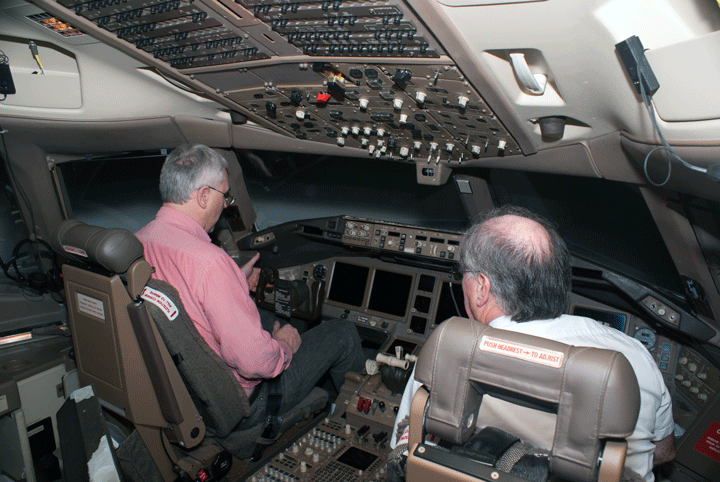
We all find it very intense but no one crashes it; we all do a number of successful ILS approaches to big airfields and whilst our landings may have been heavier than one would expect in TG they were all on the runway and in the right place.
Of course, the question everyone asks is that given the highly unlikely scenario where both pilots are incapacitated but the airliner isn't, and the Stewardess asks if any of the passengers can fly a plane, could the PPL holder in seat 44D actually land a 777 safely?
I reckon, given a modicum of luck, there are sufficient automatics for an Instrument Rated PPL to get the thing on the ground. We were flying it manually, but the autopilot generally does a more efficient job and, if commanded, will actually land the aircraft using the radio altimeter and the ILS. So: a qualified "Yes".
We all thoroughly enjoyed ourselves and will do it again if the opportunity presents itself.
ANR 2012
It's New Year and Pete wants to rattle the water out of his Mooney, warm the engine and de-rust his (and my) piloting skills.
He's doing an FI course, so there are plenty of good tips to be picked up.
Most important for me is the chance to test a prospective purchase: a loaned Lightspeed Zulu ANR headset. My existing Sennheiser HME-100 has served me well, but this represents a serious step up.
ANR, or Automatic Noise Reduction, is one of those clever ideas that we never thought would emerge from the boffindom of the 1980s. It's a clever way of reducing ambient noise levels within headsets whilst allowing important noises through. In the case of aviation headsets, this means radio messages, which you can sometimes struggle to understand above the high noise floor of engine, aircraft ancillaries and airflow.
Instead of simply adding increased insulation and/or clamp pressure to the earpieces, thereby increasing weight and size, a microphone on the outside of each earpiece takes the ambient noise, delays it by exactly half a wavelength and plays it back through the earphone inside the earpiece. This cancels out a huge proportion of the ambient noise, as nobly demonstrated by William Woolard on Tomorrows World a very long time ago (that ages me...).
Clearly a case of "more is less".
Obviously noise comes in a mix of different frequencies, so a fixed delay won't work: presumably they have a sliding delay depending upon frequency (and thus wavelength).
As Pete starts the Mooney's engine I deliberately keep the ANR turned off (to simulate battery failure) and the noise level through the light, low clamp pressure earcups is about equivalent to my Sennheisers.
So far so good.
Then I turn on the ANR and an uncanny silence descends: I must be going deaf after all? Then Pete speaks and the strength of his audio above the noise floor is such that I have to turn the volume way down.
Apart from a bass rumble, that I suspect I am feeling rather than hearing, the engine sounds a long way away indeed. The only issue seems to be strange transients occasionally on movement of the jaw, either through momentary displacement of the earcup seal, or opening of the Eustachian tube allowing unfiltered noise up from the back of the nasal passages.
The difference between ANR ON and OFF is just massive: it really does work, and I can hear Pete and ATC a lot more clearly. The claims made that you can't hear the engine properly are simply untrue: in many ways you can hear the engine more clearly.
What I haven't appreciated until now is the fatiguing effect of high noise levels: with this ANR unit an hour's flight is not exhausting in the same way it is without. It's hard to describe the way in which the noise fatigues but it certainly does: after an hour's flight I feel fresher than I normally do.
I'm sold on the idea of ANR and on the headphones: anyone want a pair of HME-100s?
One thing has come up in discussion recently with Steve: the issue of checking the CO detector.
This is simply not in my normal list of things to check on a regular basis, and whilst the detector is checked at the 50hr service that's not really the point of the thing, which is to check on a minute-by minute basis that poisonous fumes are not being released from a leaky exhaust manifold in to the cabin.
The effects of CO poisoning are insidious: you can't see or smell it but in sufficient concentrations it can affect decision making and eventually cause unconsciousness.
So I think we should be FREDAC-ing every 15 mins or so (Fuel, Radio, Engine, DI, Altimeter, CO).
We fly out over Blenheim palace, then Gloucester, then I turn us North (I love the Mooney, it's all-pushrod and there's no wooliness about the controls whatsoever) for Evesham. A large hammerhead - shaped freezing rain cloud is lurking South West of Oxford but passes safely. We're not FIKI-equipped and IR or no IR Pete's not going in there and neither am I.
We finally recover back to Oxford from Banbury and I shoot the ILS from the right seat, which is interesting but stable despite a 20Kt crosswind until the wind veers at 1,000ft and I drift 1½ dots off to the right. As I am correcting Pete calls 800ft and we go visual, which goes to show that 1½ dots deviation is quite easily recoverable from: a quick left turn and there's plenty of time to "get it in from here". And we have 2 reds and 2 whites so the height was just peachy.....
Why can't I do ILSes? 10 Jan 12
My IR(R) needs revalidating before April or I lose it permanently (some daft EASA wonks in Europe, jealous of our ability to fly in clouds without 14 exams and the knowledge of exactly what the weather is like in the Inter-Tropical Convergence Zone and detailed knowledge of how a jet engine works, has decided We Must Not Be Allowed To Fly On Cloudy Days - a likely story in the UK).
Some rust removal is called for before I do my revalidation (plus I haven't flown for 2½ months), so I borrow Pete and we plan a complex and demanding All-IFR flight to Coventry for an ILS, a missed approach and an ILS back in to Oxford.
I know something will go wrong, me being rusty in all sorts of different ways, I just don't know what will go wrong....
We do a full pre-IFR A Check, then with foggles on we take-off and I turn on to my intercept course for a 315° Moreton Departure without cross-checking DI and Compass (mistake #1) so we end up drifting back over the airfield and in to the Beacon outbound procedure area, starting to impinge upon a business jet's approach comfort zone, so Pete vectors me back towards where I should be, we get the DI showing what the compass is showing and it all starts going better once more.
Apart from the old "blowing through the VOR track whilst concentrating on getting the NDB tracking right" trick things get better, except that my scan is all wrong and I'm expending way too much mental energy keeping straight and level. Rust!
We make Daventry without further ado and the vectors on to the ILS go just peachy, then as I start down the ILS I just can't seem to get it nailed: the descent rate is is OK but I can't seem to keep the bloody localiser. We drift left and right in larger arcs until we both know it's a mess and we throw it away at 1,500ft. I never even see the runway. We're in and out of bumpy cloud and I don't know whether Pete even sees it either.
The Missed Approach procedure is complicated by the fact that we have mistuned the radio so we are not getting anything from Coventry Tower, and the close proximity of the Birmingham Zone prevents us from climbing above 1,500ft, but we do it OK and re-establish on the correct DTY radial before sorting out the radio, departing Coventry and calming down as we swap back to Oxford, then hunt and establish the Honiley 151° radial for an ILS back.
I then miss the Localiser and have to swing back through to get established, which upsets my pre-landing checks and desire to get stabilised on 100Kts with 1 stage of flap before hitting the glideslope. It does come together eventually but then I'm swinging left and right of the Localiser again: I can do this normally, it is so frustrating.
At 1,000ft and at half-scale deflection we go visual: we're quite a long way off to one side of the runway. Pete suggests nicely that we may want to go Missed but actually I reckon we can get it on from here: 19 is very long for a determined C182 driver.
With some immediate and judicious juggling of throttle and flaps we get back over the runway at a sensible speed and a huge descent rate, flare nicely half way down and we're on really smoothly and gently.
"Oh, OK, maybe we didn't need to go Missed after all.... I wouldn't have got the Mooney in from there".
So I can do the easy stuff, just not the bloody ILS.
After lunch (and I feel so much less exhausted with this new ANR headset; wish I'd changed years ago) we go again: this time for some vectoring, plus some partial panel and unusual attitudes work.
After this morning's rust removal everything goes a great deal more swimmingly: my scan has got better and the whole thing feels less frenetic. Our Moreton departure works better now I am cross-checking the DI against the compass and I can hold height and heading with less mental effort (and less death grip on the yoke).
We do some vectoring, which is easy, and then some timed turns (helped by us now having a decent timer on the transponder box), then it's time for Recovery From Unusual Attitudes. It's weird that I have always found these the least scary part of IFR aviation, and whether full or partial panel have always been able to recover easily, so we whip through the rollercoaster ride and move on.
Now I've done IMC for a number of years the scariness is retreating: I could never go back to being "just a VFR pilot": clouds have lost their dread and I quite enjoy the challenge of relying on the instruments. OK, I'm not the worst best instrument pilot, largely because I don't fly enough IFR stuff, but I am confident I could, with all cylinders firing, do an Instrument let down for real. My Holds may be messy and my bumpy cloud work a bit inaccurate but it's just practise.
Local 11 Feb 12
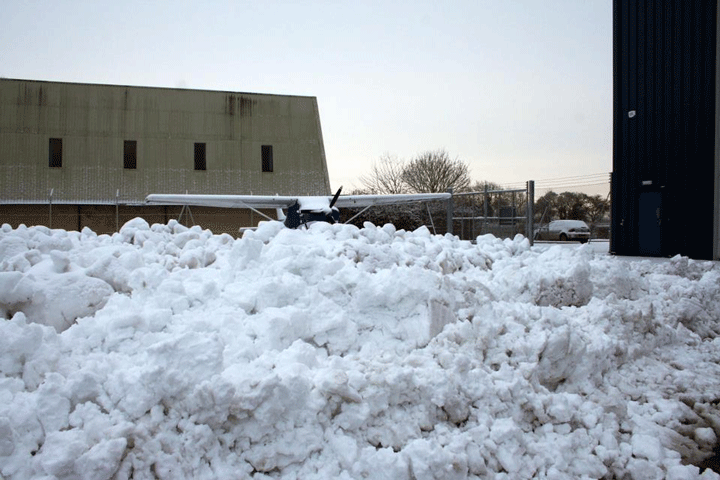 The February snow has finally relented and a bright blue sunny but freezing cold Saturday allows us to finalise the IMC rust removal.... if we can get the aircraft out and going. I need to get my ILS's better.
The February snow has finally relented and a bright blue sunny but freezing cold Saturday allows us to finalise the IMC rust removal.... if we can get the aircraft out and going. I need to get my ILS's better.
At first glance the aircraft appears to be parked behind a wall of compacted snow generated by the snow-clearance guys, but they have left us a way out.
However, the aircraft has been covered in snow which has melted and re-frozen, so the wings and tail surfaces are covered in solid, compacted, icy snow several inches thick.
 We move the aircraft round in to the sun, but even with its help it takes Pete and I two hours to remove with a broom, scrapers and de-icer fluid, mindful of the fact that even sandpaper-textured ice stuck to the lift-generating surfaces can reduce lift by up to 30%, increase drag by 20-30% and, most importantly, raise the stall speed by 10Kts.
We move the aircraft round in to the sun, but even with its help it takes Pete and I two hours to remove with a broom, scrapers and de-icer fluid, mindful of the fact that even sandpaper-textured ice stuck to the lift-generating surfaces can reduce lift by up to 30%, increase drag by 20-30% and, most importantly, raise the stall speed by 10Kts.
We also take pains to reduce any ice from control surfaces and hinges, then lower the flaps and work the ailerons and elevators to ensure the control runs are free and clear. Freezing level is "000-005" so anything left is going to freeze and could jam the controls if we're not careful.
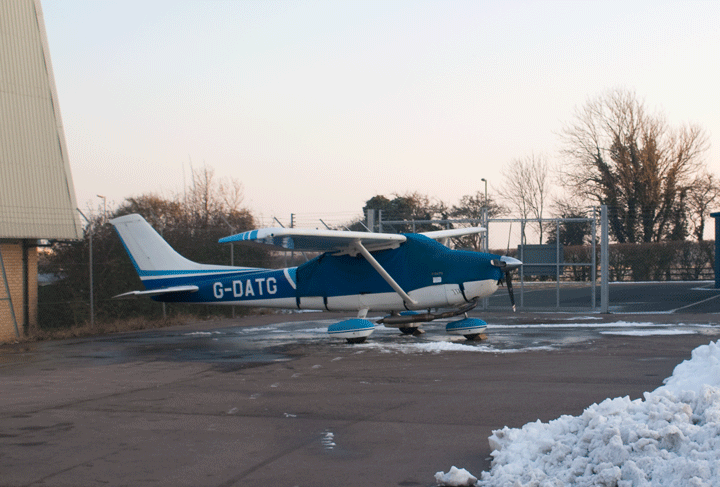 This is the first time I've ever had to do this and it's a learning process, like much in aviation. Professional pilots and Instructors have long ago got this under their belts; it's handy to have a Mentor to learn more about the art of running an aircraft for yourself as opposed to just flying with a club. I have certainly learned more in the last 52 hours and calendar year than I learned in the previous 2 or 3 years.
This is the first time I've ever had to do this and it's a learning process, like much in aviation. Professional pilots and Instructors have long ago got this under their belts; it's handy to have a Mentor to learn more about the art of running an aircraft for yourself as opposed to just flying with a club. I have certainly learned more in the last 52 hours and calendar year than I learned in the previous 2 or 3 years.
After a spot of lunch and some planning (I now know the little chevrons against runways on the 1:500,000 chart means "Instrument approach available" not "ILS available") we try to start the poor, frozen beast, and whilst it kicks and runs feebly a few times the battery is too weak and soon it won't even turn the prop.
I learn something more about the Cessna 182: where the 12V ground charge socket is (just under the oil inspection hatch on the left side of the engine: needs a flathead screwdriver to undo). Hats off to the Fire Service guys who have a neat electric charger and have us going in a trice (to be fair, they have to start everyone else as well...).
And finally we're taxying out ready to go. We leave the cowl flaps only half open to accelerate warming the engine and by the time we have done our power checks the oil temperature is in the green.
We'll re-run the last session with the emphasis on the ILSes: one at Coventry, and a second one on our return to Oxford.
Off East to track the 070° radial to the Westcott NDB (check the DI matches the compass), which as the air is clear works perfectly except one instance of me reading the compass backwards and adjusting the DI by 10° in the wrong direction (that becomes quickly obvious). Get a good cut over WCO and turn North to pick up the 348° radial to the Daventry beacon. I manage to blow through the radial and as we're getting close have to do a radical 60° cut to recover the situation, but that's OK, and swap to Coventry Approach who vector us in to their ILS Localiser. On the descent towards the Localiser we slow down to 100Kts, stabilise and trim the aircraft to reduce workload. This works better.
Turning to capture the Localiser we are VMC on top of the haze but as we descend in to sun and haze it becomes obvious that no foggles are required: this is IMC for real. I'm not looking out at all, but the haze is so bad Pete can't even see the runway at 1,000ft. It's only at 800ft and Decision Height do we both look out and see the runway vaguely through the haze, enough to land off if necessary (and satisfyingly on track).
We go missed and climb out, climbing through the Missed Approach procedure (complex here, as you are below Birmingham International's Airspace and mustn't climb above 1499ft) back towards Daventry and can relax: it's a beautiful day and the country is covered in a flat white layer of haze around 2,000ft thick: no day for visual navigation or landings. In the distance we can see a lump in the haze that can only be Didcot power station.
We pick up the Honiley 151° radial and switch back to Oxford, then capture the Localiser and attain the glideslope. This feels better: get the aircraft slowed down and trimmed stable in to the landing configuration first, then get on the ILS. Concentrating hard on the ILS we drop down the approach and like Coventry the runway simply doesn't appear until virtually Decision Height. We go visual, drop flaps and flare on to the runway centreline.
Despite this being a nominally VFR, if a little cold, day this landing would simply would not have been possible visually: I was head down on the ILS but the haze was so thick Pete didn't see the runway until we both looked out at Decision Height: real IMC on a sunny day.
We pop TG to bed with well-charged battery, wheel chocks and dried-out-on-the-fence-in-the-sun cover, double-check "Mags off, key out, Master off, brakes on, fuel off, lock door", recover broom and de-icer spray and go home.
A long day for 1 hour's flying....
IR(R) Revalidation 3 Mar 12
After a long delay due to examiner non-availability and some misty weather an appropriate Saturday appears and I arrive at Oxford in the pouring rain. This does not look promising: even my examiner thinks I've cancelled.
I chant the pilots' chant: "but it's forecast to clear....".
Doesn't look too much like it from here, although my first rule of "can I fly today?" is "look up at the clouds, if you can see uniform grey it's below 1,000ft and not flyable. If you can see features in the undersides of the clouds it's above 1,000ft and may be flyable". By this rule, features are appearing, so it's lifting. If it gets to 780ft and is above freezing to the tops and does not contain CBs, then it's IMC-legal.
They've moved us to front and centre of the apron, so we're very visible from the Tower. I think I preferred our little hideaway but this is less walking, it must be said.
Strip off the soaking cover, preflight and go back in to Ops to await my examiner. For once, the weather does more or less what it's forecast to do, and it becomes IMC-legal as we prepare.
Starting-up and taking-off, we climb to 3,000ft through the clouds. Once at cruise height and satisfied I can hold a height and heading in the murk he masks the DI and AH and we fly partial panel for a while, doing timed turns. Glad I did the de-rust: these actually work out remarkably well, despite me being a bit fumble-fingered with the timer on the transponder, and so we do some climbing turns and descents through the sometimes bumpy clouds.
Next he vectors me in for the ILS, so we slow the aircraft down, do pre-landing checks and establish on the Localiser for 19. My preflight guess at the wind-corrected heading to steer to retain the Localiser turns out to be very close and only 5° corrections either way are needed.
We slide in under the glideslope and we're almost there when another aircraft comes up behind us and we have to do an orbit for spacing, which gets a bit messy.
But part of this exam is not to panic, to be flexible, not to lose situational awareness and to get things back together again, so once the orbit is complete I re-construct the approach, re-establish the localiser and once more start to slide down the glideslope, trying for less than 1 blob error in all directions.
We have a large map and a cushion over the windscreen so I have no idea if we are in Oxfordshire or Cornwall, but at 780ft I declare visual, the obstruction is removed and there is runway 19. No need to touch anything, we just slide down towards it and flare.
Despite the gusty crosswind I am absolutely determined to give him the decent landing I should have given him on my PPL Skills test 5 years ago, and we land flapless with barely a quiver (just not on the bloody centreline; that's a work in progress), roll out and park.
He's happy, which means I'm ecstatic: I'm now IMC-legal for 2 years and a month and I've beaten EASA's new pilot licensing rules by a month or so.
What I do know is that I will use the IMC Rating in anger much more in the next 2 years than I have used it in the preceding 3. In a way, the increased number of hours and experience I have and our rust removal sessions have resolved many of the issues I had surrounding it.
I also discover the portable radio that's always been in the glove box is a transmitter as well as a receiver (and a pseudo-VOR), so my "total electrical failure" procedure can be amended to "use portable radio for calls", not "use mobile phone for calls".
It never ceases to amaze me just how well this aircraft is equipped.
Bembridge Mar 12
One of my clients has a house on the Isle of Wight and needs assistance with the wireless I installed so on a cloudy, gloomy day we meet up, hop in his plane and take off.
Bembridge is 25 minutes away and we climb up through the gloom until at 4,000ft we break free in to the beautiful spring sunshine.
The fluffy mat of clouds spreads as far as the eye can see in all directions.
It's just us up here, as good an excuse for an IMC as I can see. TCAS shows others grinding along just under the cloudbase: gloomy, bumpy stuff.
20 minutes later we drop back through the mat in to the gloom and he sets up for a low wind-check pass for 30 at Bembridge, cranks it round for the approach and scares a couple of cars passing the end of the runway by coming in very low, putting the wheels on the threshold (nice landing) and we rumble to a halt.
A couple of hours later, fresh IoW crab in hand, we fire up and take off again, accelerating into the murk mid-Solent and emerging once more in to the sunny upstairs for the run home.
The cloudbase at Oxford is below MSA so we will recover on the 19 ILS Procedure - but they're busy and need us to Hold. It's interesting to watch someone with many thousands of hours experience doing this. We agree a WCA and an outbound leg time and fly it, first at 4,500ft above the clouds, then at 3,500ft in the clouds, watching the TCAS showing the aircraft 1,000ft below us roughly paralleling us around the racetrack. As good situational awareness in a procedural stack as you'll ever get. Eventually we are released outbound and go visual at 2,300ft as we turn for the Localiser and I work as Safety pilot for a heads down ILS followed by a smooth landing. Good experience.
Local 19 Mar 12
Nessa's Aunt Nell would like a local flight to familiarise herself with the whole light aircraft thing before we take her to Scotland, so on a beautiful spring evening we book out and fire up. It's 5.45pm by the time we take off and the thermals have settled, the winds have dropped and the air is like silk.
We tour over central Oxford, watching the University lawns and gardens, then follow the river down to Abingdon. The light is so much more interesting at this time of day, as well as the smooth air. Across the inactive airfield and visit the house for a low pass followed by a low pass at a friend's house in Marcham before climbing up and away back towards Didcot, then on to Ickford for a promised low pass there and a climb out back in to the sunset.
We have a Seneca behind us for a left base join and stabilise on the approach, trim for 80Kts, turn Final at 1,000ft and float down, a few joggles as we cross the road in front of the threshold, then we're over the runway and settling. Float on, keep the nosewheel up as long as possible and roll out, taxy in and park.
I manage to get it right this time and don't have to heave the aircraft around with the towing bar as I did before....
Nell says I make it look easy. Sometimes, of course, it is easy!
Wellesbourne 31 Mar 12
I'm off to France tomorrow for lunch, so the aircraft needs a little fuel and maybe some exercise. Flying one-up is dull, so I borrow Ann who is finishing up her PPL and we opt to zip up to Wellesbourne for tea. We had planned to go to Membury, but no one answers the phone, so Wellesbourne it is.
It is murky and by the time we get going it's 4.00. Judging by the radio everyone has either gone home or never come out at all. The radio is dead quiet apart from us. Where is everyone?
I have never used 36 at Wellesbourne, so the approach feels weird: you come in over a quite considerable hill and, like Shoreham runway 20 you need to get what feels like very low over the high ground to not be trying to force the aircraft on to the ground half way down the runway. I do a half-reasonable effort with full flaps and taxy in.
Visiting the control tower to book in is interesting: apparently because I've flown in from Oxford I'm "posh" so the landing fee is "£167+VAT please, my good man?".
"Nah mate, I'm from Sarfend, innit bro...?".
I can be "down wiv da kids"; that raises a laugh and reduces the landing fee to a more sensible figure. Much jocularity in the Tower.... We can't take this Aviation thing too seriously!
After a darned good piece of cake and some tea we line up to take-off again and this time I'll do a short field take-off: flaps to 20° as measured on the panel, not to the stop (I find this more accurate) then full beans, rotate at 60Kts and wheeeeee... it's helicopter time.

We do the required noise-abatement turn to 030° and climb back in to the circuit, then once we are assured of a positive rate of climb and trimmed for 80Kts we lose the flaps in stages and climb to 1500ft, heading out over Stratford upon Avon where we do a couple of orbits for photos.
Home is 20 minutes away so Ann flies us back and we cruise-descend for a crosswind join for 01. It's interesting watching her struggle with the mental picture of the circuit: I found the CAA-approved standard overhead join picture very helpful when learning and if in doubt I draw the circuit on the AFE book diagram: messy but helpful.
I am analysing my approaches at present: the old saying that "good landings come from good approaches" is very true, and whilst it is also true that bad landings come from good approaches (!), good landings rarely come from bad approaches, so I've got a bit "Zen" about approaches. Plus passengers like a smooth consistent approach, it's vital in IMC and reduces stress all round.
I would add: "a good approach is where you can fly down to the last 100ft hands off". You shouldn't, but it's a measure of whether you have the aircraft correctly trimmed, so at some point on the approach I usually go hands off for a second to check the trim. Also, I try to give a bit of extra back trim at about 100ft which reduces the flare loading: there are some strong springs back there in the tail.
So I've concluded my approaches are a bit high and am concentrating on knocking 200ft off the height I turn Final at for a more relaxed Final. That said, you could argue a high approach is more of an engine-out insurance. The argument begins here....
We taxy to the pumps, pump in plenty of AvGas and leave the aircraft with no cover and no tie-downs: I'll be using it in 12 hours.
Shoreham 3 Apr 12
Two days later, and somewhat unexpectedly, I need to go to Shoreham to visit a client. This is becoming a milk run and familiarity breeds contempt so we need to be wary. The old story about aviation not being inherently dangerous but very unforgiving of mistakes comes to mind.
Today we have clouds at 3,000-3,500ft so will need to potter through the occasional one, which will be good practice. We will navigate down by VOR to CPT, GWD then on to Shoreham NDB.
It's a bit bumpy in the odd cloud as normal but smoother as we approach the coast. It's going to rain later so the pressure is dropping.
Between VORs I get a chance to ogle road layouts. I used to look forward to Geography lessons at school just to do map reading. I have always loved UK Ordnance Survey maps, and know of no other country that is so assiduously and bautifully mapped as the UK. Roads and railways have a beauty when observed from above by map or aerial photography they lose when observed from the driver's or rail passenger's perspective. This, for example, is Basingstoke.
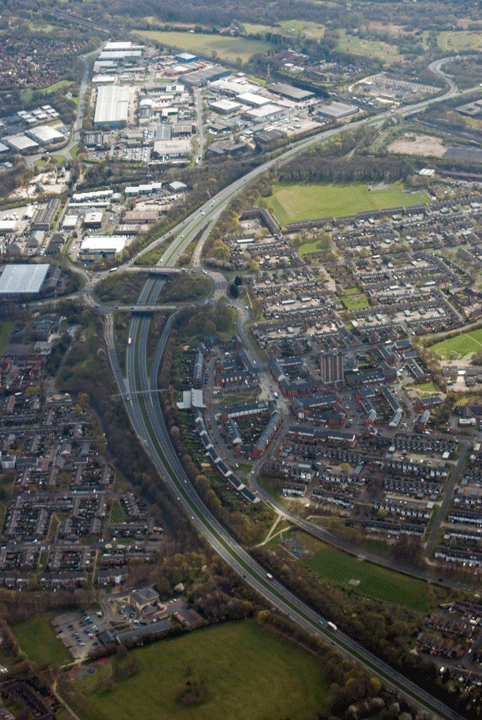
Turning East at Goodwood I check in with Shoreham, who tell me Shoreham now requires landing permission (PPR). This is news to me, but apparently it has been NOTAM'd. My SkyDemon flight planning tool manages not to include this information which just goes to prove I should have done a NATS narrow route brief prior to flight... tut tut.
Flight planning has been revolutionised by the coming of the computer, cheap GPS units and the Internet. When I started flying, flight plans needed faxing, weather info was "watch the evening news" and plogging was done on paper with time and distance. Like the driving test (who actually drives with two hands on the wheel all the time? This is a pre-power steering anachronism from when the wheel could kick back and brute force was required to steer, especially at low speeds) the PPL syllabus is littered with anachronisms like learning VFR navigation with whizz-wheel and stopwatch. I know of no pilot who uses this method in anger now: they all use VORs/NDBs or, mainly, GPS. It's more accurate and easier.
Even the CAA have subsidised the Aware box to reduce controlled airspace busts.
I know of one Instructor who thinks GPS units are the work of the Devil because it encourages laziness, and I can see her point, but in practice Time/Distance measurement alone, like NDBs, is simply inaccurate: the winds are never as forecast, track and time errors creep in and you could be inside that Control Zone even though your plog says you're outside.
That's not to say Situational Awareness is not paramount: anyone who swans around just following a line on a GPS is asking for trouble. VFR you always need to do gross Nav checks with towns/railway lines/motorway junctions, and IFR you need to be up to speed with VORs, DMEs and NDBs as well as your GPS. But the sooner the PPL syllabus includes using GPS the better. At least they don't make you keep both hands on the yoke!
VFR nav by feature-crawling almost works in the UK but in France the distances are greater, the towns fewer and more homogeneous and it simply fails. So get used to VORs and GPS.
Descending, I join crosswind LH for 20, descend low over the hill above the Adur valley and sink gently on to the tarmac for a satisfyingly smooth arrival. It's warmer and sunnier in Shoreham!
Late afternoon, and I line up for 20. As this is a relatively short runway I'll do a short field take off with 20° flap and noise-abate at 500ft still over the runway, which should be more pleasant to the local residents.
We have a gusty crosswind which I reckon is 15-20Kts and as we accelerate the aircraft surges momentarily. It feels like we had a slap in the back, or the flaps haven't finished going down, or the engine encountered something it didn't like for a moment. I just don't know, but it's disconcerting and I'm ready to abort at the first sign of a repeat, but everything proceeds smoothly and at 60Kts we rotate and climb out steeply, mentally identifying fields for a landing if it all goes quiet. We cross the end of the runway at 500ft so we throttle back and turn along the beach (that's landable), climbing away until I breathe again at 1500ft and pop the flaps away, then steer for the GWD VOR.
The promised showers have arrived and before long I am in one which is a bit turbulent for a while.
Turning at GWD we head North West, descending to stay out of the turbulent rainshower clouds, which then requires an Odiham MATZ transit before swapping back to Oxford, a downwind join for a wet 19 and taxy in.
Turweston 11 May 12
Oxford, like many airfields, has an ATIS service: a semi-automated weather briefing radio frequency that is a looping 30 second announcement of runway direction, wind, clouds, rain etc. It's available to all and sundry on 136.22MHz but the transmitter is pointed at the sky as its intended audience is aircraft, so reception is only good within a funnel where the pointy end is at the airfield, thus not as good on the ground.
As I live a good few miles from the airfield I need to have a big FM aerial mounted vertically (aviation FM radio uses vertical polarisation) on the side of the house so I can check the weather before going flying.
Strictly I should have lopped a bit off the end of each of the aerial cross poles to compensate for the increased frequency over the domestic FM signal it was intended for (98-108MHz) but in practice it works perfectly hooked up to a cheap airband radio.
Today the ATIS includes a "Strong Wind Warning".
Received wisdom has it that this means "don't go flying". But actually this isn't true: careful perusal of the wind direction and you and your aircraft's personal minima may mean that it's flyable, albeit a little bumpy.
The wind today is 29017G23 so we will have gusts of 23 Knots. Oxford has a 29 runway and Turweston is 27 so the maximum crosswind component at Oxford is 0Kts and at Turweston ¼x23Kts or 6Kts. So that's a "Go", provided Oxford are happy for us to use runway 29 (the alternative of using runway 19 would mean a) a slight tailwind and b) 100% of a 23Kt crosswind component).
The maximum demonstrated crosswind for a C182 is 15Kts and I've landed it in 20Kts but gusting crosswinds are horrible so we won't go there today.
The aircraft hasn't flown for a month because the weather has been just so awful, which means a sluggish starter (but it does actually start OK first go) and the AH takes a very long time to become "erect" as they call it, which indicates a dodgy vacuum pump, partially blocked pipe or decaying AH.
 We taxy out and request runway 29: taxying straight is hard with a huge crosswind, it's not just me drunk again....
We taxy out and request runway 29: taxying straight is hard with a huge crosswind, it's not just me drunk again....
We hold for power-checks at the runway 29 holding point then enter the Active rolling for what turns out to be an extremely short take-off roll: we are off 100m before the 19 intersection which comes up at 350m. So that's 250m flapless with 3 up and nearly full tanks: not bad.
I'll keep the nose down, trading height for speed as I know it's choppy and at about 300ft we hit some strong windshear: real stop-to-stop yoke movements with the stall warner cheeping intermittently.
Ah, I've done this before, and it's nothing the aircraft and I can't cope with: the stall warner is a bit over-active in gusty conditions and it is in fact nothing to worry about, it calms down as we climb through 800ft and we climb out North, avoiding D129 and heading for Brackley.
Willie is doing the radio for me, which is very relaxing as I only have to go where he points me and monitor the aircraft: I do like this multi-crew experience.

Turweston have an oversized, 1300ft circuit to the North of the airfield and we go what seems like a very long way North of the field before descending to 1300ft and 100Kts, get blown along the downwind leg then have to slow for traffic landing on the runway ahead.
Whilst it looks OK to me, Willie reckons we're low. Well, actually the land slopes downwards to the threshold here so you need to be a bit low, but I have let it decay a bit much, so a bit of power to stabilise and we float down through the windshear, keeping 80Kts for controllability, and as usual it calms down as we approach the threshold, so flare and hold...... hold......, kick off the crab a little too late and we touch down still slightly offset, but under the circumstances not a bad arrival.
We all use GPS for navigation, but our various GPS units (Garmin 196 and 296) are what they call "Uncertified": in other words you may not legally use them for navigating published IFR GPS (for some reason they call them RNAV) approaches.
This is for several actually very good reasons: they aren't physically attached to the aircraft so could well fall off the coaming during a bumpy approach, which could be a little disconcerting to say the least; they don't actually have the published approaches loaded on to them (you could do a DIY job, but would you bet your life you had done it right?); they don't have RAIM (a self-check diagnostics system for GPS kit) and they don't offer vertical guidance in a useable fashion (so they don't drive a VOR/CDI gauge you can follow down the approach). There are other more technical reasons but these are the reasons that matter.
 For real-world GPS approaches (rare in the UK, ubiquitous in the US, officially unsuable for us mere mortals in Europe) you have to have built-in "Certified" GPS kit that offers all of the above. This is, inevitably in aviation where paperwork, needless triplication of regulatory regimes and the common misbelief that all pilots are wealthy and IFR pilots massively wealthy, more expensive....
For real-world GPS approaches (rare in the UK, ubiquitous in the US, officially unsuable for us mere mortals in Europe) you have to have built-in "Certified" GPS kit that offers all of the above. This is, inevitably in aviation where paperwork, needless triplication of regulatory regimes and the common misbelief that all pilots are wealthy and IFR pilots massively wealthy, more expensive....
Garmin are the kings of the GPS navigation world. 15 years ago, while other avionics manufacturers desperately tried to catch up, Garmin simply took over the avionics world. Their integrated 430 and 530 Nav/Comm suites truly revolutionised aviation navigation, especially IFR "in cloud" navigation, where they allow you to see where you really are, not where you think you are. Given the availability of this kit, quite why even commercial aviation is still using NDB-derived published approaches eludes me.
The irony is that Oxford, because it trains commercial pilots who may be asked to work in places like Africa where NDBs are common, is likely to be one of the last airfields in the UK to dispose of its NDB.
But Oxford is getting radar in the next few months and we are likely to see a shake-up in the approaches available as a result; the likelihood is that some sort of RNAV approach is in the offing and we need to respond to that change. Hence our desire to look at a Cessna 177 (think "172 with retractable undercarriage and a slightly bigger engine") that has a Garmin 530W and slaved Sandell EHSI.
The 530W is awesome (see the review) and the Sandell is an electronic DI-replacement that looks like a normal round gauge, but at the touch of a button transforms itself in to a GPS-derived HSI (I dreamed of an HSI when I was doing my IMC), CDI or various other displays. It has the disadvantage of being not very visible from the right hand seat, which could theoretically be an issue, but it's not an AH so I'm not sure it's a show-stopper.
But the cost installed is liable to around £12,000 (phew!). For what is, in essence, a satellite radio with the same innards as my £700 Garmin 296. Time to start saving, I think....
The IMC course includes no RNAV instruction whatsoever, so we will have to learn how to do this ourselves. Should be fun!
Willie flies us home again and I learn something new: apparently when taxying with a tailwind, which we must do to backtrack Turweston's runway, you should keep the yoke fully-forward. Here's why.
Returning to runway 29 at Oxford the view is beautiful: as a pilot it's really nice to sit in the back occasionally (the back of a C182 is extremely comfortable) and enjoy the view.
Oakley 27 May 12
Our previous house was close to Oakley airfield: this is an abandoned ex-RAF airfield with a pair of huge concrete runways that have been allowed to deteriorate. On closer inspection the actual concrete is in amazing condition: it's a pity about the joints which are weed-infested.
Despite rumours to the contrary the airfield is in fact home to an enterprising microlight club, based in the huge Intervention grain store at the Western end of runway 11/29. This is where John keeps his Tecnam. I would visit, but 100m of cleared runway simply isn't anything like enough for a C182.
They hold an Annual Open Day and this year they have cleared more runway using a length of rail pulled behind a tractor. John has invited me and I am inclined to visit. If I do, I suspect I will be the only Group A (non-microlight) aircraft there, so I may use the callsign "Golf Tango Golf Heavy"......
It is wise in these situations to inspect the arrangements so on a surprisingly cold May afternoon we take the car up on to the field and walk the runway, finding that runway 02/20 is 250m plus a good 125m overrun at either end, and 11/29 is 450m. OK, we can do this.
It's a beautiful warm Sunday after all the awful May weather we've had, and I pre-flight and attempt to start. The battery, however, has other ideas: I suspect we need a new one as it only just has enough oomph to turn the engine over just enough to start it, after having been left only a few days. However, start it does and after a cautious circuit at Oxford to ensure I can remember exactly how to spot land I head off the 12 miles or so to Oakley.
The frequency is busy and I'm on a left base for 02: another aircraft is right base, so I'll orbit for spacing, then head down. It looks short....
The PoH says it's OK and mentally I've got 500m so I can stop panicking about running out of runway. I approach over the heads of the spectators with a brisk 8Kt crosswind from the East, flare on the 02 numbers with stall warner whistling, and touch. The concrete is surprisingly smooth and with little braking we're down to taxy speed before the opposite numbers. Turn round to park on the other side of the runway, shut down, and the Marshall says "you didn't use much runway....". Well, there's a compliment....

|
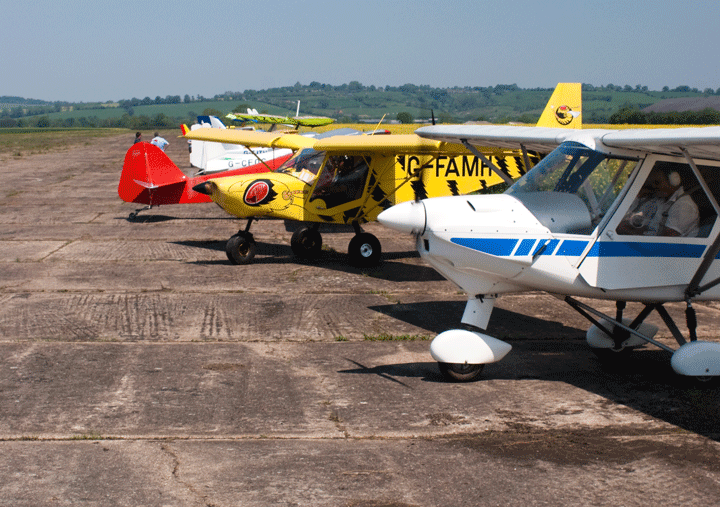
|
|---|---|
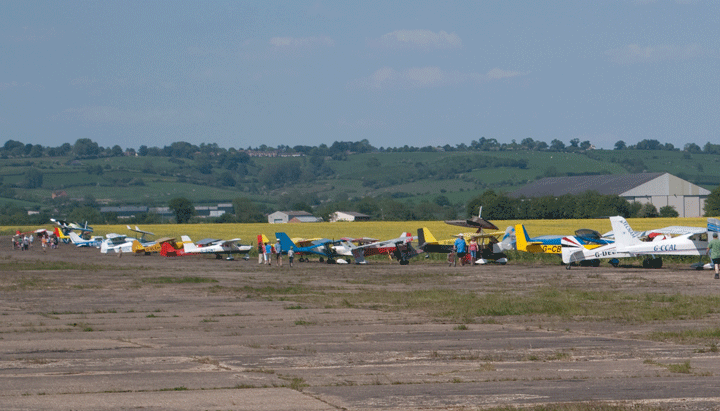
|
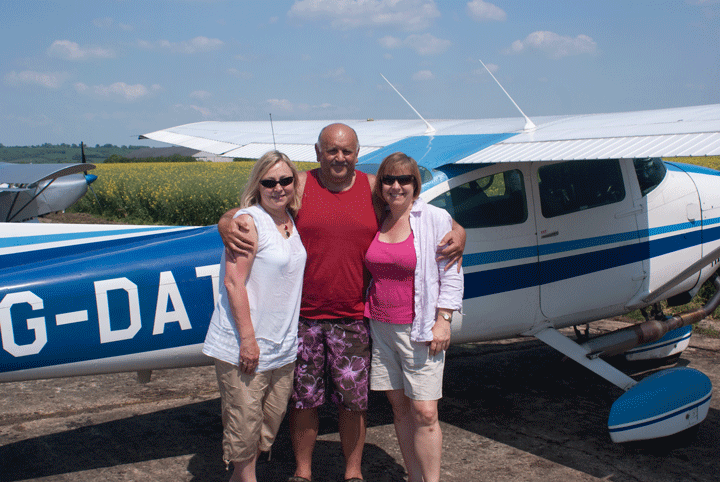
|
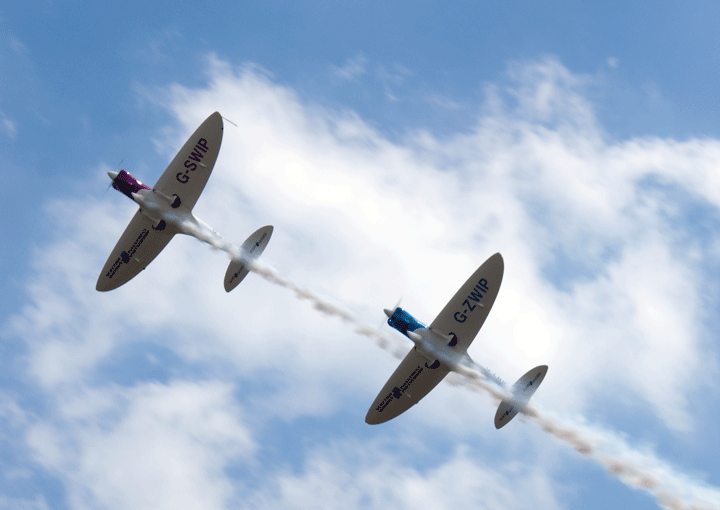
|
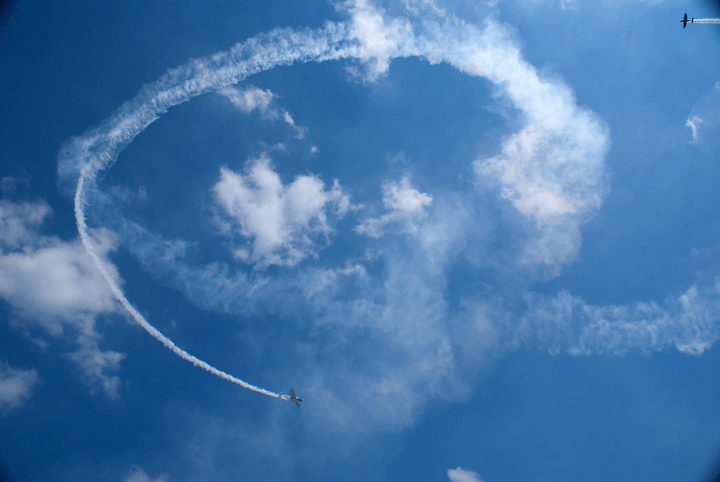
|
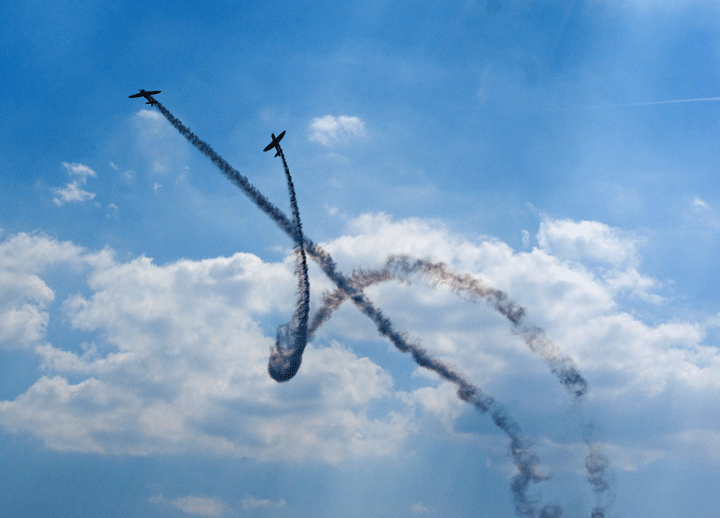
|
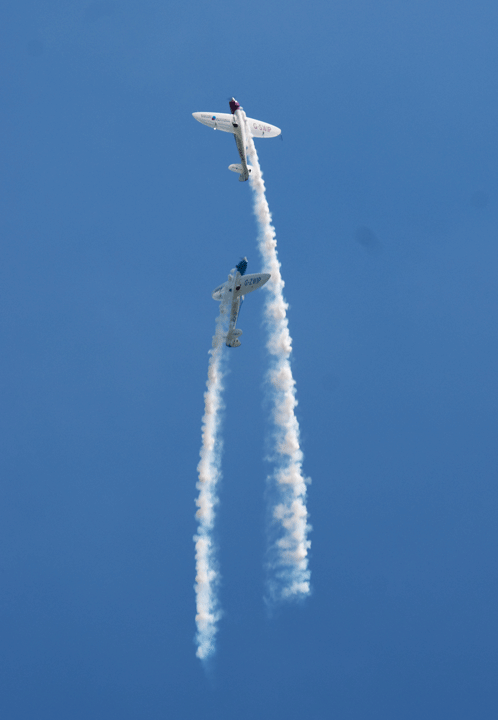
|
Down in 250m: I am the STOL King. It's all down to speed control and flare accuracy.
The microlight rally is fascinating: loads of aircraft of all different shapes and sizes, steam engines, old cars, barbeque and so on. What I like is that everyone can wander around the aircraft and chat to the pilots. We are by some considerable degree the heaviest aircraft there, and some of the arrivals look a little flimsy for my liking.
One day when I'm too old and grey to fly Group A I will fly microlights but something a little more substantial than these, I hope.
I meet up with old friends Wendy and Nigel plus Sue who turns out to be an ex-aerobatics pilot and I offer them a local flight.
We're 4-up with half tanks, thus close to MAUW. We have dry smooth concrete, but it's a warm day. How much runway do we need? This sounds like one of those PPL exam questions, but like many of those apparently damned fool questions, you really do need to know how to extract the correct answer for your aircraft and flight.
Taking book values and adding 20% for a worn engine plus 1.3x for Public Transport (these are not all pilots) we need 420m, which we have on 11 if we backtrack a bit. There's a muck heap at the end of the runway, then it's all standing crops, so nothing big to hit.
Backtrack, turn around, call "rolling 11" and roll. I need 55Kts to climb with 20deg flap and 30Kts comes up at my mental half way point, so we're OK. At 55Kts the controls go light and need holding down, at 58Kts we rotate firmly and with a whistle from the stall warner we're away and climbing without getting the wheels dirty. Hold the nose down to gain 70Kts, then gently climb away before raising the flaps in stages, then throttle back and coarsen the prop for cruise. it's a hot day so the cowl flaps can stay open.
Some idiot has routed a line of those big 30,000Volt pylons across the East section of the 11/29 runway. Taking off on 11 is fine (you can even backtrack to under the pylons if you're feeling keen), but landing on 11 would require a low, slow and steep turn from Base Leg to Final. Looking at it from 1,000ft it looks tight, and tight is not good with 4 up.
Steep turns raise the load on the aircraft and also raise the stall speed, neither of which are good at that point in the flight: there's a reason they call the turn from Base Leg to Final "Coffin Corner".
So we opt for the crosswind-affected 02 and get a nice long smooth, well-judged Final approach instead. Big crab with the 12Kt crosswind, a spot of wing-down and we're flaring just before the numbers again, the stall warner screeching and the wheels plopping gently on. We're down, but with 4 up can we stop?
It takes lots more brake pressure to lose the momentum and we seem to go on for ever, but by the time we reach taxy speed we are only just on the other threshold, so we've stopped in 250m: pretty much book value.
In the afternoon we are treated to a flying display by The Twisters, who are based in Long Crendon, just down the road. They are quite stunning and knowing what aerobatics feels like from the cockpit I have huge respect for the strength of their stomachs.
Since learning to fly I have become quite spectacularly uninterested in going to airshows to watch other people fly: we live in an "Area of Intense Aerial Activity" where the RAF practises displays for a number of engagements, motor-gliders throttle back on climb out over our front gate, military helicopters swoop past our poplars at hedgerow height, business jets and helicopters dodge the Brize zone on approach in to Oxford, fellow-GA travellers cruise overhead and visible to the South is Airway L9 out from Heathrow with (according to FlightRadar 24 Pro) large numbers of intercontinental high level traffic - We don't need to go to airshows.
But these guys are worth making an exception for.
Flying back to Oxford at 2,000ft I request a right base join for 01 and am asked for distance. Ummm, not sure: quickly retune, flip and read the DME in about 2 seconds: 8.6d. Following a Cirrus in who is at 5d we recover VFR for 01, again a big crab for the crosswind and for the first time today we don't need to worry about the runway length: how relaxing.
Kick off the crab as we flare and we're down nicely, roll in and unhurriedly put the aircraft away. I'm sunburned and exhausted, but perhaps now as I approach 100 hours on-type I am nearly ready for one of those Southern Africa fly yourself safaris... They sound like a hell of a lot of fun.
Bembridge 2-4 Jun 12
Ann has asked me, as a Birthday treat, to take her and her friend Evelyn to Bembridge where they have a flat. The weather is not fantastic but we can plod along at 2,000ft. It's a bit hazy, so Strobes to ON.
Lasham has a major gliding competition on so we will adjust our planned route to take account of this, which means a dogleg almost to the Solent Zone.
 I'll park them in the Executive Lounge at Oxford with a bottle of iced champagne and two glasses while I pre-flight. Then with two happy ladies on board I cross my fingers and try the start, which is fine if a little hesitant, taxy out and we take off in to a 1500ft cloudbase. The forecast has the clouds going up to 8,000ft and we are limited on the way down by assorted Airways, hangovers from a bygone age when propeller airliners exiting Heathrow took until Compton to make 5,000ft. Nowadays of course they're at more like 15,000ft by that point so it is all 50 years overdue for a massive review. Like many things in Aviation, this never happens, so we have huge blocks of empty unused controlled airspace between about 5,000ft and about 20,000ft that could all be uncontrolled. There is an old saying that rules are mostly only made, rarely are they unmade.....
I'll park them in the Executive Lounge at Oxford with a bottle of iced champagne and two glasses while I pre-flight. Then with two happy ladies on board I cross my fingers and try the start, which is fine if a little hesitant, taxy out and we take off in to a 1500ft cloudbase. The forecast has the clouds going up to 8,000ft and we are limited on the way down by assorted Airways, hangovers from a bygone age when propeller airliners exiting Heathrow took until Compton to make 5,000ft. Nowadays of course they're at more like 15,000ft by that point so it is all 50 years overdue for a massive review. Like many things in Aviation, this never happens, so we have huge blocks of empty unused controlled airspace between about 5,000ft and about 20,000ft that could all be uncontrolled. There is an old saying that rules are mostly only made, rarely are they unmade.....
Ann has a go at flying it once we are in the cruise and I have to explain about "Airliner" mode. "Pilot" mode is when you only have pilots on board and you can chuck the plane about with gay abandon; "Airliner" mode is for when you have passengers and you fly mainly on autopilot, straight and level with Rate 0.5 turns.
Soon we are doglegged around Lasham and heading for Portsmouth so wave goodbye to Farnborough and make blind calls for a downwind join for 12. Since Britten Norman had a row with the owner of Bembridge running of the field has been taken over by the local Gliding club and if you ask nicely you can still go in there although the Café is closed. But they don't man the tower and they are never there when you need to pay your landing fee, so you leave the money in an envelope posted through their door.
It's blustery and we fight the bumps coming down the approach all the way to the threshold, then flare and I think we're fully down so start braking and the aircraft starts to skip about. The runway drops away here and I don't think we've got enough weight on the wheels yet. A gust catches us as well and it's a bit untidy for a second or so before the flaps come up and dump the lift, we regain the centreline and I can get on the brakes properly. Yuk: I hate it when that happens.
With passengers dropped and landing fee posted we're away again: backtrack 12 then roll. With 20° flap we're off in way less than half the runway and well clear of the rising ground. Ts&Ps are good and we're soon within engine failure range of the beach over the hill so can relax, noise-abate and start a gentle turn to the North over the sea before levelling out and confirming a positive rate of climb before folding the flaps away and retrimming. Flip the autopilot on and watch the towns rolling by.
We keep a close eye out for gliders as we cruise North, say goodbye to Farnborough Radar once more, pick up the Oxford ATIS and cruise-descend for a Right Base join for 01. All very smooth and controlled but I think we may have a grabbing left brake caliper as it squeaks a little on the roll out when I brake.
Some sod has parked in our space, so we have to park 3 spaces over. Again, roll check the tyres for flat spots (never again on my watch!), cover goes on, tie down ratchets set, final pre-lock cabin check: Master OFF, brakes ON, fuel OFF, cowl flaps CLOSED and we can go home.
The Queen's Jubilee has been wet indeed, but a window in the weather allows a return to the Isle of Wight to pick our guests up. I'll get to Oxford early and put some fuel in the plane, then have a nice relaxed journey down to get there early and pay the landing fee.
The kind fuel bowser man fills her up with AvGas and we dice with the dodgy battery once more (it's only dodgy when it's been left for a few days, so we're OK until we land away for a few days somewhere remote: as we're due to go to Scotland in July I think I'll push for a new battery before then!). It starts (eventually) and once more we head South.
I'm experimenting with a GoPro Hero 2 HD video camera which I have used in the cockpit briefly before the battery flattened itself. That is now sorted and during the flight down I experiment with various placements: it's strapped to a bean bag that came with my Garmin 296 and so sits comfortably anywhere reasonably flat. I have experimented with placing it on the coaming looking out through the propeller, but the video quality is not great through the perspex and the propellor makes banana shapes on the picture. It works better pointing inwards at the cockpit or on the seat looking at the instruments.
The resulting video is its uncut state is, of course, very boring, but I think if I edit it I can get some decent highlights.
Overhead Portsmouth we say goodbye to Farnborough and make the traditional blind call to Bembridge, but this time they're alive..... they have just got their radio licence and are keen to respond with wind direction and runway: very professional.
Position for a downwind join RH for 30, turn over the sea and we'll do it non-short field this time as there's a bit of a crosswind. As the land slopes down over some houses towards the threshold I just can't bring myself to get low enough to really bang the wheels on the numbers, so we use a fair amount of runway to stop. I think we have a grabbing left brake that's affecting our ability to brake in a straight line, but it could just be my crap landings....
Backtrack and hop off to parking, pay my landing fee at the very nice Portakabin to the South of the runway and shoot the breeze with the Gliding Club guys who tell me all about Britten Norman's latest run in with the landowner at Sandown, involving them demanding landing fees from him and him parking his aircraft in the middle of the runway and walking off with the keys. The really interesting things never get reported in the papers...
They also tell me about the RAF jump-starting a Hercules with a failed starter motor by parking another Hercules in front and running the engines. Now that would have been worth seeing...
They're packing up to go home so I wander back and my guests arrive; we load up the luggage and fire up.
We're full tanks minus 40 minutes (say 12 USG) plus 3 adults plus luggage, so that's comfortably within MAUW but we'll short-field the take off anyway, so flaps go DOWN, check for symmetric deployment, line up, call "rolling 30" and roll. We're off by the intersection, at 500ft we noise-abate the power, roll gently North and lose the flap in stages. At 2,000ft over Pompey I let Ann fly it and switch to Farnborough for the flight North.
I've told them the video camera is a "navigational device" to get some unforced footage but eventually I have to admit it's a video camera, which causes amusement all round.
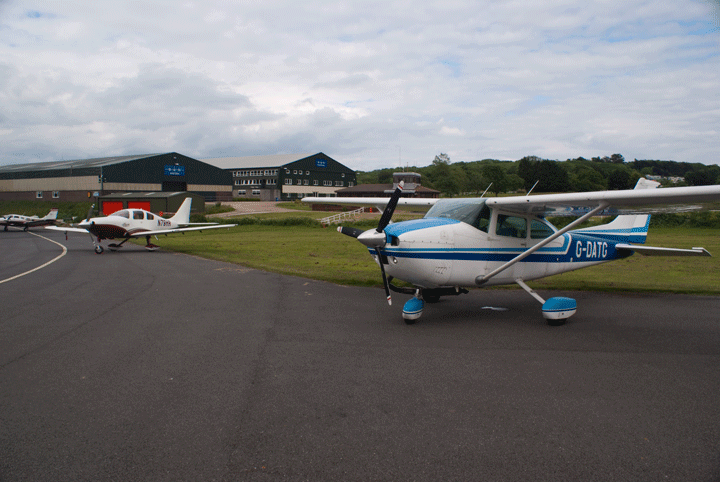 We say goodbye to Farnborough at Compton and cruise-descend for a Right Base join for 01: there's someone else approaching the circuit from the West and doing a real old-fashioned Overhead Join which seems like a lot of faff, looking back. Join crosswind yes, Right or Left Base, even straight-in, but Overhead is a bit much unless you really are unsure of what's going on. But a useful fallback nonetheless.
We say goodbye to Farnborough at Compton and cruise-descend for a Right Base join for 01: there's someone else approaching the circuit from the West and doing a real old-fashioned Overhead Join which seems like a lot of faff, looking back. Join crosswind yes, Right or Left Base, even straight-in, but Overhead is a bit much unless you really are unsure of what's going on. But a useful fallback nonetheless.
To stay well ahead of him as there is no one else to conflict we will keep the speed up: we enter Right Base doing nearly 140Kts before pitching up, slowing to 100Kts and dropping the flaps, rolling on to Final and floating down at 80Kts. He's still on Base leg by the time we're flaring and we keep the speed up so he can get a land after, roll in and park.
Some sod's parked in our space again!
Elstree - Ipswich Monewden 14 Jun 12
We have a challenging day booked: I am picking up Simon at Elstree then going on to a strip at Ipswich Monewden for a day with his father before returning via Elstree. We have already cancelled once because of the weather so I'm keen to go today, but cautious of personal minima and not frightening the passenger.
We have had problems getting PPR for the strip because it has changed hands, strong winds are forecast for later in the day and I am starting late because I manage to forget my wallet and have to go home again to get it. However, flying has taught me to compartmentalise my worries: when flying you simply cannot think of any other stuff at all until you are safely back on the ground.
I haven't been to Elstree before: one of two as-yet unvisited London airfields (the other is Biggin Hill, but I'm planning a trip there).
The battery is definitely deteriorating: there isn't even enough juice to drive the radio to call for start. But it does start and I know it will be OK for the rest of the day once I've got it going. It is charging OK but just won't hold its charge over night.
Departing Oxford and steering north of the Benson Zone the VOR is aimed for Bovingdon and overhead Thame we change to Farnborough North who are off the air: staffing problems, apparently. So I put in a call to a call to Luton who are helpful and unstressed, and probably more appropriate being closer to their airspace anyway.
Elstree's runway 08 slopes downhill and noise abatement dictates a monster circuit all the way around Watford for 08 via the canal turn (Ah, I know where that is) and the University (huh? well I guess it's that building in its own grounds there). A wind check request suggests a bit of a crosswind so we'll use 20° flaps, not the barn doors. I concentrate so much on the crosswind that I flare just a little too late, which on a downwind runway is not good and the runway starts to drop away. I just have to let it keep coming down, but it's late by the time we are solidly down and I have to brake heavily: even then I overshoot the exit and have to backtrack. Messy: I feel a prat....
Simon has never been in a light aircraft before, so I must treat him gently and try to give him as much of the "airliner" experience as possible.
Because we are running a bit late we jump straight in, hook up seatbelts and headsets, and go. No one else is flying today, which is actually typical of many airfields but also because bad weather is on its way. Backtrack, roll 08 and we're off with a turn to the left for noise abatement. London Info seem like the appropriate people to talk to in the absence of Farnborough North and before long we are at 2,000ft under the London TMA heading for Colchester. It's a bit bumpy but Simon is used to small boats, so he is OK (he knows where the sick bags are...).
Ipswich Monewden is not especially short, but it's certainly out of the way and quiet: nestled in the Suffolk countryside I'm not quite sure why anyone would want to visit it. However it happens to be close to where we need to go today, so let's explore.
Surprisingly, once past Ipswich it is surprisingly easy to find so we switch from Wattisham and descend for a look-see. Surprisingly, given the weather forecast, the wind is not from the South East but from the East according to the windsock (never trust the weatherman...), so we opt for 08 and set up a left hand circuit. The noise abatement blurb asks us to avoid all the houses but there aren't many, so that's easy.
It's a downhill runway and I am determined not to repeat the Elstree experience so I get in nice and low over the last hedge and touch softly at the start of the unmarked runway. The earth here is heavy clay, it's been raining and the grass is long: the moment I lower the nose we decelerate rapidly, and turning up the taxyway requires a lot of throttle to get up the hill in search of parking.
As an aside, you can learn a lot from Google Earth about the layout of an airfield, allowing you to taxy with confidence to where you know the parking is, even if the field is not in any of the common airfield guides.
I absolutely love the AFE UK Airfield Guide: its spiral-bound heaviness full of unexplored airfields with exotic names and symbols: Barra (EGPR) with its yellow runway (well, it's the beach); Castle Kennedy; Papa Westray and so on.
Good bathtime reading: I might go there next week, or there. Glenforsa on the Isle of Mull looks promising: we're up there in a few weeks.
After a long day we need to go home, and the wind is forecast to rise so we must get going. The winds always drop somewhat after 4.00pm, however, so we should be OK.
As we start up our host waves at us from the ground that there is a helicopter above us. We look up and can see an Apache hovering directly above us at about 100ft. Now I have NOTAM'd the route carefully, and there is Queen's Birthday flypast practice activity North of our location today, but this is a bit worrying..... However, he drifts off to the South and we slowly and noisily taxy up the draggy grass to the threshold.
The trick to getting flying speed on wet long grass is to raise the nose, so once rolling and s l o w l y accelerating I go full back on the yoke and we suddenly surge forward. Simon whoops as we climb almost vertically over the trees and bank gently for noise abatement.
Changing to Wattisham they don't mention the Apache, so I guess he was just practising something: he drifts away as we head for Ipswich.
Follow the M25 back to the West of Watford, round the canal turn and we are cleared to land on 08 with an 18Kt wind at 140°. The maths says that's 60° off the runway heading so we assume that's all crosswind. This is not the first time I have faced an 18Kt crosswind but I don't want to scare Simon so will need to come in with only 20° flap, plenty of speed and concentrate very hard on ensuring I keep the into-wind wing down after landing, something I am prone to forgetting. Big crab, bit of wing down, some rotor off the trees and it's rough on the approach but this time I'm right down and flaring on the 08 threshold and we're rolling. Keep the ailerons over to stop the wing lifting; flaps up to dump the lift and we're off at the intersection with no drama at all, just like I should have done this morning...
 With Simon dropped, three old computers loaded and landing fees paid, rain is scheduled so we need to get going. A blustery climbout and we're North then East back towards the M25/A41 junction, heading West. Luton are massively busy with EasyJet flights but they do accommodate me as well and suddenly, passing over Bovingdon we run in to a wall of rain.
With Simon dropped, three old computers loaded and landing fees paid, rain is scheduled so we need to get going. A blustery climbout and we're North then East back towards the M25/A41 junction, heading West. Luton are massively busy with EasyJet flights but they do accommodate me as well and suddenly, passing over Bovingdon we run in to a wall of rain.
We're marginal VFR at 2,000ft but I can see well enough to continue visually. At Thame I finally switch from Luton having managed to get a word in edgeways and continue with Oxford for a Left Base join for 19. I can't actually see Oxford at all but it's just me and an Army Puma wanting a transit through the overhead: no one else wants to be out in this....
As we drop down the Base leg the runway appears and I'm also visual with the Puma at 1,000ft. A wind check reveals 140° at 11Kts so that should be easy, but as I touch on the soaking runway I make the classic error of centralising the ailerons, a gust catches the starboard wing and we head for the side of the runway. Big aileron down and opposite rudder catches it, but it feels messy and we slide all over the place before I get it back under control. I seem to have a mental block about crosswinds coming from the left: I can cope with them coming from the right but left hand ones just seem to fool me. Must get better at it!
And finally the "lovely" job of putting the cover on in the pouring rain and a howling gale - at least with a high-winged aircraft there is somewhere to shelter....
Melbury 26 Jun 12
Our friends live South of Yeovilton in deepest darkest Somerset. Getting there by road is a miserable affair beset by inadequate transport investment, the Local Plod with their speed cameras, pensionable drivers and caravans.
We have been asked to bring their daughter Maddie back to Oxford and given the potential round road trip time of 5 hours, not including traffic jams, aviation may just be the solution. It turns out their neighbour has a top-of-the-line private strip ½ a mile away on the top of a hill, and we have permission to land there..... 40 mins by air.
Preparations for flying to these undocumented strips are always time-consuming: it's important to discuss with the owner arrivals and departures co-ordination, approach aids (if any), PPR, lights, hours of use, landing fees, circuit directions and heights, radio frequencies and procedures, windsocks, noise abatement procedures, access by road, parking, drainage, runway conditions, agreed lengths and directions, whether any livestock need moving and, most importantly, weight and balance / runway length calculations. Grass, especially damp grass, is really draggy, which is great for landing but can make take-offs problematic. I tend to print up an aerial shot with marked-up directions, circuit directions and heights, noise abatement rules etc and of course laminate it (like everything else: I'd laminate my wife if she'd let me...).
So after a long discussion with the owner, several hours on Google Earth and an hour with the POH I reckon we're clear in with 3 up, clear out with 4 up provided we're only half tanks and we back right up to the fence for the take off roll.
Steve has flown the aircraft the previous night and left it with just over half tanks, so that's perfect. He's left the cover and tie-down straps off so we should be away in no time.
I never trust the fuel gauges, the fuel not to run out of the tanks overnight or someone not to steal the AvGas, so I alway dip the tanks, write the contents on to my Tech log and stand there for just a moment quietly ensuring I am happy with the endurance. Like all pilots I have a little echoing Air Accident Investigation Board (AAIB) voice in my head writing the accident report as I go along: "the pilot elected to take off without dipping the tanks on the verbal report of another pilot that he had filled the tanks. Subsequent investigation of the wreckage discovered no fuel in either tank or in the fuel system...." In other words "Accident Cause: Pilot was an Idiot".
We have sufficient fuel today and apart from a left tyre that I can't help thinking is just that little bit less pumped-up than the right tyre we're good to go, so we fire up and take off, head South and swap to Brize Zone who are uninterested as we are heading away from them. They are noticeably busier now than when I learned to fly, mainly because of Afghanistan traffic and the ex-Lyneham Hercules, so unless I'm going into/over/through their zone I tend to leave them alone.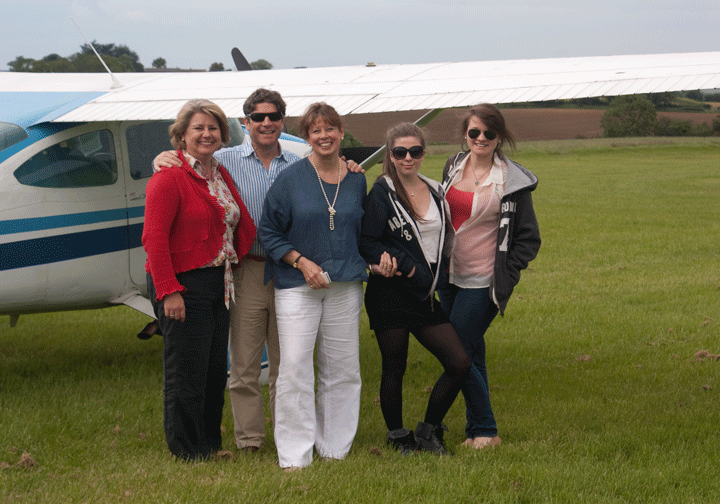
With Lyneham closed, heading South West from Oxford means the next bit of airspace you'll encounter is Bristol so overhead Swindon we swap to them and cruise down to Melksham, turn and head for Yeovil/Yeovilton.
The big military installation with the radar is Yeovilton, the smaller grass strip (been in there!) is Yeovil, known on the radio as "Westland" to avoid confusion. We're at 4,000ft above the top of their MATZ so a Basic Service is all we need and once clear of the MATZ we descend to 3,000ft to have look for the strip. It's a bit of a bugger to find, being nestled in the folds of the Somerset hills, but a couple of circuits around and it snaps in to focus. We descend to look at the windsock, which is (of course) standing straight out directly across the runway about 2/3 of the way to fully extended, so that's 10Kts across.
We can land 04 or 22 and as we happen to be heading 04 we'll drop in to a left hand circuit for 04 at 1,000ft above the terrain, avoid any houses we see (not many here: it's pretty rural), BUMPFTCHH, 2 stages of flap, trim for 80Kts, turn Base leg and then Final, flip out the barn doors and slow to 65Kts. It's bumpy over the trees, then it smooths out as we descend below the tree line. Flare over the last hedge (it feels like we're going to brush the hedge with the main gear, which is always a good sign), try to fly it down the runway and in a second it brushes the grass and we're down and rolling. Grass is a good retarder and we're slowing pretty quickly so edge off towards the edge of the runway and turn for backtrack, taxy back and park up by the trees.
This is a really posh strip, with a small concrete apron and a neat new green hangar with a Jet A1 fuel pump outside (wow! This guy has a serious aircraft...). Very nice.
After a good lunch we all jump in for the return journey and start up. We're 4 up so we'll taxy as far as possible back against the fence. The grass is very long here and we need a lot of throttle to make it move, especially in the turn. We're finally ready, so power-checks, hatches and harnesses and we'll roll.
Annoyingly the runway undulates so the poor aircraft keeps trying to take off on the humps and failing. As we're heavy we aren't accelerating as fast as I'd like, but by half way down we're at 40Kts so we're OK..... at 55Kts I haul her off, accelerate in ground effect and we climb out with room to spare. It's hard to know how I could have improved it: maybe more yoke back at the start to get the nosewheel off?
We circle the strip and then climb out North East. We'll be too low to get over the Yeovil MATZ so we swap straight to them and request a MATZ transit at 2,500ft. It's close, but we do get approval before entering their MATZ and we've clawed our way to 2,500ft by then, so level out and accelerate across the MATZ stub then cruise climb back to 4,000ft, swapping to Bristol as we do.
Bristol suggest we change to Brize, but we'll opt for a change en route straight back to Oxford Approach. Soon we can see Swindon, the M4, the white horse at Uffington, then Grove and Didcot. Descend over Port Meadow for a downwind join for 19 and manage a little bounce on landing: a touch of power to stabilise then let it sink back. I think I managed to not look at the end of the runway while flaring. Must stop doing that!
And that's me crossing the threshold of 300 hours.
Melbury 26 Jun 12
A common cause of aviation accidents is "Controlled Flight Into Terrain". This is where the aircraft is in control but the pilot is either asleep, distracted, or can't see where he is going and flies in to the side of a hill or a power line. This is often the result of scud running, where a pilot will try to slide in VMC under the clouds but the ground rises and/or the clouds lower. You end up in the jaws of a nasty trap. We need to avoid this...
Today we need to take Maddie home, and although the weather is perfect now the forecast for Somerset is a front coming through at 10Kts SW-NE that will bring scattered low clouds, then a period of "Fog" (actually low cloud), then the cloud will lift to 1500ft behind the front.
So the plan is to try and fly through the front if it is mild (a bit of rain never hurt anyone) visually, or if the clouds get too thick we'll climb on top and get back down the other side. A lot depends upon where the front is in relation to the strip when we get there. Weather forecast tend to be very good at describing what is coming but not so good at when it's coming.
Fill up with fuel for half tanks (I have enough but without much reserve, you can't have too much fuel except when you're on fire or heavily laden in to a short wet strip...), queue for ages at Charlie waiting for a land rover to scare a flock of birds away from the runway, then line up and take off, heading South West.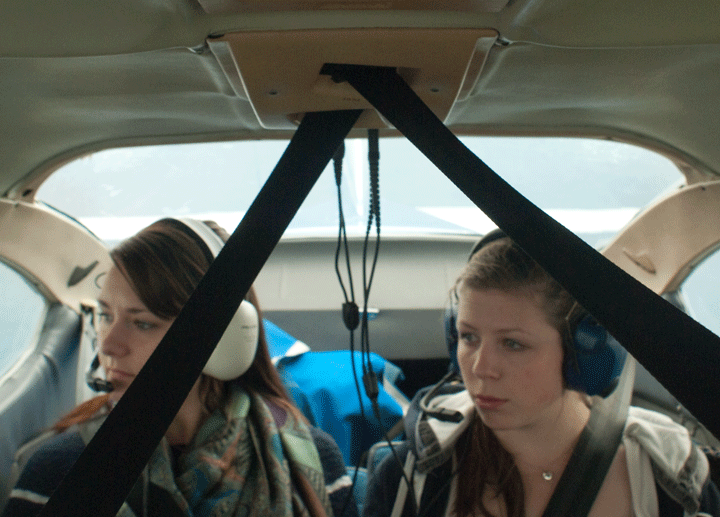
It's very smooth today: the high cloud is suppressing the thermal activity and we can concentrate on the "Airliner" experience. Around Swindon we start to encounter scattered clouds beneath us and as it accumulates we drop down to below it. We may be able to get through visually, but I'm reluctant to go over the top as you can never descend in cloud to below the Minimum Safe Altitude or MSA, calculated to be 1000ft clear of anything below you. MSA for Yeovil is 2300ft QNH and the cloudbase will be 1500ft, so we'd need to find a hole or a published procedure to descend upon.
Soon the clouds are descending and we're getting close to the scenery: up ahead the ground is rising and I can see the cloud lying across it. My GPS confirms it by showing yellow ahead with crosses showing peaks: it's time to climb. All three levers go fully forward, trim for 80Kts and climb. At 3,500ft we pop out in to the sunshine, surrounded on all sides by ice cream.
If I can't find a hole we will need to go elsewhere, land and sit it out, except that all our alternates are fogbound. Still, we have enough fuel to return to Oxford if necessary.
Ahead the cloud tops descend behind the front and a few minutes later, directly over our strip we find a small hole. I tip it on a wing and descend visually, spiralling down through, pulling a bit of G to my passengers' amusement and we emerge in to the gloom 2 miles East and ready to set up for the approach. The strip takes a bit of finding but they've mowed it and suddenly it's there so line up, pre-landing checks and full flap, drop down, big sink in the valley before the hill then drop it over the hedge and in. Concentrate really hard on the other end of the runway, don't look down, and we'll fly it power off just above the grass... ooh we've landed, that was nice.
 After coffee we fire up for the return. The strip is once more bouncy, making take off hard and the stall warner squeaks as we lift off finally. At 1500ft we go IMC and don't emerge until we're at 4,500ft and well on the way home. This is much easier and smoother than messing around under the clouds.
After coffee we fire up for the return. The strip is once more bouncy, making take off hard and the stall warner squeaks as we lift off finally. At 1500ft we go IMC and don't emerge until we're at 4,500ft and well on the way home. This is much easier and smoother than messing around under the clouds.
We route around Yeovil's MATZ stub as they have jet traffic coming in, get back on our course to Melksham, swap to Bristol then to Oxford as we approach Swindon.
One thing that amazes me about aviation is how quickly things can go from being quiet and gentle with little workload to hugely busy and frantic: you simply have to be prepared.
As we approach Oxford and descend in to light rain for a visual recovery we quickly realise that the airspace around the field is choc a bloc full of arriving aircraft. The ATC lady is managing but the number of spinning plates she has going is incredible. I count at least 16 aircraft in various stages of taxying out, taking off, IFR Hold, IFR or VFR approach or landings, and she is reeling off instructions to all and sundry. We need to do exactly as she says and to the letter or we risk flying in to someone.
We introduce ourselves and are immediately told to perform a Standard Overhead Join at 2300ft. I've not done one of these for a while but I've been trained here and can do one accurately blindfolded, so we report overhead at exactly 2300ft over the landing numbers, descend and cross the takeoff numbers at exactly 1500ft, report downwind no 3 behind a PA-32 for which we have to slow. He is slowing to get a "land after" behind the Cessna 182 in front of him so we're down to 80Kts to get a "land after" behind him, which we all manage. Behind us there's another aircraft which gets a land after behind us..... It's very busy: Oxford now have radar and whilst it's not officially in use they can cope more accurately with the workload making them less stressed because they can see where we all are.
Alarums and Excursions
After cancelling our trip to Scotland in May because of the frankly awful weather we have finally rescheduled all parties concerned, planned the weather to death, popped Nessa's Aunt in the back of the plane and we're off. The weather is forecast to be scattered showers in a weak front half way up the country so we'll be IMC for a bit and then it will improve.
Departing with the new "Oxford Radar" we laugh at the traffic jams on the M40, climb to 4,000ft and head for Daventry, then turn North and climb overhead Melton Mowbray. The front appears as forecast, we are briefly solid IMC then we pop out and start to descend to our planned 4,500ft for a bit of sightseeing.
Switching to Humberside Radar we are just passing through a few scattered clouds when both the “High Voltage” light and the “low Voltage” light illuminate, and the ammeter swings to register a slight discharge. Well, the voltage clearly can't be "high" and "Low" at the same time, but the meaning is clear: we've lost the alternator and we're running on the battery. Not good.
My immediate thoughts are "electrical fire" but nothing is smoking and there are no nasty smells, none of the breakers have popped so it's not immediately life-threatening. Unlike a car engine, the engine runs on magnetos that are independent of the battery (I do remember my PPL "Airframe Technology" lessons!).
I am about to pull some precautionary carb heat anyway as we are in cloud, and as the engine reduces in RPM with the carb heat, both lights go out - maybe we're OK.
But no: 5 minutes later they both come back on again: we have a problem.
It's a leap of faith to turn the Master switch off in flight, but I've done this before and all that happens is that the radios go dead. So we cycle the Alternator and Battery switches, but no: it's dead.
We tell Humberside Radar and ask for a precautionary diversion to get on the ground and take a closer look. They agree and give us vectors to a visual approach for 02 - we pop out of the clouds at 4,000ft in to some grimy VFR and join Left Base for 02. The Fire service have turned out, which is exciting. A smooth approach and landing is followed by a taxy to their "Holding Pen": the South apron, where we shut down with a Fire Service foam nozzle trained at the aircraft, which is comforting.
This is a relief: problems take on a different perspective when you're on the ground and out of the aircraft, with time to think.
An hour spent trundling around Humberside Airport (an efficiently-run, if airline-oriented and hugely-underused facility) reveals no one with any light aircraft maintenance abilities and my calls to Coopers Aviation at nearby Wickenby only get an answering machine. Well: it's 4.00pm on a Friday afternoon....
The decision needs to be made: do we go on or go home? The aircraft still has plenty of electrical power, it will start and the radio will work. But where we're going is a grass strip with no battery carts, no support of any kind. We can divert to Fife down the road and they will have a battery cart, but on a Saturday or Sunday they aren't going to be able to fix it. And we need to be back on Sunday night.
I decide to depart Humberside based upon the available facts and a chat with the maintenance guys at Wycombe: none of us want to be stuck at Humberside.
If the light stays off we'll go to Kingsmuir, if it comes on again we will return to Oxford, using the hand-held radio if the battery failed or going non-radio if necessary (we'll ask Waddington to co-ordinate with East Midlands and Oxford). We're not going near the Olympic Atlas restricted Area so this isn’t going to be a problem.
The aircraft starts OK, with oodles of power, the light stays out at idle but comes on when we increase power to taxy. We'll go home.
Backtrack and depart runway 02 and head South West and then South. The weather is marginal VFR with the odd cloud until Daventry at which point we break out in to bright sunshine. We warn all the various radio units we speak to that we may suddenly go non-radio but in fact the radio and transponder (usually the first to feel the effects of low voltage) continue to work: there is even enough electrical power remaining to drop the flaps for the straight-in approach for 19 at Oxford, and to put them away again once we have landed.
I smell a rat: I think it is charging, and the lights are lying to us. Given that we have flown probably 1hr20mins with apparently no charging and the electrics have continued to work normally it's the warning lights that are faulty, but I am not prepared to risk being stranded at Kingsmuir.
So a very disappointing day, and an unscheduled weekend at home instead of whizzing around Scotland, but we'll reschedule for September.
Wycombe 1 Sep 12
It's been 6 weeks since our Humberside near disaster and the aircraft has taken up semi-permanent residence at the menders (no names, no pack drill, they know who they are...) until now. Apparently, it was ready yesterday, so Steve picked it up and half way back to Oxford... the same light came on.
So today we need to fly it back to Wycombe to be mended... again.
I've used garages like this before. They only get the one chance, mind you....
So we'll practice ADF tracking at Westcott on the way: this gets us clear of Benson and gives us a bit of training. Lots of symmetric flap deployment testing (we have a new flap following the discovery of skin cracks) and a really good controls sense check (wise after any disassembly - crossed controls will kill you very quickly) before starting, then fill up with AvGas and take off on a sunny afternoon for a cruise to Westcott.
That's it... push the head for a 060 inbound track to Westcott, and we get a pretty good cut as we pass overhead. Swing out and pull the tail for a 140 outbound track, then switch to Wycombe and descend for their weird "overhead" join (join overhead the landing numbers, turn on to the runway heading, then half way down the runway turn out on to the downwind leg and descend to circuit height. Weird: but they need to as gliders use the other side so there is no dead side). Turn over West Wycombe for Base, pop the flaps and see if we can remember how to land.
I've landed on enough short strips now never to waste any tarmac, so we're flaring at 75Kts before the numbers. I reckon all my landing issues over the years have been due to me not concentrating on the far end of the runway whilst flaring. I am a bit Zen about this now, and it does give a great landing every time. So all you Students out there, this is the key to "happy passengers" landings.
Backtrack on the bumpy grass and shut down on the apron - we've not seen any of the electrical failure lights today and the aircraft seems as good as new, but we'll let them have a (hopefully non-protracted) look at it before we pay the bill.
Local 1 Oct 12
It's time to do my Biennial SEP "Hour with an Instructor" to ensure I haven't got in to any bad habits over the last two years.
This isn't a test: it's just a requirement that someone somewhere knows you aren't doing anything really dumb. I fly with Pete a fair amount and he keeps an eye on me, dispensing sage advice without treating me like a Student, which I appreciate, but this is an official recognition of that fact.
It is possible to argue that my IMC Renewal earlier in the year counts, but I have been led in the past to understand that the Examiner in that hour is acting in an Examining capacity, not an Instructional capacity, therefore it doesn't count, however this is an interpretation of some rather over-complex rules and may not be true. To be on the safe side, Pete and I will go out and practice some forced landings and tinker with the stall as we have some queries over the stall warner. He'll then sign my book and we're all Definitely Legal.
Practice Forced landings are a perennial good thing to practice in case the donkey stops kicking. And the stall warner appears not to be coming on soon enough, although some airframe noise precedes the stall giving a pretty adequate warning. This needs investigating.
We pre-flight (we have a warm pitot head for once), start up and leave with a right turn out over Blenheim Palace's gardens. Heading for the area between Charlbury and Little Rissington for "general handling" Oxford Radar give us a squawk: there's a first.
The AH droops towards the left, pretty useless for IMC but as we're VFR today we're not too fussed. It does need fixing, however.
So: PFL's. Trim for 75Kts (five big swings back on the trim wheel), turn in to wind and pick an into-wind field in the triangle between the nose and the wingtip. I have always favoured a constant aspect PFL approach but Pete suggests the addition of a downwind-to-base marker point of 1,000 AGL, which works better. All our PFLs bar one are survivable and at no point do we near the "coffin corner" base-to-final too-low-on-speed-and-pulling-too-hard area, so eventually, having annoyed several tractor drivers and a few remote houses we climb back up to 3,000ft just below the cloudbase for some stalls.
The Cessna 182 is a hard beast to really stall: you have to pull back so hard and get so slow that the ASI nearly hits the bottom stop: and that's without any flaps out. With 20° flap the ASI runs out of indication before we actually stall, and with 40° it's unmeasurable. The stall is massively benign: no wing drop, just some buffet, a lot of airframe whistling and finally the stall warner. A brief push forward to break the stall and we can recover with only 100ft-odd of height loss. So the stall warner is working OK, even if it is acting more as a stall indicator not a warner.
Overhead Charlbury Pete does one final PFL "to show how it's done" in a field near Cornbury Park and with flaps and some sideslip we're good to go in a particularly small field.
It's interesting how these things look so much smoother when an Instructor demonstrates: I can well remember their "on rails" approaches I strove to emulate when learning, whereas my approaches consisted of increasingly desperate lunges for something I might be able to land from....
However he underestimates the up-slope and trees beyond as we climb away and we end up roaring across the B4437 and Wychwood Forest uncomfortably close to the tops of the trees, hoping the engine doesn't stop for real...... I would have turned back down the hill to give myself more height.
Back at 3,000ft we position for a right base join, descend and float gently down "on rails" for a nice smooth arrival (always look at the end of the runway), roll out and park up.
Pete believes we should park so that the nose wheel is on the blob at the end of the centreline parking mark, whereas we have been parking a foot or so further back so the wing tiedowns line up with holes in the tarmac. I'm not sure which is right.
Ipswich Crowfield 6 Nov 12
I need to go to Witnesham, just North of Ipswich for the funeral of my Best Man's father. It's awful when the older generation moves on: it means our generation are going to be the next to die, but also these are people we knew and respected.
Getting to Ipswich is 150 miles of speed cameras, idiots and pensioners, and getting back at 5.00pm will be worse. Plus it's forecast to rain, so dark + rain + rush hour = M25 gridlock, you can be sure.
However, a straight line drawn between Oxford and Ipswich Monewden, where I've been before, shows 40 minutes each way. I can get a taxi to take me the 3 miles to Witnesham (I might get a folding bike to put in the plane in future) and back, so that's sorted.
But when I call the owner of Monewden for PPR he says the field is flooded and suggest now is not a good time. Oh dear, back to the traffic jams.
But a call to Ipswich Crowfield is more productive. They are under planning restrictions concerning noise, but we discuss our large Carlos Fandango exhaust and agree that this makes it acceptable, especially considering it's a wet Tuesday in November, and no one is going to be around. So in the end I won't have to sit on the M25 and what's more we discuss taxis and he offers to lend me his 4x4 to get to and from Witnesham. Now that's care Above and Beyond The Call of Duty.
It's sunny at Oxford but bitingly cold when I turn up in a suit and black tie, book out and pre-flight, then start-up and turn the cabin heater on to thaw my hands out. Oh, that is better.....
Up to runway 29 which has subsidence cracks on it's South side so will be closed as an Active runway for the rest of the year, then cleared for take-off and climb out Eastwards. It's smooth as we level off at 3,000ft and track to the South of Cranfield.
There is satisfaction in getting the height exactly right, the track exactly right, the compass, AH and both GPS's all exactly aligned, the radio pre-tuned to your next frequency, the towns and roads positively identified (I am eternally grateful to The Duke of Edinburgh for DofE navigation exercises teaching me to read OS maps: I wonder, being a pilot himself, whether he had this use in mind when creating the exercises...), and diversion airfields all in your mind, FREDA checks done and recent PFL exercises in mind. Time for a happy hum-along, I think.
The radio is quiet as we approach Wattisham and change to them to request a MATZ transit: they have traffic on their ILS so ask us to transit through their ATZ at 3,000ft and then descend for Crowfield. I watch what is probably Prince Harry in an Apache descending whilst looking for a small strip in a series of fields. One useful tip for these small fields is YouTube: there are videos on there showing approaches and landings at most airfields, and once seen you have a pretty good idea of what to look for.
Released from height constraints by Wattisham I can spot the field so we descend in a wide left hand circuit for a long straight in, get a bit of rotor off the trees, come neatly over the last hedgerow and touch just after the displaced 31 numbers for a gentle roll-out. Being wet grass I will let the aircraft slow by itself, then taxy left up the little hill and park outside the main hangar. The loan 4x4 is waiting, so I can pop off and get some lunch in good time.
Funeral over, it's started to rain (as forecast, but it will remain light) and the light is failing as I return the 4x4 to the airfield owner, pre-flight, fire up and taxy out. The wet grass is now slippery and we have to taxy with care. Turn and power-check at the 31 numbers, then contact Wattisham who are happy for me to take-off and remain under 1,000ft on their QFE (which puts me 35ft underground where I'm sitting, as I'm on a hill and they're in a valley...) as they have ILS (Harry again, I'm sure) traffic.
So: 20° flaps, full chat and rotate at 58Kts, noise abate at 300ft and we are way above those looming power lines, visual with Harry in his AH-64 and climbing out through the rain. At 3,000ft we're in the clouds, so as they are above MSA we will descend to 2,800ft and remain visual. But satisfyingly the AH and autopilot are now working, although the cigarette lighter isn't. Can't light up, then.....
We're in and out of the clouds most of the way home before the weather clearing nearer Oxford (again, as forecast). The Low Voltage light is throbbing in time with the strobes, but the Ammeter shows positive charge at all times, and I'm less concerned with the electrics now I know what happens when they fail. I have concluded the electrical problems on this aircraft are water ingress-related as we only seem to have problems following extensive flight in rain. If the ammeter continues to show a positive charge we can continue and if the battery gives out we have a portable radio.
Switch to Cambridge and as befits a gloomy, wet Tuesday afternoon in November, I am the only person on frequency. Cranfield are busier (mainly with Oxford Senecas) and of course Oxford is pandemonium.
As it's now almost official Night I'd like to revalidate my passenger-carrying-at-night facility, which I believe involves 3 night landings to a full stop (I have since learned it only requires 1, which is ironic considering what happens next...). So I circle Bicester until official Night, then head in for a Left Base join and this time remember to put the landing light on. Descend Left base, pop the flaps and slide down the approach, flare and land gently, a shade too fast but on the centreline and roll out to the end, vacate and taxy round to the apron.
Cleared back to the B1 Hold for power checks, we then line up and take off for a circuit which is fine (Kidlington is very pretty at night), turn Final once more and flare, and I'm just thinking this is easy when...
"Golf Tango Golf, Expedite runway vacate" (we have a big jet IFR at 4 miles on the approach behind me)
"Er, negative Expedite. We have a blown tyre...".
Half way down the runway the ride starts getting rough. As a bicycle rider I know this deflating feeling. There is no pull, so I know it's the nosehweel. I can't keep it going, so eventually we roll to a stop right in the middle of the Active runway.
At night.
In the rain.
Oops.
I'll leave all the lights on so I don't get a jet up my backside, but meanwhile the Tower is redirecting incoming flights, closing the runway and redirecting the poor jet up and back in to the Hold while and organising a tug to come out and get me.
The Fire service are brilliant: the tug comes and I hold the tail down while they pop the shovel under the nosewheel, then we tie the nosewheel on and trundle off down the runway at 15mph, finally clearing it and down the taxyway to the maintenance area.
There is very little I can do as it's dark: our maintenance guys will investigate tomorrow. But this is definitely a failure not covered in the PPL syllabus, except for the general advice to keep calm, fly the aeroplane and deal with the problems as they arrive.
It wasn't dangerous and was great experience: no one got hurt and tyres are replaceable. As they say, the flight's not over until the aircraft is tucked up and you've left the field.....
Postscript: It turns out that it wasn't mud in the spat. The maintenance guys have changed the wheel and the interior of the nosewheel spat was clean. So it was something else that caused the puncture.
And the jet I held up contained the owners of the airfield...
Oops.
Local 16 Feb 13
The weather has been awful with snow and rain, and more rain for what seems like forever. My flying fund has been somewhat diminished by our France trip so I have laid off the aviation for a couple of months. But today it looks like the weather might play ball, the aircraft is free and all the jobs are done: time to play.
I love the smell of the aircraft when you peel the cover off and first open the door: that mixture of vinyl and cold AvGas, of potential adventure, and a frisson of "can I remember how to do this?"
The gentle reassuring rhythm of an unhurried pre-flight check, working calmly through the familiar checklist, the climb-in and strap-in, the pre-start checks, the look around, the "clear prop" and whirr of the starter that shatters the silence until the rumble of the engine is muted by the headphones and the noise-cancellation, that "I've gone deaf" moment. Then the click-hiss from switching on the radio and a random half of the current ATIS transmission: "...QNH 1022, on initial contact report QNH and information Mike received..." that is as reassuring as the Radio 4 shipping forecast.
Now: assemble thoughts for the Tower and initiate radio: by gum, they're busy today. For a seemingly quiet airfield there's a hell of a lot of traffic going on. Like driving, it's always good to have an idea of where everyone is and you can get a good idea from their radio calls, so you end up with a mental picture of quite a surprisingly large number of aircraft in the vicinity.
Once everything has warmed up a bit we move off and taxy for power-checks up to the 11/29 runway, which has a sufficiently dodgy surface at the moment to be closed for landings and take-offs. I wonder if they'll mend and reinstate it? I sometimes think the smaller planes are the only ones that use it as a runway as the larger ones and the jets don't have the same crosswind sensitivities. Maybe it will be permanently out of action, like the old 21/03 grass runway (good for grass learning if nothing else).
We wait for ages at the Hold for landing aircraft, a couple of which I think we could have nipped out in front of, but they are Duty bound to give priority to landing aircraft and I respect that. If I'd pulled out to take off then stalled or had a puncture they'd have had to go around and maybe they wouldn't have been able to.
Line up, SPLAT-check and open her up. She hasn't been flown for a couple of weeks so double-check Ts&Ps, ease her off the ground at 65Kts and mentally keep a note of where you're going if the engine falters: ....there.... over there..... up to 500ft when you can throttle back and wind the prop back for some noise abatement and to reduce the stress on the engine. Left turn and climb out of the circuit heading East for a gentle bimble.
We'll swap to Benson as we're going to be in their MATZ for a while, but Approach, Tower and Zone are unresponsive so we'll monitor Zone, avoid their ATZ and swing up to the Stokenchurch mast before heading South low along the edge of the Chilterns to take some pictures. It's always useful to cross-check the yellow terrain warning signals from the Garmin GPS against how low you actually are. Yellow means "you're OK but it's dodgy: don't go any lower". Red means "Climb. Now."
We photograph our friend's house South of Watlington and continue on South: I've never flown down here before. We can see Chalgrove and then Benson on our right and we keep a close eye out for helicopters just in case before turning near Wallingford and heading for Didcot and the massive cooling towers belching steam (and turbulence) into the atmosphere.
It's really smooth today and anywhere near a water course is flooded. The news may not show it but there are still plenty of houses flooded everywhere. I had no idea it was still this bad.
Passing Didcot we head for a friend's house for some photos: a couple of low passes should do it, whilst avoiding the Abingdon Grobs that turn over our house. Back North, a quick pass over the house to ensure it's still there (the new terrace looks nice) and we'll climb above the Grob circuit height to keep out of their way and head for the Brize zone corner and a rejoin for Oxford, who are massively busy for some reason. Barely able to get a word in edgeways we are asked to report at 4.0 miles which I think we can do.
Oxford glistens in the sunshine as we descend over the massively flooded Port Meadow for a Downwind Join for 19. The radio is hugely busy as they try to slot everyone in including a PFT PA28 whose engine has stalled on the taxyway and the pilots are pushing it off on to the apron.
Once established Downwind we're asked to report ready to turn Base as they are busy but we can't extend because Weston is Active so we may have to orbit, then we're no 2 to a C182 turning Final so we'll slow down and give him a bit of room, turn Final as he touches and goes and establish a stable approach. Winds are calm, it's smooth and I aim for a third of the way down the runway and round out for......a smooth landing. Ah, after 2 months I haven't lost the knack.
What a nice afternoon bimble. Now: Barcelona, anyone?
Compton Abbas - Kingston Bagpuize field 21 Apr 13
After a long cold and miserable winter, a nice Spring day finally appears and its time to take Alice's boyfriend Kieran for a spin.
We'll do a solo circuit first just for currency and to ensure the wind is not making the flight too bouncy. Having cancelled last week's trip because the winds were up to 35Kts albeit right down the runway, I'm keen we don't scare the passengers. Given what happens later, this now appears somewhat ironic....
This goes well, everything is settled and a nice landing ensues. Half tanks at the pumps for W&B, load up the passengers and off we go. We have about 4 hours endurance which should see us around the Isle of Wight and back via Compton Abbas.
We tour Oxford, Watlington and Henley before heading South, getting a MATZ Transit through Odiham, avoiding the gliders at Lasham and coasting out over Pompey, descending around some scattered clouds at 2,000ft and flying around the South Coast of the Isle of Wight at around 1,500ft up to The Needles. The weather is warmer down here and it's very smooth over the water as we swap to Bournemouth and head West for Sandbanks, around the edge of the Bournemouth Zone and up to Compton Abbas.
Compton Abbas are surprisingly close to the North side of Bournemouth's Zone and by the time we have swapped radios we are almost overhead. They are 26 RH, so we'll slow, give the approach plenty of room as it is quite critical we are down and the wing is not flying before the runway gets bumpy in the middle, come in nice and low over the trees then down on the non-bumpy section. It gets bumpy as we slow, but I've dumped the flaps now and we park up for a cup of tea. Nice place, Compton Abbas: very friendly.
Depart Compton Abbas over the bumpy taxyway, quick mental recheck of the fuel state: 2½hrs left and it's 40 mins home, so that's OK. We're the last plane out before they close, so we enter the runway and give it 10deg flaps, bounce along the bumpy bit which keeps bouncing us in to the air, accept the final bounce and we climb away over the sudden drop at the end before turning North, cleaning up the flap and heading home.
We head North around the Salisbury Plain Danger Zone, past Lyneham and Swindon then head for Faringdon at 2,500ft VFR. And this is where the trouble starts.....
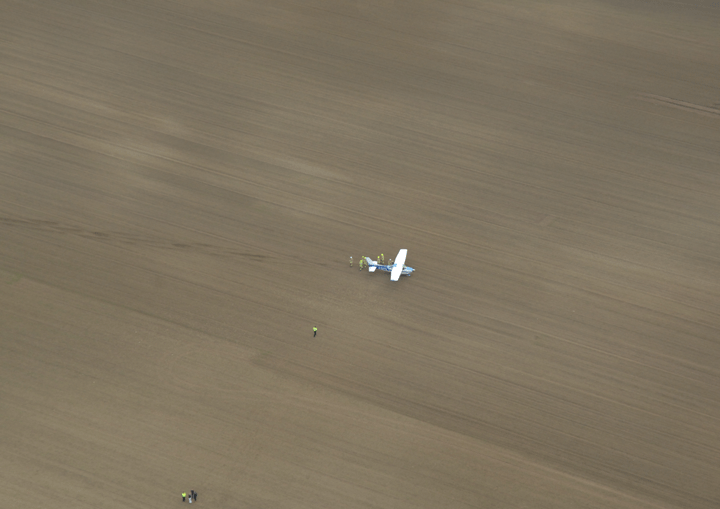
I have previously noticed occasional in-flight engine surges and when it does so I am not overly concerned, but it gets worse so I apply carb heat, then richen the mixture and finally bring up the prop to try to restore full power, but it's clearly unhappy about something.
A Left to Right check goes: Mags (OK, try L and R but no change), fuel (try Both, Left and Right), carb heat, prop, mixture.
No. And we're losing height.
So just like doing a PFL, we tell Oxford we have an engine failure, tell them where we are going to land and how many people on board, then shut up and find a field. They are convinced we can make it back to Oxford, but that isn't going to happen, not from this height.
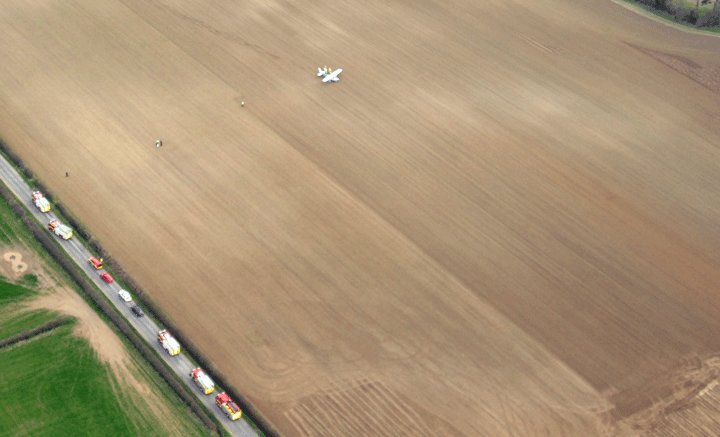 Several fields look OK, we turn downwind then come round for an approach in to what looks like a good into-wind long field. But I am still a bit high and out of my right window I can see just a tad further away a field that's not into wind but is invitingly long, so a careful turn, allowing the aircraft to descend in to the turn so as not to stall it, don't stretch the glide, then I've got acres of field in front of me, we're over the road and the last hedge, the speed is 60Kts so let it come down nice and gently, yoke back, look at the end of the field, yoke right back, squeeze as much speed as possible off, just before we touch the stall warner blasts and we touch.... touch.... and roll. No need for brakes, we'll stop soon enough, this is a ploughed field, keep the yoke all the way back to keep the load off the nosewheel, then we're slowing and..... we roll to a stop.
Several fields look OK, we turn downwind then come round for an approach in to what looks like a good into-wind long field. But I am still a bit high and out of my right window I can see just a tad further away a field that's not into wind but is invitingly long, so a careful turn, allowing the aircraft to descend in to the turn so as not to stall it, don't stretch the glide, then I've got acres of field in front of me, we're over the road and the last hedge, the speed is 60Kts so let it come down nice and gently, yoke back, look at the end of the field, yoke right back, squeeze as much speed as possible off, just before we touch the stall warner blasts and we touch.... touch.... and roll. No need for brakes, we'll stop soon enough, this is a ploughed field, keep the yoke all the way back to keep the load off the nosewheel, then we're slowing and..... we roll to a stop.
"Everyone out. Now."
We repair to a safe distance but nothing is alight, the aircraft is fine and it looks just as though we've popped in for a picnic.
So I go back, turn off the fuel and everything else I should have turned off before the landing (doh!), remember I should have used some flaps (too late now), and ring Oxford Tower to tell them we're OK.
Well: Thank You PFT for some damned good training.
The Fire Brigade turns up mob-handed 10 minutes later: we get 10 vehicles, which is impressive. They are a little disappointed we are the right way up and not smouldering, but in a nice way, and help us get out of the field. We even get the Police helicopter, who later send us some great aerial shots of our landing roll.
Local 21 Jun 13
It has been exactly 2 months since my visit to the field, and during that time the aircraft has been inspected in the field (we had had an engine fire), towed out by the farmer, stripped of its wings by AirMed and carried ingloriously back to Oxford on the back of a low-loader, had the carburettor repaired, a major Cessna wing spar inspection and a prop inspection resulting in 3 new prop blades. It is now repaired and polished, sitting on the grass and ready to fly once more.
Yes, I'm nervous, but I need to get back on the horse. Pete will come with me and we will go for a local flight together.
After a very thorough A check, especially of the fuel system (!) we start up. The serviced prop hub and new prop blades have been freshly balanced and the whole system feels smoother and quieter immediately. We backtrack 01, turn round and take off. I'm watching the ground for likely fields if anything happens but the engine is reassuringly smooth and powerful and before long we are heading North West for a quiet bimble around the countryside. This does feel OK after all.
After 40 minutes we head back and get a straight in approach for 19: we're a bit high and my approach is a little untidy but by the time we're fighting the lumps and bumps from the crosswind over the trees on Final we're in the right place and I drop it gently on with no drama and we roll out for a cold, well deserved beer.
I do now feel I have put the forced landing behind me, but it has been a salutary experience. We could all have died: in flames or by drowning. The old saying "there are old pilots and bold pilots but no old, bold pilots" is very true, and I shall certainly take even more care in future to ensure increased margins of error. I am beginning to understand incident pits.
Dunkeswell 17 Jul 13
We want to go to Dunkeswell for lunch, but the direct route is blocked by the most ridiculously huge Restricted Area caused by the International Air Tattoo at Fairford, which is happening this weekend but not, please note, today. So a few military planes will be arriving and taking off, but this apparently means a huge circular No Go Zone covering most of Oxfordshire and Wiltshire. Ludicrous.
We work out we have enough fuel, start up and depart South heading for Compton, climbing out over Oxford for 3,00ft and within a few minutes change to Brize to make absolutely sure they (as controlling Radio for Fairford) know where we are and where we're headed. We are not busting any Zones today.
Overhead Compton, as the DME drops to less than 1 mile and the needle starts to swing, we turn for Trowbridge and watch the DME start to climb again. Good practise.
Swap to Boscombe Down, then turn at Trowbridge, report abeam Frome and Boscombe swap us to Yeovilton who in turn swap us to Dunkeswell as we descend in to their circuit. At which point I have a brainstorm and misread their "08 right hand circuit" for a left hand circuit and go the wrong way around, whcih is pretty dumb, but I then compound it by fluffing the flare and bouncing sufficiently high to warrant a go-around, which may look like an intentional touch and go from the ground but isn't.... Come on Ballard, sort yourself out!
Eventually we settle in to a proper approach, a decent flare and a smooth arrival, but I haven't done that for a very long time. Need more practise, I think!
After a beautiful Brie baguette (you always get a good lunch at Dunkeswell) we re-dip the tanks (I'm paranoid about fuel) and the left tank is completely empty, so we know the dreaded Cessna 182 cross-feed issue still exists and taxy, leading the parachutists' aircraft out and backtracking short to allow them to pass - they need all the runway but we need about a third of it. One short-field take off later we're at 500ft before the end of the runway and climbing out straight ahead for Frome.
I never tire of looking at the patterns of human habitation on the ground from the air. You can tell a lot about an area from the air - mines, housing estates and railway junctions just look a lot more exciting from above.
Returning via Trowbridge Boscombe query us on our route back as there are many gilders on our planned route, and having explained our detour via Compton for RIAT reasons the helpful controller liaises with Brize to try to get us a more direct route back. He swaps us to Brize who unfortunately fail to pick up the ball to give us a route through the RA(T).

|
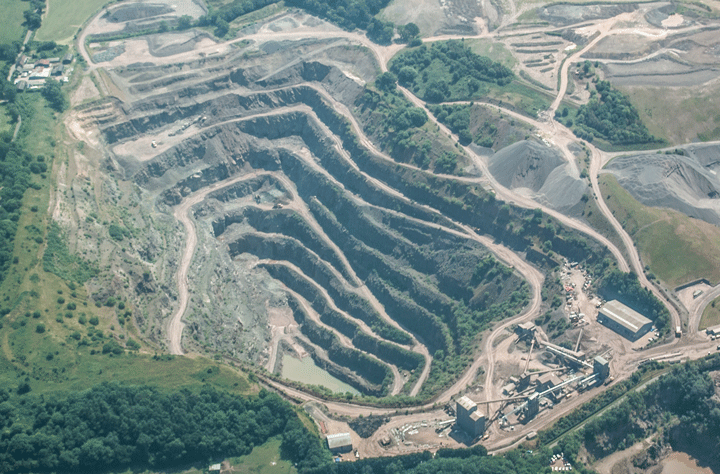
|
|---|---|

|
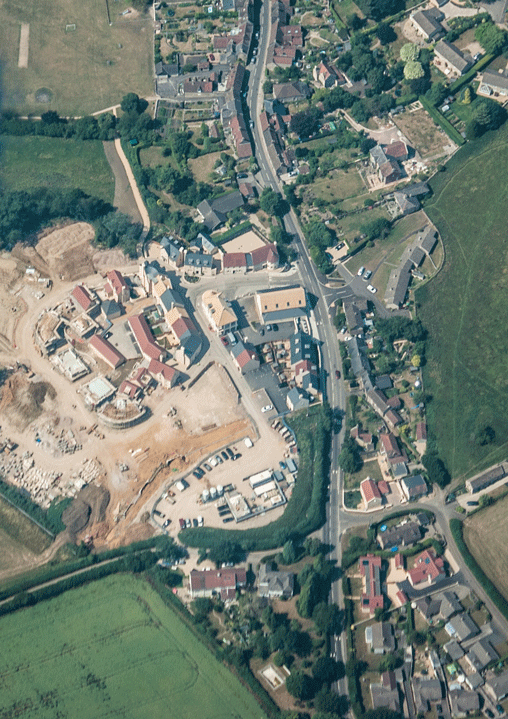
|
They simply advise us of multiple gliding contacts in our vicinity near Compton, but we only see one who is a fair way away.
Before long we are descending over the now de-commisioned cooling towers at Didcot and liaising with Oxford for a VFR recovery. They are too busy to take us so we have a bimble around Oxford at 2,000ft for a while then join right base for 01 and a considerably better approach and landing than at Dunkeswell.
Wellesbourne 6 Aug 13
There is no doubt that having to land the aircraft in the field has affected my confidence: it has left lingering doubts concerning my ability to fly safely longer-term. But more specifically it has affected my desire to fly at all, so I need to do something about it. The whole "confidence in your ability to fly safely" thing is very important.
We have a long-standing appointment to fly to Scotland this weekend and I'm dreading it - I keep thinking of things that could go wrong, especially visions of over-running the runway at Kingsmuir. Some medicine in the form of a really well-run trip is in order.
Wellesbourne do an "all you can eat" circuits landing fee during the week, so I will take advantage of that and bash some circuits specifically on my own so I can say that any mistakes I make are mine and mine alone.
Taking-off from Oxford is easy, but this is summer and as the thermals make the aircraft surge I am, for the first time in a very long time, a little frightened. What happens if the engine dies again? Or the wings fall off? I do need to work this through, most definitely...
Descending dead-side for Wellesbourne I join overhead the take-off numbers on 36 at a bumpy 1,000ft and turn in to the circuit, descend on Final and manage to use up almost the entire runway to land in. Is my eye not in or what? I'm ashamed of my landings, not for the first time.
Up to the tower to pay my "Super-size Me / all you can eat" landing fee, grab a couple of bottles of water as it's a hot day, and go circuit-bashing.
There is very little wind at all, and I think part of the problem is the aircraft floating in the flare. It just won't land where I want it to, and when I do touch it skips before settling. Adding power to take off we swerve about because I don't put enough rudder in, then manage to dump all the flaps at 300ft leaving me fighting to keep the aircraft in the air at all. Ugh, this is a mess, and why I came out on my own and to a foreign airfield so no one can see me.
After a couple of improving touch-and-go's and a long glug of water I decide to try some short-field landings with all the flap down instead and immediately it's better: I have more time on the approach, the aircraft will sink properly without huge manipulations of the throttle and it's flaring better. I actually do a couple of decent landings on the numbers (one actually on the run-up strip with the stall-warner blaring: wheee!) and handle the climb-out properly, so try going even lower and slower which works even better. Now I can reliably flare over the numbers, touch better (eyes DOWN the runway!) and roll out more smoothly. And most importantly, I am starting to enjoy it.
And indeed, by the last touch and go I am humming to myself again, we've beaten the beast in to submission once more and my confidence is back. I climb out, say goodbye to Wellesbourne, ride the bumpy thermals I now don't care about and turn for home where, because it's after 4.00pm everything is quieter and I can get a straight-in for 19 which I can do quite happily on the ILS at 120Kts as Oxford Radar will handle any opposing traffic. Steer left, steer left, cut the corner as it's coming-in, fly through it just a touch so come back on it, catch the glideslope from below, push a touch to follow the slope then trim, follow the ball down, report 4d and look up at 1,000ft.... ooh look, there's the runway with 2 whites and 2 reds. Change nothing, that's the rule if you're on course.
Flip the flaps all the way down, slow the aircraft to 65Kts, fight the thermals on the way down, flare on the numbers and arrive gently, kill the lift by flicking the flaps up, keep the speed up as there is another aircraft behind me and vacate at the end.
Well, that's much better. A trouble-free trip, I did nothing stupid and I am confident I can handle the various strips involved in the Scotland itinerary.
Kingsmuir - Fife - Glenforsa - Kingsmuir - Fife Aug 13
A few months ago we had a weekend in Blackpool and went up the famous tower. At the time I wondered what the tower would look like from the air, so today we will find out.
I'm keen to make everything in the aircraft work properly: I have rewired my GPS charger lead to stop it blowing the fag-lighter fuse, and at last it does work properly, but just at the point we think everything is perfect, the EGT gauge fails. Oh well, I'll just have to lean by ear, then.
There are a number of ways up to Scotland from Oxford that fall in to 3 categories: East coast, West coast, and today's choice of "up the middle". Most people don't go this way because there is a stupid little bit of low level Airway over The Penines between Leeds and Manchester left over from when airliners took an age to climb out from airports. A performance-based review of the climb out profiles of all airliners currently in use (currently in progress under the CAA's Future Airspace Project) should raise the floors of all these Airways drastically, but I digress.... it's a nice day, so we'll slip beneath it, or failing that get a Zone Transit through it. Going over may be a struggle in a C182, it goes up to FL195....
This works well (everywhere is deathly quiet, it being a Friday in August) and we get a close-up vew of the Manchester/Liverpool water storage project that is The Penines. Every valley is dammed (damned?) and some are looking a little empty. Liverpudlians, lay off the baths!
Before long we cross the M62, then suddenly we are North of the Manchester Zone and turning West for Warton. A little negotiation with Warton and then with Blackpool Approach, who need to coordinate the arrival of a BAE146, gets us clearance to proceed to the Pleasure beach at 1000ft, then down the front at 500ft. The tower is 518ft tall and as long as we stay 1000ft away we can quite legally (and safely: engine failure means we just land on the beach...) trundle up the front at 90Kts below the top of the tower.
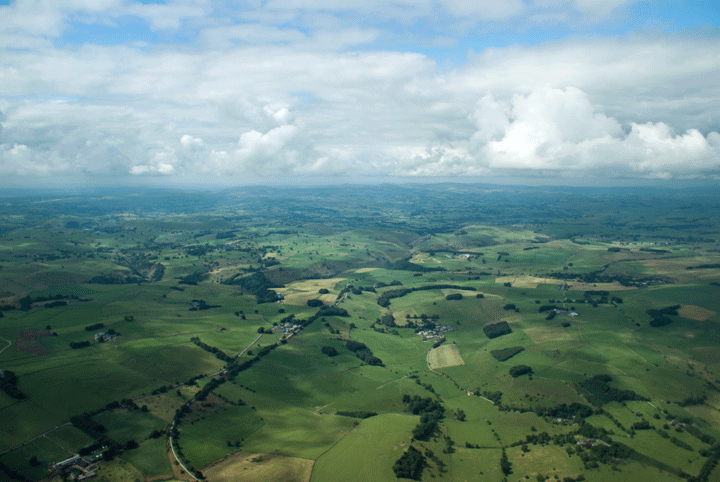
|
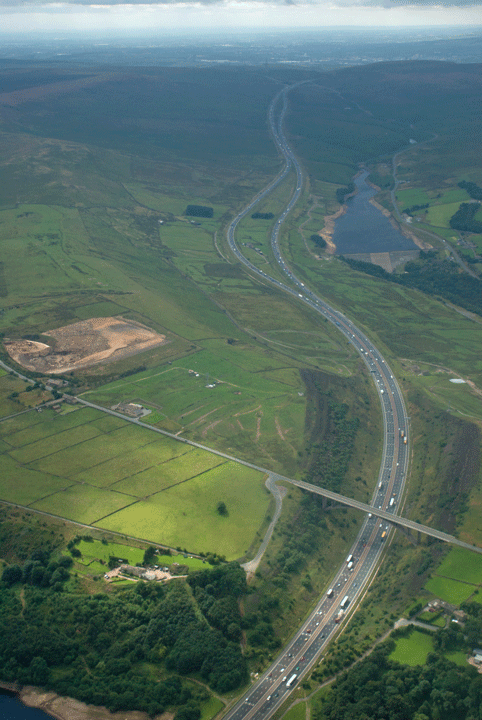
|
|---|---|
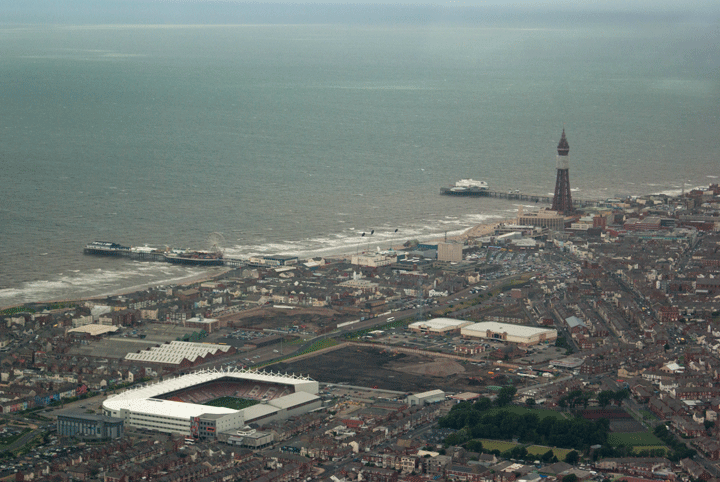
|
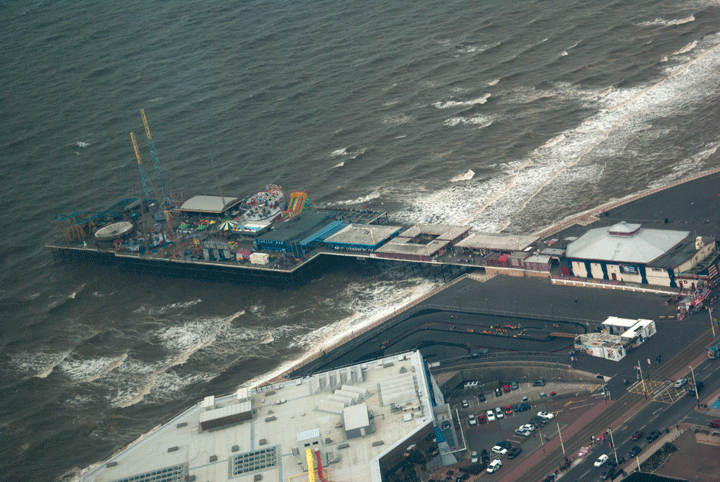
|
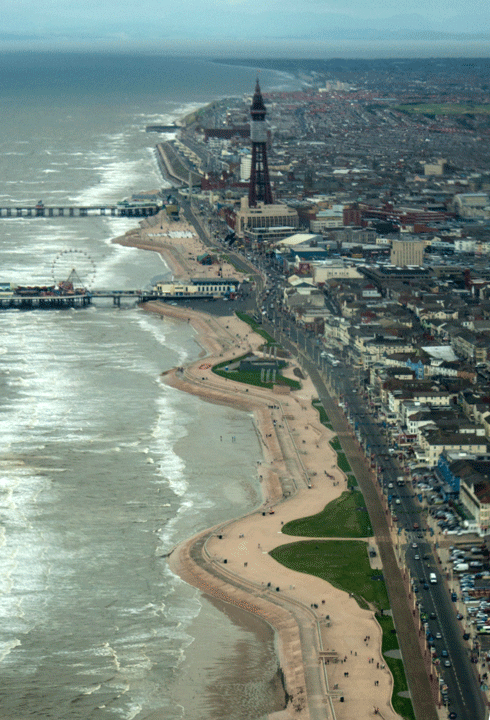
|
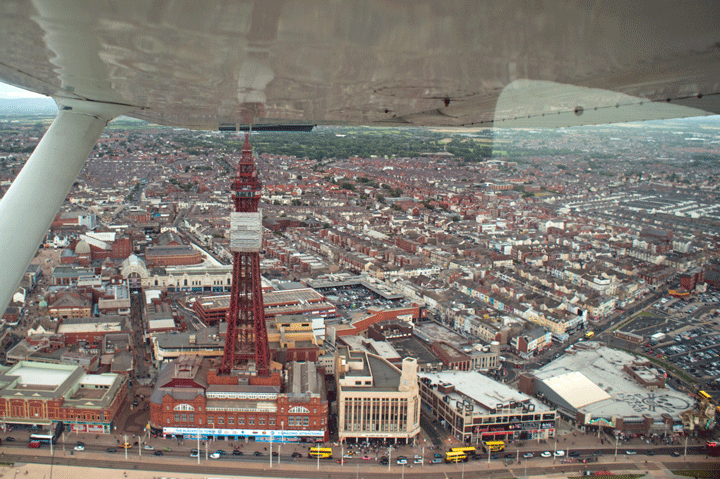
|
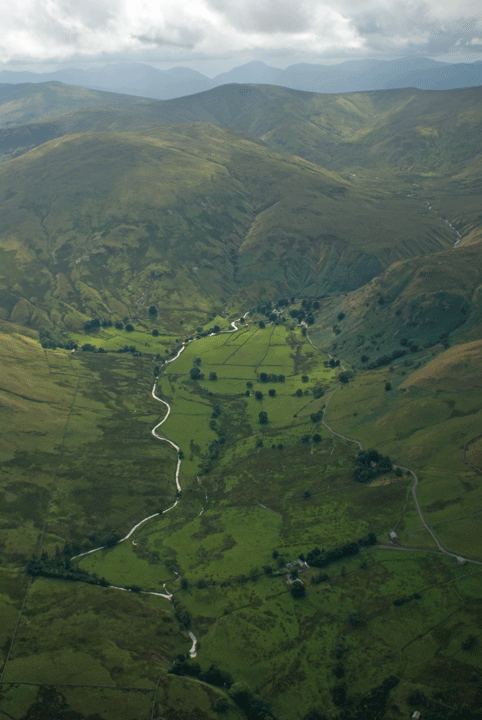
|

|
Climb out and accelerate away over Fleetwood humming the bass line from "The Chain" (Fleetwood Mac, you see. Well, you need to be a child of the '70s....), then North over Morecambe Bay and follow the M6 up to Tebay, where a relative builds European-spec Airstream caravans, for some photos.
I'd like to see what the Lake District looks like from the air, so we turn West and head for Keswick, where the hills are big (and have their heads in the cloud) and the lakes are picturesque. It doesn't look it, but North West Cumbria is one of the most economically-deprived areas in the UK.
Heading North East London Info swap us to Scottish Info, who monitor us as we climb up to Galashiels and round the corner of the Edinburgh Zone for North Berwick. The sky is empty but for us and a Spitfire, and as we head East the weather brightens until we are in sunshine as we near the coast, swap to Leuchars for a LARS service over the Forth, coast out over North Berwick, and begin our descent.
As we have been in to Kingsmuir before I think we can get away without a low pass, so we'll join left base and drop down over the fields, slow it down and flare over the boundary, hold it off, touch... and bloody well bounce before it settles and we stop having used less than half of the grass runway.
Backtrack and park up, and that's Scotland.
One of the reasons for this Scottish trip was to do some exploring in the Highlands, but I am very aware that this is potentially dangerous in terms of us flying in to a mountainside, so have spent a lot of time researching how to do this safely. The considered opinion seems to be:
- You must remain VMC (but see below)
- You must retain 1000ft horizontal and 500ft vertical clearance
- Take a terrain-aware GPS and use it
- Fly on one side of the valley to allow yourself room to turn around if you have to
- Fly slowly to reduce the turn radius, and don't be afraid to drop a stage of flap to reduce the stall speed for added safety
- In the event of the weather worsening to the point where you are liable to go IMC, turn to a heading where the ground is descending and perform a max rate IMC climb to above MSA, then reconsider.
We have a plan that has involved a lot of drawing of lines on my big CAA Scottish map: we'll do some photography over St Andrews, go to Fife for petrol, head West through the glens to Oban, turn right and go up the Great Glen over Loch Lochy and Loch Ness towards Inverness, then left up in to The Highlands and across to the isle of Skye, then down the coast to Mull for lunch at the Glenforsa Hotel. Should be fun...
I have some concerns about the weather: the West coast weather can be very different from the East coast, and although the forecast is for light scattered showers, I know this can change. If we are going to go genuine IMC in rain I don't want to be below MSA: there are big lumps of Cumulus Graniticus out there that can ruin your entire day.
Scotland is windy and today is no exception. The windsock at Kingsmuir is out straight and the winds at Fife are forecast 18G25Kts, but straight down the runway. We phone Leuchars and ask for permission to enter their ATZ and wing around St Andrews for a while: the last time we came up they were too busy but this morning they are happy for us to intrude, so we load up with 4 adults, power-check in the parking slot, swing out on to the runway and accelerate in to wind.
To say we use half the runway to take-off would be an exaggeration: we are off the ground in probably 200m with 20° flap, way above the trees and within seconds can see the whole of the East Neuk of Fife and St Andrews, so we level out at 500ft, contact Leuchars and swing in to St Andrews, covering the distance that takes 20 minutes by car in 2-3 minutes.
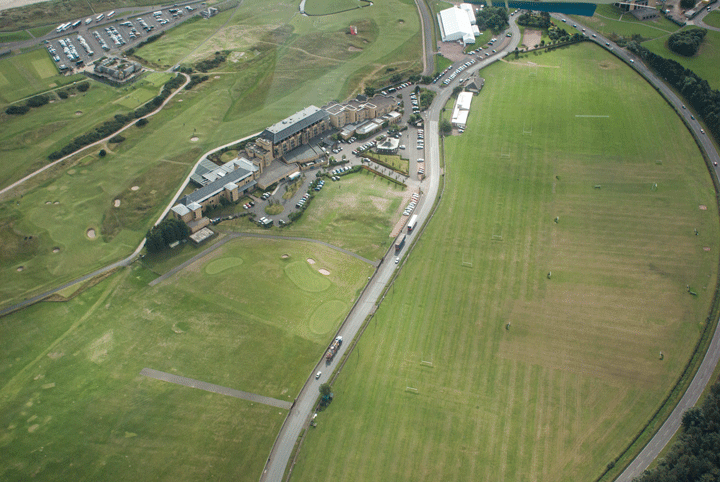
|
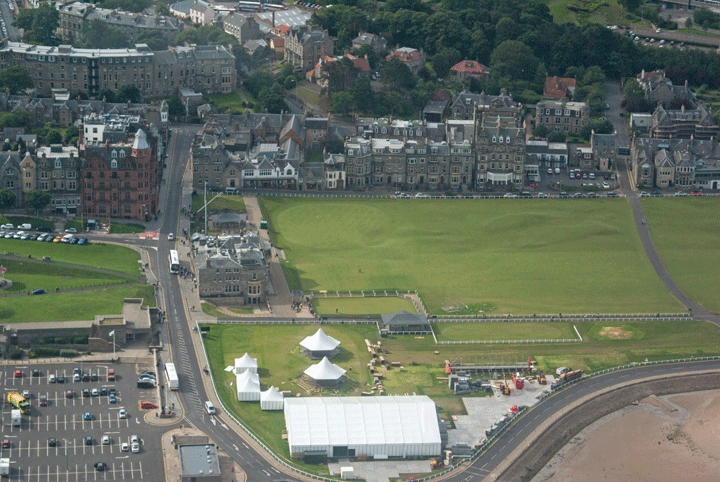
|
|---|---|

|
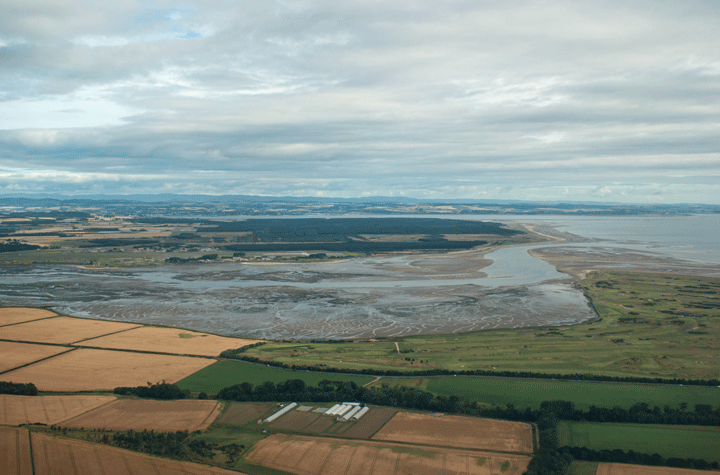
|
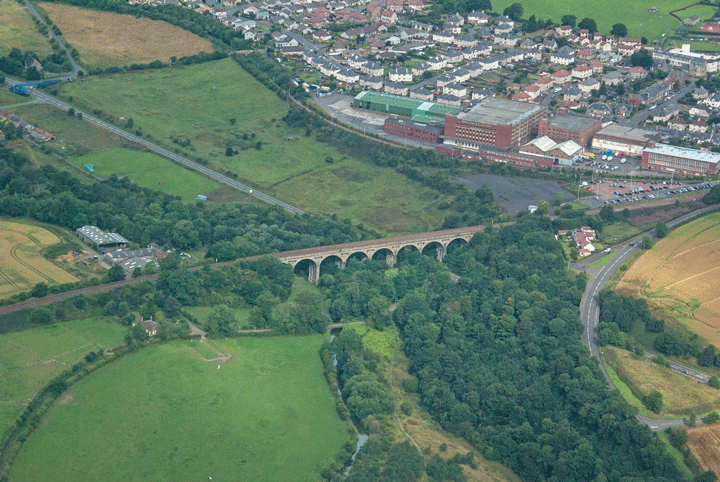
|

|
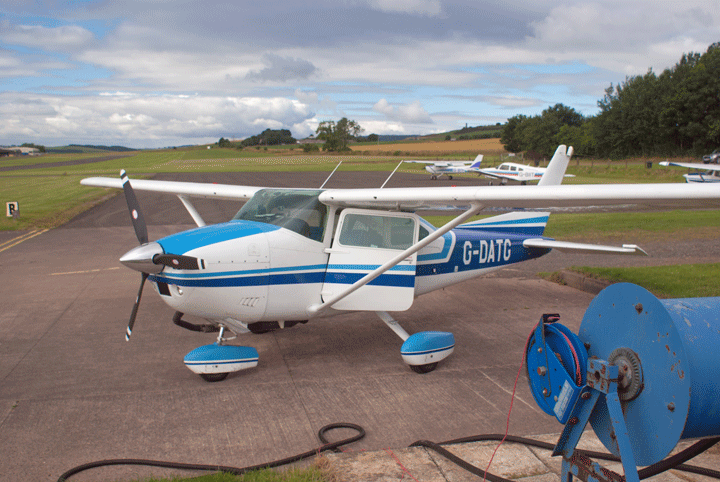
|
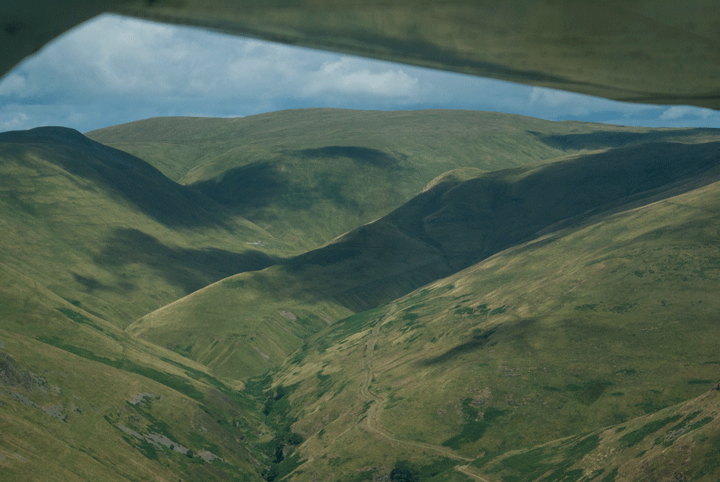
|
The world looks so small from 1000ft: what can take 30 minutes by country road can be seen immediately and flown to in 5 minutes. It quite distorts your mental view of the country.
The Royal and Ancient Golf Club of St Andrews glistens in the morning sunshine and everyone looks up as we circle at 1,000ft.
Then we depart Westbound for Fife, who state "Strict PPR" on their airfield information because you can't do a straight-in approach over Glenrothes for their runway 25: instead the most fun approach in the world is a curved approach over the golf course. Hard to judge well and it's bumpy but for once the Landing Gods favour us and I drop it on the numbers and roll out, barely having to backtrack for the exit to the pumps.
Just as well, because the owner of a beautiful Tiger Moth is also at the pumps watching. He has flown it to Australia in the past and has just brought it back from Sebastopol and is going flying (if they have any AvGas left after filling up a very thirsty C182). While the kind pumpmeister fills TG up we watch a PA28 float all the way down the runway, only touching down in the last third before heavy braking and backtracking. We've all done it....
We watch The Moth depart with a little jealousy, but a C182 is a more capable beast for where we're going. He's impressed we're off up The Great Glen, and reckons it should be fun.
A heavy bit of Visa card-bending later we're lined-up. Nessa reckons it looks short, but although we are 4-up with full-tanks and thus a few lbs over MAUW we have a 25Kt headwind and we're off by half-way down the runway and at 300ft by the end of he tarmac, climbing out over the wind farm and Loch Leven.
As we head West the landscape becomes wilder and greener, and soon we are weaving in and out of the glens. The valleys narrow as we head for Oban and we climb to maintain terrain clearance, then pop over the top and down Loch Awe and Loch Etive for Oban, the weather worsening as we go until we are in rain showers as we pass through Oban's ATZ and turn North for Loch Linhe and Fort William.

|
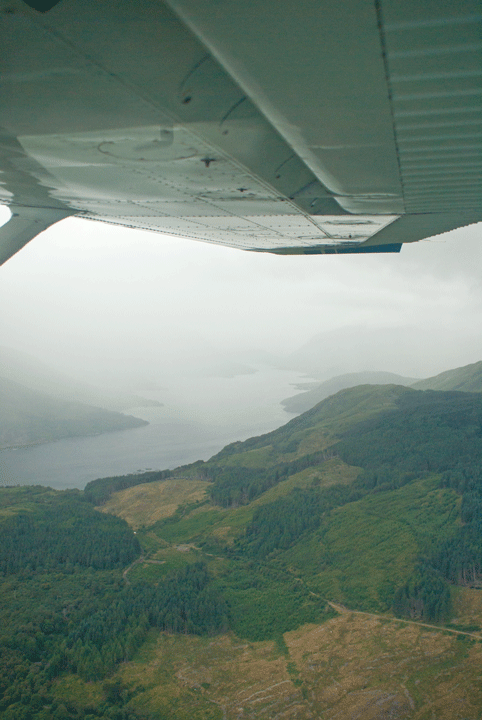
|
|---|---|
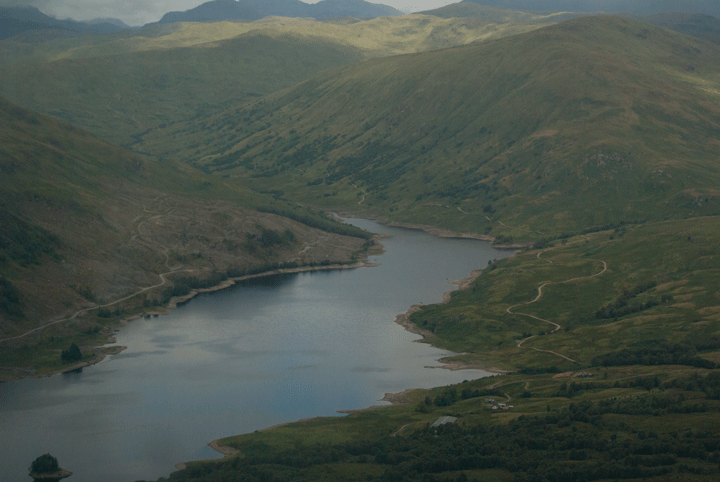
|
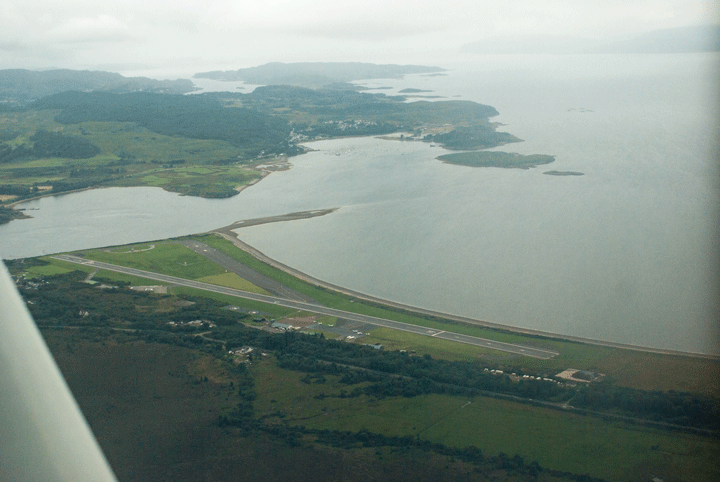
|
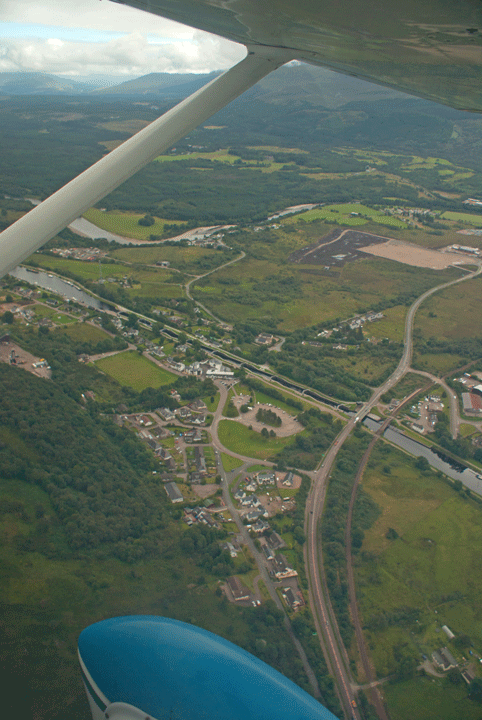
|

|

|

|
We descend to 1,000ft over the water, and the weather improves as we pass over the Caledonian Canal, which is surprisingly big, and up in to Loch Lochy, then further up to Loch Ness. This is worth seeing, and there is no other traffic at all.
There are boats on the Lochs and slow caravans and coaches wending their way along the undeveloped roads; we are definitely having the best experience.
As we approach Inverness we climb out of the trough and head North, then West for The Highlands, losing radio coverage from Scottish Info as we do so. The ground gets higher and more remote, the hills bigger and the glens bigger, which makes flying easier. We fly over increasingly rugged terrain and the weather worsens as the valley widens down towards Skye until we are intermittently IMC in showers.
At one point we go the wrong way up a valley and have to turn around, so I get right over to one side, then slow to 90Kts and go round gently, resisting the urge to tighten the turn as the valley walls loom up, but we're round with miles to spare.
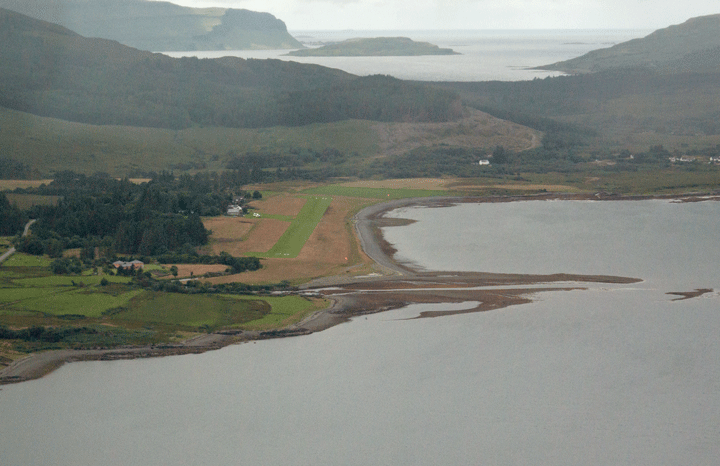
As we coast out past the Skye bridge and Plockton airfield the weather goes really yuck and we decide to go South, but that's completely IMC so we'll go for max climb and check, check, check the map and the terrain clearance on the GPS until we absolutely know we are once more over the sea and drop back down through a hole. From there it is rain showers and sunshine all the way down the coast to Tobermory for a right base join for Glenforsa, where we touch smoothly down on the grass just 10 minutes late for lunch.
And the lunch at The Glenforsa Hotel is worth flying in for!
The kind man who runs the strip at Glenforsa has parked us on a slight nose-down slope and when I dip the oil before starting for home instead of reading 9 Quarts it reads....6. The question is: has it used 3 Quarts of oil in 2hrs? If it has, we have a Big Problem.
A call to the maintainers is no use: they are closed for the weekend. A call to the Chief Engineer at Cumbernauld, however, confirms my suspicions that if we park it on the flat and leave it for 30 mins it will return to normal, so we do, and we also add a can of W80 oil for good measure. He has some spare cans and won't take any money for them: now that's real service.
We take-off and swing around the East end of Mull to photograph Lochbuie where friends of Nessa's uncle live. I'm watching the oil pressure gauge like a hawk: if it drops appreciably below the half way mark I can still glide back in to Glenforsa from here or put it on the beach at Lochbuie. But no, it's OK.
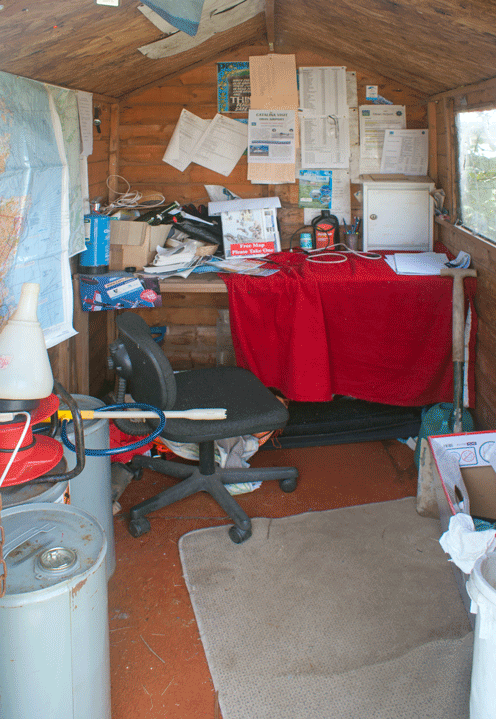
|

|
|---|---|
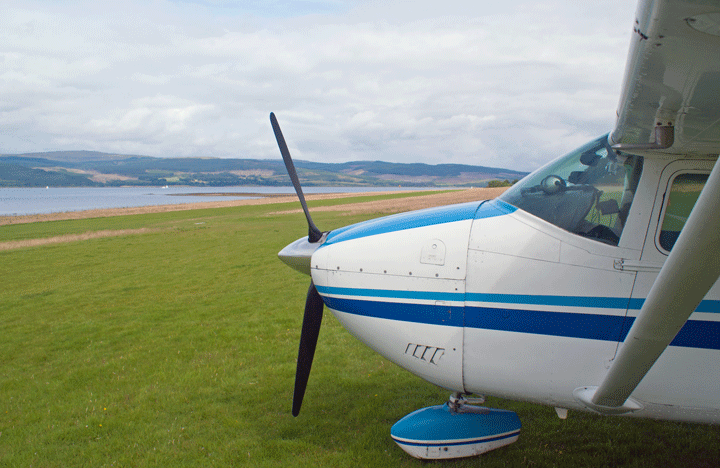
|
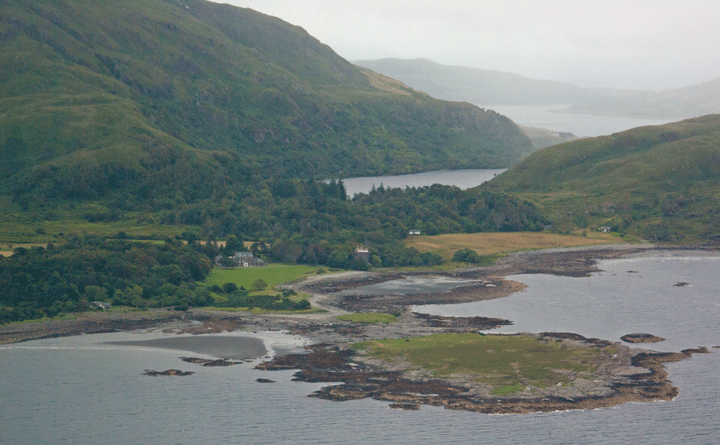
|
The weather has closed in now and a VFR run back up to Oban is looking increasingly uncertain so we'll take the IMC option and punch up through to fly back on top, so point the aircraft out to sea and pull up for a maximum rate climb in to the clouds.
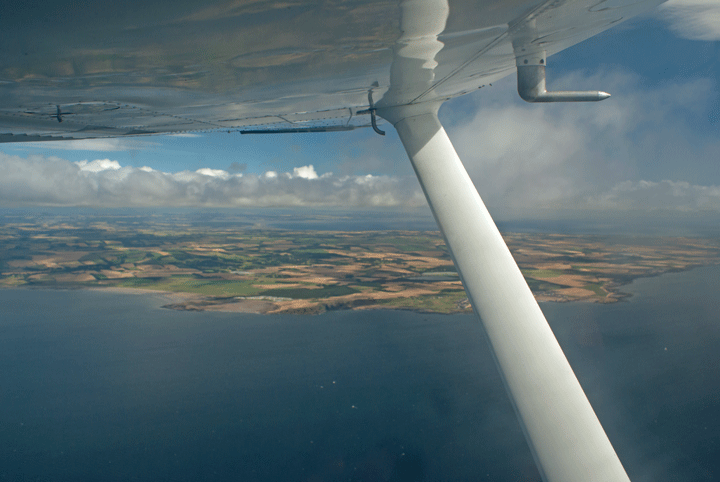 Once we are above MSA we turn Rate 1 back inland and head East; we don't clear the clouds until 8,000ft then climb to 8,500ft to stay VMC on top. Freezing level is FL90 or above today, so this is not a problem and before long we start seeing holes in the cover so we find a large enough one and drop back down towards the Firth of Forth and home.
Once we are above MSA we turn Rate 1 back inland and head East; we don't clear the clouds until 8,000ft then climb to 8,500ft to stay VMC on top. Freezing level is FL90 or above today, so this is not a problem and before long we start seeing holes in the cover so we find a large enough one and drop back down towards the Firth of Forth and home.
Join downind for 24 at Kingsmuir and concentrate on coming in slow and cautious, but we still bounce a bit on the grass, damn it!
Sunday dawns bright and clear, with little fluffy white clouds scudding across the sky. Huh, scudding? Yes, Scottish winds are once again forecast to be 18G25Kt at Fife.
Once more, no one is about as we say our goodbyes and take off in to the stiff headwind, with just 2 up we are off in 100m.
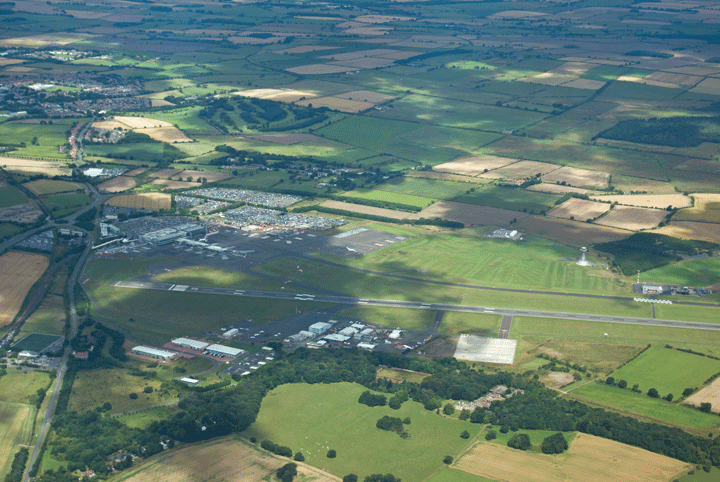 Descending on to the curved approach at Fife we are getting really chucked about by the wind but we just bring it in with 20° flap, get it low and slow and the pre-stall airframe whistle begins as we flare over the numbers and touch with no tremble and no squeak, and without any brakes the headwind slows us so we can easily turn off on to the taxyway 1/3rd of the way down the runway. I have surprised even myself.
Descending on to the curved approach at Fife we are getting really chucked about by the wind but we just bring it in with 20° flap, get it low and slow and the pre-stall airframe whistle begins as we flare over the numbers and touch with no tremble and no squeak, and without any brakes the headwind slows us so we can easily turn off on to the taxyway 1/3rd of the way down the runway. I have surprised even myself.
The nice fuel man is even surprised: they are having a jumble sale in aid of a local charity and many, many people are watching, they all expected fun and games in the wind but were disappointed.
We have plotted the shortest possible route home as we don't want to hang about, so take off and head out over the Firth of Forth Southbound, climbing over the smooth water to 4,000ft.
There is a slight fuel smell but I am hoping this is just because some of the fuel got spilled over the wings in the high winds at Fife, and indeed it does calm down as we head South over Newcastle, Durham Tees Valley and Doncaster to Melton Mowbray and Daventry, then descend East of Oxford to avoid gliders at Bicester and parachutists at Weston on the Green and join downwind for 01RH, slide down the approach and flare.
Just as we sink a gust catches the left wing and makes it all look untidy, which is a shame as it was all going so well! You're only as good as your last landing.

We have been followed all the way down by G-ELDR, the Cherokee Six, who has been to Dundee, and I'm a little surprised he didn't overtake us, as he can cruise at 140Kts, but maybe he was just bumbling down at 125Kts like us.
So what did we learn from flying in the Highlands?
Scottish Info radio coverage is patchy and you will be out of their area for long periods: keep them updated when you can of your position and intentions; don't wait for them to ask you.
You need an IMC or you will get stranded if the weather changes.
The weather can be very different on the two coasts, which are not very far apart, and is usually not as forecast.
Even professional pilots fly in to mountainsides in bad weather.
The remoteness, patchy radio coverage, weather and terrain makes for danger, so plan carefully and don't be afraid to turn around. But don't let that prevent you from going - the scenery is worth it.
Local 18 Aug 13
There are many staff at Oxford (and indeed at all airfields) who have to work all day and every day seeing lucky people like us jump in to the very aircraft they have serviced, performed Fire cover for, spoken to on the radio from the Tower, mowed the grass for or driven baggage to, and jet off to sunnier climes or even just over the horizon.
Every day they have wondered what it would be like to actually be in one of those aircraft looking down at the airport from above, and once a year us pilots with aircraft based at Oxford get the chance to thank them by giving them a joyride.
This is an event that has been consistently cancelled because of weather, but this year the weather Gods have smiled upon us and it's a beautiful, if blustery, day in August, with a barbecue; happy, excited families and genial pilots showing-off.
My first couple (David and Amanda) are keen as mustard so I don the Hi-Viz of Authority and load them up.
It's important to do the "Captain Speaking" bit, sound and act confident, and ensure they have sick bags to hand.
I'll explain what I'm doing and be up front about the "this will turn like a motorbike, not like a car" issue, so they don't scream the first time I drop a wing.
We depart South for Oxford, climb to 2,000ft and head for Abingdon, then Didcot. They ask if it's OK to take pictures.
OK? No, it's obligatory!
Before long we recover back to Oxford, getting very visual with a departing PA-28 climbing out on a reciprocal to us, and as they live in Kidlington I want them to see their house, but they live too close to the airport to stretch my Downwind leg to, although we get pretty close, then it's turn on to Final and fight the lumpy thermals all the way down to the runway.
Flare, and even with crab and a bit of wing-down it's a bit untidy. Roll out, back to the apron, and they've had a great time and are keen to go again, so that's OK.
 It never ceases to amaze me how the airport can be quiet one minute, then absolute pandemonium the next. There are 4 of us ferrying families around and this time I have a frightened 10-year old boy in the P2 seat who has been persuaded to come by his uncle, who is in the back with his Grandfather.
It never ceases to amaze me how the airport can be quiet one minute, then absolute pandemonium the next. There are 4 of us ferrying families around and this time I have a frightened 10-year old boy in the P2 seat who has been persuaded to come by his uncle, who is in the back with his Grandfather.
We get up to the Hold and have to wait first for a departing business jet with a posey callsign of "ThunderCat 6" or something....
I'm going to dream up a callsign like that: I'll be "ScaredyPilot 1", I think....
Then a business jet comes down the ILS and at 4 miles a PPL in a PFT PA-28-180 jumps in front of him and calls Final. The Tower gets more irate than I've heard them before (quite understandably) and tells him in no uncertain terms to get lost, so they go around right over our heads. Honestly, amateurs...
After the (normal callsign, no personalised plates and furry dice) business jet lands we get to line-up. I want to do a right turn out but the controller is getting irate about the number of aircraft making non-standard joins over Blenheim Palace, so we'll go out the other way East of Weston-On-The-Green as these guys live West of Banbury.
Departing the melange we climb over Bicester, avoiding the glider launching, and head North. Henry gets a chance to fly the plane, which concentrates his mind on something other than being sick, and he's pretty good; soon we are climbing and descending and his smile is getting broader. One for PFT in a few years, then...
We go in search of their village, which happens to be close to Shennington, where half the word's entire supply of GRP sailplanes have been launched in to our path. We're bigger, but they have right of way, so we stay as clear as we can and soon I can tip it over on to a wingtip to circle their house. Even this doesn't faze Henry, so I get him to fly us back to Banbury and line us up for the ILS. The runway is visible easily from here, so we call in, expecting circuitous routing, but it turns out we are the only traffic in their entire zone at present. Where did everyone go?
More fighting the thermals, right down to the fence, but I'm wise to its tricks now and keep a bit more wing-down right in to the flare, arriving gently and even on the centre-line. Roll out and park up, ready for Steve to take the next family. Apparently Henry's Mother isn't allowed to know he's been up, but I suspect seeing the smile on his face and the number of photos they took, this isn't a secret that is going to be kept that way for long.
Local 21 Aug 13
Oxford is one of the most beautiful cities to fly over, partially because it's so small and partly because the University has mandated a homogeneity of style and materials that dominates the look of the city from the air.
Our dear friend Stephanie has come to stay, and we can surprise her with an evening jaunt over the city. One of the (many) advantages of a shared aircraft is the freedom to fly at very short notice: we suggest the flight at 6.00pm (she didn't even know I knew how to fly) and are down at the airport, covers off, "A"- checked, started up and taxying within the hour.

At this time of night the airfield and the sky are deserted: most airfields shut at 5.30pm or 6.00pm so there are few places to fly to, but Oxford staying open until 10.30pm is a huge bonus: we could fly to Wales and back tonight.
Also, being evening, there are few thermals and the air feels like smooth water. there are definitely parallels between the way aircraft and boats move through their own medium, and at this time of night it's like rowing a boat down a smooth stream, the hiss of the airflow changing with every control variation.
Quite mesmerising, actually.
Stephanie has a little glider experience but no powered aircraft experience, and studied at Oxford, so the view of the Oxford colleges from 1,000ft brings back memories: the evening sunlight glints on the limestone. But then, many cities look better from above: even Newcastle (which Simon Evans refers to as "well, rubble is rubble...") looks appealing from the air.
We head out over Abingdon and circle the house, then circle our friends' house and get them to come out and wave to us before heading over the (soon to be destroyed) Didcot power station cooling towers for a look, then back to Oxford.
Another Tango Golf is asking for a Transit through the overhead, so it's full call-signs as we settle in to a Downwind Join for 19, pop the flaps and turn Final, get a bit of twitch over the fence, then settle for a slightly springy arrival (what is it with landing on long runways at the moment? I keep doing a little bounce whenever I land. Short-field stuff is OK, though. Very annoying).
Shoreham 6 Oct 13
We will take our friends James and Annabel down to a party near Worthing today: it's a lot quicker than driving, and far more fun.
It is forecast to be sunny all day, but as I drive down the Cumnor bypass to get the plane ready I can see the whole of Oxford is swathed in thick, white fog. This will eventually clear, but by when?
When I arrive at Kidlington you can't see the runway at all, and I am the only one (idiot?) there. I'd like to do a quick circuit but in reality I'll be lucky to get out on time, let alone have the luxury of a circuit.
So a really good A check, then taxy to the pumps (which the Tower misconstrues as a request to depart. Come on guys, not even I would do that...) for fuel, and by the time I've taxyed back to the main apron and picked up my pax it is clearing and we can depart South, seeing diminishing pools of mist below us as the sun dries it up. It is due to come back tonight, but not until 9.00pm or later. I don't believe this, so I've got an extra 1hr of fuel on board for a couple of missed approaches and a last resort divert to Brize. Well, you never know.
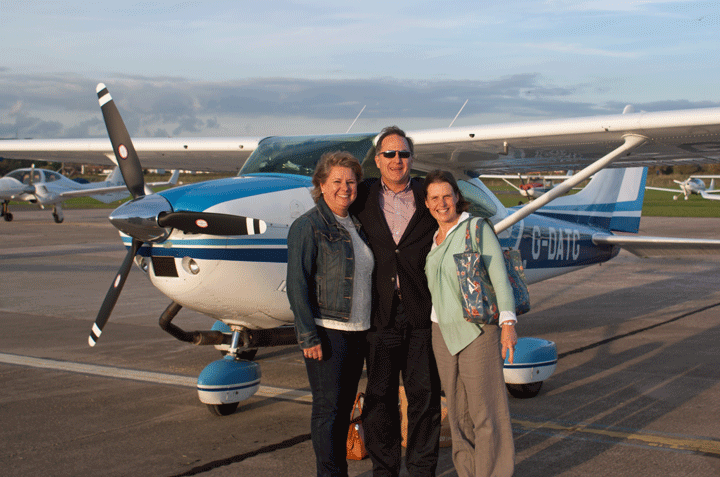
It's really smooth up here, but we're a bit late so we'll take the most direct route possible: CPT - MID - Shoreham. This is virtually a straight line but we must go through Odiham's MATZ and under the London TMA, so must be accurate in navigation and height holding. Annabel is also a first time flyer, so The Full Airliner Experience is required, sick bag and all.
We approach Shoreham and descend for a crosswind join for 20, where we descend almost to the level of the hills before the ground drops away and you have to fight to descend in time for the runway. We arrive at the threshold on speed and in the right place, but bounce it a little on arrival. I thnk I've worked out what's going on: I am not keeping my concentration on the end of the runway, but allowing it to come back to the runway just in front of the aircraft during the flare, and losing my reference point.
Roll out, taxy in, park up and leap out to pick up our lift: we're late, so we'll do the Landing Fee later.
A damned good 21st party later we're on the way home. Pay the landing fee and dip the fuel tanks. And what have we here? A fuel cap off and a-dangling? How long has that been like that, then? Did I not quite tighten it when I fuelled? Or did I simply leave it off? Ouch.
The sun is low in the sky as we taxy out following a slow and cautious Cirrus that takes ages to power-check. Unlike Oxford where the power check areas allow overtaking, here everything is narrow and we must wait.
This runway always looks short to me. We're heavy: close to MAUW, and it's warm. But we are at sea level +6ft. I think a short-field take-off is required, so 20° flap and we're away having used only 1/3rd of the runway. What was I worried about? Right turn out over the sea, fly along the coast for a bit, swap back to Farnborough Radar and concentrate on maintaining 2300ft under the London TMA. Farnborough seem quite worried about this; they didn't care at all on the way down, but now they keep questioning it. Weird.
Another Odiham MATZ Transit, avoid the ATZ and pop out over Aldermaston heading for Compton. And the sun is descending, leaving the land dark. A quirk of the dewpoint has any bonfire or chimney smoke rising, then following the ground in long, ghostly trails in the direction of the wind at what seems like ground level and must be very low. Quite beautiful, and a phenomenon I have never seen before.
Back to Oxford Radar overhead Didcot and a long, slow descent to circuit height over Kidlington, report Downwind and no2 to a DA40 who I just can't seem to see until he turns Final and looks a bit too close for comfort. I'll slow down a bit and get a land after. There is so little wind that if I can't do a perfect landing this time I should probably give up. So really concentrate on the end of the runway and squeeze that last little bit of vertical speed out of the last foot.
And that's the way you do it: an imperceptible arrival.
Taxy in, and pack the aircraft away as the sun goes down. Annabel says she loved it, so it can't have been all that bad...
Local 2 Nov 13
The Met Office has generated a strong wind warning, but is for wind straight down the runway, so whilst it might be rough on climb out and approach we can land it back OK. I want to take Alice's boyfriend Kieran out as the last time I flew him we ended up in a field with a dead engine, and Lucy's new boyfriend wants to have a go at flying. A Saturday morning weather window has the clouds clearing and a couple of hours before the strong wind swings round, so we'll go out.
Having a share-o-plane has to be the most convenient way of doing light aviation, as we can fly or not fly at a moment's Notice, and the costs are under control, but I never lose sight of the fact that it is a tremendous privilege to be able to fly literally anywhere pretty much on a whim, really. Yes, there is a fair amount of responsibility involved, but carefully planned it need not be overly dangerous or costly.

|

|
|---|---|

|
|
My friend Simon has an iPad Mini with Airbox Panda on it (a souped-up version of Airbox Runway HD) and it's even better than SkyDemon: it has proper CAA charts. I can feel my head beginning to turn.... All it needs is geo-referenced IFR appoach charts and it would be a serious contender.
The strong wind warning has emptied the skies this morning, so when we depart the radio is dead but for us. It's very bright but a bit rough as we swing across North Oxford, then down past the Kassam Stadium and across to Abingdon, where the little Abingdon planes are flying (they are keen, these boys!), watching one of them land crabbed like crazy (I'll bet that was interesting: these are tailwheel Grobs), round their ATZ for a low flypast round the house, over to Wantage for some photos, then climb past the little fluffy clouds for some smoother air over Didcot.
3,500ft sees us in smooth-as-silk air so Tom can fly it for a while, which he is very good at (maybe I can persuade him to do this, rather than football....), and then we return back North towards Oxford, descend through a few fluffy cloudlets and roll out Downwind for 19, which with a 30Kt tailwind is a blur of BUMMFTCH then turn before we fly in to Weston's Active Danger Area, slow and pop the flaps, roll Final and battle the lumps 'n bumps down to flare height, then concentrate on focusing on the end of the runway, which results in a very smooth and short arrival in a 19Kt headwind. Mmmmmm.... Nice.
Local 12 Nov 13
As the nights are drawing in and we may go to France soon Steve, Willie and I all need Night Currency.
The rules state that you can fly yourself, or another PPL at night quite happily without having performed a night landing to a full stop within the last 90 days, but for taking passengers you must have P1 a night landing to a full stop under your belt in the last 90 days. Fair enough: it's a physical skill that deteriorates like any other.
It's a beautiful cold, still November evening as we start up. I'm sitting in the back warm and cocooned amongst cushions and flight bags, Steve will fly a Night 100 Procedure and Steve will do the radio. This goes fine, except for a small confusion about levels and heights which is a normal part of rust removal and why we do these flights, but it's interesting to watch Steve use the ADF: he's an ex-BA pilot with an IR so what he doesn't know about ADF's isn't worth knowing. He never touches the ADF dial: he just flies his compass accurately and pushes the head/pulls the tail by eye. Nice, and worth emulating. What is apparent is that the wet compass drifts around aimlessly, the DI drifts badly and the only compass worth using is the GPS compass. But then you may as well draw the OBS line on the GPS and fly that, which in real life you would do.
From here I can see fire engines convergnig on what must be a house fire in Kidlington. We could orbit overhead and report for Radio Oxford: "Just here in The Flying Eye, and I can see some congestion on Kidlington Road..."
It's 6.30pm but Oxford Approach/Tower is shatteringly busy with business jets, OAA props, IFR and VFR traffic, helicopters and us all trying to gain our share of the ATCO's time for take-off, landing or runway inspections. That's a sign of a healthy, thriving airport.
After a low-level circuit with some surprising drift at 800ft Steve does a passable night landing and we taxy in. What quickly becomes apparent is that you really need both Taxy and landing light on to see adequately, so we alter our SOPs to this. Much better.
Now I will do the radio, Steve will sit in the back and Willie will fly us VFR for a while. But as he rotates he starts to drift left. At first I think it is intentional, but it turns out he lost spatial orientation at that moment, quite common at night: I tend to do the first 100ft on the AH instead until the lights below re-appear. A night IMC take-off would be interesting, but we're not going there tonight...
We fly out over Banbury and it's so smooth it feels like we are suspended by a string from the heavens. The ANR headphones help, but the lack of thermals give an unreal feel, like we're in a flight sim and actually sitting at a desk, not blatting along at 125Kts. Very soothing.
We return via a VFR Downwind join, and Willie lets the height decay until we are less then 800ft QNH (so 600ft AGL), which at night is not ideal. We all know each other well enough to know that helpful suggestions have no hidden agenda, so a quiet suggestion gets him back to 900ft by the time we turn Base, which we're all happier with. Again that surprising drift on Final, then he drops it in on one wheel; I think we caught a gust, a lot of nosewheel shimmy and we're vacating the runway.
One crew change later, Steve has retired with a bad back and it's me for a Night Currency with Willie doing the radio. We depart to the South over Oxford and go looking for our house (which we fail to find in the dark...), loop back for a right base join, which I manage to fly too high (still, better to err on the non-hard ground side), pull the power right off to correct, then slot back in to the "I can land it from here" approach cone. And a reasonable night landing ensues, but it's not until we vacate that I remember we hadn't turned on the landing or taxy lights. Goes to show they aren't necessary, anyway... Your focus should be on the end of the runway during the flare, but I suppose if something was on the runway right in front of you, you wouldn't see it. I probably wouldn't see it anyway: too busy concentrating...
Willie whizzes off to a dinner appointment and I put Tango Golf to bed. I quite enjoy tucking the aircraft up at night when there's no howling gale to fight. A final check: Power OFF, Fuel OFF, Brakes OFF and it's time to wander in out of the increasingly cold evening.
Local 31 Dec 13
New Years Eve: can we fit just one more flight in to 2013?
We have been washing and reproofing the cover so need to put it back on. The weather has been pretty awful, but while we're there the wind drops, the sun comes out and it looks so nice we might as well just go out for an hour and photograph Kieran's uncle's house near Reading. Too good a chance to miss.
Fill up with half-tanks fuel, depart SE down the M40 and follow the Chiltern Hills South towards Henley and Reading. Benson are inactive so we'll swap to Farnborough West who are virtually empty instead. Playhatch is hard to find, even with a GPS, and it takes us a couple of goes around to find it, but eventually we do and they come out to wave.
We'll go home the same way and climb out North, watching the sun sinking in to the hills. Down on the ground it's already set, but up here it's still bright and warm for just a couple of minutes.
 Coming back up the M40 there's a little mist just starting to form, so I'm quite glad we'll be back on the ground in a few minutes. Back to Oxford, request and get a left base join for 19 and descend gently towards Base leg. No thermals, no wind so it's really smooth and we get a nice stable approach set up, aim for a third of the way down the runway and flare. A nice smooth arrival, keep the nosewheel in the air for a few seconds then roll on down to the end and park as the light fades.
Coming back up the M40 there's a little mist just starting to form, so I'm quite glad we'll be back on the ground in a few minutes. Back to Oxford, request and get a left base join for 19 and descend gently towards Base leg. No thermals, no wind so it's really smooth and we get a nice stable approach set up, aim for a third of the way down the runway and flare. A nice smooth arrival, keep the nosewheel in the air for a few seconds then roll on down to the end and park as the light fades.
Oxford closes at 6.00pm and we're down at 4.15pm. It transpires we're their second-to-last movement of the year, a helicopter is due in at 5.45pm. Oh well, we were close.
2013 was the year when maybe I finally learned to land properly, the year I did a forced landing and survived, the year I buzzed Blackpool Tower, flew up The Great Glen and landed on the Isle of Mull.
Dunkeswell 2 Jan 14
Oxford is closed on New Years Day but 2nd Jan dawns bright and sunny. No one is really working today, so lunch at Dunkeswell is a good plan.
I am determined to fly more often in the first few months of the year, so this is a good start and we'll take Lucy and Tom with us.
I've been experimenting with alternate ways of cold starting: it seems that you need 5 not 3 squirts of the primer, then lock the primer, wait 10-15 secs, crank and leave alone. If it's been very cold a couple of quick squirts of the throttle uses the accelerator jet to richen the mixture, but once it's rumbling away it's best left alone.
Today, however, it won't settle down to its normal 6-cylinder rumbling, and as I run a 6-cylinder car I know what the issue is: one of the cylinders isn't firing. This could be an issue if it doesn't settle down. I know people say ANR headsets mean you can't hear the engine but I reckon you can hear the engine better: I know I have become a lot more sensitive to its noises since I got the headphones.
It takes until we are taxying out for the rumble to settle down, and it power-checks OK, so I'll stop worrying.
We do a Right turn out from runway 19 in order to fly over a new strip and aircraft construction / maintenance facility I have been told about, and yes, it's there. The grass looks sodden at the moment (like everywhere: it's been really wet over the last week or so) but the new taxyways look complete. Should be fun when it opens.
We head West then South, skirting the Brize zone then Kemble's zone and heading for Bristol. Now Filton and Lyneham are closed the airspace in this whole area is simpler and Bristol Radar are enormously helpful, giving us an unrequested Zone Transit to simplify our route.
It's bumpy below the scattered clouds and I'm sensitive to my passengers' needs so we climb above the clouds and it all smooths out quite suddenly at 3,000ft, which goes to show that higher is always better. We descend a bit near Mendip and soon realise the Mendip TV mast is absolutely huge - I haven't come this way before but the Mendip ridge is surprisingly high and the mast has to be 300ft or more high. We end up passing it at only just above its top before the land drops away in to the heavily flooded Somerset Levels.
Bristol passes us straight to Dunkeswell as Yeovil haven't reconvened after the New Year yet, and we get a straight-in for 22, but for some weird reason I see an airfield that I think is Dunkeswell closer and off to our left and start heading for it before realising it is unused and in the wrong place. Doh! Ah, Dunkeswell is there, in front of us.
Normally you park on the grass but today it's so wet they are parking aircraft on the starter extension of 22, so you have to land over them, which seems a bit dodgy. I'm determined to get this right, as I don't have a great track record here, and the big lumps 'n bumps at 200ft aren't helping, but eventually it settles down and we flare for a really great arrival, holding the nosewheel off and all. Points for Style.... Backtrack and park up, we're ready for lunch.
After a delicious lunch (Dunkeswell rank as No.2 in my Pilot's Airfield Café guide, behind Cholet) we return to the plane to find the keys have gone missing. After a frantic search it turns out I left them back at the desk when booking-in. I would forget my head if it weren't screwed-on.....
Fire-up, power check in place, call "rolling 22" and roll. With 4 up the acceleration always feels sluggish until suddenly you're doing 58Kts, you rotate and you've used less than half the runway. I have a deep-seated fear of running out of runway both on departure and arrival, that I cant (and probably shouldn't) quite shake. Left turn outbound, then head back the way we came only this time we will turn East to go South of Yeovil then curve North for a change.
Once we are set up I let Tom loose and it's obvious he has been practicing in Flight Sim because he is smooth on the controls and can hold a heading. We end up porpoising a bit but hey: I do that sometimes! I would say he is the best non-pilot I've had fly the plane: very focused.
As we have a 50Kt tailwind at 3,000ft once we turn at Frome it all starts happening very fast: we're past Swindon and Grove and over our house before I've even got the ATIS from Oxford. The runway lights at Oxford are visible from a Grove as we pass through the extended centreline and swing out past the end of the Brize Zone descending and lining up for a Downwind join for 19 where we are #2 and can see #1 landing, so slow the aircraft down, pop the flaps and settle at 90Kts, swing round on Base and then Final and fight the inevitable 300ft lumps where the boundary layer of wind affected by the landscape interacts with the smoother uninterrupted flow above, then we're flaring and gently down and rolling. A C182 gets a land after behind us so we'd better keep going to the end, roll through the puddles on the taxyway (we have had a lot of rain recently) and park up as official Night starts.
Local 16 Feb 14
It's been wet: many parts of the Thames Valley are more flooded than they have been within living memory.
Gales have rocked the country, power-lines (including ours) have been down, but a rare sunny, gale-free day appears so a trip to view the damage seems appropriate. Ann and Kieran are coming along, Kieran to photograph from the back seat.
The first thing we realise is that the aircraft has been shifted in its tie-downs by the force of the wind; unsurprising as we have seen 80mph gusts, but testament to the force of the wind. We park the aircraft with the brakes off to facilitate movement by tug if necessary, but we chock the nosewheel: this has been moved on to the chocks and was in some danger of rolling free. One of the tiedowns is as tight as a drum, the other loose and flapping. Still, at least the aircraft isn't upside-down against a hangar wall...
My main worry, given the amount of rain we have had, is water in the fuel, so we'll drain and drain again. Despite C182s being known for getting water in the wing tanks there is only one very small bubble so we start-up, taxy to the pumps and brim the tanks, then take off over Blenheim Palace gardens and head for Charlbury to photograph a strip and some hangars. Once airborne Ann takes over and flies us neatly to Charlbury where we circle and contact Brize Zone for a Transit.
Transiting the Zone South "not above 2,400ft" we see the extent of the flooding in the Windrush and Thames valleys.
It's hard to see where the original river banks were, but the roads and bridges over the Thames this far upstream are still clear and dry, showing how well previous generations planned and built. Even the bridge pubs are high and dry, more than can be said for modern housing estates further downstream, but then that (together with no river or culvert dredging) is the root cause of the huge disruption the country is currently experiencing.
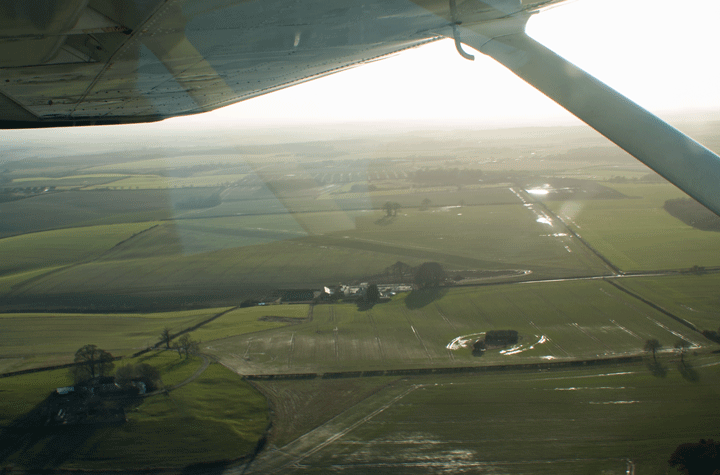
|

|
|---|---|
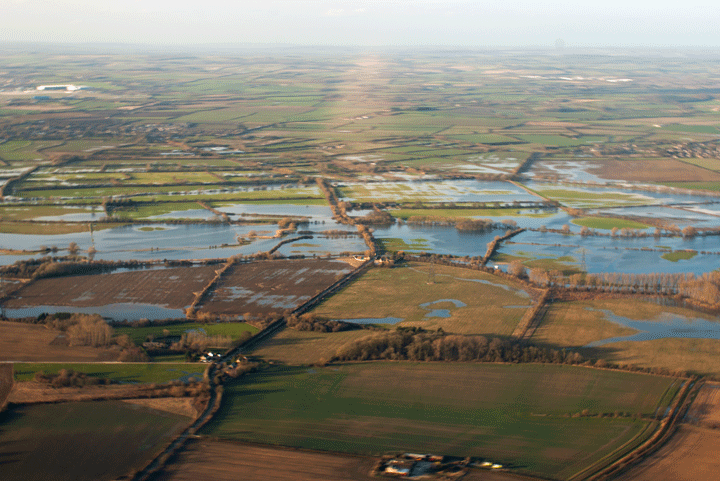
|
|
Exiting the Zone Ann flies us over her house, then we climb out towards Didcot and swap back to Oxford. Kieran has been taking pictures in the back and pronounces himself feeling a little ill, so it's back to straight-and-level Airliner mode and a gentle descent over a hugely flooded Port Meadow for a Downwind join for 19, roll on to Final a bit high and make a stable approach over the numbers for a gentle arrival and taxy back.
Wellesbourne 5 Apr 14
I get a little rusty around March as I tend not to fly in the Spring. It's partly a weather thing, but actually I have been skiing twice this Spring, so aviation has been a long way from my mind.
April arrives. Wow: where the Hell did March go?
It's time for my Annual de-rust at Wellesbourne. It's a perfect day for it: gusty winds straight down the runway, 1,400ft cloudbase so no one else is flying, and the aircraft is fresh from its 50hr check with new battery mount and brand new bling LED landing and taxy lights. These will hopefully last longer than the absymal lifespan of the previous tungsten filament units, which I suspect failed due to vibration work-hardening. I'm dying to try them out at night (when I remember to switch them on...)
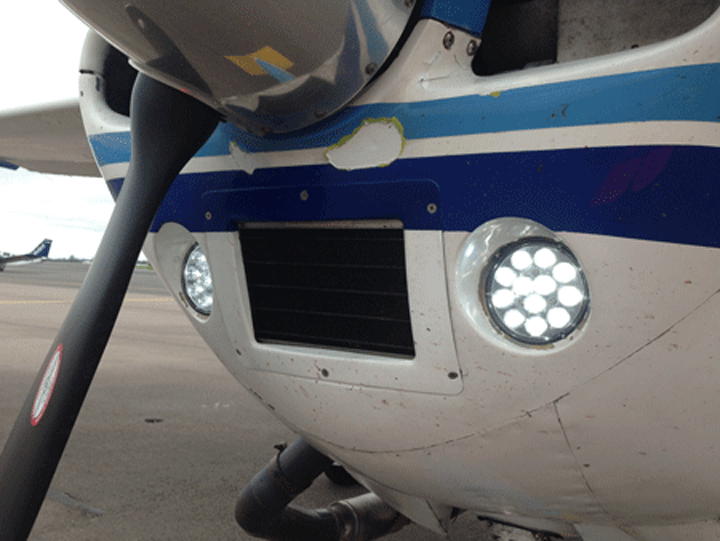 As the aircraft has been serviced, an extra-careful inspection and run-up is in order. Many failures are identified on the first flight following servicing.
As the aircraft has been serviced, an extra-careful inspection and run-up is in order. Many failures are identified on the first flight following servicing.
The bowser has kindly agreed to "fill 'er up with 4 Star, Guvn'r" and I manually check contents and tightness of caps. I am rusty so it's "by the numbers" today.
Start-up, full IFR instrument checks as we may go IMC today then taxy away, taxy checks and run-up checks reveal no snags, so we turn on to The Active and accelerate.
At about 40Kts I become aware of a tinging noise from the right hand side of the aircraft. Should I abandon the takeoff or is it transient? It seems not to affect the handling of the aircraft so I go ahead and rotate, and it stops immediately, but I am mentally watching my engine failure fields below 800ft and calculating a turn back above that in case something goes drastically awry. Maybe a stone in the wheel spat? Very odd, and something I suspect I wouldn't have heard without ANR headphones.
I have been asked to do a turn over the Kassam Stadium as Oxford are playing today and Nessa and Kieran have gone, so we'll depart South for a run over Oxford City centre under the low cloudbase, head for the Cowley Works then bear right and turn over the packed stadium (where Oxford lose to Fleetwood: maybe they were distracted by the circling C182?) before returning back North.
Absolutely not a single aircraft is flying from Oxford today, but Weston on the Green are Active with gliders so I need to go back through the Overhead to get North West to Wellesbourne. I ask for and get a low-level transit through the overhead as there is no other traffic to affect. I dont understand the reason for the quietness, though. It's a perfectly good day for flying; it's a Saturday, there is no nasty weather forecast. As I have asked so many tmes before: where is everyone? The cloudbase is even at a height at which you could practise circuits. Weird.
So we head North West for Wellesbourne at the cloudbase which varies from 1400ft to 1700ft so intermittently we go IMC. It's a bit bumpy but I'm not going to make anyone sick today. Wellesbourne approaches and we join downwind RH for 18. My rustiness has in the past tended to manifest itself in a truly rubbish first landing of the day, but over the years I have honed this in to an OK but long first landing of the day and this indeed turns out to be exactly what we get. I think it must be incipient griound shyness that prevents me from getting the aircraft low enough over the threshold, but the mantra "look at the end of the runway... look at the end of the runway" works and despite the gusty conditions a very smooth arrival is made (phew, people are watching!) and I taxy in to the grass parking where a very kind man tells me how quiet he thinks the C182 is. The Carlos Fandango exhaust certainly has an effect, but of course I never get to hear it from inside so I have no idea...
Wellesbourne offer an "all you can eat..." landing and circuits fee, so we will take advantage of that and bash the circuit away from Oxford where no one can see my mistakes!
Actually, compared to last year I feel much less rusty and behind the aeroplane - the circuits go well with each one touching down closer and closer to the numbers, and I find myself listening to a wonderful conversation between the tower and a guy who clearly doesnt have a clue what is going on: he starts out IMC on top wanting to descend through cloud for Wellesbourne, who have no Instrument approaches and no radar. Not a great start as the cloudbase is 1,400ft so MSA is 2,400ft. My guess is he was hoping for a hole, but it is solid clag today.
Above Wellesbourne is Birmingham's Class D and the cloud tops are 6,000-8,000ft so he is in danger of busting their Airspace. Next he explains that he is not quite sure where he is but wants to join downwind for 18 (which is where I am). Tower suggests he talk to Birmingham who have radar and could give him a letdown, but as his silences grow longer they then gently suggest maybe D&D (Emergency) on 121.5Mhz as he is clearly out of his depth.
Of course everyone in the circuit is playing the game "what would I do?". I think probably switch my GPS on first (or get a cross-fix off a couple of VORs), then ask Oxford for a run down their ILS to get visual under the cloud, then peel off VFR for Wellesbourne. But my suspicion is that he has no Instrument experience and is in trouble.
Anyway we hear no more from him so it gets resolved one way or another but we all have a bit of a think about incident pits.
It's interesting watching other peoples' approaches from behind: I tend to fly my approaches quite high with a high descent rate (I suppose I am worried about the engine quitting). From above and behind it looks like the aircraft in front is descending in to the houses below the approach. One guy is landing and despite slowing down as much as I can behind him on Base and Final he flies it so slowly I have to go round over the top of him rather than risk ramming him from behind.
By the 5th approach the wind is gusting 28Kts 30° off the runway and the landings are getting untidy, so I'll clean up and go home via 19's ILS.
And of course here the rustiness shows as I panic half way home that the ILS isn't working and swing wildly back towards my GPS track (direct Wellesbourne-Oxford) instead of doing what my ILS is telling me (steer left on to the correct track!).
Finally at about 11d sanity prevails and I set up a 60° cut which gets me settled on the Localiser at 6d, well below the glidepath (but then I am VFR).
The glidepath comes in from above and we settle in to a tidy 500fpm descent, no more than 1 notch of deflection in any direction down to 900ft where we go officially visual and we're set up.
Down for a smooth arrival, taxy in and shut down, neatly de-rusted.
Local 29 Apr 14
My IR(R) Rating is due for renewal and it's always useful to spend a little time with my friend Pete, who is a hugely accomplished Instrument Pilot, prior to the renewal.
I'd like to be super-organised so I'll do a quick circuit and all of the pre-IMC checks (autopilot, instruments, radios etc) before Pete turns up, so having checked absolutely everything and made sure it all works I ask for taxy, at which point Tower shoots me in the foot by making me wait for an OAA PA-34 who finally lumbers down from the other end of the apron, takes forever to power-check (on the taxyway, so I cant get past), then ages at the A1 Hold, by which time an AirMed Learjet is on short Final so we have to wait for him to clear the runway. I could have been up and away 20 mins ago!
One circuit later I have proved to myself I can still fly, so I land back and pick up Pete.
We'll go out to Westcott for a loop around the beacon, a practise descent and an NDB approach down to MDA, then we'll head back to Oxford for a Hold, a Live run through the beacon and, hopefully, an ILS.
Inevitably it starts badly after take-off, with me not having the ILS plate in the front cockpit. Doh!
At least it's in my bag in the back and once my Inevitable Big cock-up is over now we can settle down to some serious IMC work.
Depart to the East, climb to 3,500ft and head for Westcott. I can climb, hold a heading and work the ADF (remember: "push the head, pull the tail"), and on this plane the ADF even works after a fashion. I remember to cross-check the DI to the compass and centre the ball, two of my favourite IMC mistakes that make a nonsense of any ADF tracking. Actually, the ANR headset helps because I'm not being battered by noise the whole time, and as a result with my GPS-derived virtual DME for Westcott we do a good job of tracking inbound, loop out for a Hold and then back in for a clean cut over the beacon, then descend outbound for a procedural turn at 6.5DME and then an NDB approach, getting the "not below" descents at various distances correct. I even surprise myself when, at MDA we go "visual", I raise my head and there is the Eastern edge of Westcott just to the right of the centre of the windscreen - I could get it in from there without any issues.
Firewall everything, climb out remembering not to descend below the MDA and change the ADF to OX, turn West and radio Oxford who clear us in to the Hold at 4,500ft. I wasnt expecting Holds today, but OK, let's do them.
Level at 4,500ft Pete reckons we should do a parallel join, which I've never done for real and in "real" flight would never dream of doing: far too complex. Always fly around outside the Hold area for a Direct join, that's my motto!
But we join Parallel over the beacon, parallel the inbound leg in reverse, then turn back the opposite way to the beacon and get a pretty good cut before starting the Hold proper. My mains mistake is that I start the clock outbound from the beacon whereas in fact I should start the clock after the first turn when abeam the beacon or on the outbound (WCA-corrected) leg, whichever comes last. We stop and reset the clock then fly the legs and it all, amazingly, works.
After a couple of goes around Oxford asks us to descend. Descending in a Hold is a recipe for The Leans because you are turning and descending and making radio calls. This is a Danger Area and I know it, so keep tight control on everything, and it all works out OK.
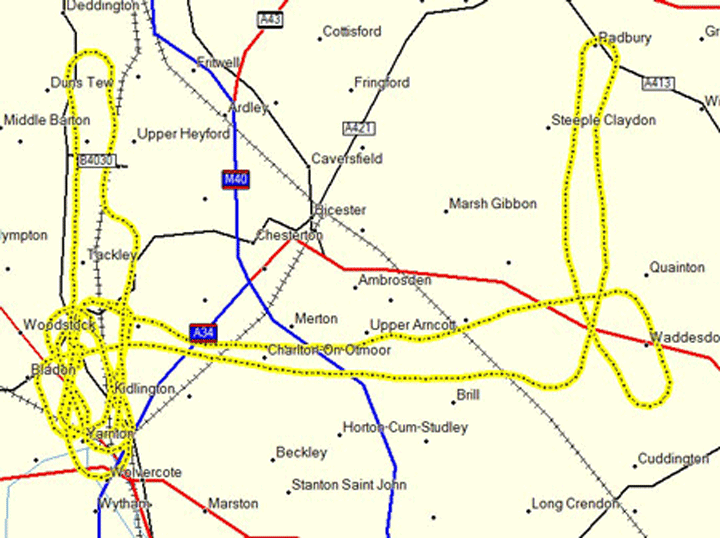 Level at 3,500ft Oxford then clear us for the Approach but says they will probably have to get us to break off at 4d on the ILS because they are using runway 01 (the opposite way round) for VFR traffic tonight and they will have conflicting traffic. Still, it's good practise and we once more descend outbound, perform BUMFARI checks, turn at 6.5d and pick up the Localiser this time for the ILS which comes in nicely. Stable ILS approach established and trimmed, too soon it's 4d and I have to look up but the runway is quite satisfyingly just there ahead, before we turn for a visual circuit for 01, settle in to the Downwind leg (it's really hazy by now - fog is forecast for later in the evening), descend for Final, get it a bit high and a bit left, so gently correct and by the time we fly over the A44 we are spot-on for a nice flare and arrival, roll out and taxy in.
Level at 3,500ft Oxford then clear us for the Approach but says they will probably have to get us to break off at 4d on the ILS because they are using runway 01 (the opposite way round) for VFR traffic tonight and they will have conflicting traffic. Still, it's good practise and we once more descend outbound, perform BUMFARI checks, turn at 6.5d and pick up the Localiser this time for the ILS which comes in nicely. Stable ILS approach established and trimmed, too soon it's 4d and I have to look up but the runway is quite satisfyingly just there ahead, before we turn for a visual circuit for 01, settle in to the Downwind leg (it's really hazy by now - fog is forecast for later in the evening), descend for Final, get it a bit high and a bit left, so gently correct and by the time we fly over the A44 we are spot-on for a nice flare and arrival, roll out and taxy in.
Well, I don't feel as frazzled as I expected. Maybe that's the ANR. But suddenly I realise all I actually saw outside the aircraft for the entire flight was Westcott from 500ft, and Oxford's runway from 1200ft. And we had been flying for an hour. Good IMC polishing.
We've discussed pre-prepared power/prop settings for various IMC flight regimes (IMC cruise, Hold and descent) and actually that makes a lot of sense: if you set them and trim the aircraft will fly predictably so you can concentrate on other stuff. I'll work on this.
Abingdon 3 May 14
When I was at school I joined the RAF Cadets because I wanted to be an RAF pilot.
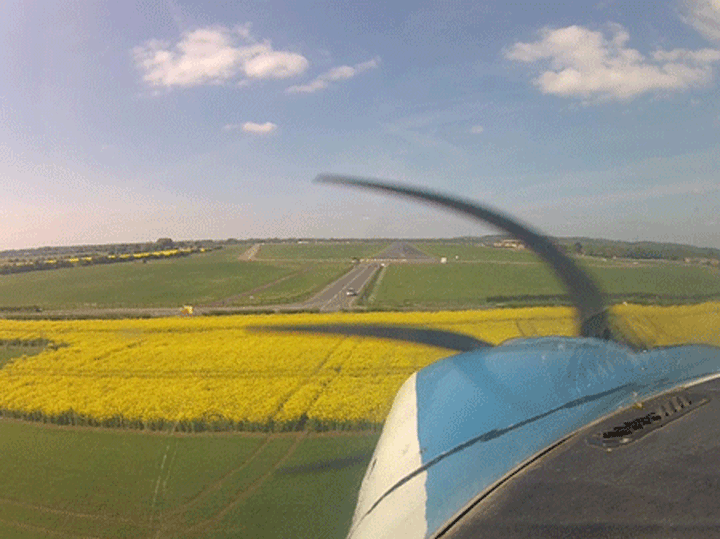 Like thousands of others I was eventually excluded on spurious medical grounds (see previous postings on this subject); however before they finally rejected me they did at least teach me to fly Chipmunks, and I have 13 hours logged flying out of what was RAF Abingdon (now Dalton Barracks-with-a-huge-unused-runway).
Like thousands of others I was eventually excluded on spurious medical grounds (see previous postings on this subject); however before they finally rejected me they did at least teach me to fly Chipmunks, and I have 13 hours logged flying out of what was RAF Abingdon (now Dalton Barracks-with-a-huge-unused-runway).
A long-held ambition has been to officially fly in to RAF Abingdon. Normally the airfield is closed, but once a year they let people in for the airshow. I booked a slot last year, however the aircraft was at the time in 1,000 pieces following an unscheduled field landing.
This year we are going to have another go. We have PPR for a brief visit on the day before the annual Airshow, we have Nessa and two local girls: Carol and Sarah, who would like a spin around Abingdon. And we have the 4 page brief, which is excellent and answers all the relevant questions.
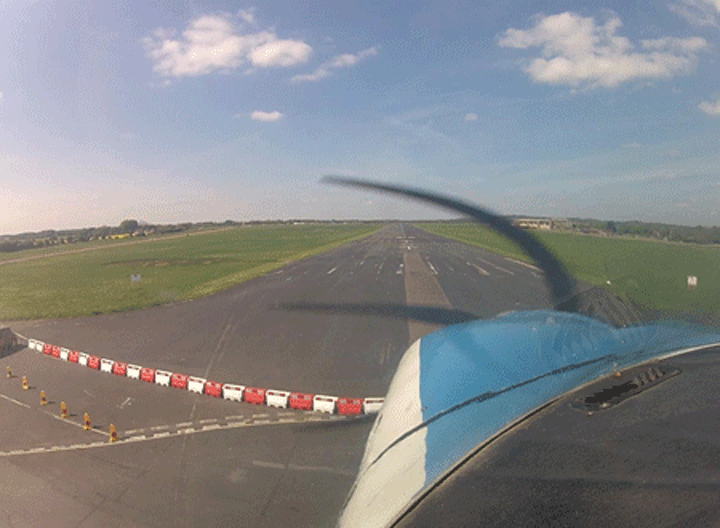
We depart from Oxford on 19, fly over central Oxford and depart South for Abingdon. Once the field is in sight (so that'll be overhead South Oxford, then...) we swap to Abingdon who ask us to do an Overhead Join for 36 at 1500ft QFE.
We can do that: cross to the Dead Side overhead the landing numbers, descend to 800ft QFE and cross back over to the Live side over the take-off numbers, call Downwind, slow to 90Kts, get blown West a bit for a tighter-than-desired Base leg, pop 2 stages of flap, slow to 75Kts and so a nice long steady Final over the rape fields.
Put in a bit of power as the ground slopes upwards here to maintain the picture, and cross the threshold, ease the power off, and flare.
The stall warner whistles as the wheels kiss the tarmac: have I done the perfect landing?
No, bugger it!
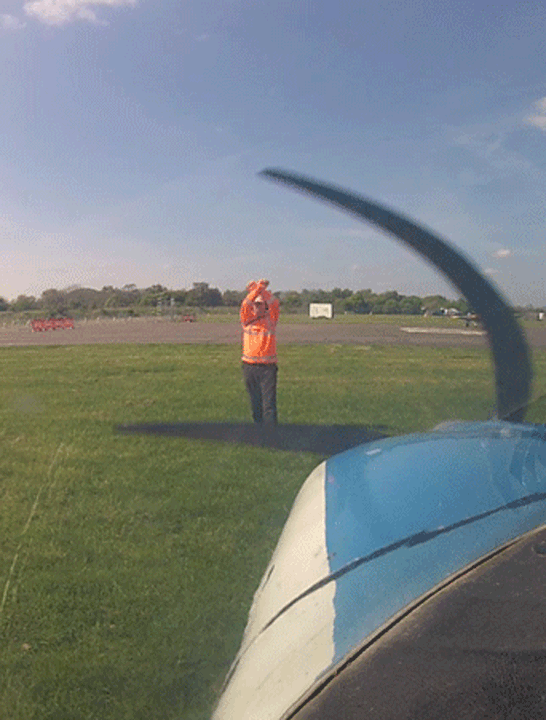 We seem to get a second landing bump (but we were already down?), then the right wing lifts a bit. What's going on, this is all unsettling. I think we have a bit of rotor off the big hangars: that East wind is not doing what the windsock says it is. Drop the wing in to wind and get back on the centreline for a smooth roll-out, turn left on to 24, mind the biplane doing a run-up, and taxy in. BUt disturbingly messy, particularly as people are watching!
We seem to get a second landing bump (but we were already down?), then the right wing lifts a bit. What's going on, this is all unsettling. I think we have a bit of rotor off the big hangars: that East wind is not doing what the windsock says it is. Drop the wing in to wind and get back on the centreline for a smooth roll-out, turn left on to 24, mind the biplane doing a run-up, and taxy in. BUt disturbingly messy, particularly as people are watching!
After being marshalled in and parked on some massively draggy grass, paying our £5 landing fee and taking some photos we start up, taxy slowly and noisily to the lip of the taxyway, gingerly ease the aircraft over the lip and taxy past the temporary Tower for power checks and departure. We'll depart 18 as it's longer and easier and there is no conflicting traffic, so turn right and accelerate down the mile of tarmac. Sod any weight and balance issues, we'll get airborne off this one!
We use about 400m of the 1,300m available and turn left for a run over Sarah's house, then head North for Carol's house. Climbing out North towards SE Oxford we switch back to Oxford Approach who tell us of conflicting motor glider traffic near Beckley mast; exactly where we are heading. Eyes peeled, we spot him circling the mast and ensure we are well clear, turn back West and ask for a left base join for 19, run down the approach and this time the landing really is perfect.
They've had a great time and I've finally Officially landed at and taken off from Abingdon.
Haverfordwest May 14
It's our 23rd Wedding Anniversary and we've booked a weekend in a plush B&B in Pembrokeshire.
A six hour drive through Friday traffic to Haverfordwest does not appeal and the weather's nice....
My memories of Pembrokeshire are a wet week in Tenby a very long time ago, a lot of firing ranges in the way of my flying and one brief visit to Haverfordwest when I first had my PPL. So this will be interesting.
Friday morning at Oxford is mayhem: the radio is full of jets, OAA traffic and PPL students doing circuits. The bowser is busy so we'll need to taxy to the pumps for some juice. We might as well simply fill her up as there are only 2 of us. Once filled (and the blasted pump cuts out after one tank so I have to go through the whole rigmarole of getting the receipt then starting a second transaction to fill the other tank), we call for taxy and get told to standby. It soon becomes obvious that the Tower has then forgotten us as it takes a call from another aircraft requesting the Tower to ask us to move off the pumps before they finally allow us to taxy. But understandable, given the amount of traffic, which includes my friend Pete being Instructor for the day (but we'll see him later...)
All power checks complete we depart off 19 with a Right Turn in to mainly bue sky with the odd fluffy cloud. Being summer it's thermally and bumpy as we climb out; being in Airliner mode we'll seek smoother air above the clouds, so we climb to 4,000ft and the air becomes more settled: much more pleasant.
Swap to Gloucester, transit South Abeam, swap to Cardiff and as we cross the Severn the clouds form a barrier: this is the infamous South Wales crap weather micro-climate. Cloud tops are at 6,500ft, the Airway above is at 7,500ft so we'll climb to somewhere in-between. As we whip through the tops rain spatters the windscreen: it must be raining below. No wonder South Wales is so dour, it's even wetter than the rest of Britain....
The cloud tops look so solid it feels like you're flying very low and you get a real sense of speed as they scud past, then suddenly at the end of the Black Mountains North of Swansea they abruptly stop and we get a real sense of vertigo looking down 6,500ft to the ground.
Here it is CAVOK: no cloud and a bright blue sky, so we set the throttle for a gentle descent and a long 30 mile Final for 27 at Haverfordwest. A few fluffy clouds do finally appear but Runway 27 is visible from 20 miles away. No one else is in the circuit so we call 5 mile Final, do all the checks and settle in for a steady approach. There's a bit of rotor off the trees and some sink about half a mile out, then we're over the numbers and kissing the concrete, rolling out and parking up in front of the Tower for the weekend. 1hr 10 mins and we're on Holiday.
Days are efficient and rent us a Fiesta for the weekend, so off we go...
It turns out Pete is also holidaying in Pembrokeshire so parks his Mooney up next to our C182. I get a surprised text on the Saturday morning and we meet up for coffee - he's rock-climbing. What a coincidence.
Sunday lunchtme sees us back at Haverfordwest winding our way through the crowds of people at a Vintage Military equipment show next to the Terminal. Pre-flight checks, a chicken burger in the excellent restaurant and we start up, taxy back down 27 and depart from the intersection on 23. Everyone else is back-tracking but there's plenty of runway so we just turn in, call "rolliing" and we're off in 300m climbing out over Haverfordwest and turning 090 for the run home. We've got a Southerly wind so should get back even quicker.
Over the Black mountains once more the cloud sits at 6,500ft so we climb to 6,800ft watching it clear before the River Severn, then back in to CAVOK and the odd fluffy white cloud South of Gloucester. Cardiff swap us to Bristol, which seems inappropriate as we are closer to Gloucester, then we swap back to Oxford, start the descent 23 miles out, ask for and and get approval for a Right Base join for 19, slide down the approach and touch smoothly on to the tarmac: 1hr 6 wheels-up to wheels-down.
Taxy to the pumps to fill up as the others are taking TG to Scotland tonight, and park up on Slot 2 with 5 minutes to spare before our 4.00pm deadline.
What it brings home quite forcefully is the difference an aircraft makes to the scale of travel: 1½hrs flying time gets you to a completely different part of the country, whereas 1½hrs of driving is just a commute. I've spent an hour sitting in a traffic jam before now and not got anywhere at all...
1½hrs flying time from Oxford gives Amsterdam, Northern Belgium, Northern France, the Channel Islands, SE Ireland or The Lake District. It changes your entire view of the geography of Northern Europe and what is possible to do for a weekend.
Local 26 May 14
My SEP (Single Engine Propellor) Rating expires every 2 years, and my IMC (Instrument Meterorological Conditions) Rating every 2 years 1 month. The IMC needs what Americans would call "a Check Ride" whereas the SEP simply requires that you spend 1 hour with an Instructor doing whatever you want. So if you choose to spend that hour revalidating your IMC it kills 2 birds with one stone.
It's a rainy Bank Holiday Monday, but the conditions are well above IMC minima so armed with weather charts and IMC checklists (and some recent IMC practise) we walk out, get some fuel from the bowser and start-up. I normally do a lot of the pre-IMC instrument checks after the engine has started but today atypically I do some of them before and notice one weird thing: the ADF is really noisy when the needle moves: there must be a lot of clockwork going on in there (and to think: we won the war using these, magnetic compasses and star sights... No wonder we lost so many planes!).
The ATIS has just gone over to a new funky robotic-voiced automatic system that tells us in Stephen Hawking tones to prepare for a 19 departure but in fact the Tower tells us to line up for 01, which we query, but as there is no wind and no traffic (I am convinced people think aircraft dissolve in the rain) it really makes little difference.
We opt for the shorter taxi to 01, power-check and depart North West. And there's that strange "ting...ting" noise on take-off again; not a stone, then. It sounds like it could be the exhaust expanding or flexing as the weight comes off the wheels.
I manage to get the Approach frequency dialled-in wrong and end up talking to Brize, flip back to the *right* frequency and climb to 3,500ft expecting partial-panel recoveries, timed turns or something else nasty, but he suggests a little gentle VOR tracking (which I think I can do by now), then we get radar vectors from Oxford for the ILS Localiser which is fine, but I forget to swap back to 108.35 and wander off in to the wilderness a bit before we swap back and everything snaps back in to focus.
Despite the forecast WCA being effectively zero at this height today, inevitably it's wrong and in fact a steady 210 heading ins needed to hold us on the 19 Localiser. I push as the glideslope comes in and get a steady descent, but of course the wind changes and we start to oscillate left and right as we pass through 1,000ft which is just dumb because of course like all VORs they become very sensitive as you get close. I have done so many much, much better ILS approaches than this, and I feel I'm flopping around like an amateur. In my defence, we never go below the glideslope, nor do we wander off more than half-scale defelction, but it feels messy. That said, we go visual, there is the runway neatly ahead so I slow the aircraft down, pop the flaps and stabilise the approach.
At 200ft my Instructor/Examiner spots a flock of crows I reckon we're going to be above and pulls the aircraft sharply up and over them, then lets go. So now the aircraft is further down the runway, has lost a lot of speed and is descending rapidly. Ah, I've flown this aircraft enough not to be caught out by that little trick: too late to apply power, we'll keep the nose down to keep the speed up, wait until the very last moment then a calibrated heave and we plop on smoothly for a roll out on the wet tarmac. I reckon that was his little "let's see if you really do know what you're doing in that left seat..." test.
Mechanical intermission May - Oct 14
 When you buy an aircraft engine (a Continental O-470-R in our case), as they have been manufacturing these since the 1950s they know enough about them to know that they will last a certain number of hours before starting to fail. This is known as the Time Between Overhaul (or TBO) and is set at 1500hrs.
When you buy an aircraft engine (a Continental O-470-R in our case), as they have been manufacturing these since the 1950s they know enough about them to know that they will last a certain number of hours before starting to fail. This is known as the Time Between Overhaul (or TBO) and is set at 1500hrs.
Beyond that time, you may run the engine "On Condition": the condition being that every 50 hrs you must change the oil and split the oil filter for debris inspection. Particles over a certain size and of a certain type indicate imminent engine self-destruction.
Our engine ran 1700hrs (the equivalent of around 100,000 miles of driving) but then the filter showed evidence of imminent destruction and so the engine was condemned.
It is sensible to have an "Engine Fund", so you calculate the likely cost of a replacement engine and every hour you fly you save 1/1700th in to the fund. But in The real World that doesn't always happen, so you might just get a big bill......
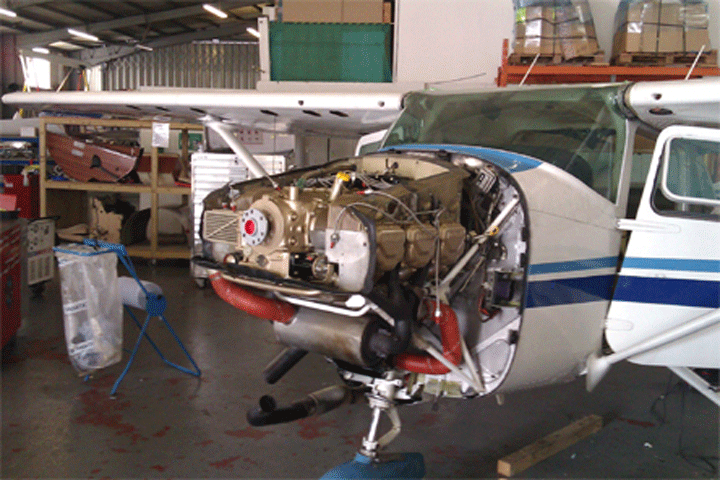 The decision was made to "Zero-Time" or refurbish the engine, provided the various components were re-usable. This involves a complete strip-down, line bore, fitting over-sized bearing shells and new pistons, crank and camshaft, in fact most of the rest of the engine.
The decision was made to "Zero-Time" or refurbish the engine, provided the various components were re-usable. This involves a complete strip-down, line bore, fitting over-sized bearing shells and new pistons, crank and camshaft, in fact most of the rest of the engine.
The engine had new cylinders 200 hours or so ago, so they were OK but on strip-down they found this in one of the camshaft bearings. That looks like oil but is in fact smeared metal. The abrasion has heat-treated that area of the block, and Continental decided this meant the end of the block.
So, in the amazing topsy-turvy world of aviation, a new block was found, the engine serial number painstakingly removed from the old block and re-riveted to the new one, then the engine was rebuilt around it, but this all takes time. In fact, from May to October the aircraft has been out of use.
Local 6 Oct 14
If you don't fly for 90 days you are considered "not current". This means you are not insured to fly passengers, but also, all things being equal, you are probably pretty rusty. So a wise move would be 3 circuits with an Instructor. Technically, you are P1 U/T, but the Instructor is there just in case things go awry.
With the imminent return of Tango Golf it seems like a good idea to get Current once more, so a return to PFT and 3 circuits in a PA28-140 is decided upon. This will be interesting: I haven't flown one of these for a very long time...
This being Autumn, the weather forecast is horrible, but we book a provisional time where the gale force winds will be only down the runway, so it may be bumpy but it will be easy. And of course as the time approaches the winds die down to nothing and the sun comes out... huh?
I've dug out my old checklist, mentally run through what I need to so ("Fuel pump? What's that?"), and most importantly the relevant speeds: rotate 65Kts, climb and descent speed 75Kts, cruise 90Kts, 2 stages of flap for descent or 3 stages and 65Kts for a short-field approach.
We have a few issues getting the engine started (I'd forgotten it's "turn and push") but once the 4-cylinder rumbles in to life and settles down the advantage of ANR headphones becomes hugely apparent once more. I'm a calmer pilot with these on: I can hear everything and the engine noise doesn't put your teeth on edge.
Pre-taxy checklist complete, we taxy out and wait at the Hold.... and wait..... and wait. The hopeless woman in the Tower has ample opportunity to get us off and away but dithers and we are there for a good 20 minutes waiting for landing traffic that is 5 or 6 miles away. I suppose, with hindsight, she is assuming we are a low-hours student who will mess about on the runway. Fair enough. Still, at least we know the engine is warm!
Eventually, however, we are cleared to line up and we're off like a rat up a drainpipe. She clears us for take-off and we er....... accelerate. A bit. I had forgotten just how underpowered a 140hp aircraft is. It takes what seems like most of the runway to get to 65Kts at which point we start to get lift. I am a lot more aware of what the wing is doing nowadays and I can sense the aircraft going light on the wheels at about 62Kts. At 65Kts we rotate, then once the wheels are off in ground effect just pitch forward a touch to accelerate to 75Kts which is best climb, trim for that and simply let go and keep it on the runway heading. Simples.
It takes a long time to get to the crosswind leg turning point, then a Rate One turn (I reckon you can always tell an IFR pilot, because all his turns will be Rate One), keep the ball in the centre, pitch down just a touch to keep the speed at 75Kts (turns are draggier than straight-and-level), then roll-out and climb to 1500ft, anticipate the height so push during the last 50ft so you arrive at 1500ft rather than blowing through it, watch the speed climb to 85Kts, push more and trim because there is now more lift, then throttle back and arrive at 1500ft and 90Kts, trim for that, check spacing (I'm a bit too far out, but we can live with that), make downwind calls (and I manage to respond with "Tango Golf......er, Golf Juliet"), then BUMPFTCH and it's all easy smooth flying with plenty of time to plan the descent. Turn for Base Leg, cut the power, pop in the flaps (big heave on the bar), pull (not push, this is a low-wing aircraft) for 75Kts, stabilise the descent and trim, drift down to turn Final, call Final and now... let's see if we can land a PA28.
We'll try the old mantra "Look at the end of the runway, Luke...." and see what happens. Roll off the power and try to keep the aircraft flying, DON'T look anywhere but at the end of the runway, and.... plop, we're down. Well that was easy. Flaps away, carb heat off, on with the awesome power and we're off and away without any difficulty.
So we do that twice and on the 3rd time Pete says "let's have a bit of fun.... let's short-field it this time". Now I've not really tried short-fielding a PA28, not in quite the same way as I have a C182 anyway. So we'll try 3 stages of flap and 65Kts, aim at the end of the runway and see what happens.
It almost works perfectly, but I don't roll the power off quite quickly enough so we float for a bit but then we're down nicely, and a bit of braking gets us slowed by the intersection so we can turn and taxy in "backwards" down 11/29 and back to the parking bay.
This proves generic flying skills do work: maintain the right speeds, look at the end of the runway and all will work out just fine.
So now we are current and just need an aircraft.
Kemble - Welshpool 25 Oct 14
We have a new engine.
We have new avionics (a Garmin 430W panel-mounted GPS unit).
We have a new Comms box which has a separate manual to the 430W.
We have new bells and whistles and switches, which has required a special briefing.
And now I need to get back and really fly the aircraft.
Running-in requires long legs flown at high engine power and speed to "glaze" the cylinder bores, so no circuits, no sectors shorter than 30 minutes and no reduced engine speed descents, so we must keep the prop revs high.
I think I'll do this one alone, in case something plays up...
So we'll get the nice bowser man (they're always really friendly, and actually I have noticed that people in aviation are becoming friendlier - the last nasty person I met was at Denham, which has not enamoured me towards flying there) to fill up the aircraft with fuel, and PPR for lunch at Kemble via the CPT beacon to make the leg over 30 minutes and to give me some VOR practise.
First impressions are that the avionics Master switch is a good idea but doesn't turn the transponder on; that's a lovely clean-looking engine in there, many of the smells are different; the throttle linkage is much smoother and easier to manipulate; there is no vernier on the mixture control (and the button does not require huge force to push it in); it’s a lot smoother at tick-over and the EGT gauge actually works.
A smooth take-off on 19 and a climb over the city towards CPT gives a chance to get used to a bit more power, slightly different noises and the 430W's comms suite (which does not take long to master). Level out at 3,000ft, just under the cloudbase, track CPT (ah, it's that button on the 430W) then turn right on-track towards Kemble. Brize gives us a Basic Service (amazing! It's Saturday, they're normally asleep) and actually seem quite busy. Kemble have told me they are busy too, which is good.
There are rain showers about, and one obscures the approach to Kemble, but I know it's there, so switch to Kemble and ask for a straight in for 26 (nothing ventured, nothing gained: I can always join Left Base or even downwind if there is other traffic) and they agree, so a brief wet, bumpy IMC interlude later we're lined up and the runway appears. I seem to be mainly doing high approaches at the moment, but the old "I can get it in from here" cone rule applies and we can roll off the throttle, bring the prop up to keep the engine cooling going and lean forward in the seat, drop to 100Kts, drop 10° of flap, trim for 85Kts, then 20° flap and descend in to the cone. No bounciness off the hangars today, and we settle on 1/3rd of the way down the runway nice and smoothly. Quite glad of that PA28 interlude, but keeping the eye on the end of the runway does the trick, and we roll out, throttle up for an expedited runway vacation, request taxy to the restaurant and park.
Kemble then produces two unexpected surprises: the landing fees have gone down (to £10), and a cheese burger, onion rings, salad, fries and a Coke is £8.50. Very user-friendly, although they do get quite cross with one landing pilot, moaning about "procedures". Actually they do have a grass runway, so if the hard is busy you could use that. Next time.
I've never been to Welshpool but it looks nice and just to go home to Oxford seems an anti-climax, so we'll depart Kemble, do a smart right turn and head North West for mid-Wales.
I have had bad experiences with the weather in Wales: it always seems worse once you cross the Severn. And today is no exception as we cross the border the weather deteriorates into patchy IMC and bumpy clouds, so we'll climb on top for a smoother ride and drop back in North of Shobdon (famed for being well-camouflaged and thus hard to find).
But if you think Shobdon is hard to find.... Hah! Without GPS you've got no chance with Welshpool.
I'm 2 miles from it and turning Downwind before I even spot it.... with a big hill on the Downwind-to-Base corner. I can see why they have a high circuit height (which I am nowhere near at: more power, Mr Scott!). Then of course turning Final I seem too high (typical...), so chop the throttle, 20° flaps, nose on the windscreen, even less throttle, speed to 80Kts and the picture gets better. But there's a damned helicopter on the runway... Oh no, he's moved away.
Past the control tower, over the threshold, big heave and it drops on nicely. One wheel a little reluctant to settle but we'll kill the flaps and just let it roll on. Brakes, backtrack, park next to the King Air and shut down for a cup of tea.
Welshpool is surprisingly busy, with a helicopter training and a Robin with a decidedly lumpy-sounding engine being run up and then flying a circuit (dodgy, with that engine, I reckon).
A rainstorm is coming in from the South, so we'll fire up, taxy, power-check on the short taxyway and call "rolling".
Let's do a short-field take-off for practise: a stiff headwind gives a roll of about 200m before we're off; hold it at 65Kts and we're at 1,000ft before the end of the runway.
At 1,500ft we go IMC in to the rainstorm and get chucked about... not unlike the inside of a washing machine, really. I hit my head on the roof a couple of times before re-emerging in to dramatic cloud scenes with showers and sunlight.
Heading South West the clouds clears as we cross the Severn. 24/24 now gives 145Kts ASI; 165Kts ground speed. If you climb up just above your target height then dive on to the height and level out the aircraft goes faster, although at that speed the elevators stiffen up and the airframe whistles.
Descending towards Oxford there is no traffic to conflict, so we'll kink a bit to avoid Enstone traffic (I actually see two aircraft quite close), descend for a right base join for 19 and drop it on tidily. These tidy arrivals are becoming more consistent now.
A few things I have noticed:
- The lack of an audible “click” on pressing the TX button is disconcerting, but the radio works OK
- The P1 seat belt is much better: I can reach down for the fuel tap more easily now
- The nosewheel shimmy is back (although only at Oxford)
- I do like the 2nd (electric) AH: I feel more comfortable with that there.
I have been a little worried about the oil: I start with 10 showing, at Kemble it's down to 9 and at Welshpool I can’t get a solid line on the dipstick, just globules, so I pop in a bottle. But oil pressure is stable on exactly “50”.
Dunkeswell 1 Nov 14
The last time I went to Dunkeswell I managed to mislay both keys and camera, and felt so stupid. This time I won't.
It's Lucy's 21st birthday today and she has asked to go out to lunch at Dunkeswell and then back via the North Devon coast for a little sightseeing: one of my favourite jaunts.
I find it amusing how bad the Met Office's wind estimates can be: the BBC site and the Met office aviation weather forecast are for winds aound 10-13mph (so 10Kts), but even at Oxford it's more like 20Kts. The cover flies off as I undo it and makes an escape attempt. I can't roll it up tidily: it just gets bundled in the back of the plane. Sometimes life is too short to roll the cover up tidily!
We get the AvGas bowser to fill Tango Golf up with fuel, pre-flight and taxy out.
Lucy will be flying today: we'll make a pilot of her yet!
But on take-off it is actually quite rough, so I'll handle the climb to 3,500ft over Oxford and Abingdon, then turn it over to Lucy for some cruising. And she is pretty good, although when asked to change height as well as heading she gets a bit overloaded (I remember this).
As we head South West there are more clouds and we skim through the tops of a few. I don't really mind being IMC, but they dont like it, so I get Lucy to skim around them which is more fun, and up here it's a lot smoother.
The intercom is really noisy, and gets noisier. It fells like someone has a mic stuck open. Disconnecting both passenger microphones cures it, but it's not until later in the evening after a really good look at the Com box instruction manual that I belatedly realise that there is a passenger squelch knob, which goes to show the huge gulf between reading the manual and actually using the kit.
One for the next flight.
Descending in to Dunkeswell straight in for 22 we have a Grob Vigilant reporting left base in front and as he is a motorgilder he will be slow, so we'll slow right down and hopefully give them enough room to turn Final, land and exit the runway before we ram them up the behind.
And it works: although it looks like a potential Go Around, at the last moment they turn right off the runway and we can proceed.
The approach is very rough: the wind is nominally straight down the runway but it throws us about something rotten in the last 500 feet.
This is precisely where I tend to make bouncy landings, and I am determined not to.
Heaving well in to airframe whistle / stall-warner territory, I hold it off in ground-effect and am rewarded with a really smooth arrival, amazing given the conditions: progressive braking even gets us slowed before the junction and we can turn right to follow the Vigilant. Mmmmm, nice....
Others are not making such a good job.
We park on the runway under the approach, which I think is really dodgy but they seem to get away with it. I still don't like approaches over parked aircraft, though......
After a really good lunch (I like Dunkeswell lunches) we start up (not forgetting keys and camera), power-check in place and roll, queue-barging a Cessna 152 with a student (well, he was just sitting there looking at us, and a 152 takes 35-40 minutes and 1 mile of runway to get airborne anyway...) and climbing out in to the rough air.
We head South West around the nearby glider site, then swing round North West for the coast, climbing towards the low cloud base. There is no point in going on top only to come back down later.
The weather has deteriorated and is not really great, but improves as we coast out at Bideford and turn for the North coast. We're below the level of the cliffs and the rolling turbulence off them suddenly gives us a whack: Nessa is in the back with her seatbelt off and is really chucked about. None of us like this, so we climb to 2,000ft where it is a bit smoother, and the scenery is amazing but this is not really the right day to be doing this; normally it's smooth over the water but today it's just horrible.
Cardiff pass us to Bristol and we climb inland over the Wells mast, clip the corner of the Bristol zone at 5,500ft and finally it smooths out above the clouds.
Having the wind behind us gives us a ground speed of 170Kts and before long we are back over Grove, back with Oxford and descending for a Downwind join for 19, slowing and getting chucked about for the last 200 feet of the approach before once more a smooth arrival. Consistency!
Thruxton - Shoreham 17 Jan 15
Business and domestic issues have conspired to rob me of my flying opportunities since 1st November, so it's time to get back in the air and have a day exploring.
We wake up to heavy snow (what?) which almost immediately clears and then melts. Phew!
 The weather forecast actually does look really good, so we will commit to commiting some aviation today. Thruxton, in to which I have never flown as P1, then lunch at Kemble. Well, as we shall see, the best laid plans of mice and men etc.....
The weather forecast actually does look really good, so we will commit to commiting some aviation today. Thruxton, in to which I have never flown as P1, then lunch at Kemble. Well, as we shall see, the best laid plans of mice and men etc.....
It's very cold today, but as we don't get going until 11.00am (well, hey it's Saturday...) the aircraft is not covered in ice, although some of the puddles under it are slippery. Freezing level today is 2,500ft-3,000ft, so we shouldn't have any control surface icing from standing water before we can blow it away at 130Kts.
We need some fuel, so we'll start up and go to the pumps. It's quite nice to be in the aircraft, I have cold hands from the walkaround. I've got Nessa helping me with the checklists which really helps as she won't let me step on unless I really have covered each step. I quite like having a co-pilot.
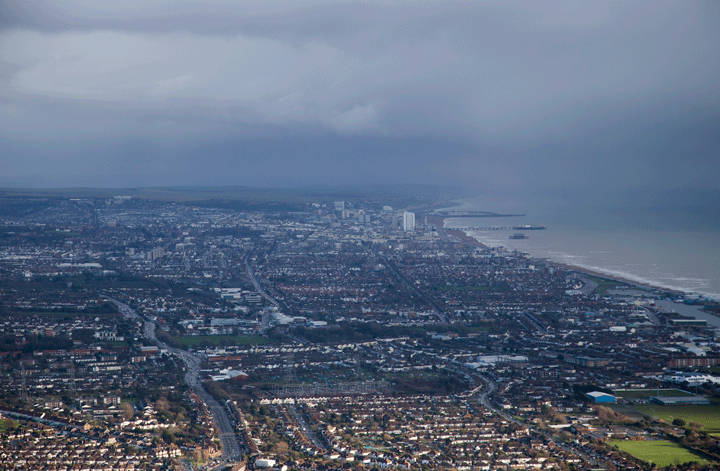 At the pumps we fill the left tank (which always drains first on C182s: there is a whole world of forums out there discussing why. It's a perennial C182 issue which Cessna have never quite fixed, but we know it's not the end of the world, except that the plane then flies right wing low) and start up to go.
At the pumps we fill the left tank (which always drains first on C182s: there is a whole world of forums out there discussing why. It's a perennial C182 issue which Cessna have never quite fixed, but we know it's not the end of the world, except that the plane then flies right wing low) and start up to go.
And it won't stay running: it's coughing and spluttering. I can squirt the throttle and it runs for a few seconds then splutters. Fuel? No, I've got the mixture leaned out. Bang that in and normality reasserts itself. Ah, of course. Doh!
Taxy for departure, power check and depart South "not above 2,000ft". Well, that's a new one. I was aware of Oxford's new desire to keep VFR departures below incoming IFR arrivals but have just never experienced it before.
Swap to Farnborough West and ask if Boscombe are awake: no, apparently not so swe'll swap to Thruxton without Boscombe first. Thruxton are on Runway 25 so we can join Right Base and before we know it, it's really close, so a fast descent for Right Base, turn Final, report Final and let's see if we can remember how to land. The wind is straight down the runway, so flatters my approach technique and a soft arrival means a big smile as we roll in to park and pay our landing fee. That old Devil called Nosewheel Shimmy has returned, so we'll keep the weight off the nosewheel as long as we can.

Lunch is to be at Kemble, but.....
We call them up, and they're closed with snow on the runway. Blimey! There is no snow here, or at Oxford, but they are higher I suppose. A quick change of plan has us consider Compton Abbas (but that could be muddy), Popham likewise, Wycombe's food is so-so, but Shoreham has a new restaurant, so let's go there.
A quick change of route in the GPS, DCT Shoreham (how lazy is that?) looks good, so we backtrack 25 (that must drive them mad when they are busy - they badly need a tarmac taxyway here...) and take off, doing a right turn and climbing out of the circuit to turn right towards Shoreham.
Swap to Solent for a Basic Service and skirt their CTA, but they give us a Transit anyway, even if we are technically outside at least they know where we are. Climb above the clouds once we're East of the CTA and it's a smooth run to Shoreham where we descend for a crosswind Join for 20, cross the take off numbers, call Downwind, turn Base, remember to descend aggressively as this leg takes you low over the hills to the North of the field, take the hats off the fell walkers and we're still too high on the approach (!).
We end up doing virtually a glide approach, but by the time we are at the threshold we are absolutely in the right place. A gust makes us balloon in the flare but we'll just hold it, let it come back down again and hold it off for a smooth arrival with a little squawk from the stall warner. It's not until we step outside the aircraft on to the apron we realise that there is a quite a gale blowing across that runway today. 25 would have been more appropriate, but it's grass and virtually underwater today, so you get what you get. And given the conditions, I think that was OK.
 I am pleased to report that despite the extortionate £31 Landing Fee (second only to Humberside in my schedule of rip-offness: I only usually go to Shoreham because I get my Landing Fee paid! Guys: Limoges is £4, Thruxton is £12 or £6 with fuel, Kemble £10... sort yourselves out) the restaurant is massively improved and extremely busy as a result. We are lucky to get a table, and the bacon and cheese burger is excellent. Recommended - we'll be back (when I get my Landing Fee paid, which may be sooner than expected...).
I am pleased to report that despite the extortionate £31 Landing Fee (second only to Humberside in my schedule of rip-offness: I only usually go to Shoreham because I get my Landing Fee paid! Guys: Limoges is £4, Thruxton is £12 or £6 with fuel, Kemble £10... sort yourselves out) the restaurant is massively improved and extremely busy as a result. We are lucky to get a table, and the bacon and cheese burger is excellent. Recommended - we'll be back (when I get my Landing Fee paid, which may be sooner than expected...).
Filled up with burger, we depart several pounds heavier and head out to sea for a right turn, climb and depart "Brighton City Airport" (give me a break, they'll be "London Brighton Inter-Galactic" next), swap to Farnborough and trundle home the lazy way: MID, CPT, OX on autopilot at 2,300ft not bothering anyone. There is lots of water around in the flood plains but the air is smooth and nowhere is very busy.
 At Didcot we swap back to Oxford Approach, descend for a 19 Downwind Join and roll Final to discover that this week I will be mostly too high on the Approach, according to the PAPIs.
At Didcot we swap back to Oxford Approach, descend for a 19 Downwind Join and roll Final to discover that this week I will be mostly too high on the Approach, according to the PAPIs.
Who needs them anyway: I'm not a bizjet and I know what I'm doing.
By the time we are 1/3 of the way down the runway we are flaring and this time I am really going to for a non-bump arrival.
And we get it; admittedly not on the centre-line, but no squeak, just a build-up of rolling vibration as the wheels spin-up.
Ah, Bisto...
Shoreham 27 Jan 15
The A34 is blocked by an accident Southbound; the A33 from Winchester to Southampton is stationary, and the A27 East in Arundel is gridlocked. And I need to be in Shoreham to visit a client.
Oh dear...
It's a bright and sunny Winter breakfast-time, I am departing Oxford and climbing South. All I can see on the ground is stationary traffic: Oxford's normal sclerotic commute, something I habitually avoid by working from home and only visiting clients in cities after rush hour.
But up here there is no congestion, no stress, no other aircraft even. Levelling at 2,000ft over Hinksey I flip the autopilot on and reflect upon the 5 minutes behind and the 30 minutes ahead that will get me in to Shoreham at 9.00am. Humanity uses space in such a linear fashion: we mainly inhabit the surface of the planet, a few feet below and a few feet above, in an insane mess of congestion, doubly so as staggering the commute disperses it time-wise and reduces the stress and time involved, and flying to work utilises more of a vertical component.
Yes, I know, I'm very lucky to be up here photographing the mist over the hills and not down there, clutch pounding and cursing that bus that has just pulled out.
The land around the South Downs has not yet quite emerged from tendrils of morning mist, dying bonfire smoke pillars going straight up. There is no appreciable wind this morning, but Shoreham say they are CAVOK so I descend for a crosswind Join for 20, turn over that dodgy hill for Final (It feels like any further over and I'll catch the hill with my wingtip, and the PAPIs still say I'm too high!), roll off the power and drop on to 20 with a little bounce. Huh? I think my vertical speed was a tad high at the last moment and we did little skip. Got to stop doing that.... Roll in, turn on to the taxyway and immediately turn off on to the Eastern Atlantic apron, spin Tango Golf around for a faster departure tonight and shut down.
Time to go to Work to earn my Landing Fee.
A Night Rating really is a very useful "get you home" Rating: easy to achieve and great fun to use.
Oxford is open until 10.00pm tonight, so there is no stress about time departing Shoreham, who are open until 8.00pm.
 Finish work, walk 20 steps to the aircraft, check the oil, fire up and depart straight back on to 20 for a backtrack and smooth departure. That was easy.... because here's a little secret: no one flies after dark! Everyone thinks it's dangerous, so they put their planes to bed at sunset and all the airfields shut. Except Shoreham and Oxford.
Finish work, walk 20 steps to the aircraft, check the oil, fire up and depart straight back on to 20 for a backtrack and smooth departure. That was easy.... because here's a little secret: no one flies after dark! Everyone thinks it's dangerous, so they put their planes to bed at sunset and all the airfields shut. Except Shoreham and Oxford.
A moment of disorientation on take-off: I haven't flown at night for ages and it's pretty dark out here, but the night is clear and Worthing glistens from above. Off to Goodwood Westbound, climb to 3000ft and go IMC. Ooh, this is interesting: a bit of the leans here as I haven't been night IMC for a good long time. Good practice. Force the leans away, concentrate on the instrument scan and soon everything slips back in to order: Engine Ts&Ps good, AH centred, DI stable, VSI stable, GPS course correct.
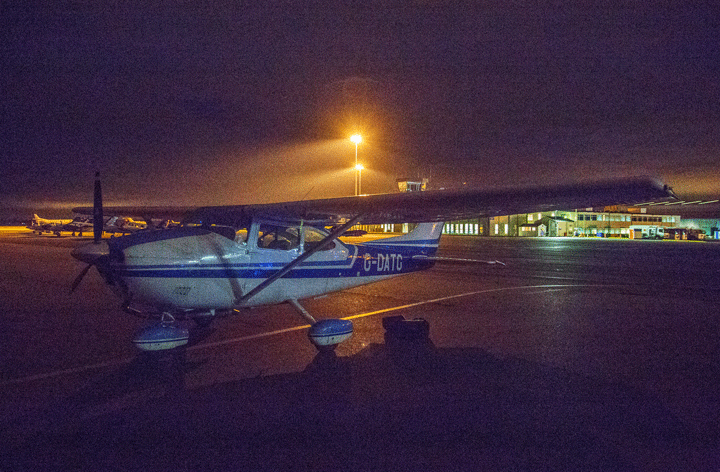 Farnborough help us Northbound through Odiham's MATZ then let us go after the M4 and we return VMC as we descend through 2700ft to descend in to Oxford. But as we turn for the Downwind leg I cannot see the runway. I can see 11/29 OK so I'm in the right place, but 19/01's lights must be off. What's going on?
Farnborough help us Northbound through Odiham's MATZ then let us go after the M4 and we return VMC as we descend through 2700ft to descend in to Oxford. But as we turn for the Downwind leg I cannot see the runway. I can see 11/29 OK so I'm in the right place, but 19/01's lights must be off. What's going on?
Make a messy base leg as I'm not quite sure where to turn, drop the speed, pop the flaps and finally, just as we turn what must be Final for 19, the lights resolve themselves and we're in the right place.
OK, well that was interesting.
Drop down the approach cone and get that little bounce again. Ah, it must be me. Of course I can blame my 1st Night Landing for a long time, but I hate less than perfect landings...
Still, my Night Rating is now revalidated and I can take passengers at night. Now there's a thought....
Cardiff Feb 15
We're all off to Cardiff for a GASCO Safety Evening. It's not often the four of us get to fly together, so this could be interesting. My Night Rating is recently validated, so I'm not going to fly; I can sit in the back and back-seat drive.
As the light fades, we meet at Oxford and pre-flight the plane. It's interesting to watch: the others fly as pairs normally so P1 gets himself ready while P2 does the pre-flight. I worry about them missing stuff between them; as I'm virtually always P1 I am happiest doing my own pre-flight.
The bowser comes and gives us some fuel, and we pile in. In the back it's snug but comfortable, even for my 6' 2" frame, and my spare pair of modified Sennheisers with ANR pack works magnificently.
I cannot overstate how much difference ANR makes to fatigue levels in the cockpit. These (modified in the USA) are as good as dedicated ANR headphones and a little more comfortable. I wish all headphones were ANR, it would make learning to fly less stressful.
As there are 4 of us competent and current pilots of course we all do things slightly differently and it's interesting to watch the others fly and do the radio and Nav. I would have done any number of minor things slightly differently or in a different order, but I'm unconvinced I'm right and they're wrong, or vice versa. Just different.
I do, however, learn better how the cockpit lights work (you can have them white or red) and the fact that there is a demister (didn't know that!); also the value of a really good LED light (must buy one).
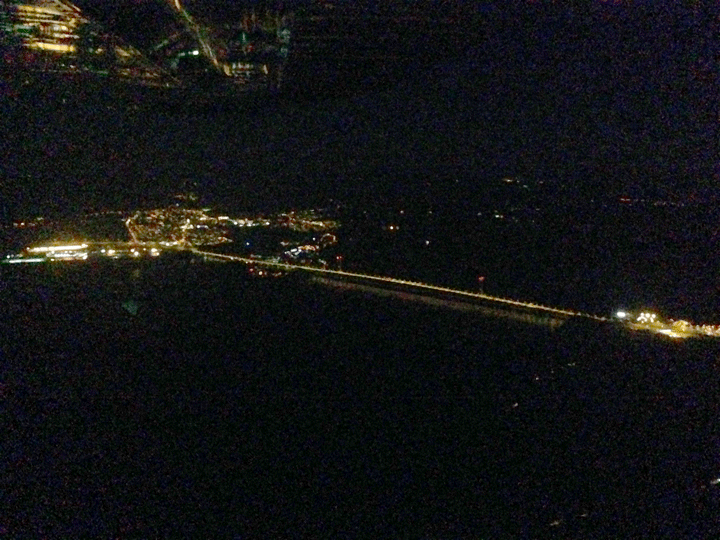 Descending in to Cardiff VFR via Cardiff Docks we get a surprisingly large crosswind component given that by the time we are on the ground it's basically calm, which reinforces my belief that the winds are never as forecast and different at every height, making Nav by turn/time/distance using a whizz-wheel ludicrously unreliable - radio Nav in its various forms is always the way to go: Nav beacons don't move.
Descending in to Cardiff VFR via Cardiff Docks we get a surprisingly large crosswind component given that by the time we are on the ground it's basically calm, which reinforces my belief that the winds are never as forecast and different at every height, making Nav by turn/time/distance using a whizz-wheel ludicrously unreliable - radio Nav in its various forms is always the way to go: Nav beacons don't move.
Coming back we swap and I do P2 and the radio. I like the challenge-response part of having a P2 doing the checklist with you, and it certainly takes the load off the pilot to have a radio-man. With 4 of us in the cockpit we are cross-checking the whole time and I reckon we are the safest plane in the sky (actually we are pretty much the only plane in the sky!).
We arrive back at Oxford just as they are packing up to go home at 10.30pm, we are the last plane in and the runway lights go off as we taxy in. It's bloody cold!
Weather cancellations and Risk Managment Feb 15
Winter can be frustrating: twice now I have been asked to take someone somewhere interesting on pretty short notice, and twice I have had to cancel because the weather has not played ball.
The first time was to Brive in France. The weather was absolutely fine at Oxford and at Brive, and flyable in-between, but frustratingly (as this was a very short-notice requirement) the Customs at Brive required 24hrs Notice and all the airfields in Northern France that would do Customs by just turning up or with a couple of hours' Notice were in the grip of a very strong wind that was way out of my, or indeed my aircraft's, crosswind limits. Very frustrating, but the Right decision.
The second was to Leeds and would have involved a Night Landing. Fair enough, and the weather in Oxford was just fine, but the weather on the way was heavy icing, embedded Thunderstorms (CB's) and, as it turned out, fog at Leeds (OVC001). I cancelled very reluctantly but again, it was The Right decision, even though the sun was shining when I had to make the call. He was a pilot, he understood.
When you are learning to fly and for a long time afterwards (maybe even forever if you only ever rent flight school aircraft!) your weather Go / No Go decisions are basically made for you: even when you turn up, look outside and think it's safe to fly you get that look that says "you're wrong, we know better", and you don't get to fly.
One of the things you do need to do when you are totally free to fly any time (with just a key and a Security Pass) is really learn how to read the weather forecasts. Not just for where you are now, but for where you are going, when you get there, for in-between and for when you get home again.
I use a combination of the Met office website https://secure.metoffice.gov.uk, the Aeroweather iPhone app and, when in France https://aviation.meteo.fr. I also use the weather feature in SkyDemon where, just by opening the program it shows you which airfields are VFR, IFR or marginal.
And I have set my own personal minima which are fairly conservative but based upon real weather, not mumbo-jumbo.
A couple of times I have been in situations where I was "up there wishing I was down here" but on the whole, although I have occasionally flown in some pretty dire conditions, I now often get to fly when I am the only aircraft in the sky, and often wonder why as it has been perfectly pleasant.
I have flown when the weather forecast shows surface winds of 44Kts (that's 50mph) but they were straight down the runway, so I went flying. It was a bit bumpy but perfectly safe and the landings and take-offs were unbelievably short. In those winds you do need to raise the flaps before turning off the runway, taxy very slowly and keep the elevator pushed forward ("dive away from the wind" is the best rule).
But it's risk management, that's all it is.
Llanbedr 22 Mar 15
Llanbedr has an interesting history, and is in the almost unique situation of being a "new" GA airfield (the other one is Daedalus near Southampton) that has just opened. So worth a visit, then.
The first thing we notice is that the nosewheel spat has disappeared. We have had some issues with the shimmy damper, resulting in a vibrating yoke on landing and this has been replaced but during the process they broke the spat so it is being repaired. But the wheel looks naked and I'm sure we will lose 3Kts off the top speed...
We get the bowser to fill up our tanks, start up and depart West. I planned the route as a straight line between Oxford and Llanbedr, and amazingly there was no reason to alter the route so that is what we fly.
Climbing out North West, avoiding the Weston on the Green Active Drop Zone and Enstone, we climb to 4,000ft to get on top of the bumpy thermals and scattered clouds and it smooths out. London Info is busy, but everywhere else seems quiet.
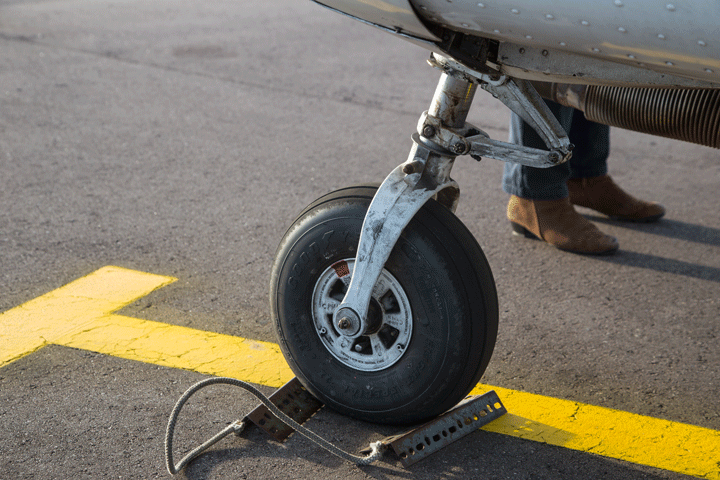
|
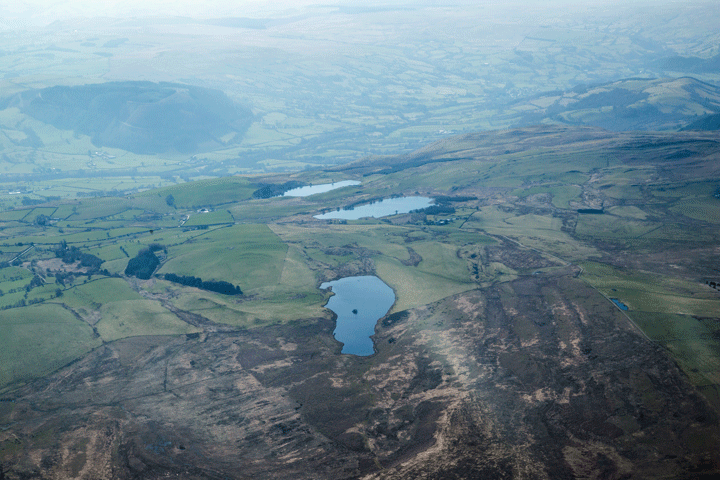
|
|---|---|
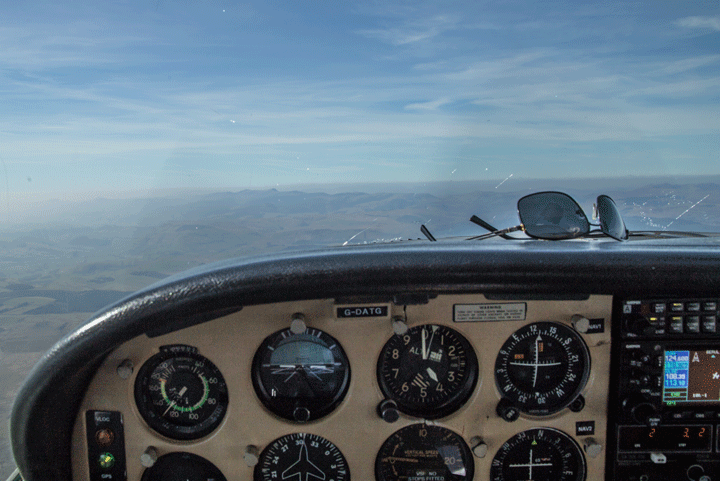
|
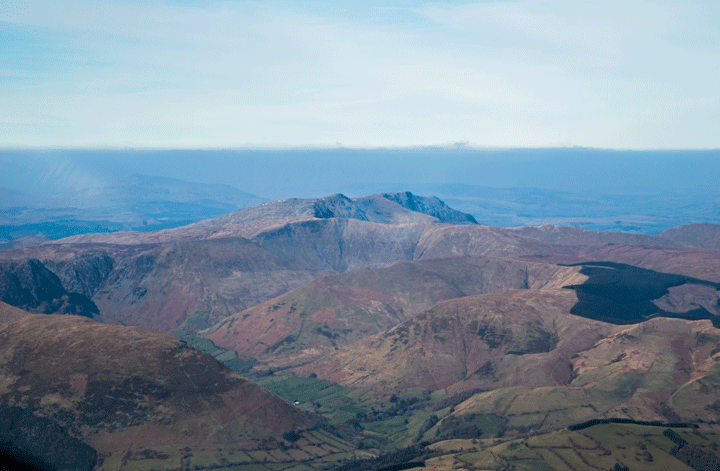
|

|
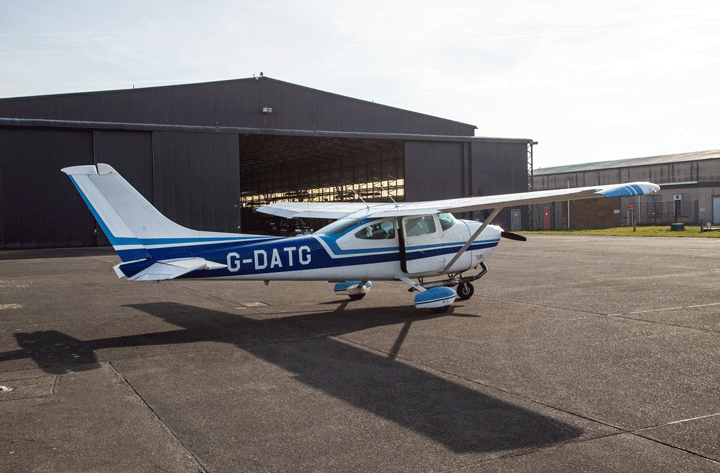
|
As we progress across Wales civilisation becomes thinner (as does London Info's radio coverage) until the hills finally rise up towards us, with forested and cleared areas, before dropping away to the Mawddach Estuary.
Over the last range of lower hills between the estuary and the field, descending fast now for Llanbedr we try a blind call, received only by silence and a call from a lovely yellow Tiger Moth who is apparently using 23 (but turns out to have been using 05), so we'll join crosswind for 23, descend to 1,000ft, swing out in to the wonderful blue sky over the sea and turn final for 23, blind call Final and sink over the beach on to the tarmac, roll out (which seems to take a while.... ah, we have a tailwind) and stop, back track, turn on to 33 and head for the North apron where we park and are met by the proprietor.
They are re-opening the airfield for GA use, aviation-related industries and UAV (drone) work, in conjunction with Aberporth further South. And the airfield is perfectly suited for that (or even a UK space port, as has been suggested, except that the road links to that part of Wales are risible...) being remote and close to a large body of water already covered by Danger Area legislation.
But at present they are hampered by the desire to keep airside and the catering facilities separate sides of a dirty great gate they keep padlocked, so every time you want to pass through they have to laboriously escort you through, unlocking then relocking the gate. Aircraft parking to the South of the big hangars (or even on the grass near the café) coupled with an airside-accessible café door / gate combination would solve that with a day's worth of work and a little imagination. Then a 2-way radio and some aircraft parking signs and it becomes a good GA destination. The beach looks empty and inviting, they just need a really good restaurant there and it has the makings of a Compton Abbas or a Dunkeswell - a GA destination you want to go back to.
Exiting the Boeing 747-sized apron we taxy the short distance to the end of 15. As there is no appreciable wind today we power-check in place and roll 15, lifting off before the intersection and maintaining Vx on the runway heading before turning left in to the hill, avoiding the local village then paralleling the climbing terrain (we can just turn downhill if anything coughs or splutters) until we are clear of the top, then back over the Mawddach Estuary and continue climbing over the big hills. Two up in a C182 gets us to 4,000ft before we are in any danger of terrain and we turn back on our inverted course.
The sun has gone behind the clouds now, and everything is milky and hazy as the landscape lowers below us, towns appear, then roads, Malvern and finally the M5. We swap back from London Info to Oxford, start our descent at 15 miles and ask for a left base for 01.
Five miles out Oxford decide they'd prefer us joining crosswind, so we arrive over the take-off numbers at exactly 1500ft QNH, turn and call Crosswind, then Base, then Final for an unhurried approach. And today I will be mainly doing a little bounce..... where did that come from? Only a few inches I think, it drops straight back on, but I slightly misjudged the rate of descent in the last few feet.
And I was doing so well....
"Forget this aviation lark... you're in my world now" Ditching Seminar Mar 15
If you fly any aircraft (single- or multi- engined) over water you need to consider the consequences of engine failure. A twin-engined aircraft may well give you merely the opportunity to choose a different piece of water to ditch in to in the event of an engine failure, but as I know from personal experience, when the engine coughs you're going down somewhere...
Every year GASCo (the General Aviation Safety Council) and the RNLI get together to do a pilot's ditching seminar, firstly to improve your pre-ditching planning but most importantly to give pilots practical experience of what it's like to be in a rough sea in a lifejacket and possibly a liferaft.
And, like a lot of training, this could save your life.
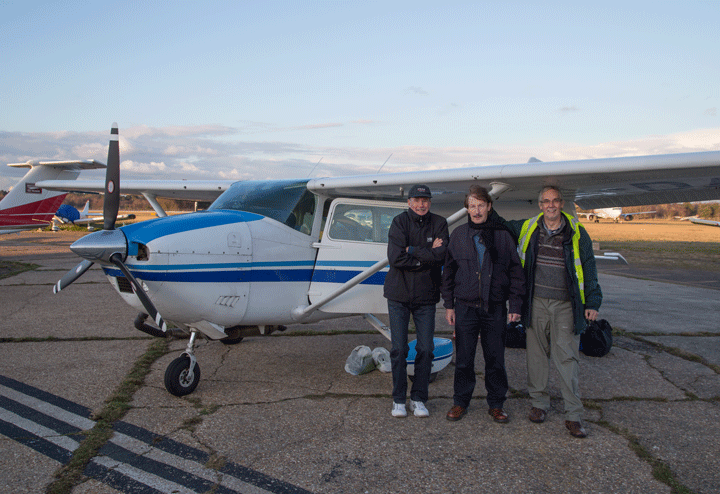 We fly Tango Golf down to Bournemouth on a cold Tuesday in March - I will fly down, Chris will do the radio, and we'll swap on the way back.
We fly Tango Golf down to Bournemouth on a cold Tuesday in March - I will fly down, Chris will do the radio, and we'll swap on the way back.
By the time I arrive Chris has pre-flighted and we are ready to start, so a quick P1 checkover (I flew this aircraft 2 days ago, not that much will have gone wrong that Chris will have missed - I've seen him pre-flight and he's very thorough) and we climb in and start up.
Once again our new "use the primer to keep the engine going until it has warmed-up" trick works well and soon we have a gently throbbing 6 cylinders ready to fly us.
Taxy out, take off and head South, swap to Farnborough, swap to Boscombe (who aren't awake), swap to Bournemouth and descend over Stoney Cross in to their Zone for a Right Base for 26. The winds are light but there is roil and bounce as we descend, it gets quite rough on the approach until we flare and land smoothly but long, requiring some hard braking and a short backtrack.
Then a long and involved taxy to Bournemouth Handling (£60? For a piece of tarmac for a day? How can they justify that? Not even a cup of tea for £60... Daylight Robbery. Bournemouth, your card is duly marked), shut down and grab a taxi to Poole.
After a morning's seminar (20 feisty pilots challenging our Instructor's every assertion, and him giving as good as he gets) where the absolute importance of having a working 406MHz GPS beacon on you is drilled in to us (rescuers can then pinpoint your position to 30m), we lunch and change for the pool.
It's a big, deep pool and we don normal flying clothes and lifejackets, deliberately identical to the ones we have in the plane, then jump in (COLD!), inflate our lifejackets for real (great practice - I learn to do the crotch strap and the stomach strap up tight or the bladder rides up your neck and tries to strangle you...), learn to conserve heat (foetal position, stop swimming, conserve energy and heat), then join up to conserve even more heat.
 Then they close the curtains so it's dark, ramp up the waves to a Force 4, add cold water hoses and a wind machine and it gets cold, miserable and exhausting very quickly. As one of the very helpful RNLI divers accompanying us in the water so we don't actually drown says: "Forget this aviation lark... you're in my world now...".
Then they close the curtains so it's dark, ramp up the waves to a Force 4, add cold water hoses and a wind machine and it gets cold, miserable and exhausting very quickly. As one of the very helpful RNLI divers accompanying us in the water so we don't actually drown says: "Forget this aviation lark... you're in my world now...".
And he's right. Life expectancy: 1 hour or so.
Then we get out, throw liferafts in the pool and get them inflated, learn how to turn them over if they capsize then practise getting in to them. Now I've done a bit of diving so I didn't actually find this too difficult but the secret is definitely getting the strongest person into the liferaft first, then he/she can pull the others in.
 Once in, we huddle up, bail out the water (use a shoe if no bailer is available) and zip up the cover. It's surprisingly warm and you're out of the spray, you get knocked about a bit but it's much more comfortable and warmer than being in the water. Life expectancy: 10-24 hours, enough to get you rescued in European waters.
Once in, we huddle up, bail out the water (use a shoe if no bailer is available) and zip up the cover. It's surprisingly warm and you're out of the spray, you get knocked about a bit but it's much more comfortable and warmer than being in the water. Life expectancy: 10-24 hours, enough to get you rescued in European waters.
With a reverse-osmosis water pump for some fresh water, and a smooth-ish sea you could probably be reasonably comfortable while the choppers or lifeboat come to get you. And with a GPS beacon they will (without one? Forget it...)
A hot shower, dry clothes, a steaming mug of tea and some cake later we have just about stopped shivering, and we all agree that we now have a greater respect for the sea, greater confidence in our ability to survive a ditching and actually get rescued and a determination to ensure we have the right kit in the plane, and the right procedures in our minds for when it really does happen.
The taxi takes us back to Hurn where jump back in to the plane as the light fades, taxy out and take off North for Oxford, swap to Farnborough and then Oxford, join Right Base for 01 and Chris plops us on 01 with a minimum of hassle and we put the plane to bed.
We all sleep rather well.
Local 10 May 15
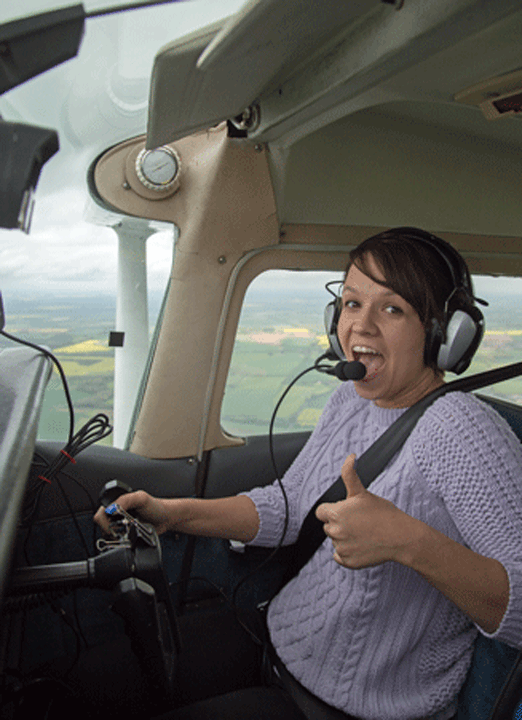 I'm taking Matt and Issy out today: they both want to have a go at flying the plane and we'll show them some countryside. But Matt claims he gets airsick, so we'll need to be careful: Airliner mode today...
I'm taking Matt and Issy out today: they both want to have a go at flying the plane and we'll show them some countryside. But Matt claims he gets airsick, so we'll need to be careful: Airliner mode today...
Our nosewheel spat is back and repaired from the 50hr check: seems solid enough, so we'll put Matt in the P2 seat, show him where the sick bags are and take off.
It's a bit bumpy today, but smooths out as we climb out over Blenheim Palace gardens (what a view...) and on to Charlbury where the National Caravan Club are setting-up their annual bash in the park. Our blue fibre broadband connection is visible from 1,500ft and seems in one piece so we can move on to giving Matt a go.
He's happy making it go in 2 dimensions, but once we introduce "up and down" to the equation he struggles, so I take it back and fly them around Moreton-in-the-Marsh and Hook Norton. He's far too busy looking out of the window to feel airsick, which works well, so we slowly swing around towards Banbury, then ask for a straight-in approach for runway 19, slide gently down the approach explaining the PAPIs to him to keep him occupied and drop on, floating a little in the gusty conditions but a passable if long landing, I reckon.
We swap passengers on the North side of the apron so Issy can have a go, start up and taxy out.
This time we'll do it a little differently: 20° flaps and rotate at 60Kts, maintain 65Kts and we go up very quickly indeed, depart and head South over Oxford.
 The visibility is great today: some recent rain has washed the skies clean and Oxford looks particularly beautiful and empty, on a Sunday. They live in Temple Cowley so we'll take a look at that before swinging out towards Abingdon then over our house and Issy's parents' house near Marcham for a low and slow pass, then back to a safer height for Issy to have a play.
The visibility is great today: some recent rain has washed the skies clean and Oxford looks particularly beautiful and empty, on a Sunday. They live in Temple Cowley so we'll take a look at that before swinging out towards Abingdon then over our house and Issy's parents' house near Marcham for a low and slow pass, then back to a safer height for Issy to have a play.
Issy's Mum Ann has flown this plane before and likes to throw it about a bit, which is great fun if you don't have a potentially airsick rear-seat passenger but a bit problematic if you do.... Like Mother, Like Daughter Issy enjoys zooming around the sky and I have to rein her in a bit for the sake of poor Matt who is stiting in the back. He's OK for a while, but eventually I have to restrain her to airliner mode until his colour returns.
Issy flies us back over Oxford and we start to negotiate a VFR recovery for Oxford, but they are so busy with instrument traffic and with a pilot who keeps speaking French (huh?) we eventually end up orbiting near Beckley until we can get a word in edge-ways.
Approaching downwind there is a Seneca climbing on the crosswind leg, where is he? I don't want to fly in to him, or indeed him in to me. Tower asks if he can see me (I can't see him) and he says he can, so we roll in to Downwind, do the Downwind checks, reduce to 100Kts, pop the flaps and push for 85Kts, roll Base leg and Final, cruise down and this time we'll spot-land it, in preparation for Friday's bouncy approach / spot landing exercise.....
This works well and we drop on tidily with no bounce just a few yards past the threshold, but it turns out there is someone behind us wanting to do a land-after, so we'll need to expedite the rest of the runway, so dump the flaps, yoke forward and a bit in to wind and rev up to 45Kts, whizz around the corner and vacate left to the apron.
It's not until we exit the aircraft and attempt to put the cover back on that we realise it's blowing a hoollie out here; the cover makes a bid for freedom and we have to stamp on it to prevent an escape....
Stoned 2015-16
Once over 50 you need an Annual Medical because you're more likely to suffer bad health.
Fair enough, but trouble arrives from an unexpected direction.
I have been suffering with a kidney stone: nothing hugely bad that some anti-inflammatories and a hot water bottle doesn't ease, and am "in the NHS system" for an ultrasonic zap that will turn it to gravel so I can pee it out (which sounds a lot more dramatic than it actually is) but of course I have to declare it, and my AME promptly declares me unfit due to "Renal Colic" and won't let me fly without a Safety Pilot until I have a Consultant's letter stating that I am stone-free.
All this I can understand: no one wants an incapacitated pilot at the controls but what I know is that the pain incidents come on slowly, the anti-inflammatories are not debilitating and if I even got a twinge I simply wouldn't go flying anyway, so I think he has over-reacted a bit. If my medical had been a month ago I wouldn't have had to declare it and by the time next year rolls around it will have been and gone. All slightly unfortunate timing.
My worry is that I'd like to take the aircraft to France in July and NHS waiting lists being what they are by the time I have been through the CT scan....ultrasound zap....CT scan...declared clear procedure it could be September or even October. BUPA say they can do the whole lot in a day, which is heartening but eye-wateringly expensive.
We shall see. In the meantime I can fly but must have a qualified pilot or instructor in the right hand seat.
Local Mooney Jun 15
Bryan has a US-registered Mooney parked in a hangar at Oxford and asks me if I'd like a whizz around in it. I'm still in a post-medical funk so maybe a jaunt is the right thing to do.
This is an almost-new and extremely tidy aircraft with EFIS, synthetic vision, FLARM traffic warning, digital tea-maker and every other gizmo, but (warmingly) the cylinder temperature gizmo doesn't work. Aircraft are aircraft: there's always something wrong...
We climb in, I'll do the radio and program the EFIS, which is touch-screen and very easy to use, Bryan taxy's out and we take-off. Speeds seem to be quite similar to the C182: 75-85Kts climb out, then accelerate once the flaps are up and you're heading where you want to go.
We head out West overhead Charlbury and I take it. It feels a little more ponderous in roll than the C182 but then it has longer wings; like the C182 it needs a little bit of lead-in and lead-out rudder to stay tidy in the turns; the controls feel tighter because they are pushrod, bell-and-crank not wires; it's quieter (but then these are Bose X headsets) and the aircraft feels more powerful. Circling requires a bit more concentration from the right seat to keep the height spot on (bit of parallax error there and you're craned over to see the EFIS), then we head back, being asked to orbit North of Charlbury (I know where that is better than he does), then Oxford decline our "left base for 01" request and clear us for a crosswind join.
Bryan asks if I know how to do that in a tone of voice that suggest he has forgotten, but he's a US CFII so if he has, we're all in trouble. Anyway, the right answer is "easy: head for the take-off numbers" so that's exactly what we do, cross at 1500ft, roll right for Downwind, call Downwind, then descend on the base leg. Bryan tends to turn Final at around 600ft, whereas I usually err on the conservative side and turn at 900ft, but these are minor things. We fly the approach at 85Kts, he takes it as we pass through 300ft, he flares at 75Kts the same as we do and plops it on gently: the famous "Mooney bounce" being non-apparent. All very nice indeed.
The whole high-wing/low-wing choice is swings and roundabouts: high wing is better for sight-seeing but you do feel more boxed-in. That said, the cockpit ceiling makes you feel boxed-in anyway. Low-wing afficionados say you can see other aircraft better. Well, maybe, but you can't see them below you when you turn.
Certainly runway visibility in the Final turn is better in a low-wing: I'm usually craning forward in the turn to see the runway and know when to roll level, but once established it's an aircraft, and (besides the retractable undercarriage and the effect the flaps have on the trim) all aircraft are the same. Yes, with a few practises I could land it, and probably fly it solo as well.
Local 30 Jun 15
I'm damned if this Licence restriction is going to stop me flying, so on a sunny Tuesday evening Pete and I meet up for an easy low-stress evenings aviation. We decide to fly down to the Isle of Wight via CPT, round it and back home via NUBRI.
There is nothing to conflict except a drone over Blenheim Palace and so on departure we turn South and set up for Compton, climb to 3,000ft and switch the autopilot on.
I have noticed that the aircraft flies one wing low if you don't keep the ball very accurately in the middle so I am now concentrating hard on trying to keep it there all the time. I haven't bothered too much about minor variations in the past but I'm trying to fly a little more accurately now in every way (especially as Pete is an Instructor...).
We avoid Lasham where they are gliding and soon we can see the sea ahead.
The evening is drawing in as we swap to Solent, who are jealous of us being out on a nice evening like this.
We descend to 1,500ft to the East of Bembridge and gently ease around the South coast past Ventnor and over the the West side of the island towards The Needles.
 We can see CBs building South of us and on-frequency a Jersey flight requests own navigation to avoid them, then we see strange patches in the sky that look like.... ah, rain. Just a brief shower.
We can see CBs building South of us and on-frequency a Jersey flight requests own navigation to avoid them, then we see strange patches in the sky that look like.... ah, rain. Just a brief shower.
Turning North we shadow the East side of the Bournemouth Zone under the Solent Zone heading for Stoney Cross, but surprisingly we have a quite strong East wind blowing us towards Bournemouth, so have to change course East to avoid getting blown in to their Zone. That would be embarrassing...
Soon Stoney Cross hoves in to sight and we turn North East and climb back towards our normal 3,000ft cruise. Soon Basingstoke and Newbury are visible, then Compton and Didcot, so we swap back to Oxford and get a visual rejoin for 19, cruise-descend for a Join at 100kts and 1500ft QNH, BUMPFTCH checks, one stage of flap, then turn Base then Final and plop neatly on in the evening sunshine. Very pleasant.
Pete goes off to chat to another pilot, and actually it's really nice to be left alone to perform an unhurried post-flight shutdown of the aircraft, putting everything away and leaving it tidy, double-checking fuel, electrics and brakes are off, the going for a beer.
Compton Abbas 15 Jul 15
Stephen wants to talk about the complexities of running a shared aircraft group, so what better place to discuss it than at a remote airfield over lunch? He can be my Safety Pilot du jour and we'll go to Cherbourg.
Now we won't... it's Sunday and all the restaurants are closed. Typical.
Small change of plan: we'll go to Compton Abbas instead.
The aircraft is booked and we turn up to find... no aircraft?
Because it's the British Grand Prix today at Silverstone all the bigwigs have flown in to Oxford in their shiny bizjets and gone by helicopter to the track, so all the little planes have been moved to assorted parking areas. Ten minutes later we find Tango Golf lurking behind a hangar.
There is a lot gravel and some windows here. I think we'll pull it forward so we don't pebbeldash their windows when we start up...
I haven't seen Stephen for a while but as we start up and taxy out he gets that calculating look I know so well: he hasn't told me yet but I know he's got an Instructor Rating since I last saw him. All Instructors get that thoughtful look when they fly with you: they're judging you, which is no bad thing and I'm open to criticism (maybe!). By the time he finally admits it I've known for an hour.
We climb out South and watch a C130 dropping parachutes over RAF Abingdon. For some reason he's on Oxford's Approach Frequency (well, it's Sunday so Brize will be asleep). If he's not careful he'll drop them in my garden.
Turn at Compton, swap to Farnborough who want rid of us in 5 minutes to Thruxton, who allow us through their overhead and advise of paradrops at Old Sarum, so we swap to them and liaise a Northward swing to keep us clear of their drop before starting our descent in to Compton Abbas.
It takes me ages and I'm only 3 miles out before I can actually identify the airfield, which is embarrassing. But finally everything slots in to place and we're inside the approach cone and descending. There is a South-West wind causing some roil from the trees on the South side of the airfield. There is also a large tree directly under the approach which I know well we need to be virtually scraping with the wheels in order not to land 2/3rds of the way down the runway. So we will need to keep some speed on to retain control, then chop and pull as we sink in to ground effect.
As we come over the tree a sharp burst of turbulence requires ailerons to full lock, then it smooths out and we flare just past the numbers with no bounce, which is satisfying, brake gently, vacate and taxy over the bumpy grass to parking.
Now-instructor Stephen reckons I did it wrong: he says I should have taken a higher approach line over the tree carrying more flap for a higher descent rate. Maybe. I'm of the opinion that either solution works.
Compton Abbas are offering Trial flights and wing-walking today on a Stearman 75.
 With regards to the wing-walking, the old 10cc track "Clockwork Creep" applies: "oh, no you'll never get me up in one of these again..." (also heard briefly at the start of "I'm Mandy, Fly me" for the 10cc completists). I'm currently reading Tony Blackman's autobiography "Flight Testing To Win" (I used to work with Tony, and he's an interesting character) and he pretty much destroys the whole "tailwheel worship" theory: he'd fit everything with a nosewheel instead. What works for Tony works for me.
With regards to the wing-walking, the old 10cc track "Clockwork Creep" applies: "oh, no you'll never get me up in one of these again..." (also heard briefly at the start of "I'm Mandy, Fly me" for the 10cc completists). I'm currently reading Tony Blackman's autobiography "Flight Testing To Win" (I used to work with Tony, and he's an interesting character) and he pretty much destroys the whole "tailwheel worship" theory: he'd fit everything with a nosewheel instead. What works for Tony works for me.
Compton is packed with non-aviators, aviators, kids, young and old taking pictures, grannies wing-walking, people taking trial flights, motorgliders being blown around by the wind, and so on. This is a huge GA success story. If Oxford had a GA complex on the other side of the airfield they could do this too.
After a great lunch (Compton do great lunches) and a chat we start-up, taxy out, power check and enter 26, call rolling and roll. We get large amounts of turbulence off the trees again (which is of course what all the visitors have come to see...) but soon climb out over it and turn back for home.
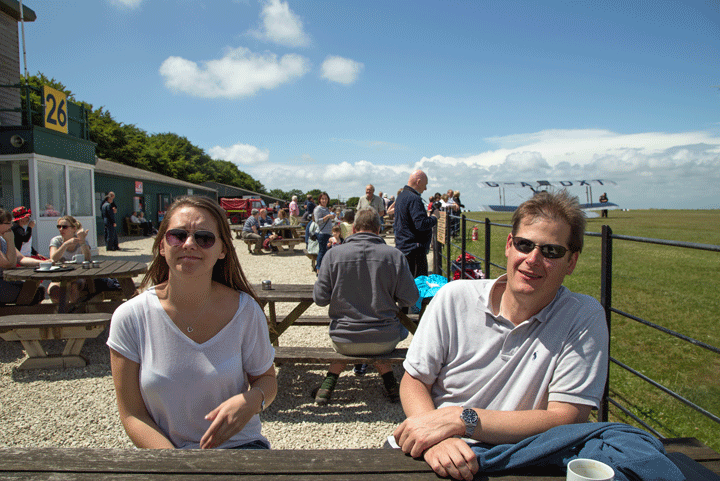 Solent are helpful as we thread between Boscombe Down and their Zone then turn North and try something new. Instead of talking to the very-busy Farnborough we simply do a Listening squawk 4572, avoid Lasham and fly at 2,900ft near Compton. Nothing to affect so we swap to Oxford and descend over Didcot.
Solent are helpful as we thread between Boscombe Down and their Zone then turn North and try something new. Instead of talking to the very-busy Farnborough we simply do a Listening squawk 4572, avoid Lasham and fly at 2,900ft near Compton. Nothing to affect so we swap to Oxford and descend over Didcot.
As it's a nice calm afternoon Stephen tells me has high expectations of my landing, which is of course fatal....
Oxford's visual circuit is busy and we are no.4 for landing, they ask us for an orbit Downwind and then a second one, which of course (Instructor Alert!) must be constant height and speed (and Rate 1!). Ah, I think I can do that (I have done that in cloud before, and actually it's easier with now external references to mess you up).
Oxford finally clear us in and we drop down the Base Leg, turn Final and ease down the approach, nail the speed and drop on smoothly (but to the left of the centre-line, something I do a lot), roll out and taxy in. He says that there is "nothing to worry about there, then" which I suppose is praise....
Local 20 Aug 15
Steve (who owns the shareoplane) and I have actually never flown together before: not intentionally, but I have just never flown him. So today I'd better do a good job, as he's an ex-BA Captain.....
He has suggested some circuits with Chris as well, so I'll P1 for the first couple of circuits then we'll all swap.
After a pre-flight (I'm not convinced Steve's checklist doesn't duplicate one or two things and miss out others) we start up and taxy out. The wind is 12Kts at 190° so landings could be good if I havent forgotten how!
As we start to descend for Base Leg they reckon I'm too high, but hey... thats' what I was taught, and we descend in to the approach cone, catch some downdraught over the last field which helps, then down to flare height and we'll flare gently for a smooth arrival. This one is really smooth to the point that the others ask what my secret is (which of course is "look at the end of the runway....").
We clean up and climb out, then round the circuit again for what I reckon is a 10/10 smooth arrival: we don't even feel the mains touch, just an increasing rumble as the wheels spin up. I'll hold the nose off as long as possible to alleviate any nosewheel shimmy, then brake smoothly for the runway exit. I think I've passed....
Chris takes over and his technique is different: a much more aggressive climb out, steeper turns (mine are all Rate 1, I cant do anything different now) and a lower approach, but he bounces it the first time round (although the second time is pretty good). Just different.
Unfortunately we don't get the Master Class in Circuits we are expecting from Steve as the oil pressure is a bit low, and we conclude that an early bed is in order while Airmed inspect the gauge. Probably wise....
Beccles 19 Sep 15
My kidney stone has been very painful.
Extracorporeal Lithotripsy (a fancy term for ultrasonic pulses beamed in to your kidney stone from outside) has successfully smashed up my stone but ejecting the gravel has had me in A&E twice, rolling around in agony.
Flying has been a long way from my mind....
During this enforced aviation-free period I have missed flying to a wedding in Southwold, and had to endure the A14 and the A12. 4½hrs each way in traffic versus the 55 mins it would have taken by air reconfirms my belief in GA as a form of transport. 3 separate people try to kill us during the journeys. These roads, they're not safe....
So today I will take John, who has his own aeroplane, out to Beccles where we would have gone for the wedding, rented a car and been relaxed about the whole experience. Beccles looks interesting: lots of parachuting (what? Jumping out of a perfectly good aeroplane?) and allegedly a diner. Part grass, part tarmac, the runway has been cobbled together from bits of an old airfield. I can't believe how the GA infrastructure in Britain is allowed to decay: it's amost as if the Government want to use the airfields for housing..... no, surely they wouldnt do that?
While we are departing Ops for the aircraft a Spitfire does a run and break at about 200ft down the main runway at Oxford. It's not every day you see that, but I think they are trying to visit each and every airfield as it's Battle Of Britain Day (or thereabouts). The noise is impressive.
But I'd need, let's see: a tailwheel Rating from Enstone on their Chipmunk, some time down at Goodwood on the Harvard, then and only then would they let me fly the Spitifire. I don't know whether I've got enough Biggles for that... Nice, though.
Start up, taxy out, depart North East. Now I'm reasonably procedure-minded, and one of my little procedures is that I get an ATIS before I taxy off, and I write down the ATIS letter, the runway and if Danger Area 129 (Weston-on-the-Green parachuting) is Active I write "D129" and a ring around it to remind myself not to go there. And today it's not Active. So imagine my surprise when Approach tells me we're about to infringe as we climb out. Huge apologies, and of course we high-tail it further East, but I have no "D129" with ring so either my procedure has failed or they've changed the ATIS (that I suspect).
We head East towards cranfield, then Cambridge, then South of Mildenhall/Lakenheath (schoolboy memories of American A10s taking off in the 1970s....) and soon the coast approaches. Beccles radio says "5 minutes to drop" and we have no desire to chop our way through a parachutist, so we will divert South a bit and turn North towards Lowestoft over the coast before swinging round towards a long final for 27.
 After a month of not flying my landings are often long, but Beccles is short and we will need to be slow and really accurate, getting the wheels on to the grass well before the start of the tarmac. Pull full flaps, slow to 65Kts, be really accurate, flare over the starter extension so the wheels touch on the start before the numbers, get a satisfying buzz from the stall warner (more of a "you are now stalled" warning on this aircraft...) as we touch, keep the yoke all the way back for maximum aerodynamic braking and minimum nosewheel shimmy, a little gentle braking and we're stopped with plenty of room to spare. I reckon that was about 350m; not bad (although I have done better).
After a month of not flying my landings are often long, but Beccles is short and we will need to be slow and really accurate, getting the wheels on to the grass well before the start of the tarmac. Pull full flaps, slow to 65Kts, be really accurate, flare over the starter extension so the wheels touch on the start before the numbers, get a satisfying buzz from the stall warner (more of a "you are now stalled" warning on this aircraft...) as we touch, keep the yoke all the way back for maximum aerodynamic braking and minimum nosewheel shimmy, a little gentle braking and we're stopped with plenty of room to spare. I reckon that was about 350m; not bad (although I have done better).
Beccles has a good diner, although it is hard to find, and they do a good fry up even at 3pm, so suitably filled-up we return to the aircraft, dip the oil and... it's 6quarts. We started with 12quarts 55 mins ago.
We have had this before, when I parked the aircraft on a slope in Scotland, but this field is as flat as a pancake, so where's all the oil? No skid marks on the underside of the aircraft, no marks around the filler or the dipstick, so it's burned it (if it's gone at all).
OK: quick decision as they are 5 minutes from dropping and we need to be gone now or delay. Grab a litre bottle (very roughly 1 quart), fill her up, then start up and watch the oil pressure: any weirdness and we'll shut down. But no, it's OK, so we taxi to the end, power-check, line up and go.
The acceleration is slow on the grass and this runway is short so I've dropped the flaps for a short-fielder and I pull her off at 60Kts, but she's flaccid and won't really climb, the pre-stall airframe noise just there in the background, so nose down and accelerate in ground effect, drifting to the left a bit much for comfort before we hit 65Kts and climb away. What happened? Too little flap, that's what happened. Parallax error and hurry gave us 15° flap not 20°. Not the end of the world but unnecessary: slapped wrist.
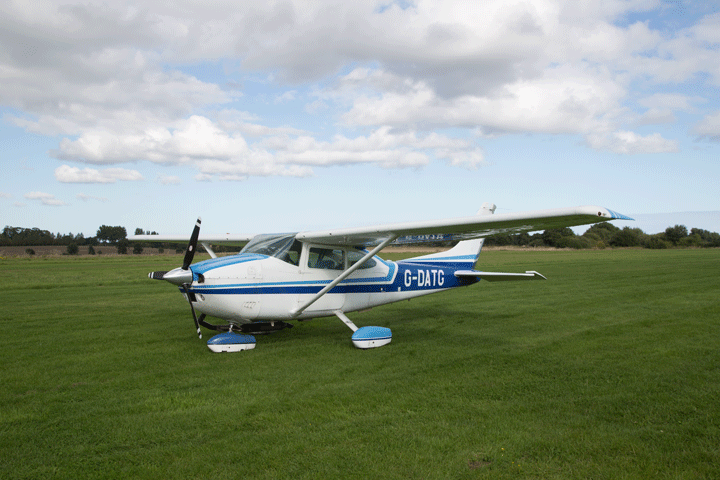 Clean up at 1,000ft and I'll get John to fly us home while I watch the oil pressure and CHT. And it is dropping just below where it normally is: there is something going on.
Clean up at 1,000ft and I'll get John to fly us home while I watch the oil pressure and CHT. And it is dropping just below where it normally is: there is something going on.
We swap to Lakenheath (A10s!), then Cambridge, keeping an eye on the runways as we cruise West in to the lowering sun: all the lights go on and we make sure we can see the runway at Cranfield. I've decided we go Precautionary if the oil pressure drops below 50 or the CHT hits the red line, but both values stay just within limits and all else seems smooth so we cruise back to Oxford for a left base for 19, drop down the approach and plop on for a roll out.
Something is definitely awry, which as Steve is planning to take the aircraft to France tomorrow is not good news.
Intermission Sep 15 - Mar 16
The NHS is an amazing institution, medically.
They offer the very latest treatments free at the point of delivery to all UK citizens, random EU and non-EU travellers and healh tourists from other nations.
But their bureaucracy is legend and trying to get an "All Clear" letter in my hands (actually in my AME's hands) has taken twice as long as actually getting the kidney stones treated. We have had scans, letters and appointment notifications lost, scans misread and lots of "x is on holiday" messages. If it ever recurs my AME will be the last person ever to hear about it...
Like many pilots I can only assume the medical profession is the enemy of aviation - despite clear evidence of a lack of recurrence I still have a restriction on my Class 2 forcing me only to fly with another qualified pilot 6 months after the treatment.
And Tango Golf goes in for its Annual, the maintenance company goes broke and the aircraft is trapped inside the workshop.
Local 14 Mar 16
Tango Golf has at last been rescued from the broken maintenance company and re-certified as Airworthy, 5 months after entering maintenance.
Despite a full medical recovery I'm still restricted to dual-pilot flying - my AME just won't believe I'm safe. I do have a promise from him that come July provided I continue to have a clean bill of health he will lift the restriction, so I will hold him to that.
In the meantime, let's re-familiarise ourselves with this strange thing I used, 6 months ago, to be able to fly (and occasionally quite well...)
The wind has done something strange today: it's coming from the East and it's quite surprisingly strong, so once I have removed the errant cover (which makes a bold bid for freedom) and pre-flighted, Pete and I have started up we get the ATIS which shows the wind at 18G25KT direcly across runway 01/19, outside crosswind limits for the aircraft.
Now I would normally give that a go as I have a lot of experience with this aircraft, 01 is a long runway and we'd just land fast and wing-down plus crabbed, but after a 6-month hiatus I don't think I'd be confident in doing this. That would be poor decision-making.
Oxford has a shorter, cross-runway oriented 11/29. I've used 29 but never 11; neither Pete nor I have ever used or seen anyone use it. But it's there, and the Tower give us permission to do circuits on it. So for my first flight for 6 months we're going to be operaing in to a gusty, short, unknown runway. Lovely!
We taxy all the way up 01 with the ailerons cranked right over to keep the wing down (it's gusty and i can feel it rocking the airframe), turn left to the end of 11 and power-check in the engine test area.
From here the wind is strong but roughly aligned with the runway so we get clearance and roll. Expecting (and getting) a pretty rough ride for the first 400 feet of the climb we slowly emerge in to smoother air and take a rough guess at where the turn to the crosswind leg should be. Using the compass rose to estimate the bearing for the 4 legs of the circuit, knowing the runway orientation works, as does simply adding 90°, so crosswind becomes 200°, downwind 290° and Base 020°. Let's see if that works....
It does seem strange turning across the main runway and calling Downwind but we're settled at 100Kts and 1500ft without conscious effort so something must have remained over the last 6 months' layoff. Half-afraid they won't let us do circuits on 11 for noise abatement reasons we call for a Touch 'n Go and get clearance, so roll right over the monument at Blenhaim Palace (what a view!) and start our Base Leg descent.
Turning Final for 11 presents an interesting perspective: it looks very short. It is in fact 760m, long enough for anyone, but drops away at the far end so looks like 500m. And there's a big tree I've never noticed before, right in the way.....
The wind fights us as we drop; I've found that if I try to think consicously too much about what I need to do rather than just feeling it, it all goes wrong, so instead we'll do it by instinct. Over the tree, big control movements to counteract the gusts, then we're over the threshold, pointed more or less in the right direction and at the right height and it's smoothed out, big heave as our shadow descends to the side of us and we're on; no bounce, just tidy.
Flaps up, smooth push of the throttle so no rich-cut, lots of right rudder as the power comes on and we're at 65Kts and rotating in 200m or so. Fight the gusts on the way up then round we go again.
And it's all come back. I cant hold a heading and chat, but it's all becoming more familiar, even the approach view. Pete reckons I'm too close to the tree so the next time I come in a little higher, then roll off the throttle as we pass over the tree so we drop on a little earlier. Ah, he's right, it did work better.
By the 4th circuit I'm getting cocky: we've had 3 very acceptable landings and I'm a little close to the Brize Zone on the crosswind leg so we need to turn pronto. Roll in 60° of bank and pull a bit to get her round, this is fun again. Nail the Downwind leg, nail the Base leg and roll Final for a full-stop. Over the tree, roll off the throttle and we're down... with the upwind wheel coming up due to me not having enough into-wind aileron before I crank it in and we drop on properly. Well, that'll teach me to be cocky!
Taxy in and I feel thoroughly re-familiarised and ready for anything. I'm not, of course, but at least I'm safe. And now I've landed on, and taken off from, all 4 active runways at Oxford. Not many can say that.
Kemble 25 Mar 16
Easter is a 4-day holiday but of those 4 days, 3 are forecast to be absolutely dire weather, with high winds, rain and even lightning as Storm Katie blows through, round and round and finally releases us just in time to go back to work on Tuesday.....
So Good Friday is the only solution, if everywhere is open....
Safety Pilot....Tick: Willie is free
Oxford Ops.....Tick: they're open
Kemble...........Tick: they're open
and finally....
The AV8 restaurant....Tick: they're open
So we pick up Willie at 1.30pm, park up, pre-flight (loads of fuel for a "round the zone bimble"), fire up (now apparently Oxford requires Start Approval; that's new but not a big issue), taxy out, power-check and take off Southbound.
Compton VOR is out of action at present (that's rare) but the GPS units can still use it as a turning point so we are OK for navigation (we can see Didcot and the A34 so that's not an issue). We're at 2,900ft deliberately because it's quite busy up here: we see three opposing GA aircraft and a glider in 10 minutes. Everyone is out...
We cross the looking for a client's house to photograph: ah, there it is. Willie keeps the aircraft rolled over so I can concentrate on some aerial shots before we roll out West for Kemble.
As we approach and swap to Kemble we find out where the world and his wife are headed to or from: Kemble has a decent restaurant and you can park outside, so everyone in GA in Southern England seems to have decided that tea at the famous AV8 restaurant is a good idea. The radio frequency is hugely busy.
We'd like a straight-in for 26 but they're so busy they need us to join overhead. Bit of a mental map in the head, then turn South to come in over the landing numbers at 2000ft, report overhead, descend on the dead side to cross again at 1000ft over the take off numbers, report crosswind, then downwind, stabilise at 1000ft and 100Kts, pop the flaps and turn for Final.
Now I usually make a rubbish job of landing at Kemble for some reason, I dont know why quite, but today the Landing Gods smile on us and the landing is... well, perfection. That'll never happen again!
Taxy in and park at the end of a very long line of visiting aircraft, shut down and go for tea. The weather is fantastic today.
By the time we are ready to return to Oxford most people have left, so we get an uninterrupted taxy down to A1, where we are immediately cleared for take off, so call "rolling" and accelerate, rotate at 65Kts and climb away, turn to the North and head for the North Leach roundabout (that unofficial VRP that everyone uses...)
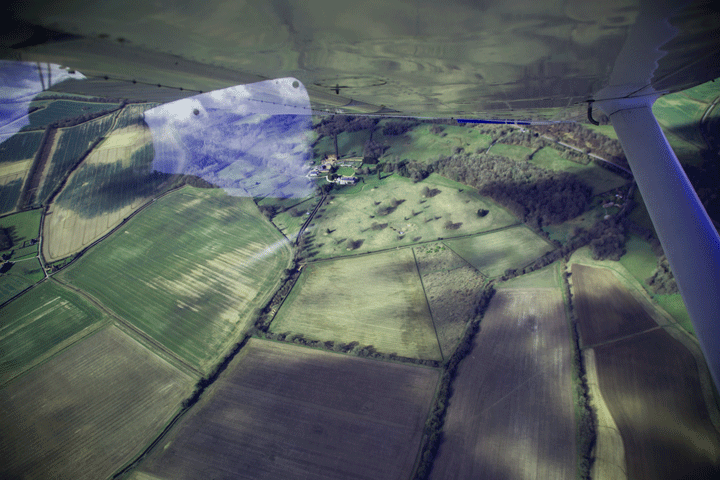
|
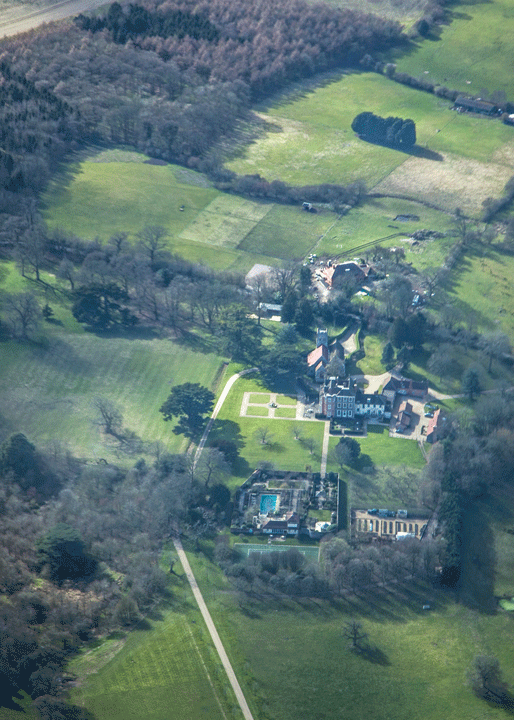
|
|---|---|
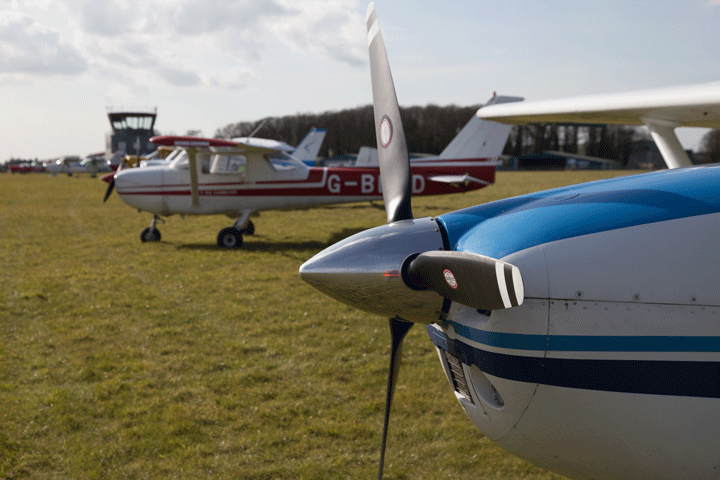
|

|
There is no point in bothering Brize (they'll be dozy anyway) so we'll swap back to Oxford (who are so quiet I wonder if the radio is working), start our descent for a Right Base join at 10 miles, call 4 miles, swap to Tower, get a Right Base join and turn Final still pretty high.
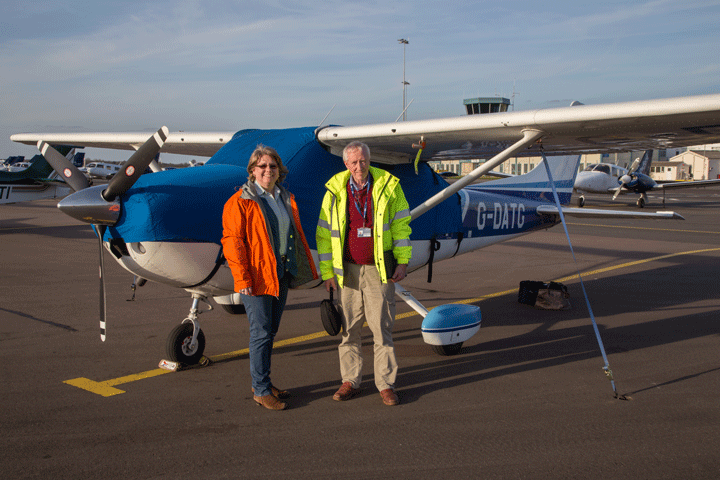 Roll the power right off and descend in to the correct landing cone, then come back on the power to stabilise things and plop neatly on a third of the way down 19 (and for once on the centreline, something I'm trying to concentrate on). Very satisfying.....
Roll the power right off and descend in to the correct landing cone, then come back on the power to stabilise things and plop neatly on a third of the way down 19 (and for once on the centreline, something I'm trying to concentrate on). Very satisfying.....
Taxy in and park bang on the centreline for once, tie it down against the vast winds that will sweep the airfield in the next 48 hours, pop the cover on and retire for a well deserved G&T.
And just two conclusions from the flight: my once-trusty Garmin 296 is completely dead - it won't recognise its own battery, and won't pick up any satellites, even with the external aerial attached and the trusty "reset location" fix every 296/496 owner knows.
And I really do need to get better at using the G430W.
Perranporth - Caernarfon 26 May 16
My SEP revalidation is due at the end of May, and my ongoing medically-induced lack of single-pilot privileges plus the 6-month aircraft availability drought has resulted in a less-than-12hr total for the last 12 months (don't get me started on AMEs, they are the single biggest threat to aviation...), so I need 4.1hrs P1 time in the next 3 days.
Let's see if we can do that in one afternoon without going foreign.
I'll borrow the genial Phil, who runs PFT's desk part-time, and we'll go on a nice big cross-country. I'll get him to fly some while I tinker with the 430W. I've been playing with the software simulator at length in the comfort of my own computer, but now is a good time to try the system for real.
I have always used my Garmin 296 as primary Nav, backed-up by SkyDemon on the GPS, a line on the map and VOR cross-cuts but now it's a little different. I can see better over the coaming without the 296 there, and I can stop worrying about its battery life. My iPad, however, will not charge off the cigarette lighter socket USB port, so we'll need a better solution for that.
We pre-flight (I see the mainwheel spats were removed for Steve's recent visit to the beach at Barra, and not restored), get the nice fuel man to "fill 'er up", and take off in to a sunny afternoon with fluffy clouds that indicate thermals; indeed it is quite bumpy as we track South for Compton. The actual VOR beacon is out of action (they are upgrading it) but we can still track to a virtual GPS copy of it.
But the 430W won't track - eventually we find out why: the flight plan I have inputted has ignored the start point of EGTK and gone straight to the next leg. In-flight removal and re-input of the flight plan eventually cures it, but apparently the correct way is to select the leg, then OPT and "fly this leg".
Turning right and heading For Bristol we opt to talk to Farnborough but they say we are too far West to interest them so we set a listening squawk for Bristol and track down between them and Salisbury Plain, getting bounced around by the thermals.
South of Bristol we track for Taunton, then talk to Exeter and head for Newquay as the weather rapidly deteriorates in to haze and low cloud. Newquay give us a transit through their ILS (not strictly necessary, but courteous and good airmanship) then we swap to Perranporth who tell us they are on 05 LH and refuse to answer any more of our calls, so we make blind calls which works just fine.
We could join crosswind and trundle around the circuit but there's next to no traffic so we call for a Right Base join, manoeuvre for Right Base, find ourselves a lot closer than we thought suddenly, so come right back on the throttle, drop to 100Kts, push the prop up for some braking and do a continuous turn in the descent as the flaps come in, very much like a PFL glide approach. It's extreme, but it's within the acceptable "I can get it in from here" approach cone. We do have a very high descent rate, but we cross the threshold looking sensible and lined-up, so big flare, hold off and we plop on a third of the way down, decelerate, backtrack and come off between the cones for parking.
It's surprisingly cold and windy here.
After an excellent bacon butty (they've kept the restaurant open for us) we put on our lifejackets for the trip over the Bristol Channel.
I've brought these and the liferaft - now I have a feel for what it's like in the sea post-ditching I know the secret is to be well prepared, so a proper ditching briefing and ensure the crotch strap is done up, then we depart on 05 (more blind calls) and just continue straight on past Newquay's ILS and in to the Bristol Channel where it's very smooth but hazy with no visible horizon and the autopilot fails to work, so I have to hand-fly it effectively IMC before eventually the Welsh coast appears.
 I've got the hang of the 430W now: Phil has been flying whilst I enter things and curse the interface, but so long as you use IFR reporting points when planning (Skydemon does these, but you have to turn the display on) it works just fine. It really needs a keyboard for ease of use: the Apple TV has the (largely undocumented) ability to use a Bluetooth keyboard and the 430W could do with just this. Entering the waypoints is decidedly clunky and the interface is inconsistent, but once it's set up it works well.
I've got the hang of the 430W now: Phil has been flying whilst I enter things and curse the interface, but so long as you use IFR reporting points when planning (Skydemon does these, but you have to turn the display on) it works just fine. It really needs a keyboard for ease of use: the Apple TV has the (largely undocumented) ability to use a Bluetooth keyboard and the 430W could do with just this. Entering the waypoints is decidedly clunky and the interface is inconsistent, but once it's set up it works well.
The sky is blue over Swansea and the Gower Peninsula but as we track North West the clouds build; we climb to be on top where it's smoother but as we reach the West coast it clears so we descend. London Info can't really hear us up here (although their coverage is better than it used to be, or maybe we are flying higher?) so we swap to Valley Radar (a new one for me) and descend to 2,000ft or so as the clouds close in from above, now hugging the tops of the hills. As we cross the last saddle before Caernarfon (TERRAIN WARNING from the 430W) Valley advise us of fast moving traffic right to left below us (and our ground clearance is not much more than 1,000ft at that point). We never even see it (it was allegedly a Hawk).....
Turning to follow the coastline we swap to Caernarfon, join Crosswind then do a nice tight "no other traffic to affect" circuit and line up for Final over the caravan site and down to the threshold of 25, flare, touch and for a second or so it just feels floaty before we feel the weight fully on the wheels. We didn't actually bounce, but I didn't quite get the smooth arrival I had hoped for. A bit of rubbish coming over the hangars? Or just "you can't get it right every time" probably more likely.....
Taxy in for some fuel (you can never have too much of that...) next to the SAR hangar, then park up for booking-in.
It's really cold and quite windy here, but everyone is very friendly.
We fire up, input the last flight plan (I'm good at this now) and taxy out for 25, take off over the amazing beach and turn South East for the saddle. The clouds have really come down now, so if I can't get through VFR we'll climb for MSA over land (or if all else fails, over the sea) then climb IMC to get on top. I'm not going to bounce around through this all day...
It gets worse as we climb and starts to rain, so we'll put the prop back in and climb for some sun. The cloud is surprisingly thick, and this is good IMC practice anyway, we've no reasonable height limits here (the Airway above starts at FL145) so we keep climbing until at 6,500ft we pop out on top in to bright sunshine, one of those wonderful rebirth experiences known only to instrument-rated pilots, then level out to skim the tops for some sensation of speed.
The cloud lasts a surprisingly long time given the weather forecast and we are well East of the M5 and near Kidderminster before it finally does break up to reveal the ground far below.
Say goodbye to London Info, swap to Oxford and track far North of Little Rissington where the NOTAMs say we need to, to avoid their parachute dropping. Oxford are on evening duty by now and aren't bothered what we do so long as we report at 5 miles.
So we track East towards Banbury and try out the PROC button on the 430W, selecting Vectors to the ILS which gives the CDI on NAV1 the correct steer-left indication, given our 30° cut to the ILS.
Weirdly, swapping between that and the VLOC (ILS) guidance gives a steer-right, which is just plain wrong. I can pick up the morse on the audio channel so I know we are within range, and eventually as we get closer the NAV flag disappears and it switches to the correct steer-left indication.
We can switch back and forth between the GPS-derived Localiser and the "real" ILS-derived Localiser and get the same indication, which is comforting.
What I'm unsure of is whether I should believe the GPS-derived glideslope info, so we'll use the real one.
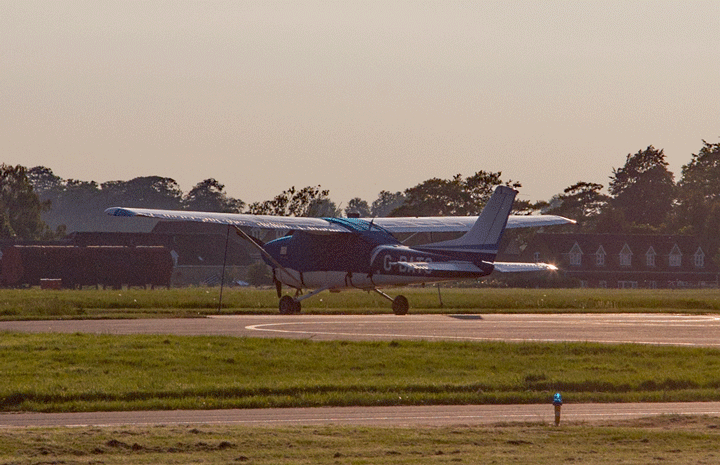
Phil is my Safety Pilot so I can keep my head in the cockpit, drop to 100Kts and watch the glideslope come in from above, tweak the bug and hand-fly the ILS. At 4 miles we get a clear-to-land so continue down to 1,000ft where I elect to go visual and... oh, look, there's the runway. Always a neat trick.
Full-flaps for a short-field landing, all the way back to 65Kts over the threshold, then plop on with a bit of a squeak (more practice needed there), roll out (this is a long old runway when you've done a short-field approach), exit and taxy in.
It's warm and sunny here, much nicer than Wales.
So we've had a huge variety of weather. 4 seasons in one day as they say.
I now have the required 12hrs and a bit to spare and a total of 400hrs, worth a bit of reflection.
Local 29 May 16
Every 2 years we need an hour with an Instructor, not for anything specific other than for him to check you're still safe. Bad habits do creep in....
So this Bank Holiday Sunday afternoon after everyone else has gone home Brian and I will go out for an hour to experiment with the 430W and the autopilot, do some stalls and PFLs and anything else that crops up.
It's a beautiful afternoon with a thin layer of broken cloud at just under 3,000ft: we take off and discuss EFATO options as we climb. He reckons if you lose the engine before you turn crosswind on the climb out it's best to do the 30° rule and find a field as opposed to trying to turn back to the runway. To prove this we do some power-off 180° and 270° turns to see how much height we lose, which is about 600ft plus a mile back to the runway. Fair comment, and a good, simple rule to work by in times of emergency.
It's very smooth as we scoot about at 120Kts above the clouds, experimenting with the 430W linkage to the autopilot, which does actually seem to work provided you aren't more then 30° from the track heading. It does seem a bit hit-and-miss but exciting: I like the idea of the A/P flying Holds in bumpy clouds for me.
Then we try some stalls, so HASELL first, a couple of clearing turns and then pull up for a clean stall (piece of cake), a 20° flap stall and a full flap stall (42Kts on the ASI !). These are non-events so Brien throws a curve: simulate a Base-to-Final turn and stall it there (the classic "Coffin Corner" scenario). Now this I haven't tried.
It does require a hell of a pull to get a C182 to stall at all, and Brien is amazed at the amount of pre-stall airframe whistle we get, but eventually it does stall and as normal just requires a quick but hefty push to unstick it and no aileron or rudder input required. Height loss? 300ft max, so as I always turn at 1000ft and am very aware of the scenario that's not too much of a worry.
Then we pull the throttle and pick a field. He does come up with a wise comment: never turn away from i.e. lose sight of, your chosen field. A descending turn, with S turns if you are too high, will allow it to alwys be in sight. As normal, it looks too close when we start and begins to move away but as I straighten out for the landing at 400ft he agrees we'd make the field and we pull up, although he says high crops such as this field are less suitable than low crops (such as the one I put TG in a couple of years ago...).
So we next try the classic "the GPS has failed, do a VOR crosscut to find where you are", which works well once I've set the plane up to fly straight and level so I can concentrate. We try a "one VOR and DME" scenario, then a "2 VOR" scenario, both of which agree well enough to put us within a 5-mile box, so we plot a course back to EGTK.
This is fun, scooting around the countryside in an airframe I'm very comfortable with but our time is up and we turn back towards Oxford. We're much too high for a crosswind join for 01 so a power-off 360° orbit deals with that and we join Crosswind, turn downwind and settle in to Final before flaring for a (nearly) perfect arrival and taxy in.
I've learned plenty, Brian and the CAA are happy, now we just need to kick the AME.
The Medical fight 2016
So here's the inside deal on your Class II Medical. If you have anything medically wrong with you that requires you to tick one of those little declaration boxes, Just Say "No".
They will ground you, and once you are grounded, you stay grounded. AME's can't cope with getting people back in the air. It's a one-way street.
If you're concussed, cancerous, psychotic and on more pills than Jimi Hendrix for it all, don't admit it.
Because the hassle involved in getting a restriction removed from a Class II Medical is unbelievable: even when you can prove you are medically cured your AME will not believe you will remain cured, so he will extend your restriction "just in case". Question that and he will extend the restriction. Remember school?
If you can manage to nail him down to accepting a second consultant's expensively obtained proof of your continuing curedness, he will suddenly be "on holiday" and then "on Jury Service" and unable to remove the restriction "any time soon".
We both agreed it would be sensible for me to go elsewhere. We had 2 e-mail rows, a blazing stand-up row in his office (not something you see every day, and I'm a pretty mild-mannered bloke...), then a full and frank exchange of views by e-mail between me here and him on his yacht in the Med (which more or less encapsulates the problem).
I have never in my life experienced a more pig-headed, unreasonable, unhelpful professional. How he keeps his job I cannot understand. The moral of the story is don't use an ex-military AME, they are martinets.
So I fired him.
I request a second opinion from a more reasonable AME who looks carefully at my notes, shrugs and says he can so reason for me not to fly P1 and signs me off with immediate effect. I should have gone to him months before.
Postscript: it turns out that following the stand-up row with me my original AME decided dealing with all those pesky amateur pilots was more trouble than it was worth and opted out of the program, which I think was probably a sensible thing for all concerned.
Bye Bye Tango Golf
Sadly, a week before the eventual return of my ability to aviate I get the devastating news that Steve, the owner of the plane, has run it through a hedge off the end of a wet grass strip and written it off.
So what now?
Enstone Tiger 8 Aug 16
I have been offered the chance to fly a Grumman AA5 Tiger with a view to buying a share: a 180hp low wing tourer with a fixed prop and slide back canopy.
On a sunny summer afternoon we meet at Enstone, which immediately strikes me as a much more relaxed airfield than Oxford.
There are aircraft of all shapes, sizes and states of repair clustered around a huge and surprisingly well-maintained runway sensibly oriented for the prevailing winds in Oxfordshire (240° at 15 Kts being the default setting...).
 No hi-viz jackets, no waiting for ATC to clear you on to the runway after the landing aircraft that is still 10 miles away, just an AFIS and actually no one ever seems to be in the tower at all....
No hi-viz jackets, no waiting for ATC to clear you on to the runway after the landing aircraft that is still 10 miles away, just an AFIS and actually no one ever seems to be in the tower at all....
Cheap to fly from, more like aviation should be, even if it occasionally resembles a junkyard.
The Toiger has a peculiarity that makes it different from the contemporary and ubiquitous Piper Cherokee: it has no nose wheel steering; I am told this can be a problem with ground handling.
After a thorough pre-flight and pre-start checklist we fire up and I learn to taxy.
Within a few minutes it becomes apparent the differential braking differs little from the C182, and once the engine is throttled up for take-off you immediately get rudder authority, so where's the issue?
Rotate at 60Kts and climb out, it's got a very long nose but a good rate of climb. But it needs a wobbly prop: it accelerates smoothly to 130Kts but then you have to throttle back in order not to rev the nuts off the engine.
 My right-seat passenger, the owner, is very familiar with the aircraft and chucks it around with nonchalance before, however, pulling off an absolute banger of an arrival.....
My right-seat passenger, the owner, is very familiar with the aircraft and chucks it around with nonchalance before, however, pulling off an absolute banger of an arrival.....
OK, let's see if I can do better.
Approach nailed at 70Kts, we'll call Final, chop the throttle over the fence and hold her off as long as possible, eyes down the runway and.... that was very smooth.
Let's see if we can do another one.
And yes: the same inputs give the same result.
Which is actually quite surprising as I've never flown this aircraft before.
One more, and it's clear this isn't a fluke, it's easy to land.
He takes the last circuit from the right hand seat and touches down so hard I'm worried he's broken something.
It's a nice aircraft: more responsive in roll than the C182 and the elevator forces are less, so less need to trim, less powerful engine so less precession, right-rudder and generally adjusting-things-after-a-change-in-power you need to do in a C182.
But it's very narrow, and I'm not a small guy: you really are rubbing shoulders with your passenger and the rear is very, very cramped.
The fuel tanks only hold 52 US Gals but it only burns 11USG per hour so 4.72hrs to dry tanks as opposed to 5.69 for the C182.
I think the main issue is the lack of power: even with a climb prop (hence the rev-the-nuts-off cruise) its short-field performance with 4 up or with 2 and full tanks is a little lacking.
But that said, the C182 is not necessarily the last word in aircraft design: the interior is gloomy and the windows don't open, it's a photographer's nightmare because things keep getting in the way.
After a great deal of thought the conclusion is that it's too small, too underpowered and too limiting. But we'll keep looking...
Local DA40 10 Oct 16
I've been invited to fly the DA40. This is a calculated risk by the owner, because I may be seduced by it away from the world of C182s.....
The DA40 is manufactured by Diamond Aircraft, a long-time manufacturer of motor-gliders, so it's a slippery ship, I'm told.
It also has a full-screen Aspen PFD, so a combined electronic flight display (with backup steam gauges).
First impressions are that it's a carbon fibre aircraft, so very clean and slick-looking, with a T-tail (deep stall, anyone?) and a castoring nosewheel (so no fear there then: after flying the Tiger this should be a doddle). Cruise at 120Kts gives 8.5USG per hour so cheap to fly.
It's a low-wing aircraft, and I just naturally feel happier in these I suppose as I learned in them but somehow it feels less oppressive than a high-wing.
We brief for some basic numbers:
Rotate 60Kts
Climb 75Kts
Cruise 120Kts with the prop back (8.5USG)
Circuit 100Kts
Flap limits: 1st stage 108Kts, 2nd stage 91Kts
Base 100Kts
Final 75Kts
Flare 65Kts
...pre-flight and start-up. It's quiet and refined, and it feels more like you are sitting on the aircraft as opposed to in it. Radio calls (careful not to answer "Tango Golf") and we're off, taxying carefully past the hangars and parked aircraft; the wings are very long and slim.
Off to A1, run up and test the engine, then we're lined-up on 01 behind a PA31 and ready.

Full chat, right rudder and rotate at 60Kts. It climbs very quickly off the runway, like TG on short-field and is very easy to control with the stick.
The stick feels natural and doesn't need huge movements, the pushrod ailerons realy help and there is noticeably no slack anywhere in the system. I forget about it having a stick in about 2 minutes and get on with enjoying departing to the North West for some fun.
We do climbs and descents, then steep turns, which are such fun at 60° we do a load before looking at stalls, then we try some wingovers. I haven't done these before: push for 130Kts, then pull up and do a knife-edge turn, so around 80° angle of bank and pull some G as you come round. Great fun. But we are getting a bit of a fuel smell, which is a little worrying.
Then we head for Shotteswell, just North of Banbury, a farm strip I've never used before. A rough guess as to downwind, then Base and Final gets us pretty close to the strip before we throw it away and climb out for a return to EGTK, now 16 miles away.
 Back in to the 01 RH circuit at 1500ft, BUMPFTCHH on the Downwind (fuel pump!) and descend on base and Final, popping all the flaps and doing a reasonable job until I forget to look at the end of the runway in the flare and land it a bit hard and too far to the left of the centreline. I reckon the landing too far to the left bit was me trying to lift the stick as I would with the left hand side of the yoke to make the aircraft go right, instead of moving it to the right. Approaches and landings are all about muscle memory, so this is quite possible.
Back in to the 01 RH circuit at 1500ft, BUMPFTCHH on the Downwind (fuel pump!) and descend on base and Final, popping all the flaps and doing a reasonable job until I forget to look at the end of the runway in the flare and land it a bit hard and too far to the left of the centreline. I reckon the landing too far to the left bit was me trying to lift the stick as I would with the left hand side of the yoke to make the aircraft go right, instead of moving it to the right. Approaches and landings are all about muscle memory, so this is quite possible.
Around the circuit again and this time we do almost a perfect job before pulling away for a final run round and a full stop. Maybe I try too hard the final time, but I reckon I round out about 3ft too high and as the stall warner blares there just isn't any more lift left (there certainly isn't any stick travel left!).
No bounce, but a solid arrival, clean up and expedite the rest of the runway as there is traffic behind. A bit of swing as I struggle with the finer points of a castoring nosewheel, our taxy is not very straight but it gets us back to the apron where we can fill up with fuel.
The verdict? A bit narrow, you do rub shoulders with your co-pilot.
But most importantly as I have a long back, my head is firmly wedged in to the top of the canopy, which simply hasn't been made high enough.
OK for short-arsed Europeans but for tall people, forget it.
What I don't understand is that the Austrians tend to be tall, but this is a non-starter.
There is, allegedly, a more bulbous canopy available but it's at huge cost and questionable as to whether it actually improves things enough.
What a shame: I rather liked the DA40 apart from that.
Anyway, Dave says most people that try the DA40 come from the PA28 and can't get used to the stick, and shove the aircraft around rather than being a "gentle pair of hands". He reckons I'm OK and could be left to fly the aircraft with a bit more landing practice, and I think that's fair comment.